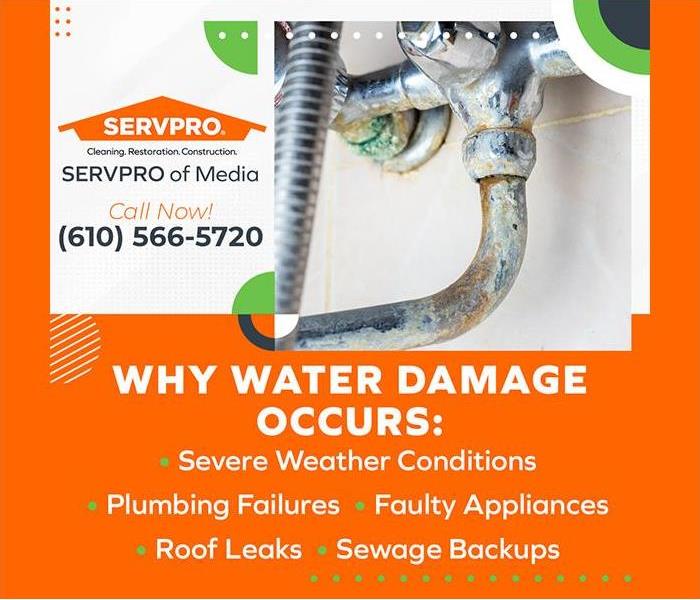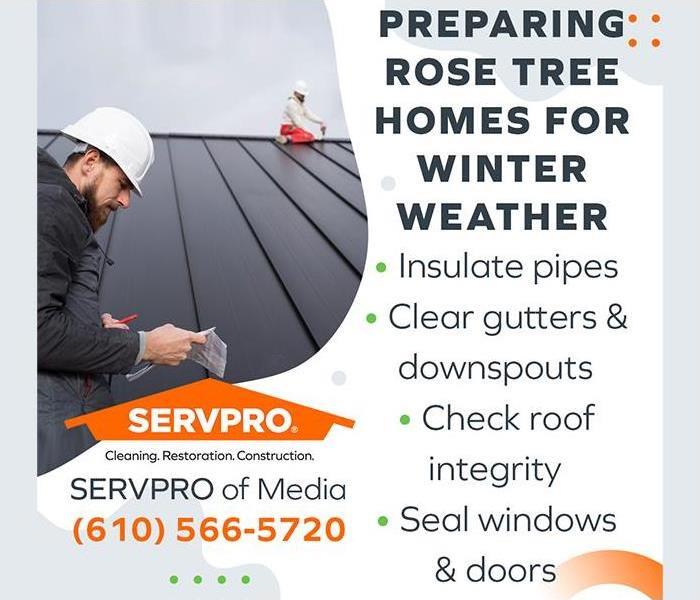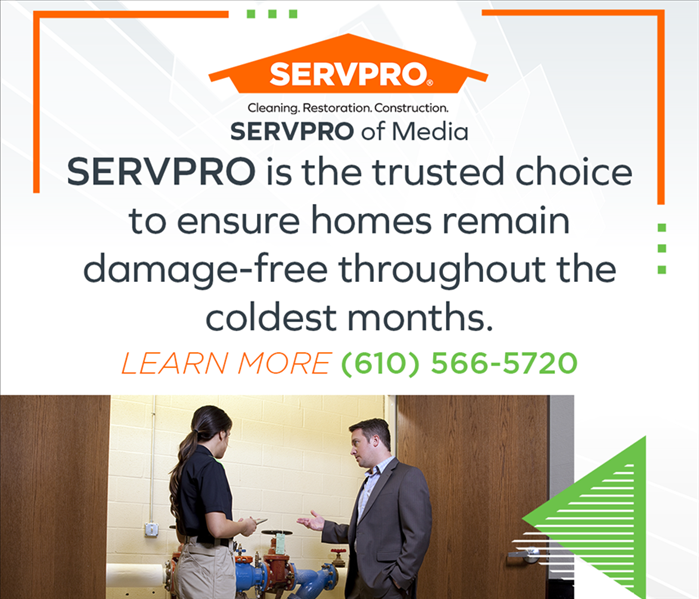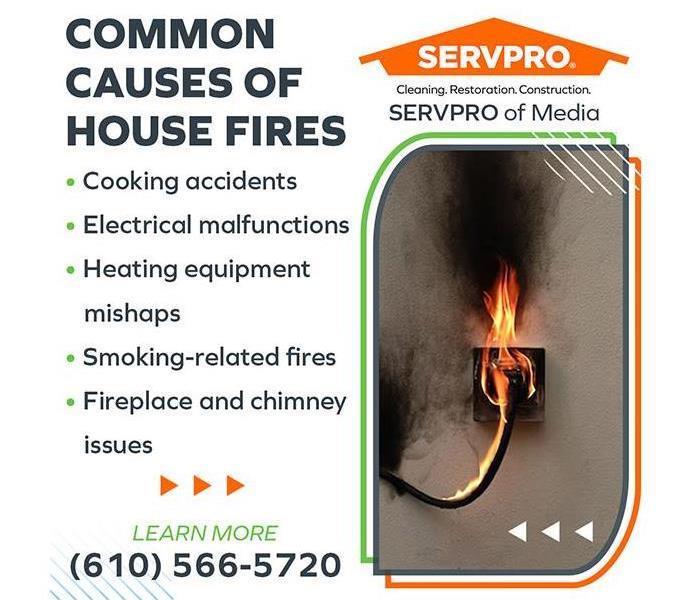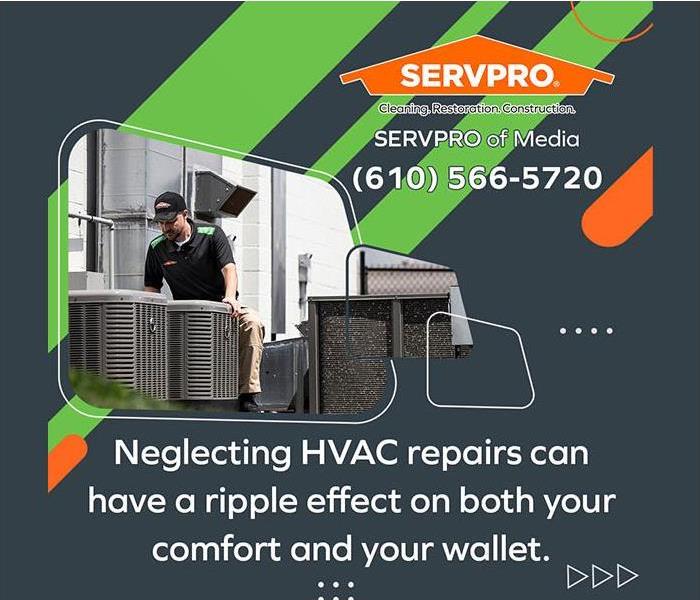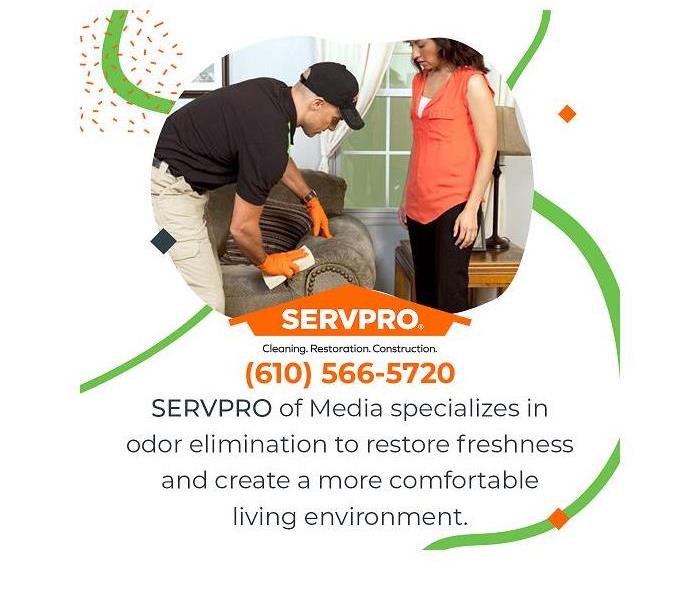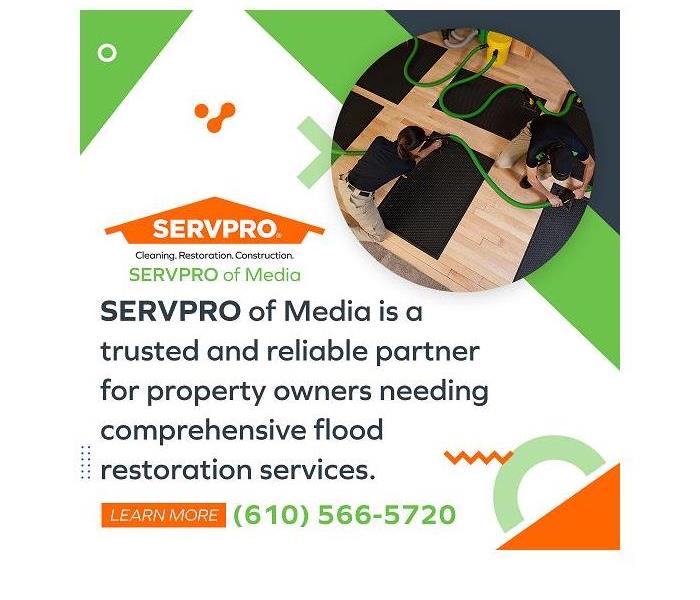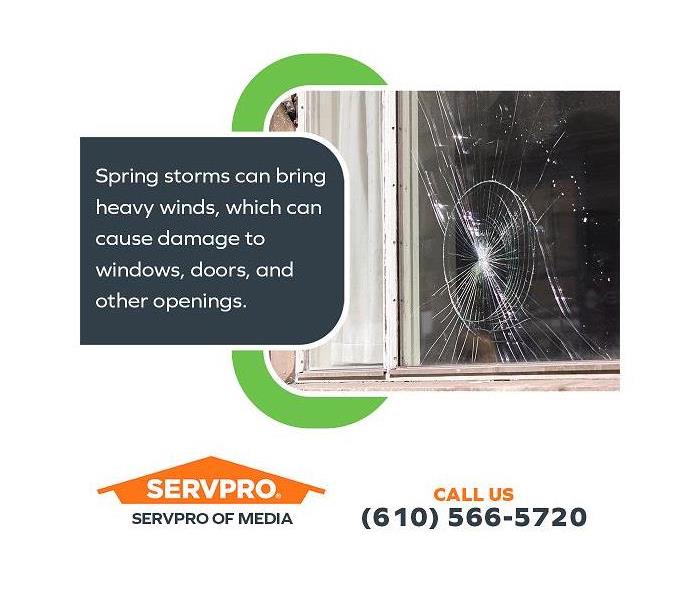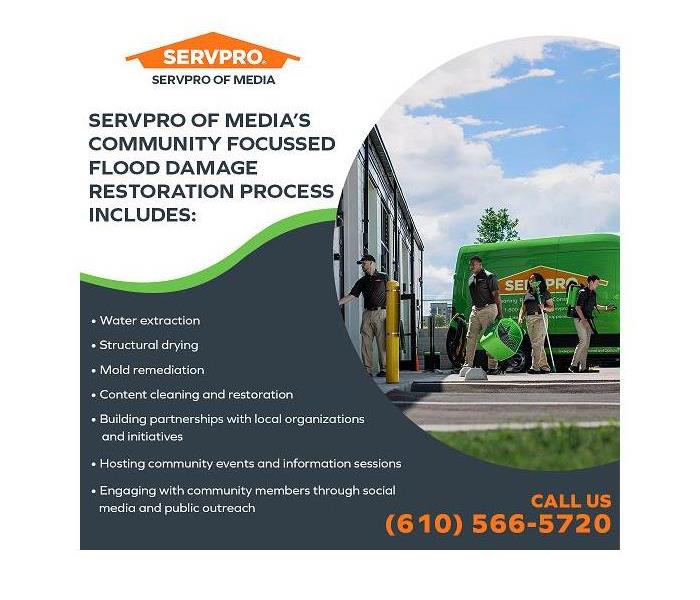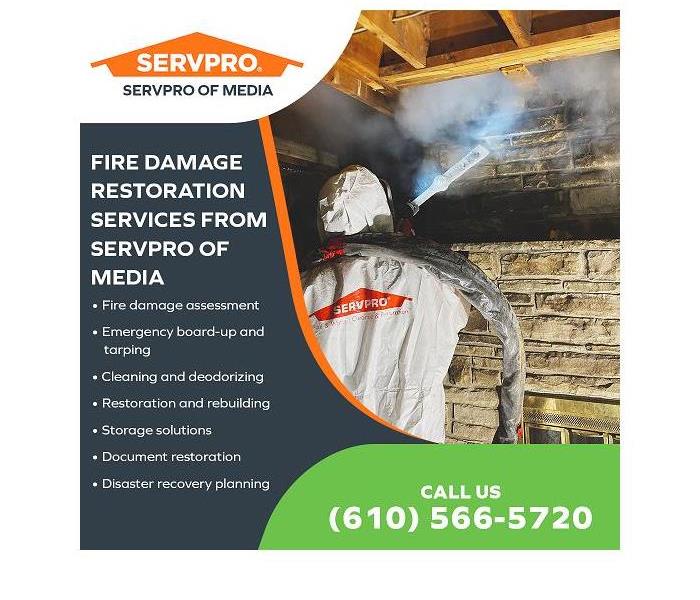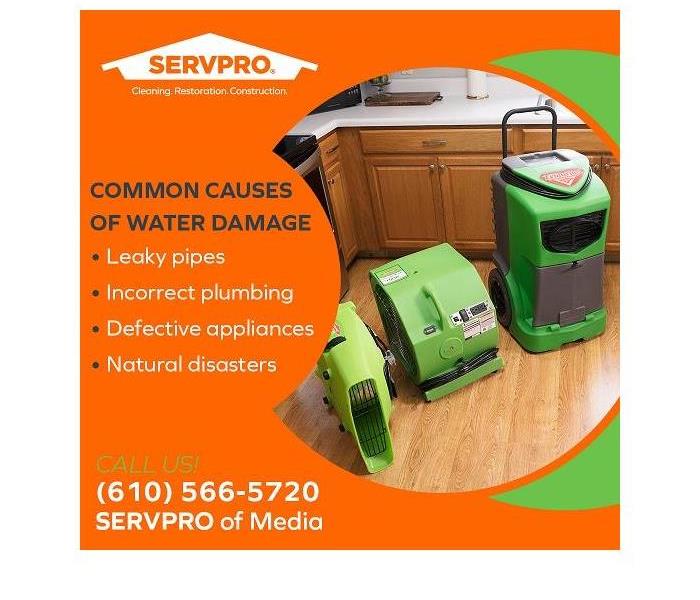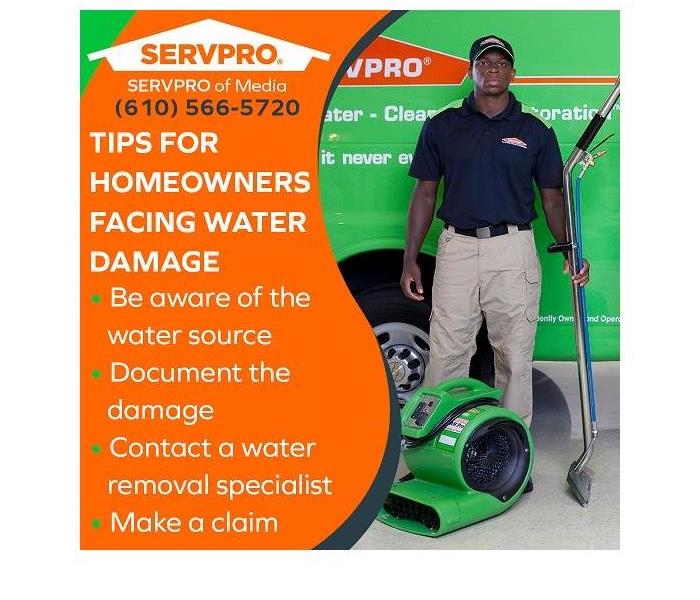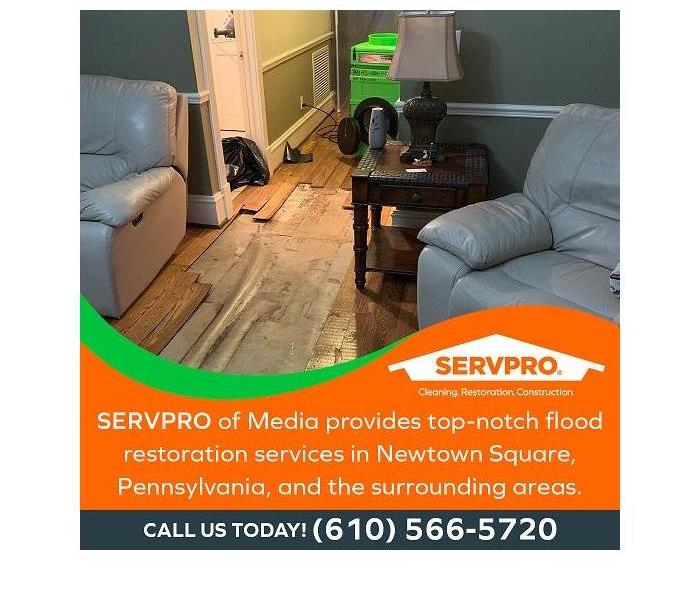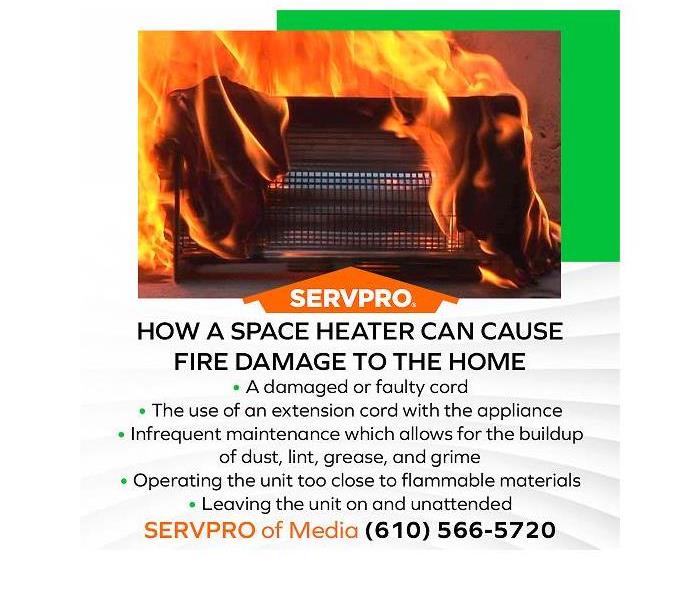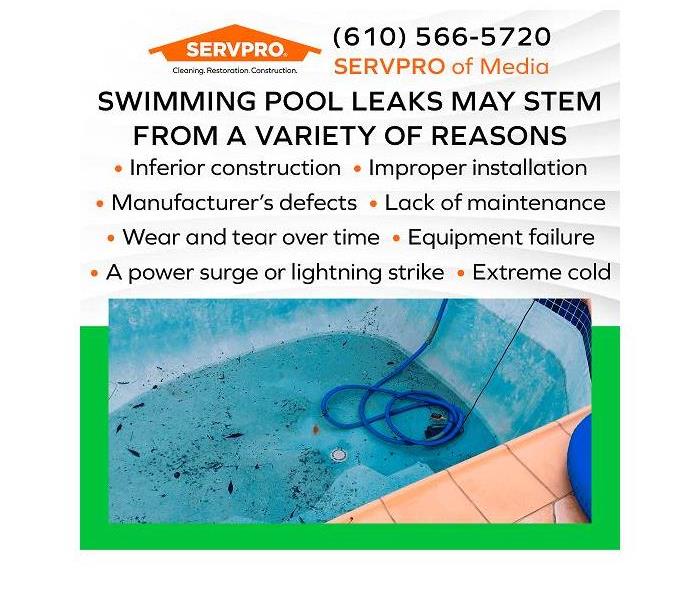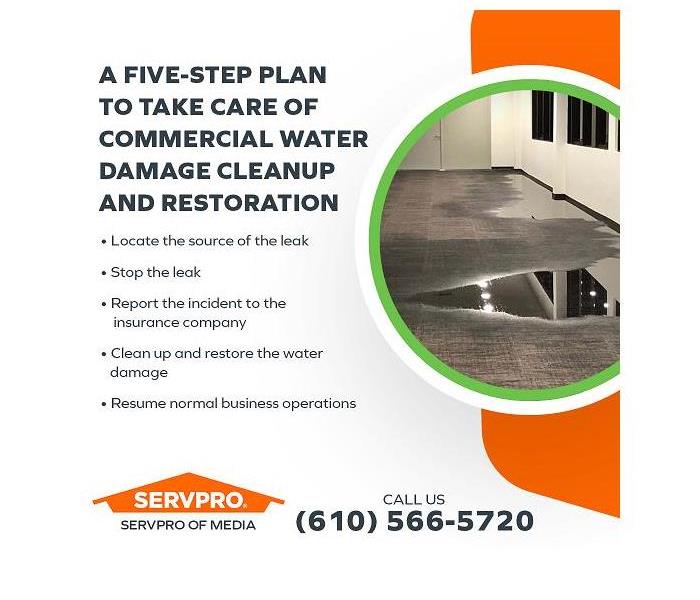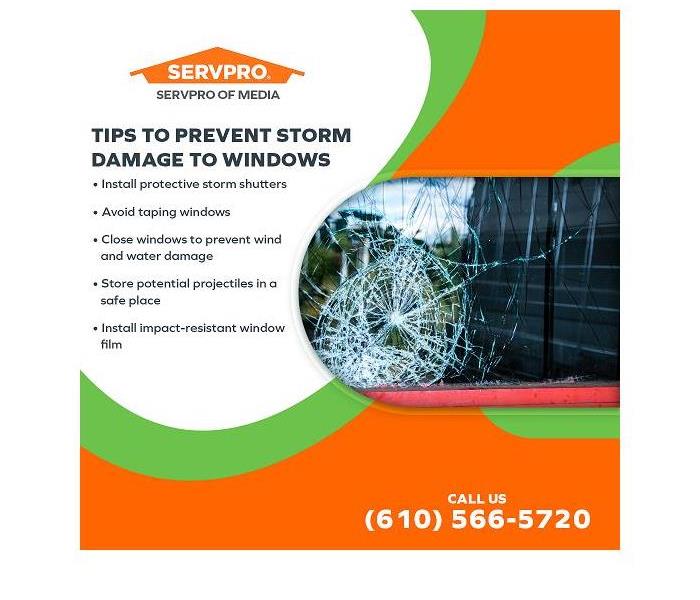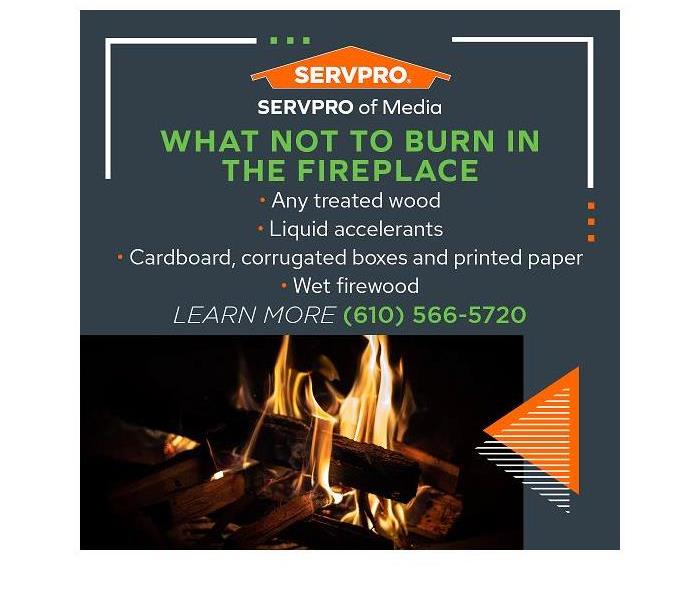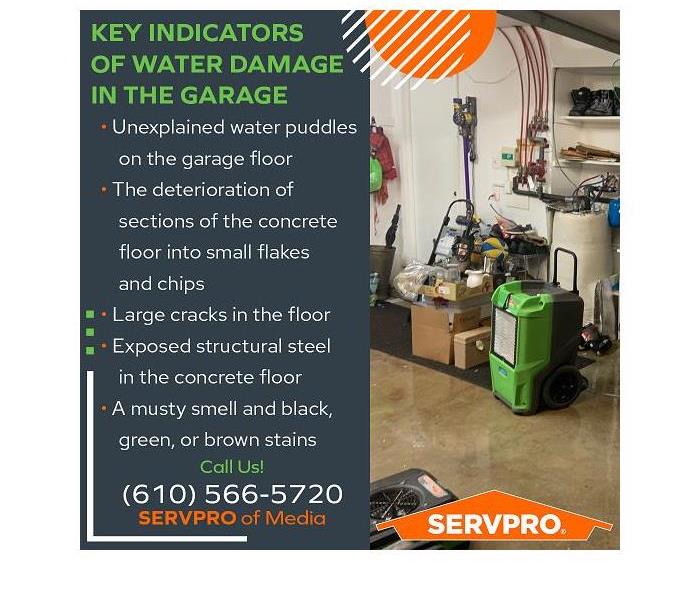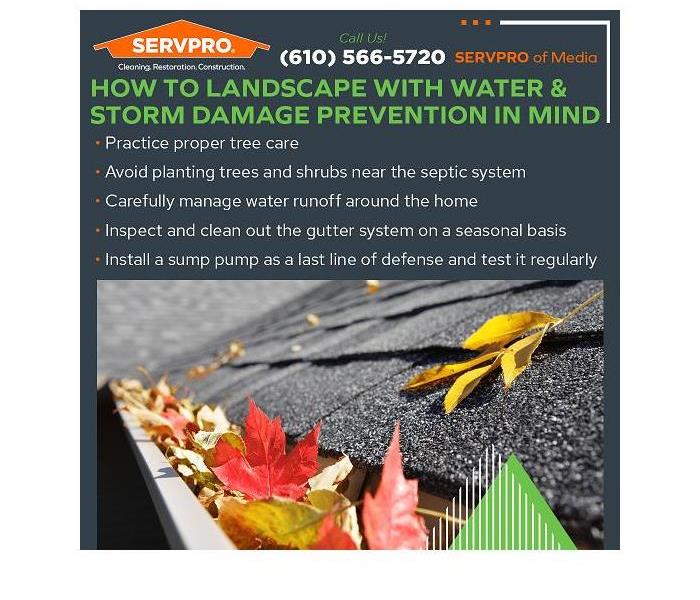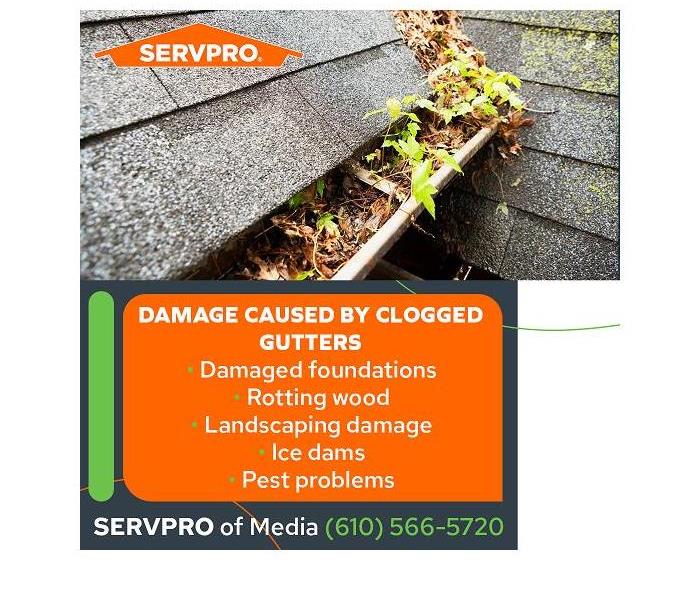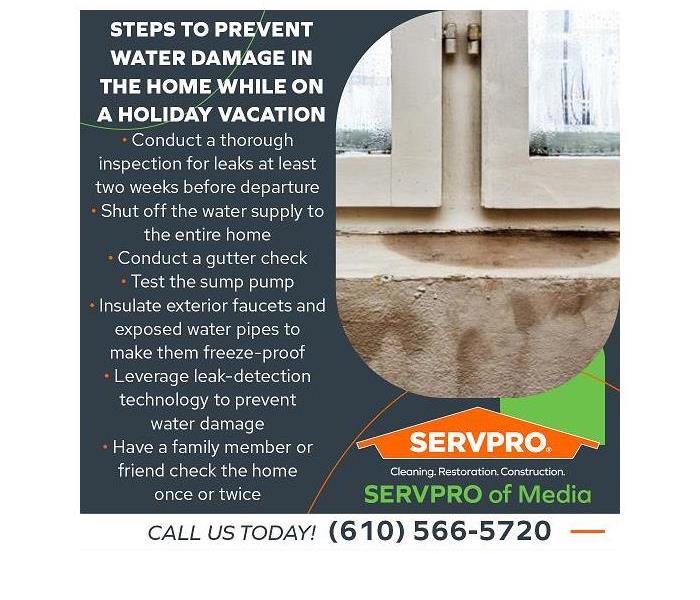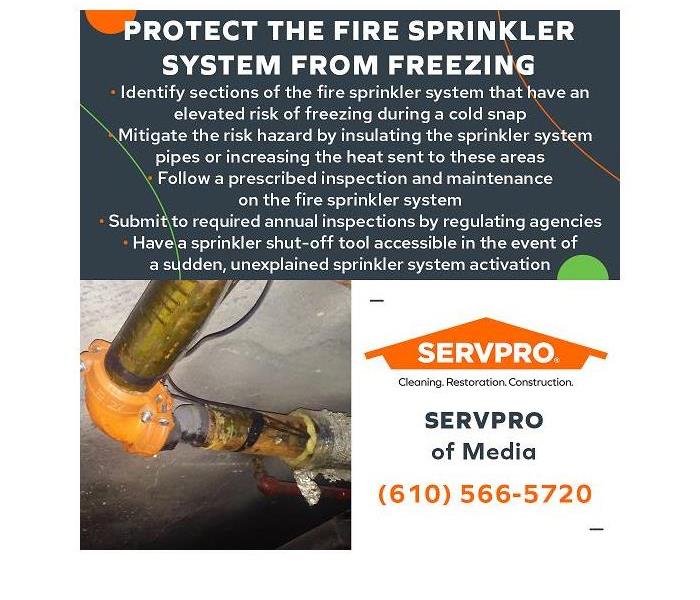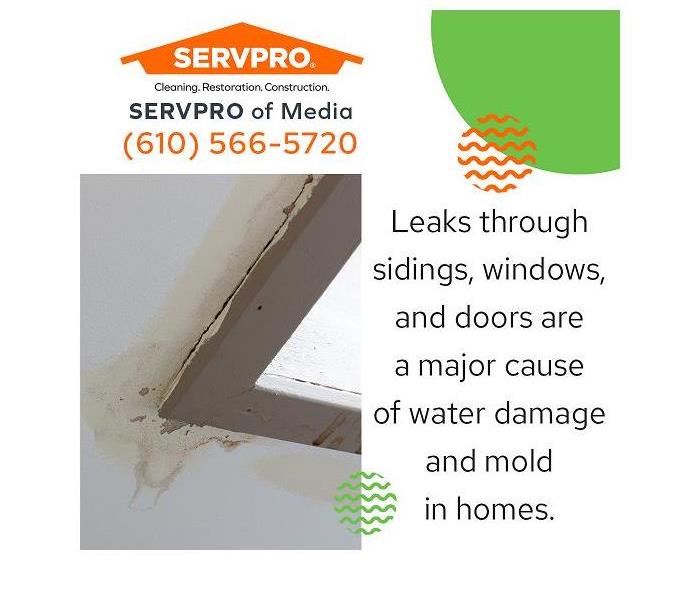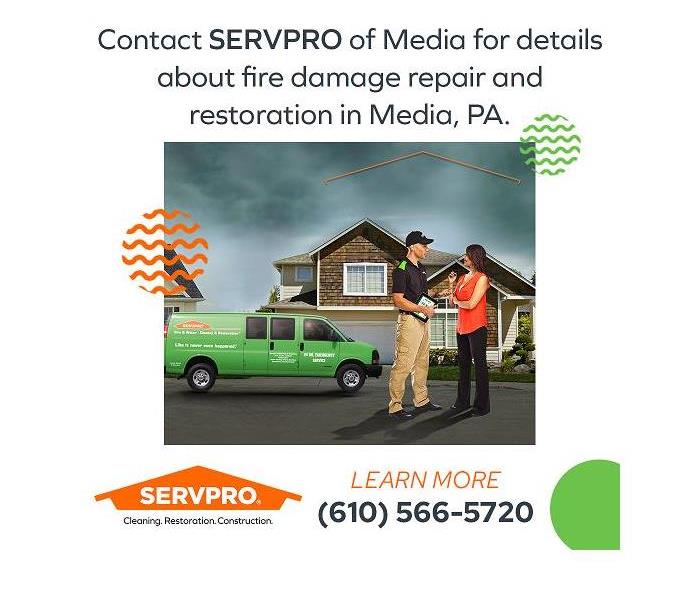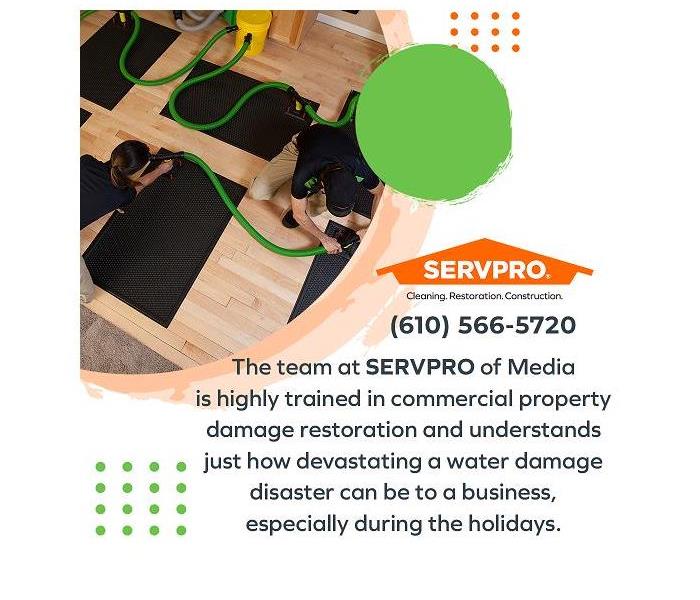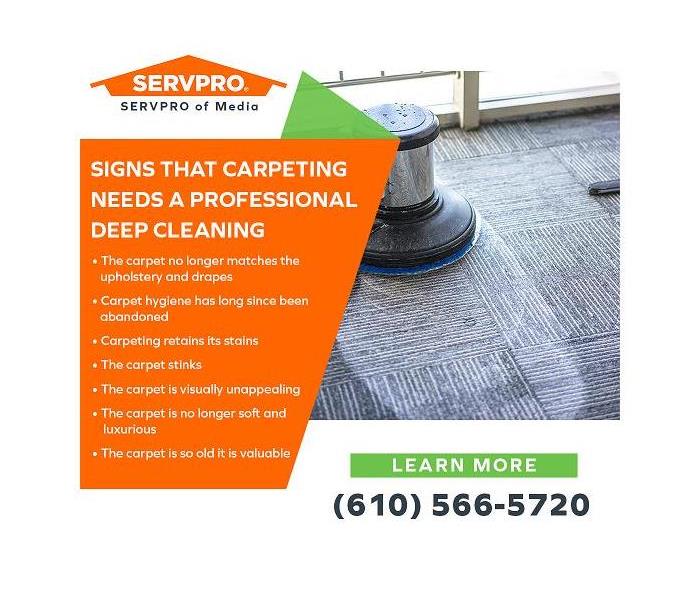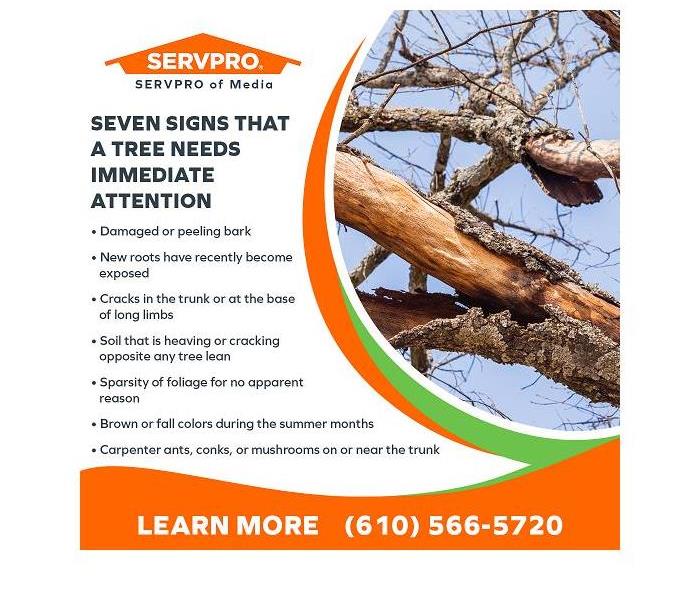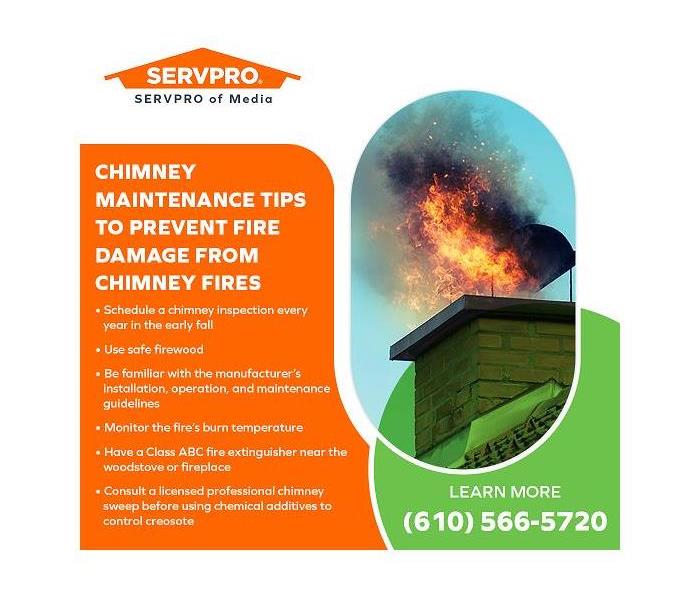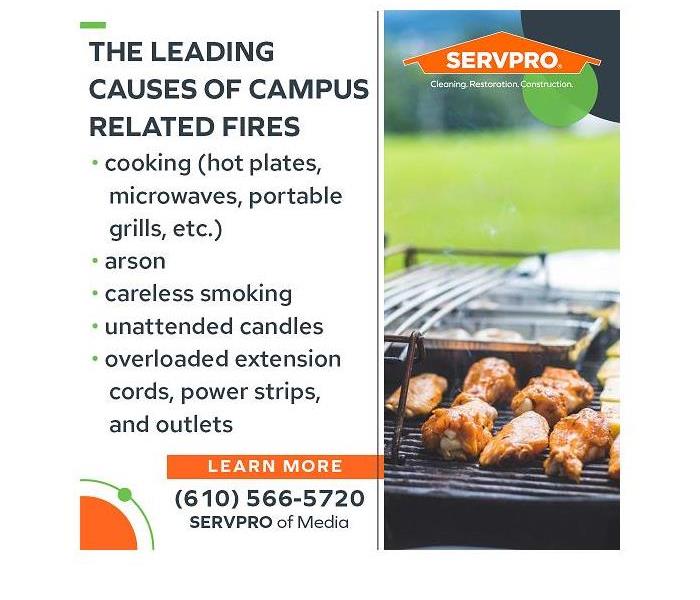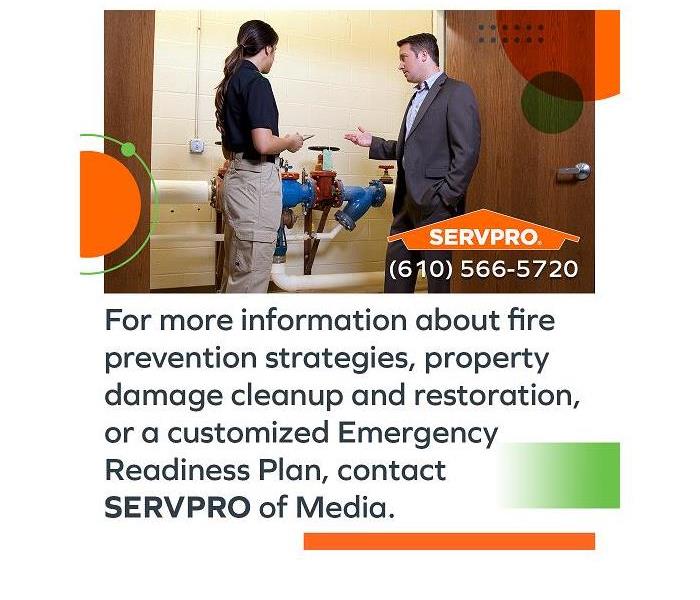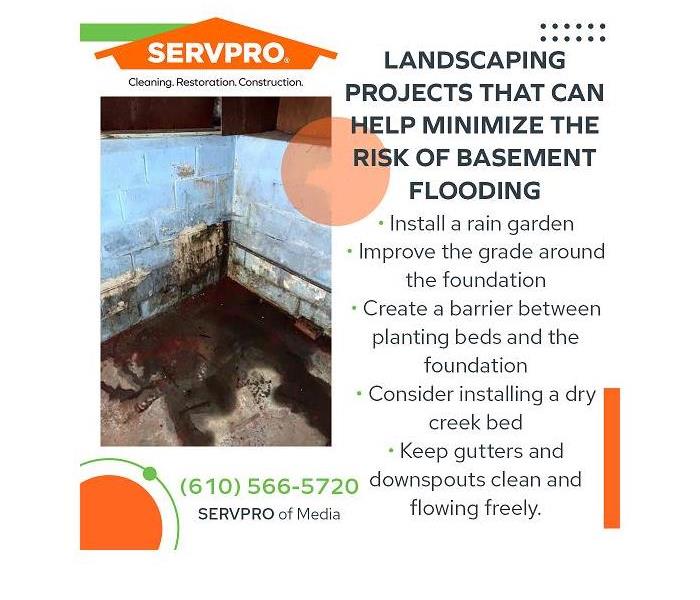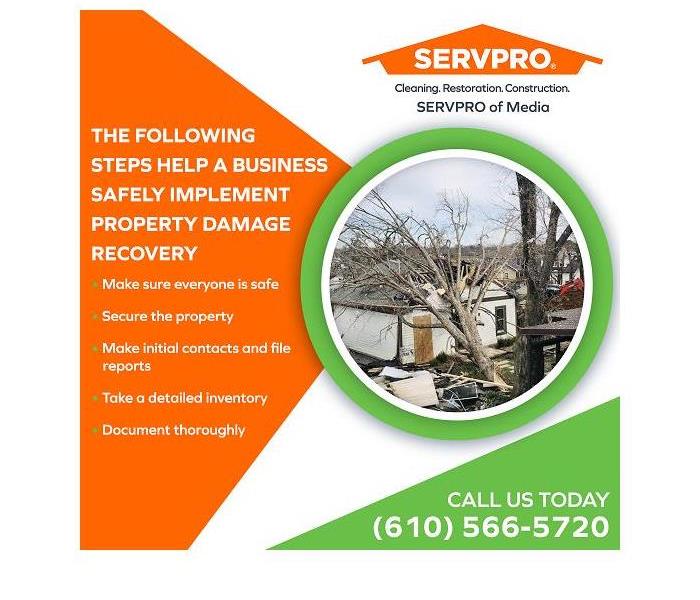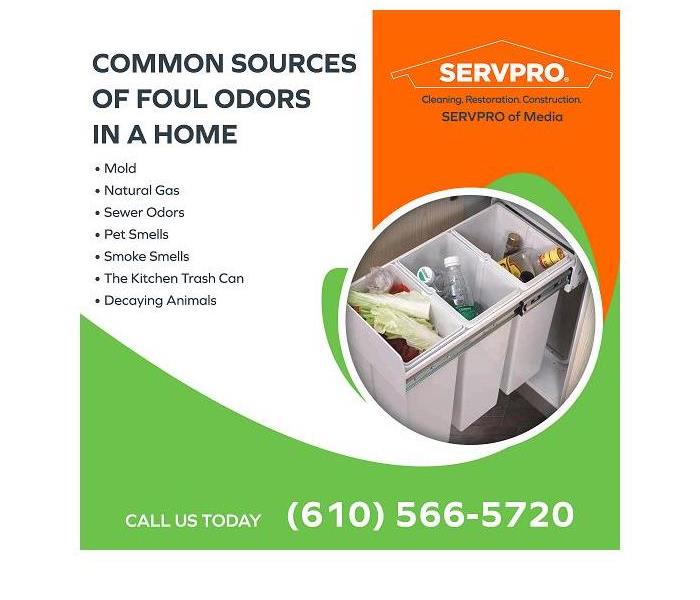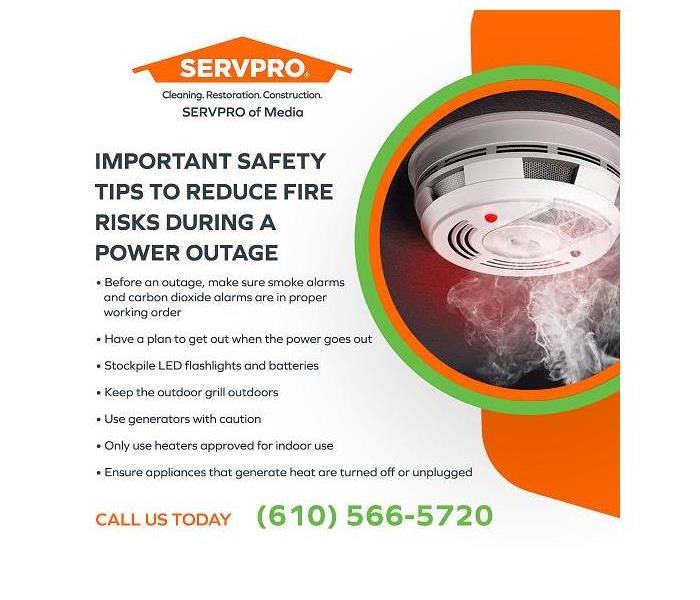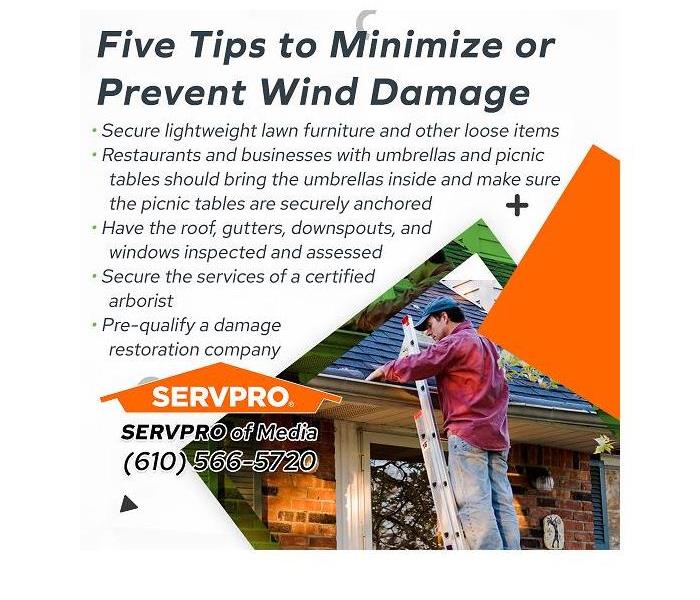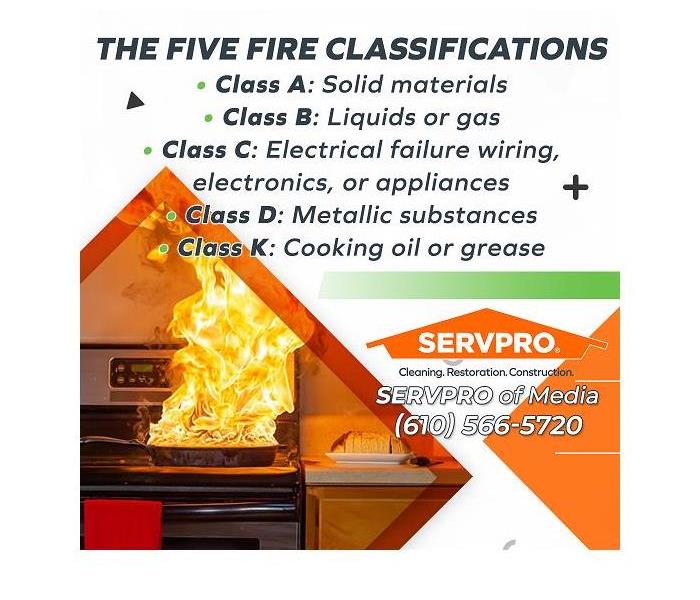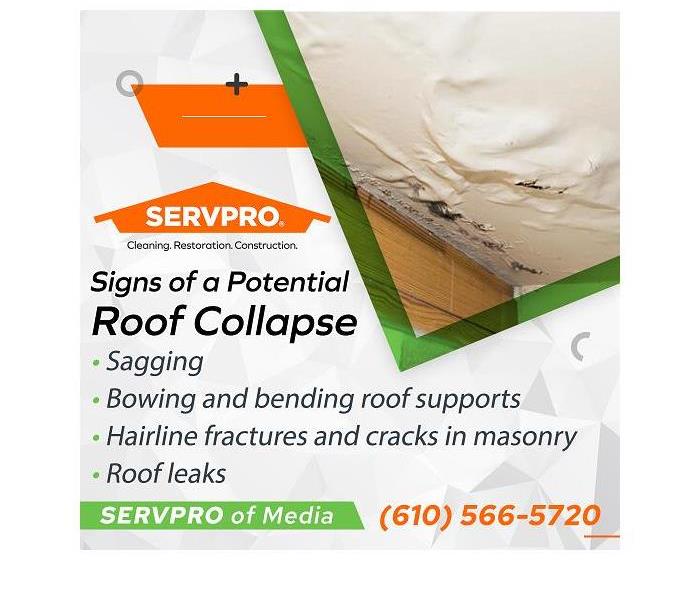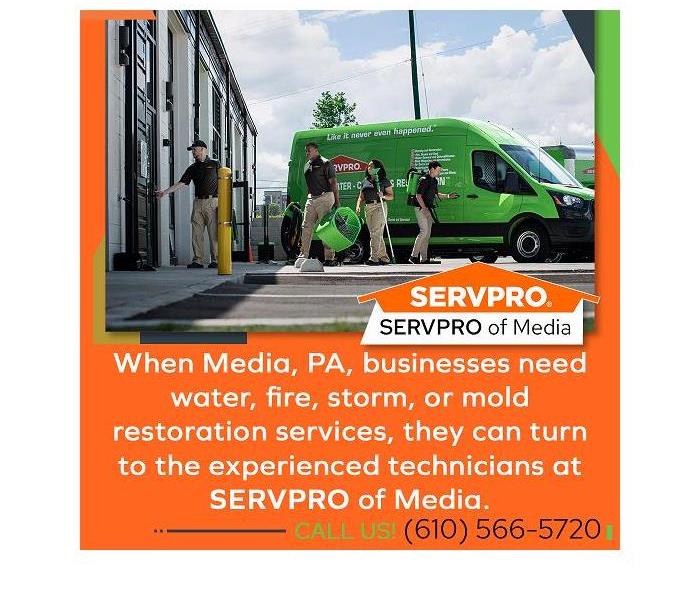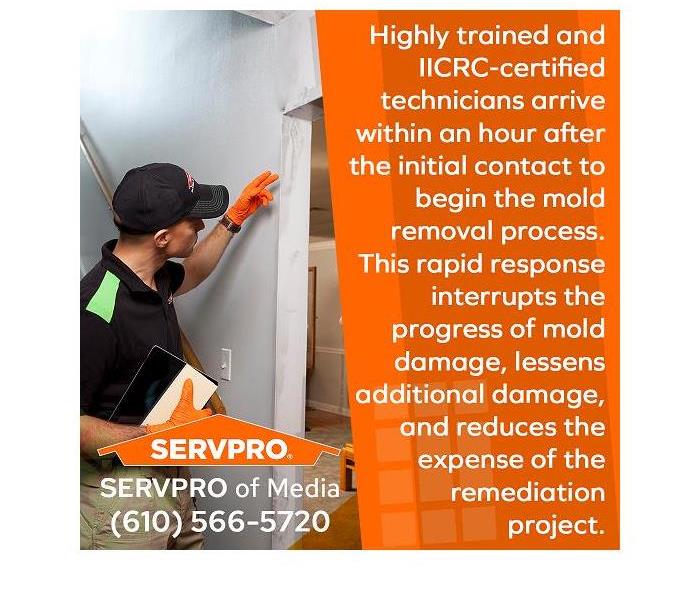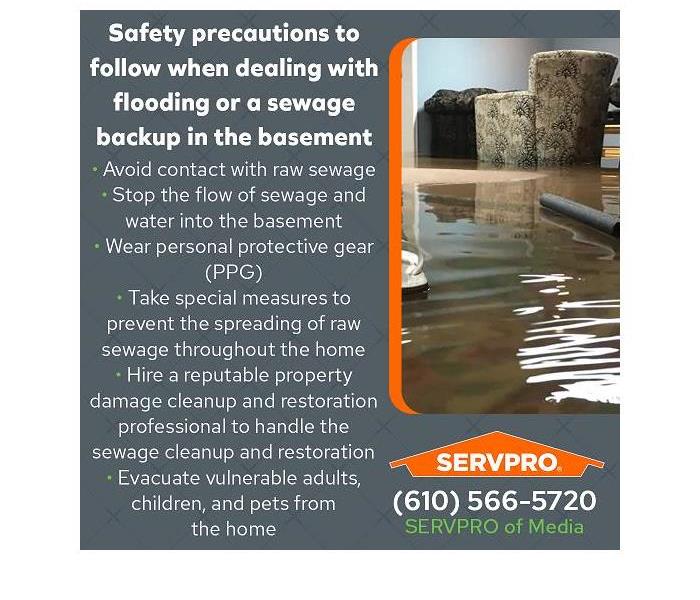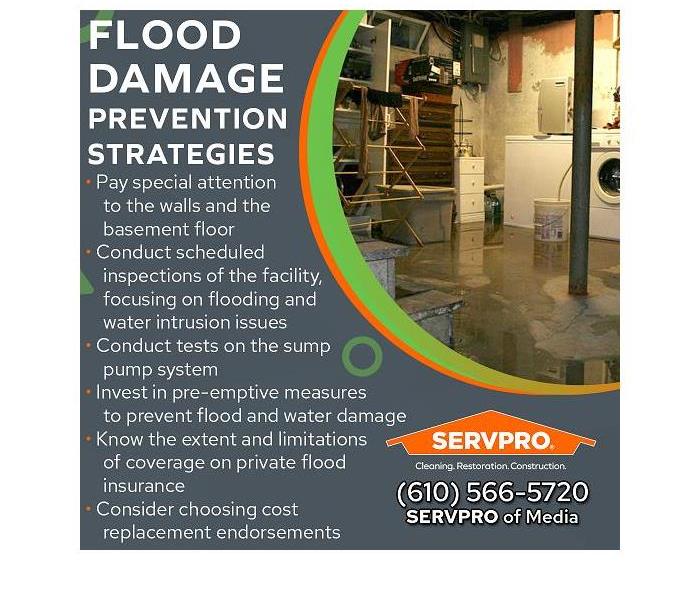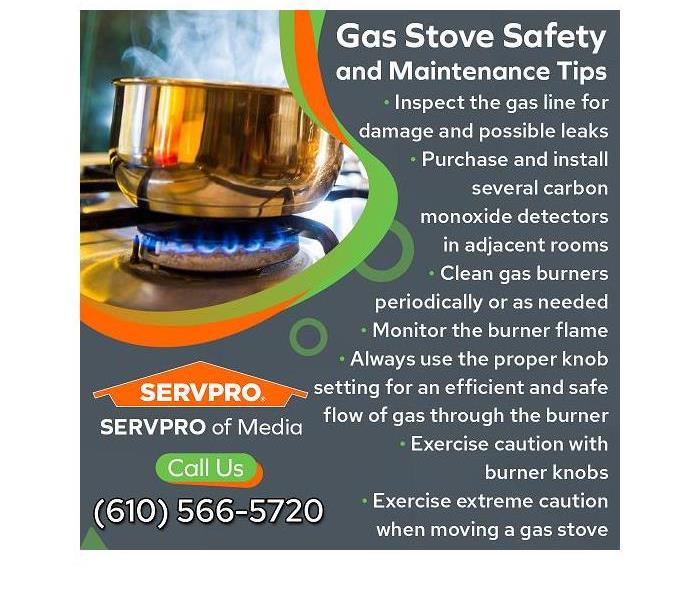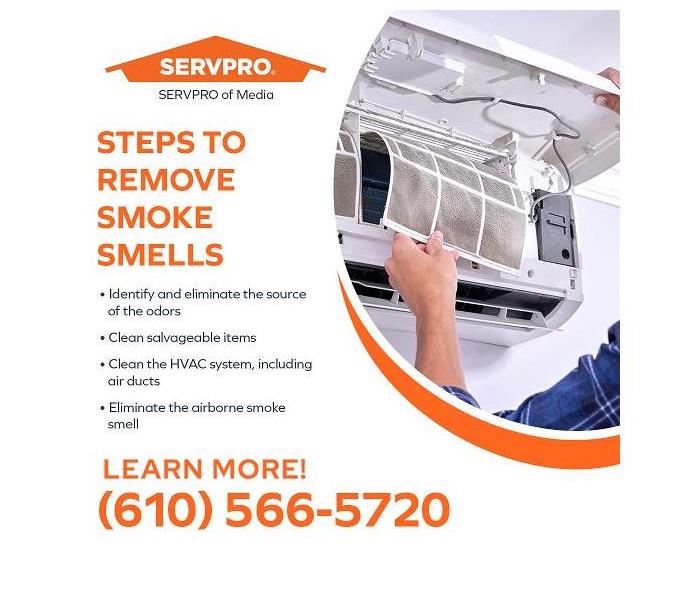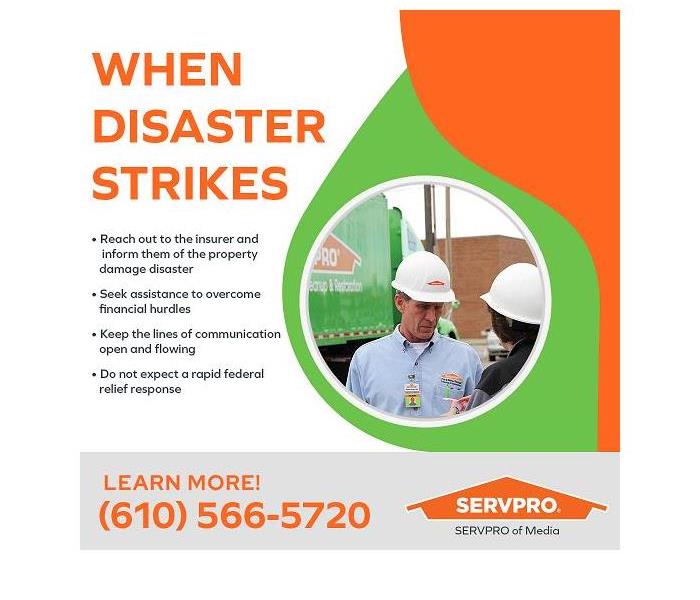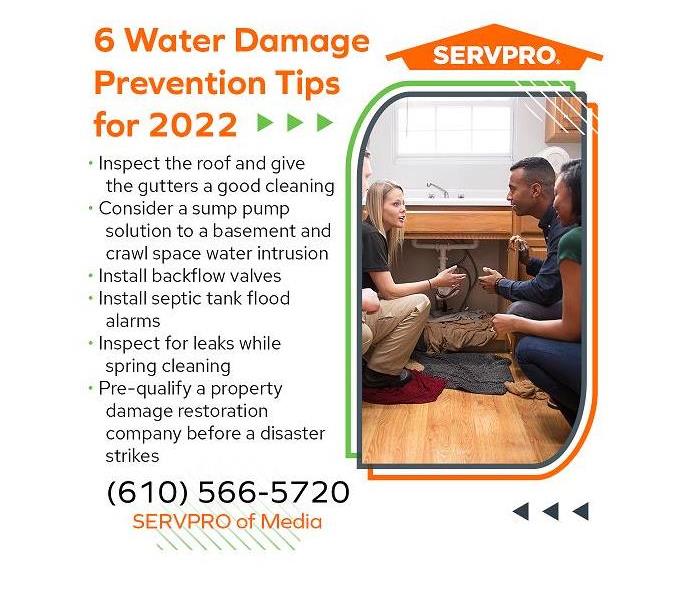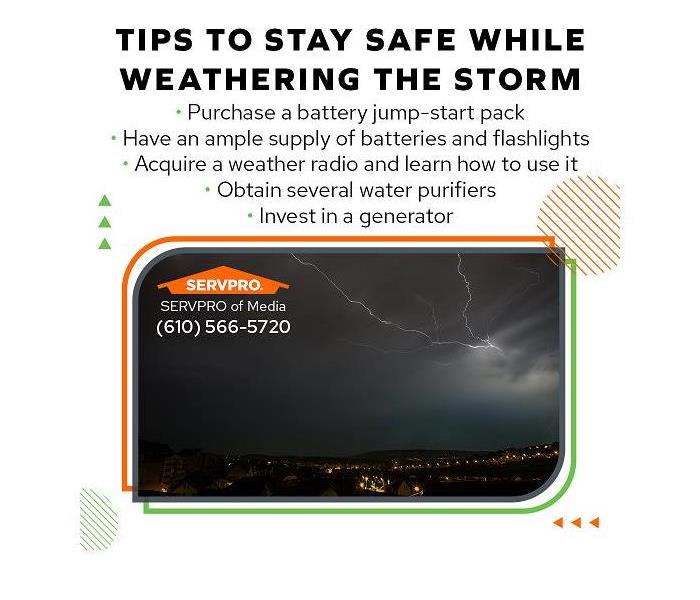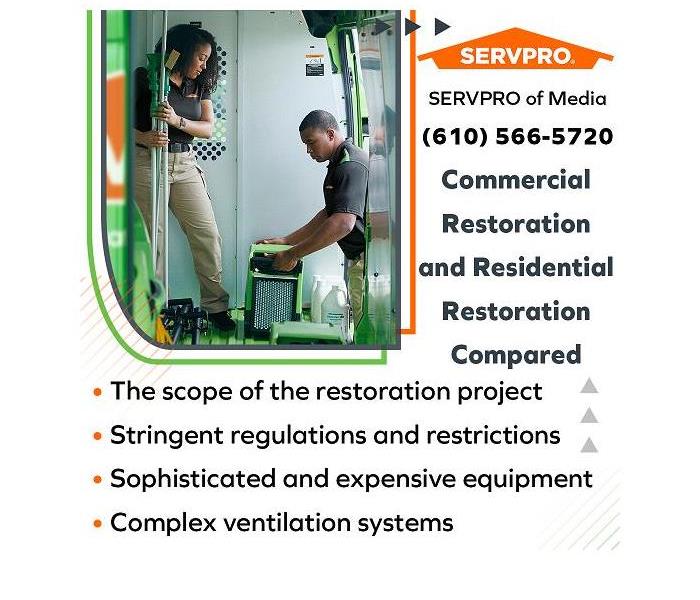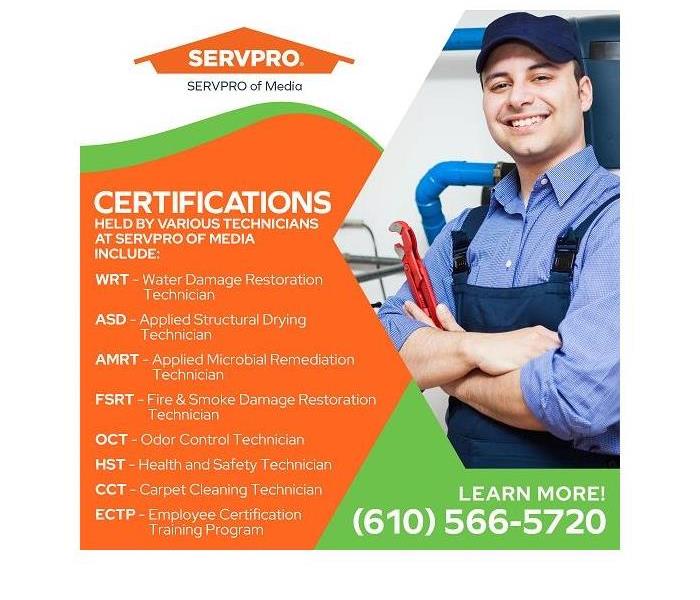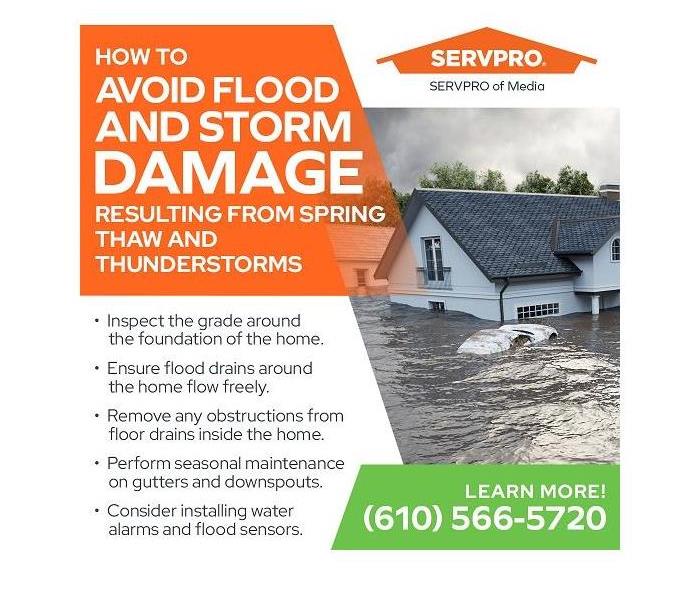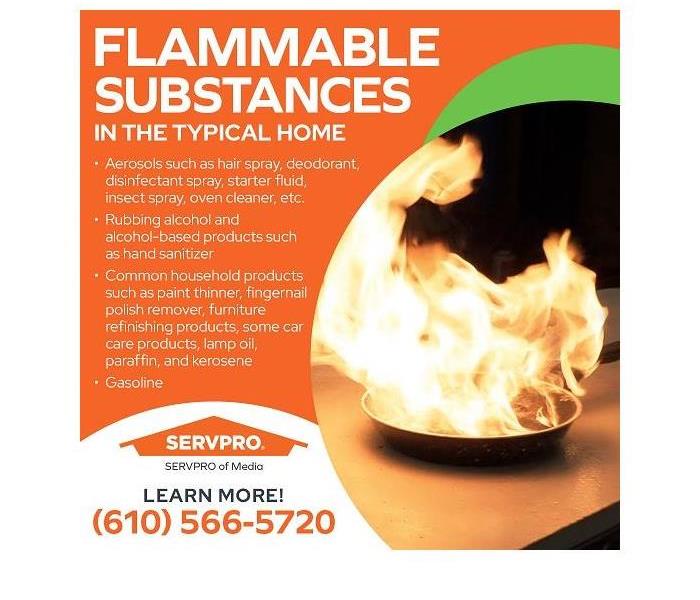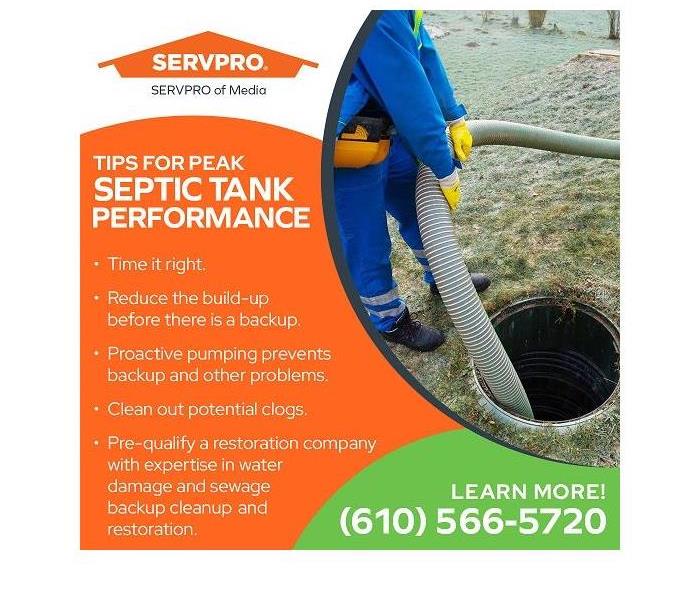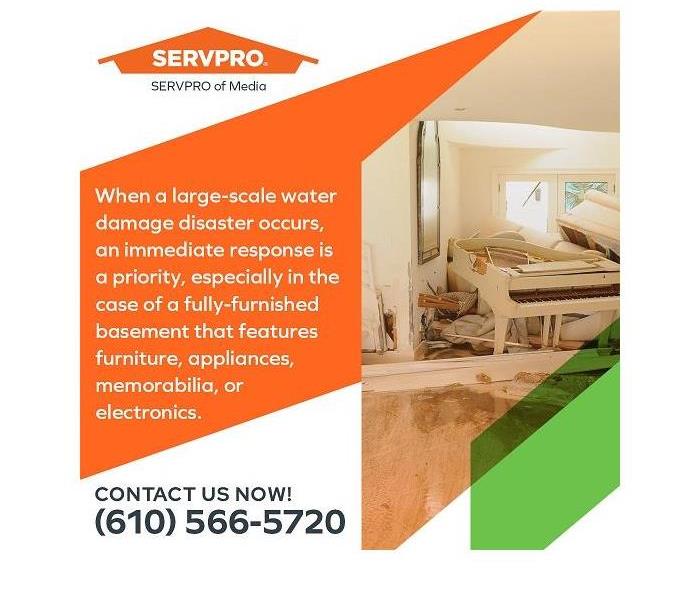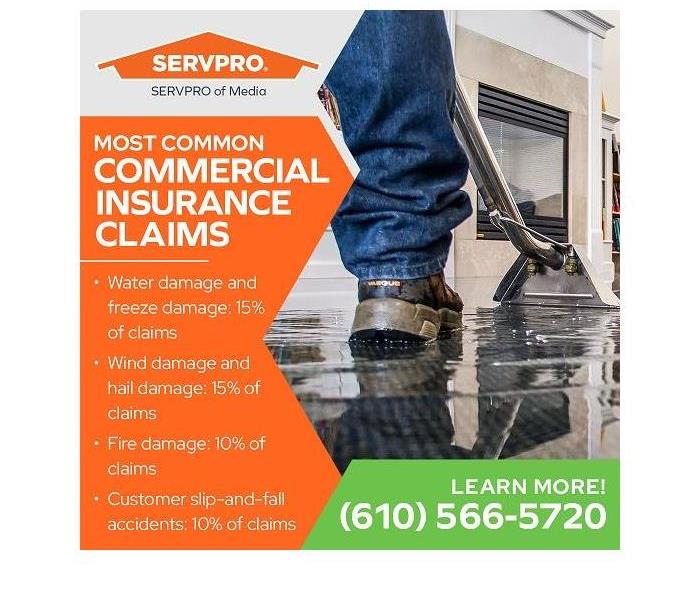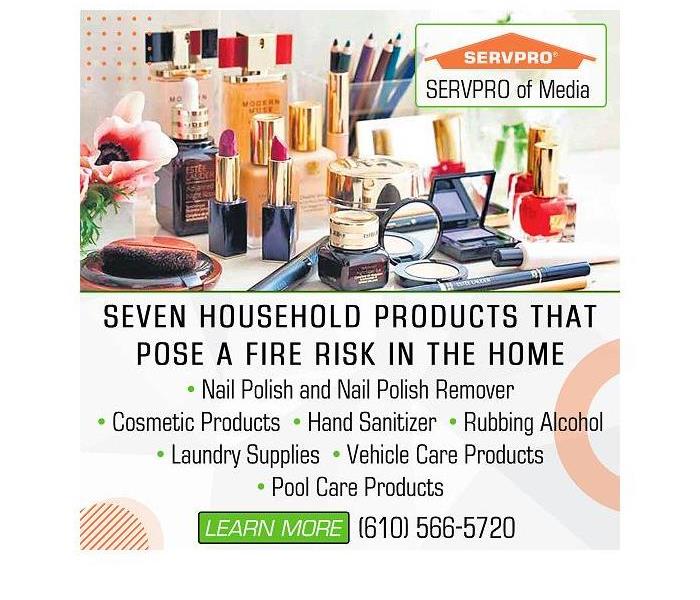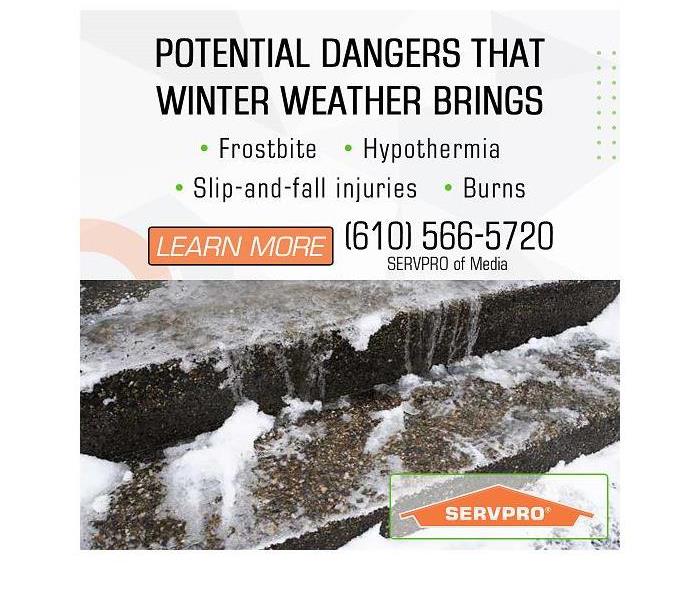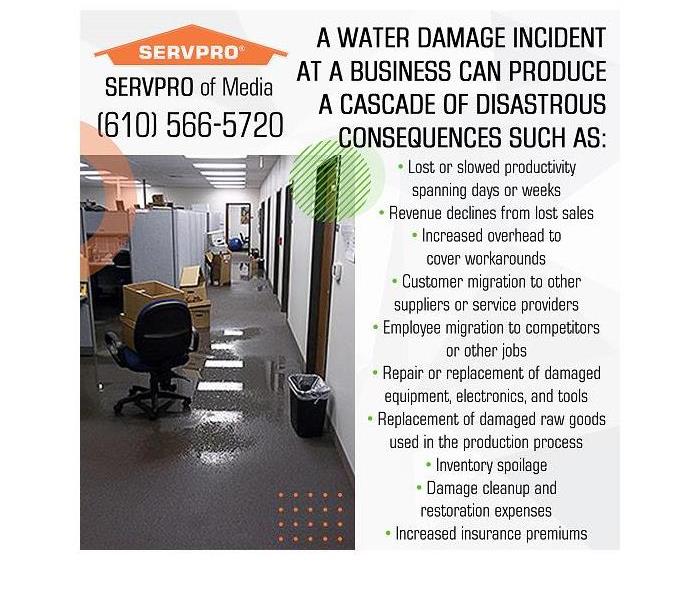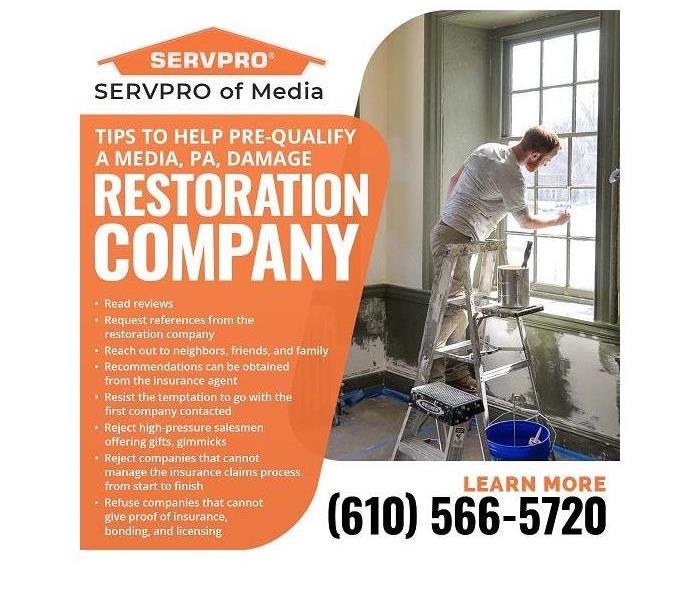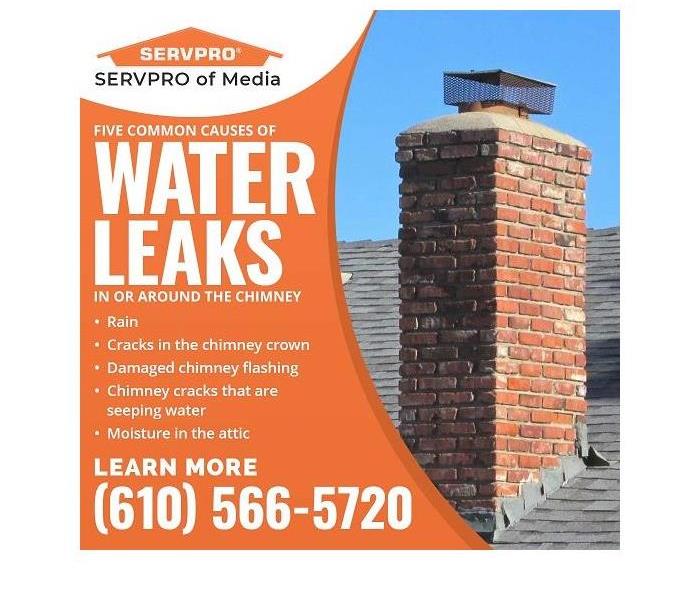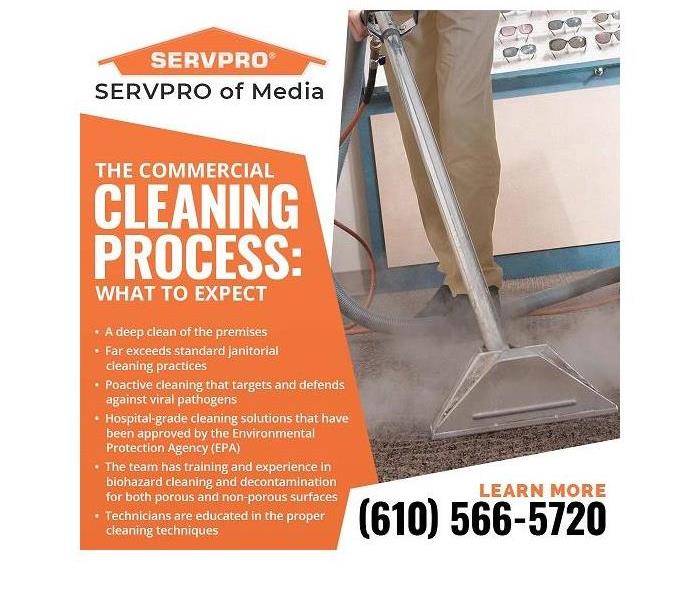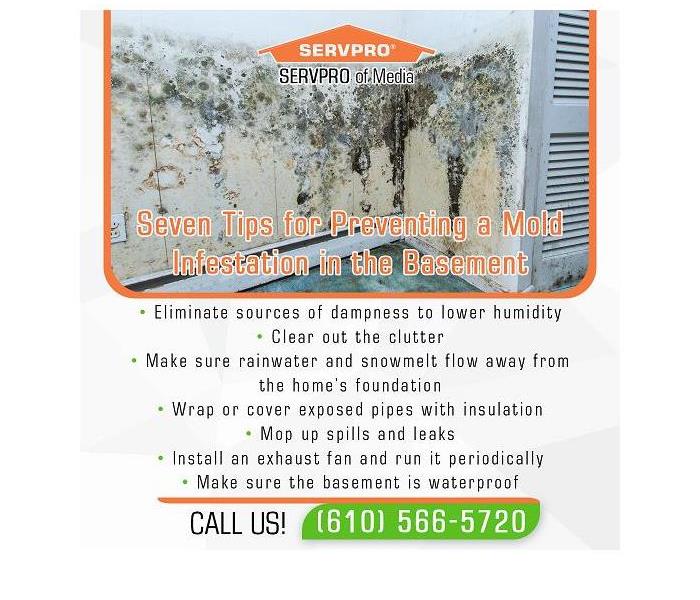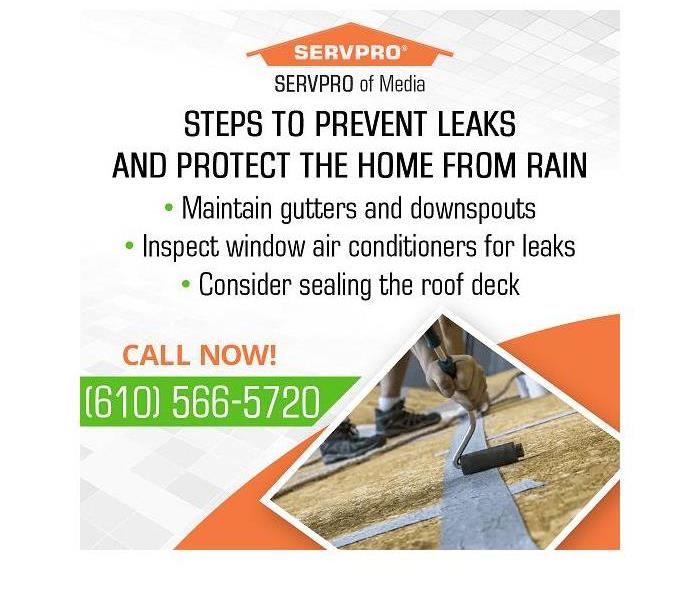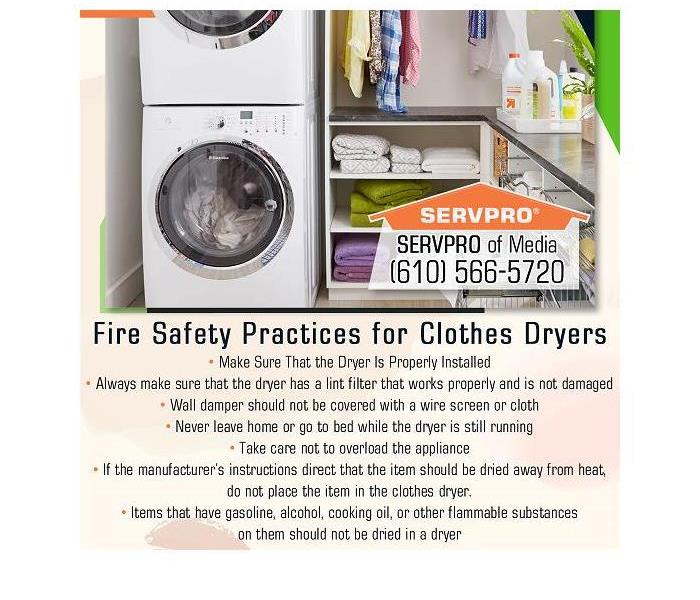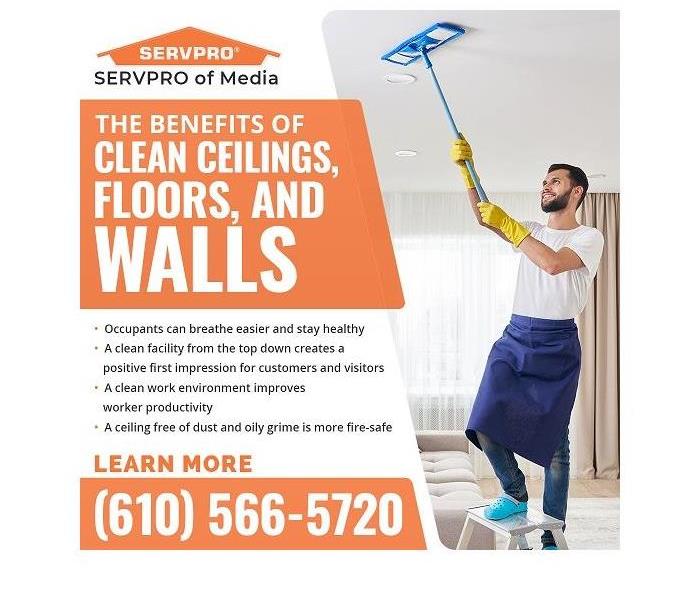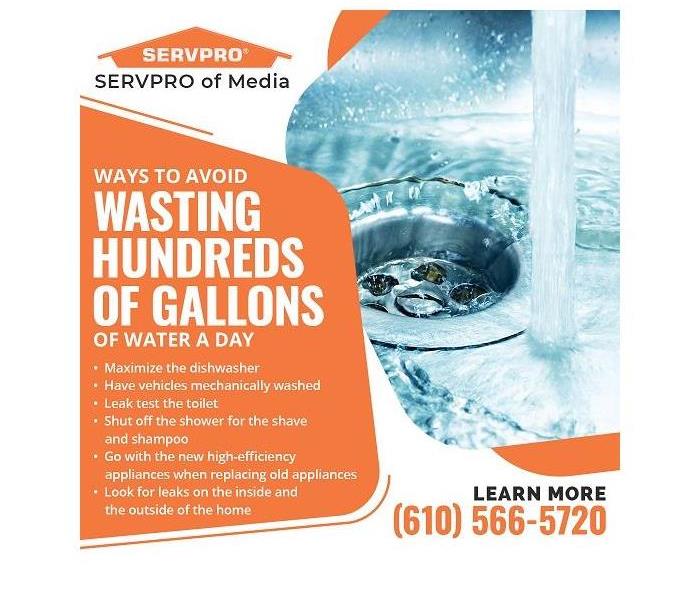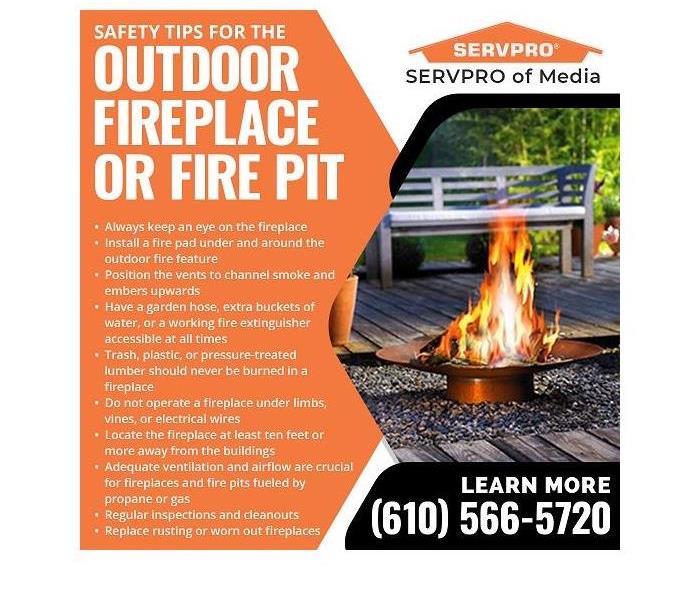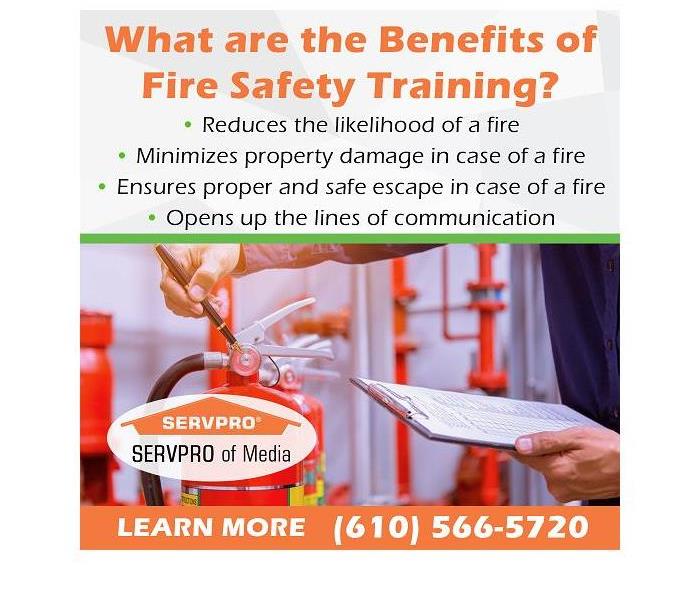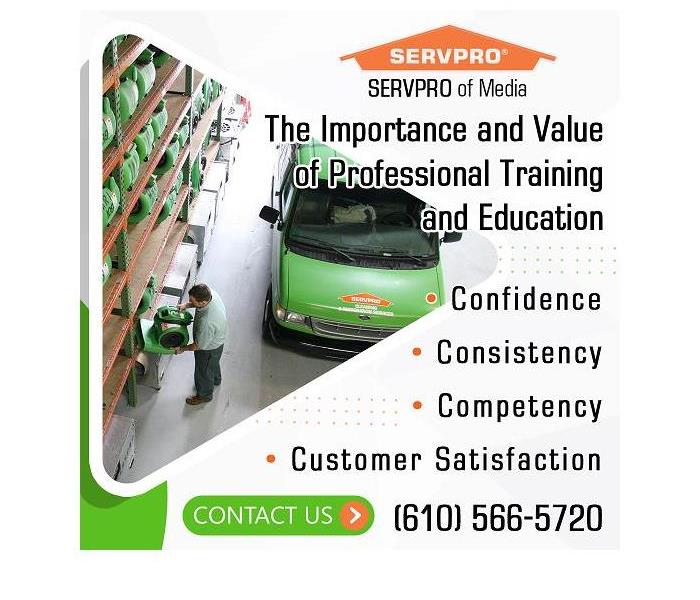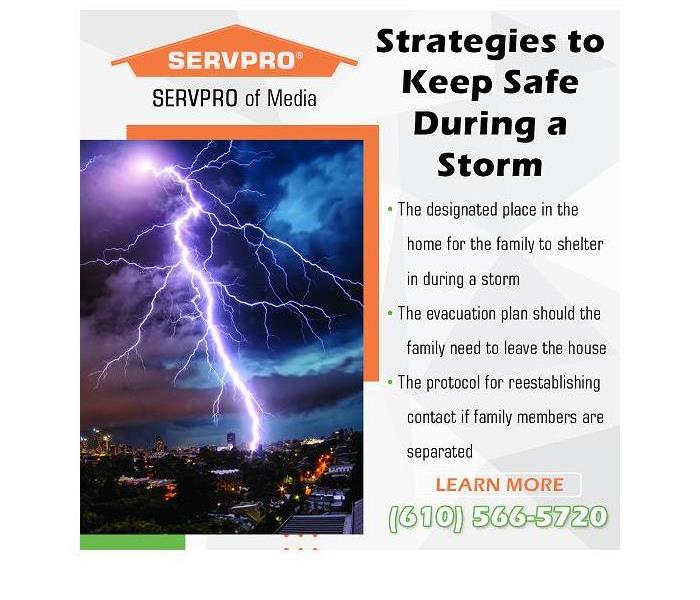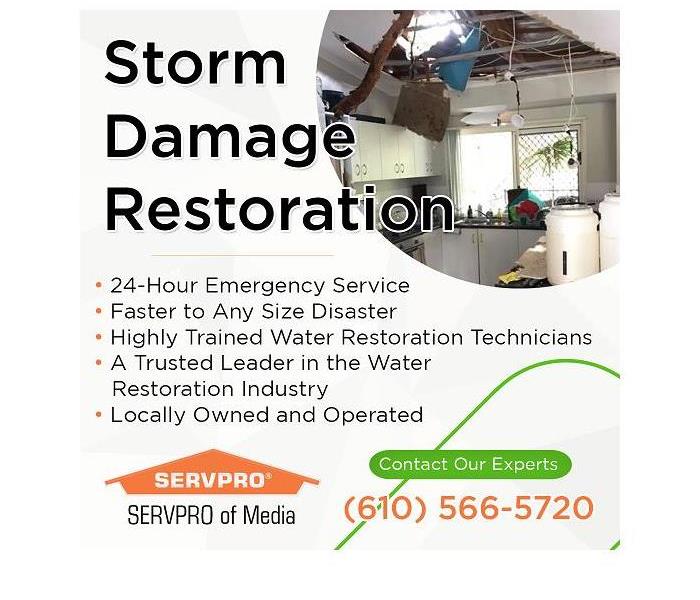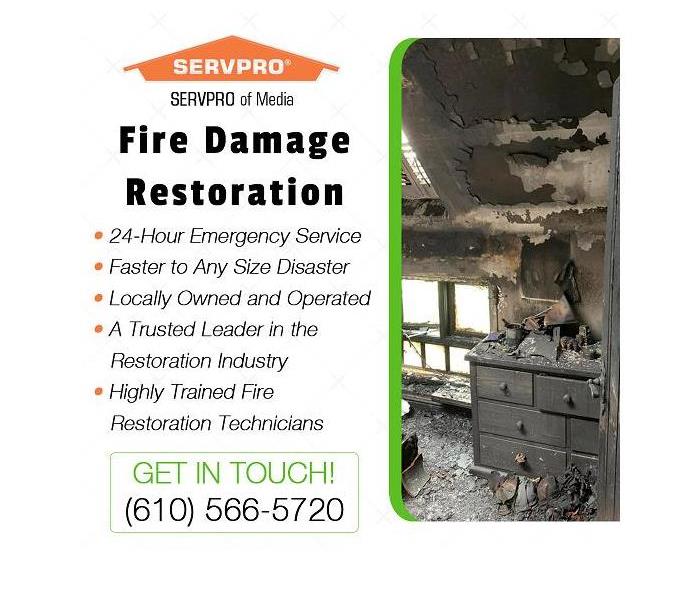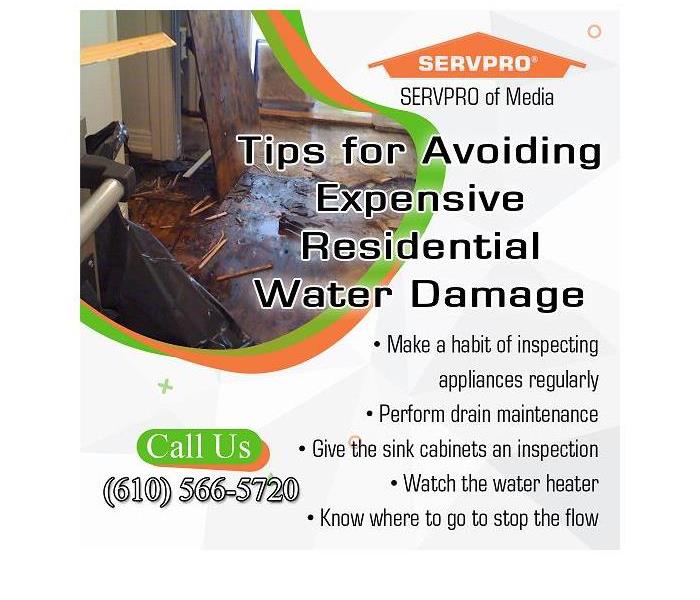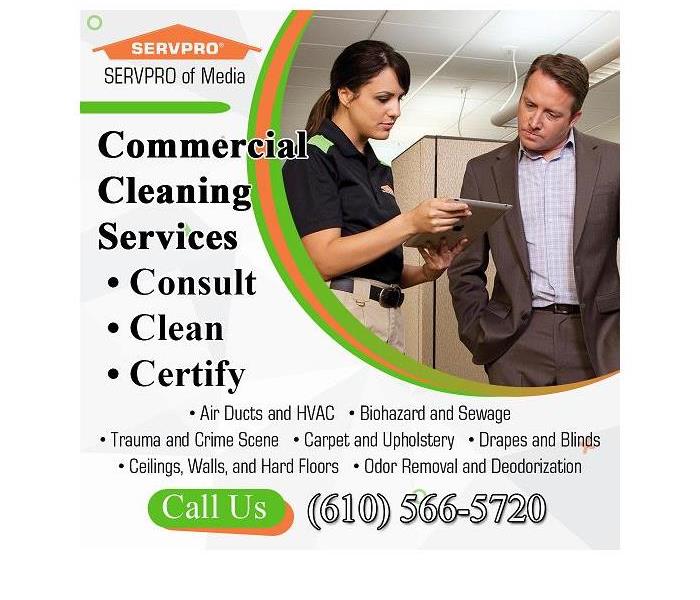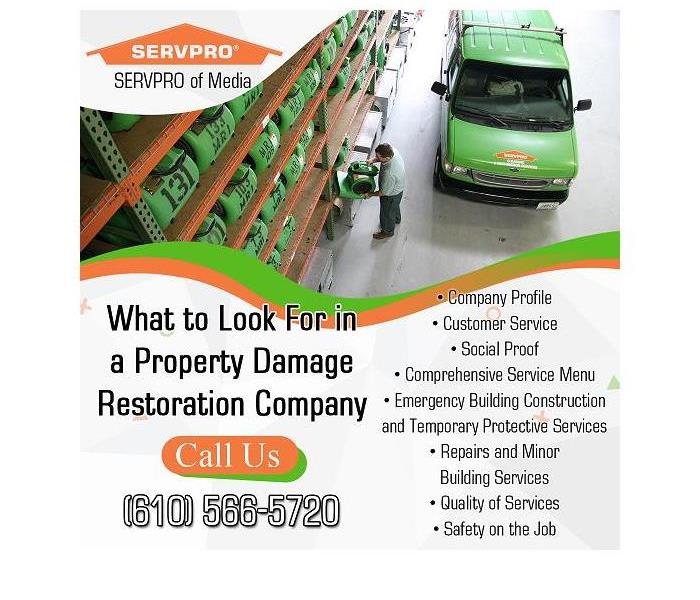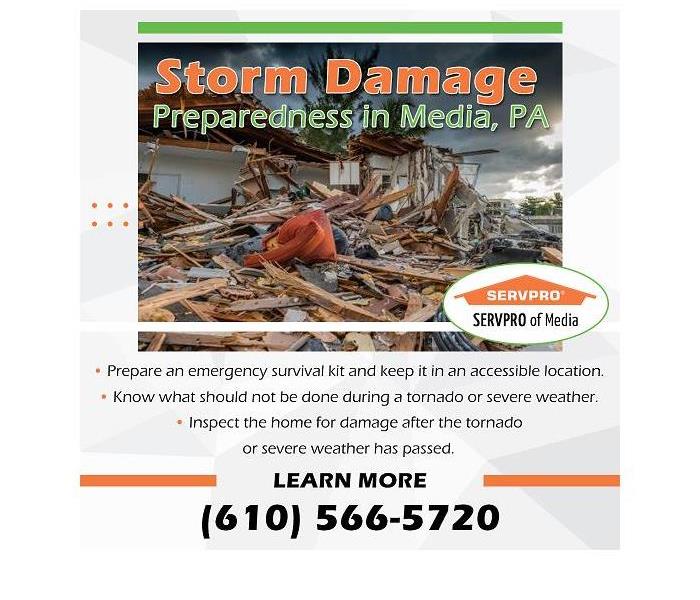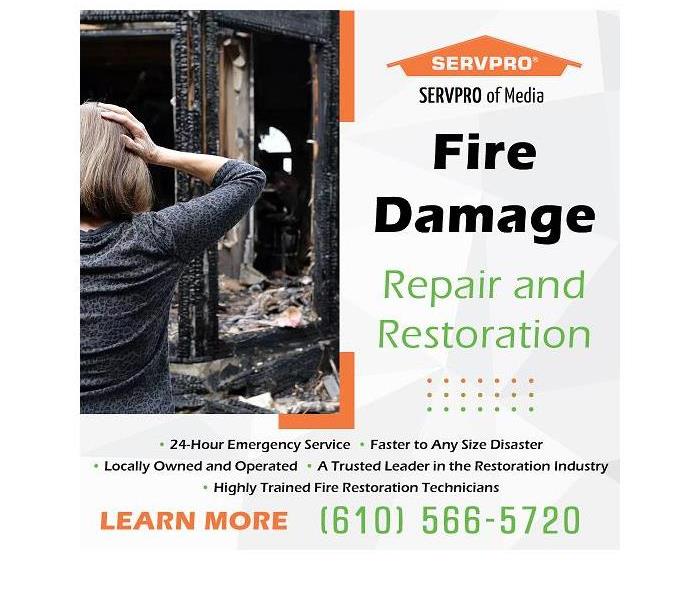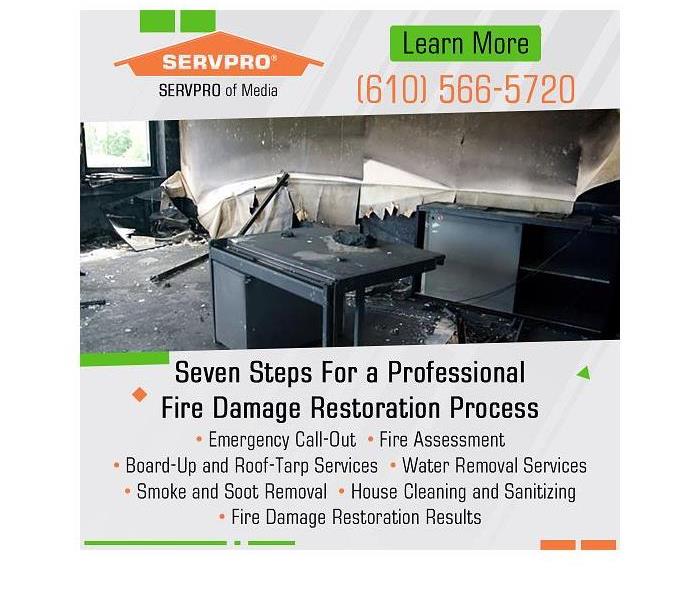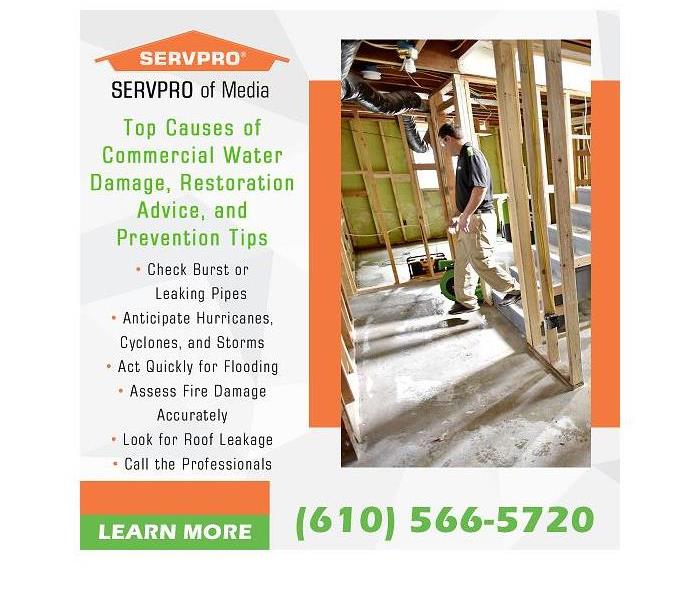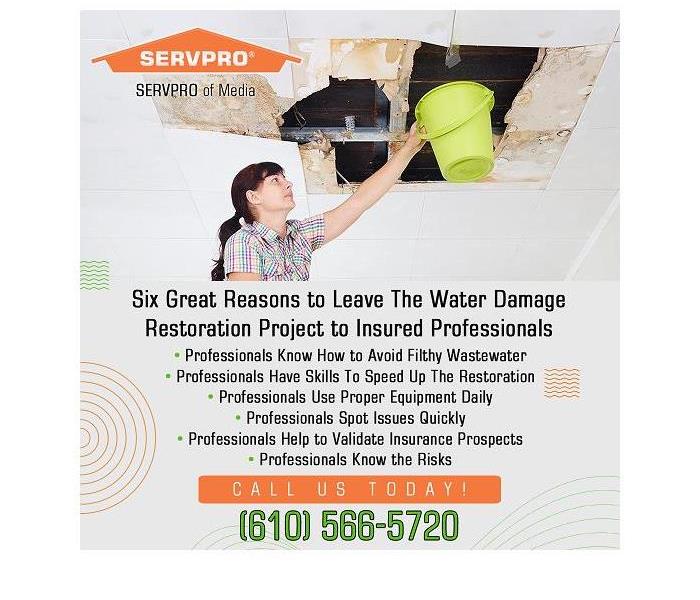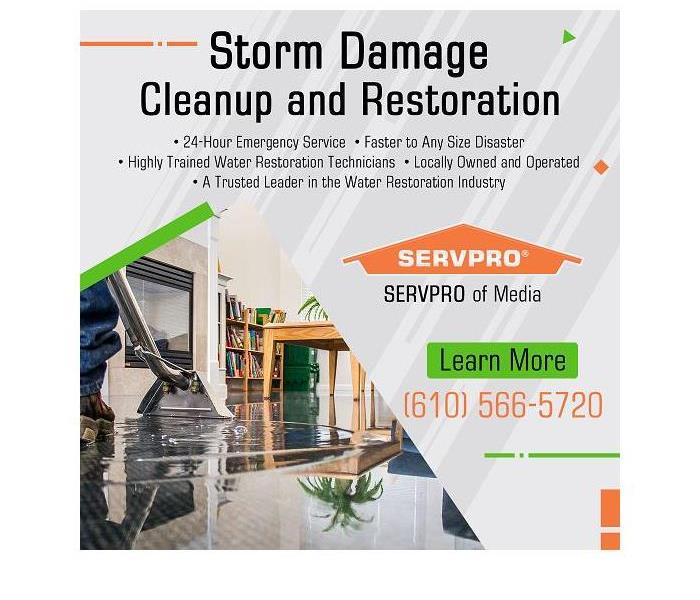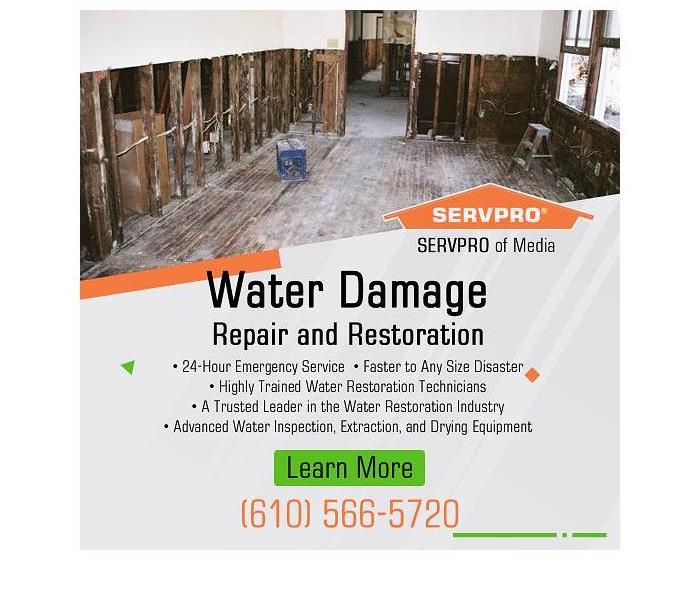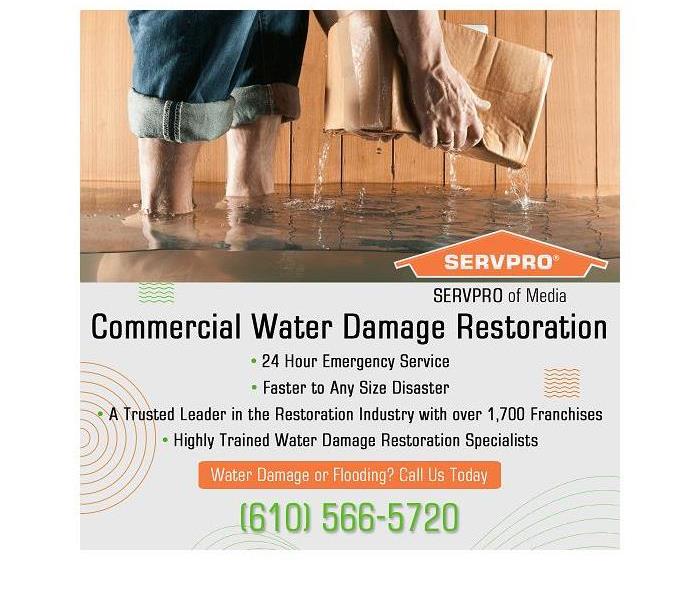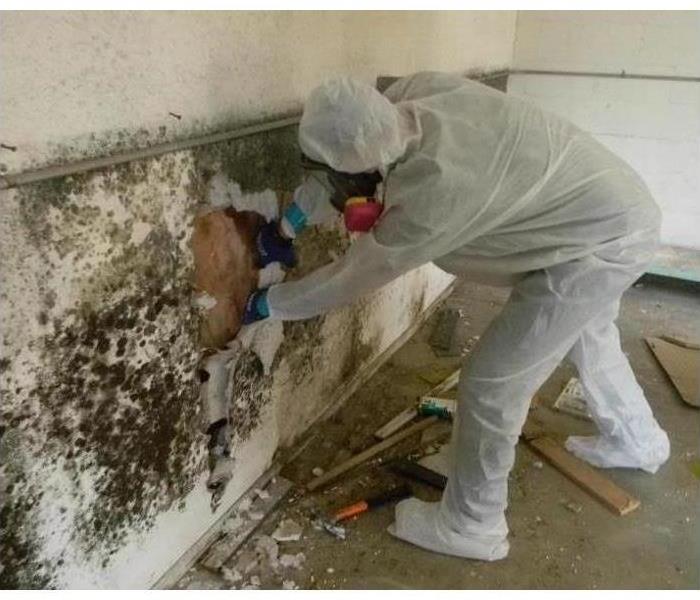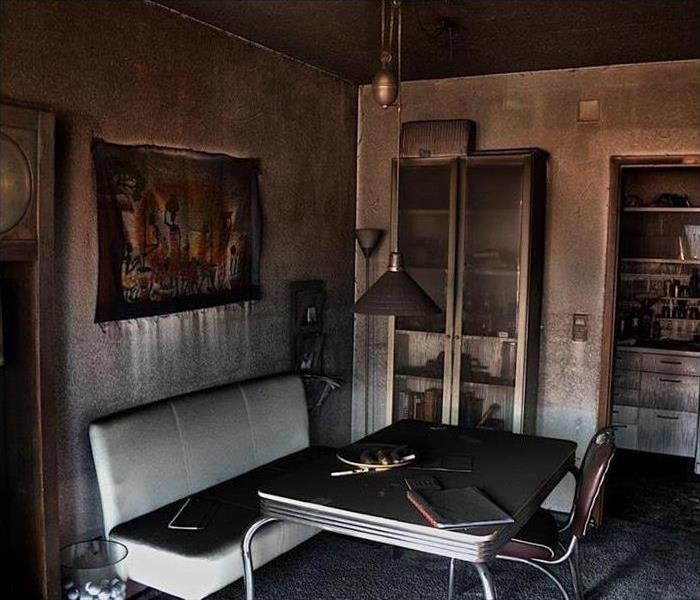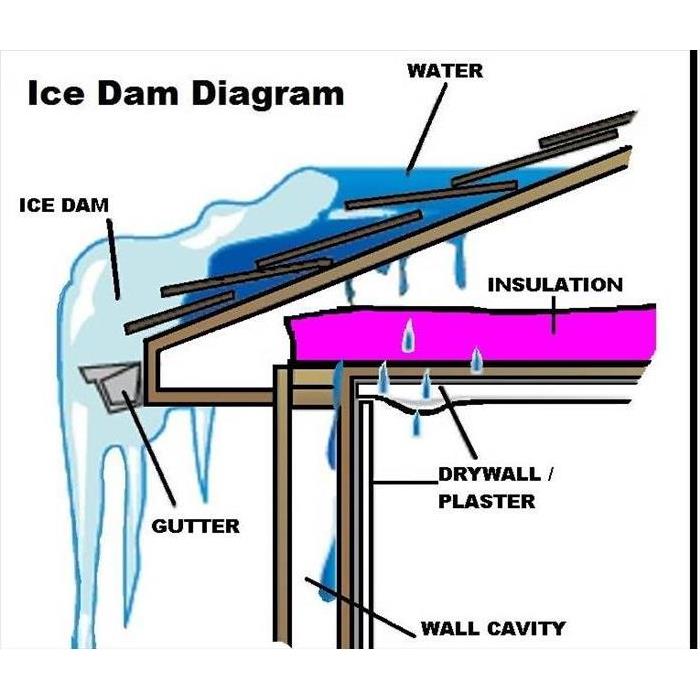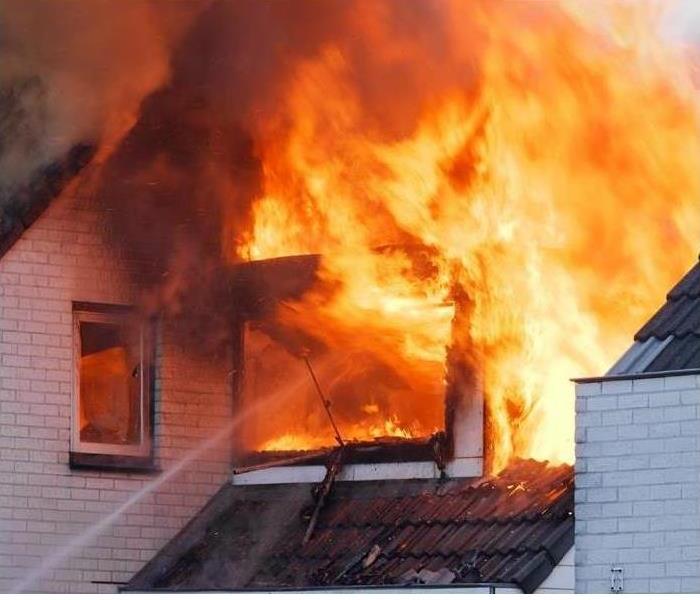Archived Blog Posts
Unlocking the Power of SERVPRO of Media for Commercial Businesses: A Comprehensive Guide
2/21/2024 (Permalink)
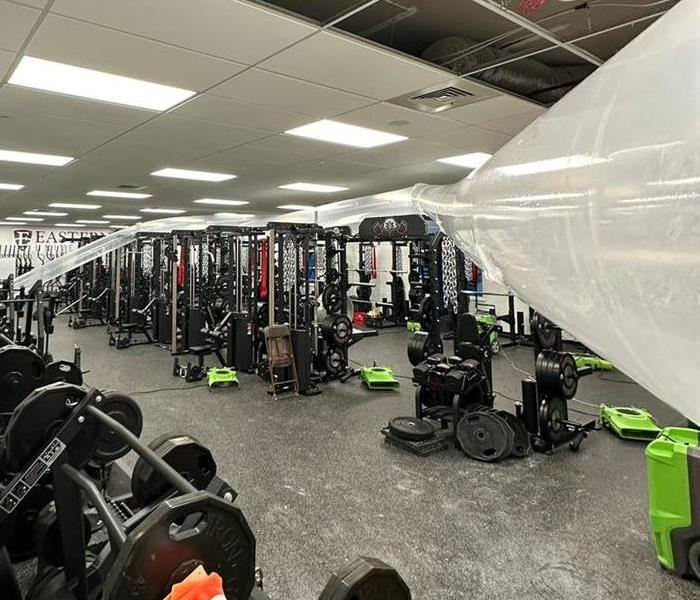 This is a local gym that was affected during a storm during mitigation due to water damage.
This is a local gym that was affected during a storm during mitigation due to water damage.
In the realm of commercial enterprises, unexpected disasters and emergencies can strike at any moment, disrupting operations and causing chaos. Whether it's a fire, flood, mold infestation, or any other unforeseen event, the ability to swiftly recover and resume business operations is paramount. This is where SERVPRO of Media emerges as a valuable ally for commercial businesses of Lawrence Park, P.A., offering unparalleled restoration and cleanup services to get you back on track with minimal downtime.
Understanding the Role of SERVPRO of Media
SERVPRO of Media is not just another restoration company. It's a trusted partner equipped with the expertise, resources, and technology to handle commercial restoration projects of any scale. From small businesses to large corporations, SERVPRO of Media understands the unique needs and challenges that commercial properties face, providing tailored solutions to ensure swift recovery and minimal disruption.
Rapid Response and Emergency Preparedness
One of the key advantages of partnering with SERVPRO of Media is their rapid response capability. Emergencies don't wait for convenient times to strike, and neither does SERVPRO®. With their 24-hour emergency service, they're always ready to spring into action at a moment's notice. This prompt response is crucial for commercial businesses, as every minute lost during a disaster can translate into significant revenue loss.
Additionally, SERVPRO of Media offers proactive emergency preparedness planning. By conducting thorough assessments of your commercial property and developing customized emergency response plans, they help businesses mitigate risks and minimize the impact of potential disasters. From identifying vulnerable areas to establishing communication protocols, SERVPRO of Media ensures that your business is well-prepared to face any emergency situation.
Comprehensive Restoration Services
Whether it's water damage, fire damage, mold remediation, or any other restoration need, SERVPRO of Media delivers comprehensive solutions to restore your commercial property to its preloss condition. Their team of highly trained professionals utilizes state-of-the-art equipment and advanced techniques to efficiently mitigate damage and expedite the restoration process.
Furthermore, SERVPRO of Media understands the importance of minimizing downtime for commercial businesses in Lawrence Park, PA. They work tirelessly to streamline the restoration process, allowing you to resume operations as quickly as possible. From coordinating with insurance providers to managing logistics and scheduling, SERVPRO of Media handles every aspect of the restoration process with precision and efficiency.
Beyond Restoration: Specialty Cleaning Services
In addition to restoration services, SERVPRO of Media offers a wide range of specialty cleaning services tailored to the unique needs of commercial businesses in Lawrence Park, PA. Whether you require deep cleaning for high-traffic areas, odor removal, or biohazard cleanup, they have the expertise and resources to deliver exceptional results.
By investing in professional cleaning services from SERVPRO of Media, commercial businesses can maintain a clean and safe environment for employees, customers, and visitors. This not only enhances the overall appearance of the property but also promotes health and wellness, ultimately contributing to increased productivity and customer satisfaction.
Conclusion
In the fast-paced world of commercial business, the ability to effectively navigate and recover from unexpected disasters is essential for success. By partnering with SERVPRO of Media, commercial businesses gain access to unmatched expertise, rapid response capabilities, and comprehensive restoration services that ensure minimal disruption and maximum peace of mind.
Don't wait until disaster strikes. Take proactive steps to safeguard your business and ensure its resilience in the face of emergencies. Contact SERVPRO of Media today and unlock the full potential of professional restoration and cleaning services for your commercial property.
What is a Puffback? What You Need to Know!
2/5/2024 (Permalink)
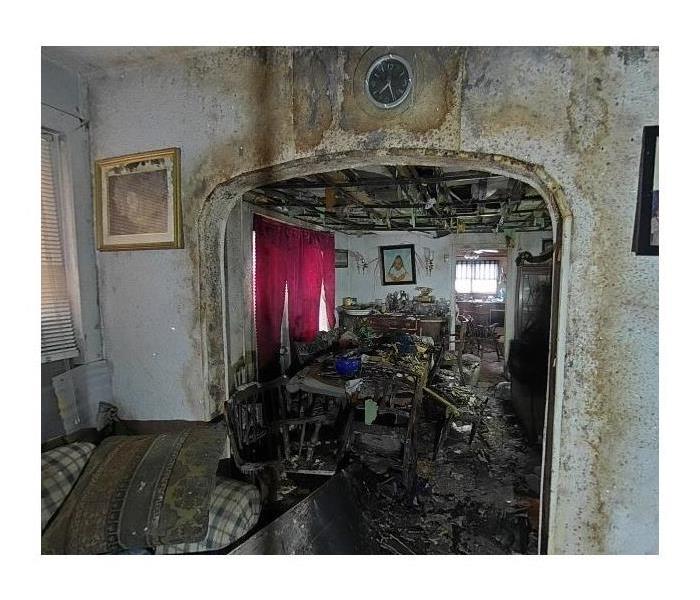 this fire started in the kitchen and destroyed the whole first floor
this fire started in the kitchen and destroyed the whole first floor
As a homeowner, you're probably familiar with various potential threats to your property, from natural disasters like floods and fires to more insidious issues like mold growth. However, there's one problem that often flies under the radar but can be just as damaging: puffbacks. In this blog, we'll explore what puffbacks are, what causes them, and how SERVPRO® of Media can help you when faced with this unexpected and messy situation.
Puffbacks are a phenomenon commonly associated with oil-based heating systems, such as furnaces and boilers. These systems can occasionally malfunction and cause uncontrolled explosions or "puffs" of soot, debris, and smoke. These puffbacks can be minor or severe, but regardless of their intensity, they can leave a trail of destruction in your home.
Causes of Puffbacks
- Delayed Ignition: One of the primary causes of puffbacks is delayed ignition. When oil-based heating systems do not ignite immediately upon startup, it can lead to a buildup of oil fumes in the combustion chamber. When ignition finally occurs, it can cause an explosive release of these built-up fumes, resulting in a puffback.
- Clogged or Blocked Venting: Blocked or clogged venting systems can prevent the proper release of combustion gases. This can cause these gases to back up into the heating system, potentially leading to a puffback.
- Poor Maintenance: Neglecting the maintenance of your heating system is a recipe for disaster. Regular maintenance can help identify and prevent issues that could lead to puffbacks.
Effects of Puffbacks
Puffbacks can have far-reaching effects on your home, including:
- Soot and Smoke Damage: Puffbacks release soot and smoke throughout your home. This can cover walls, ceilings, floors, and personal belongings, leading to extensive cleanup and restoration.
- Health Concerns: The soot and smoke produced during a puffback can pose health risks, especially for individuals with respiratory issues. It's essential to address the issue promptly and professionally.
- Lingering Odors: Puffbacks often leave behind persistent, unpleasant odors that can be challenging to eliminate without professional help.
How SERVPRO of Media Can Help
When faced with a puffback, it's crucial to turn to professionals who specialize in fire and smoke damage restoration. SERVPRO of Media has the expertise, experience, and equipment necessary to tackle puffback-related issues efficiently and effectively. Our services include:
- Soot and Smoke Cleanup: We'll clean and remove soot and smoke residue from every affected surface, restoring your home to its pre-puffback condition.
- Odor Removal: We employ advanced techniques and equipment to eliminate lingering odors, ensuring your home smells fresh and clean.
- Restoration and Repairs: Our team can repair and restore any damage caused by the puffback, from damaged walls and ceilings to HVAC systems.
- Preventive Measures: We can also provide recommendations and services to help prevent future puffbacks, such as routine maintenance for your heating system.
Puffbacks are an unexpected and unwelcome occurrence for homeowners with oil-based heating systems. They can leave behind a trail of destruction and health risks when they happen. However, SERVPRO of Media is here to help you recover and restore your home to its pre-puffback condition. If you're ever faced with a puffback, don't hesitate to reach out to the professionals at SERVPRO of Media for expert assistance and peace of mind.
What is an ERP and why should you choose SERVPRO?
2/5/2024 (Permalink)
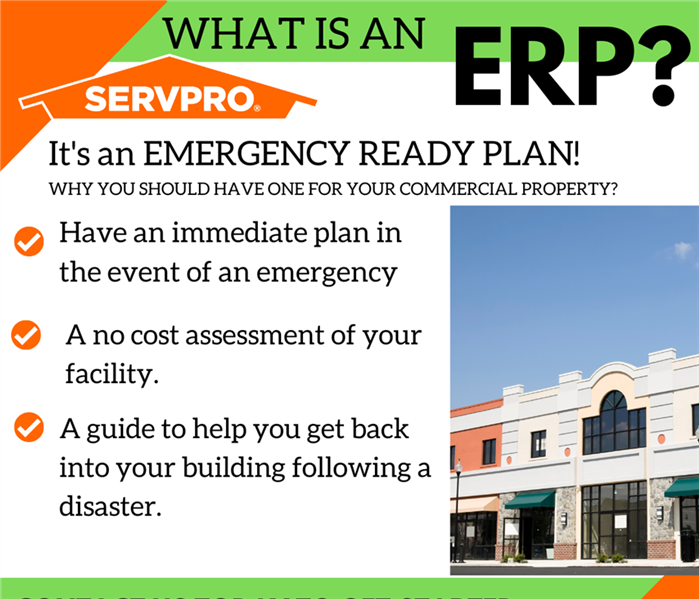 This picture contains some key points as to why you SHOULD have an ERP for your business
This picture contains some key points as to why you SHOULD have an ERP for your business
In the realm of emergency restoration services, swift and effective response is not just a goal; it's a commitment. SERVPRO of Media, as a stalwart in the industry, understands the critical importance of preparedness. SERVPRO of Media's, Emergency Readiness Plan (ERP) – a blueprint for resilience that ensures the company is well-equipped to handle emergencies with precision and care.
The Foundation of Emergency Readiness:
Client-Centric Approach: SERVPRO® recognizes that emergencies can be distressing for clients. The ERP is designed with a client-centric focus, aiming to alleviate stress by providing assurance that their properties are in capable hands. From initial contact to the restoration process, every step is meticulously planned to prioritize customer satisfaction and peace of mind.
Risk Assessment and Preparedness: The first pillar of SERVPRO of Media's ERP involves a thorough risk assessment. By identifying potential risks and vulnerabilities, the team can develop strategies to mitigate these challenges effectively. This proactive approach ensures that the company is ready to face a spectrum of emergencies, from natural disasters to unforeseen events.
Key Components of SERVPRO of Media's Emergency Readiness Plan:
Customized Planning: The ERP is not a one-size-fits-all solution, but a customized plan tailored to the specific needs and requirements of each client. This approach ensures that every aspect of the emergency response aligns seamlessly with the individual circumstances of the situation.
Clear Communication Protocols: Communication is the backbone of any successful emergency response. SERVPRO of Media's ERP includes clear communication protocols that facilitate swift and transparent information flow. Whether it's updates for clients, coordination among team members, or communication with external stakeholders, a well-defined plan ensures everyone is on the same page.
Technological Integration: SERVPRO of Media leverages cutting-edge technology to enhance its emergency response capabilities. From advanced monitoring systems to state-of-the-art restoration equipment, technology is seamlessly integrated into the ERP to optimize the restoration process and ensure a rapid, efficient response.
Proactive Training and Continuous Improvement:
Employee Training: SERVPRO of Media places a strong emphasis on the continuous training of its team members. Regular drills and training sessions ensure that every member of the team is well-versed in their roles and responsibilities during an emergency. This proactive approach minimizes response time and enhances the overall effectiveness of the restoration process.
Feedback Mechanisms: An integral part of SERVPRO of Media's ERP is the incorporation of feedback mechanisms. After every emergency response, a thorough evaluation is conducted to identify areas of improvement. This commitment to continuous learning and improvement ensures that the company evolves with the ever-changing landscape of emergency restoration services.
The Assurance of SERVPRO of Media's Emergency Readiness Plan:
In times of crisis, SERVPRO of Media stands as a beacon of assurance and resilience. The meticulous planning, client-centric approach, and commitment to technological innovation make their Emergency Readiness Plan a benchmark in the industry. As a trusted partner in emergency restoration, we not only restore properties but also restores confidence and peace of mind.
The Emergency Readiness Plan is more than a document; it's a testament to our dedication to excellence. By weaving together customized planning, clear communication, technological integration, and continuous improvement, SERVPRO of Media ensures that it remains at the forefront of emergency restoration services. When it comes to navigating the unexpected, SERVPRO of Media is not just prepared; it's prepared to exceed expectations.
Water removal: An essential service in Westbrook Park
1/11/2024 (Permalink)
Key Takeaways
- Importance of timely water removal.
- Overview of SERVPRO of Media's water removal services.
- Benefits of professional water damage restoration.
At SERVPRO® of Media, we understand the upheaval and distress that water emergencies bring, especially in the Westbrook Park area. This blog post dives deep into the critical necessity of immediate water removal, highlighting our commitment to rapid response and effective solutions. We'll explore the risks associated with delayed water removal and the importance of preventing structural damage and mold growth, underscoring why timely action is not just a service but a necessity for the safety and preservation of your property.
The urgency of water removal in Westbrook Park
In the neighborhood of Westbrook Park, water damage can be more than just a nuisance; it's a potential threat to the integrity of homes and businesses. Understanding the urgency of water removal in Westbrook Park is crucial. Whether due to natural causes like storms or household mishaps, the speed of response can significantly impact the extent of damage and the recovery process. This section delves into why rapid water damage restoration is vital in Westbrook Park.
Why immediate water removal is crucial
- Preventing structural damage: Water can weaken structural components like joists and beams, risking the safety of the building.
- Mitigating mold and mildew growth: Mold can develop within 24-48 hours of water exposure, posing health risks.
- Reducing restoration costs: The quicker the water is removed, the less damage incurred, thereby decreasing restoration costs.
- Avoiding electrical hazards: Water and electricity are a dangerous mix. Immediate removal reduces the risk of electrical hazards.
- Preserving personal belongings: Fast water removal helps save furniture, electronics, and other personal items from irreversible damage.
- Preventing floor and wall damage: Prolonged exposure to water can severely damage flooring and walls, leading to costly repairs.
- Minimizing disruption: Quick action means a faster return to normalcy, reducing your property's time in disarray.
- Avoiding secondary damage: A delay in water removal can lead to additional problems like wood swelling, metal rusting, and material delamination.
- Maintaining property value: Ensuring prompt water removal maintains the property's structural integrity and aesthetic value, which is crucial for its market value.
SERVPRO of Media’s rapid response approach
In the face of water emergencies, the response speed can make a difference. At SERVPRO of Media, we pride ourselves on our rapid response approach, understanding that each moment counts when dealing with water damage. Our commitment to being 'Faster to Any Disaster' is not just a slogan; it's a promise to our community in Westbrook Park and beyond. Equipped with advanced tools and a highly trained team, we are always prepared to respond swiftly to water damage. We know that fast action is key to mitigating damage, reducing restoration costs, and easing the stress of those affected. Our approach is tailored to the unique needs of each situation, ensuring that our response is quick and effectively addresses the specific challenges of the incident. With SERVPRO of Media, you can rest assured that prompt, efficient, and compassionate service is just a call away.
Faster to any disaster
- 24/7 availability: Ready to respond at any hour, ensuring no delay in addressing water emergencies.
- Rapid mobilization: Our teams are equipped to move quickly, reducing the time between the call and our arrival.
- Immediate assessment and action: On-site evaluation is conducted promptly to begin water removal and damage mitigation.
- Advanced technology: Utilizing the latest water extraction and drying technology for efficient and effective response.
- Skilled professionals: Highly trained technicians adept in handling all levels of water damage emergencies.
- Coordination with local authorities: Working in tandem with local emergency services when necessary.
- Preparedness for large-scale disasters: Equipped to handle large and complex situations, ensuring readiness for any scenario.
Tailored services for Westbrook Park
- Localized knowledge: Understanding of Westbrook Park's specific environmental and structural nuances.
- Customized solutions: Services adapted to meet the unique challenges and needs of the Westbrook Park community.
- Community-centric approach: Prioritizing the comfort and concerns of local residents and businesses.
- Adaptability to weather patterns: Preparedness for common weather-related incidents in the area.
- Personalized communication: Keeping clients informed and involved at every step of the restoration process.
- Long-term mitigation strategies: Offering advice and solutions to prevent future water damage incidents.
- Support with insurance processes: Assisting residents in navigating insurance claims and paperwork specific to the region.
The water removal process: a closer look
Water damage can be overwhelming, but understanding the water removal process can provide reassurance during a stressful time. At SERVPRO of Media, we've refined our water damage restoration process to ensure efficiency and effectiveness, tailored to each unique situation. This detailed look into our process offers insights into how we tackle water emergencies, from the initial emergency contact to the final steps of restoration. Our approach is designed to minimize damage, restore safety, and bring peace of mind to those affected. We'll guide you through each step, highlighting the meticulous care and expertise that goes into restoring your property to its pre-damage condition.
Step 1 - Emergency contact
The first step, the emergency contact, is critical. It's when we establish communication with the client and begin to understand the scope of the situation. During this initial contact, our representatives are trained to gather essential information to inform our response strategy. We guide clients through the crisis, asking pertinent questions to assess the severity of the water damage and ensuring we arrive on-site with the appropriate equipment and resources.
Step 2 - Inspection and damage assessment
Our trained professionals conduct a thorough inspection of the property to assess the extent and type of water damage. This step involves identifying the water source, categorizing the water damage (clean, gray, or black water), and determining the level of contamination. The assessment guides our strategy for water removal and restoration, ensuring a comprehensive approach that addresses all aspects of the damage.
Step 3 - Water extraction
Water extraction is a critical step in mitigating further damage. SERVPRO of Media utilizes powerful pumps and vacuum units to efficiently remove large volumes of water. This rapid extraction is key to preventing secondary water damage and mold growth, setting the foundation for successful drying and dehumidification.
Step 4 - Drying and dehumidification
Following water extraction, our team employs advanced drying techniques and equipment. We use industrial-grade dehumidifiers and air movers to eliminate remaining moisture, even in hard-to-reach areas. This precise process is crucial for preventing lingering moisture that could lead to further damage or mold.
Step 5 - Cleaning and sanitizing
Post water removal, the focus shifts to cleaning and sanitizing the affected areas. SERVPRO of Media ensures that all restorable items and structures are thoroughly cleaned using various techniques. Our team also provides sanitizing treatments and odor removal to ensure a safe and comfortable environment.
Step 6 - Restoration
The final step involves restoring the property to its pre-water damage condition. This phase can range from minor repairs, such as replacing drywall and installing new carpet, to major repairs or reconstruction of entire rooms or areas. Our goal is to restore the structure and our clients' peace of mind.
Beyond removal: Comprehensive water damage restoration
In the aftermath of water damage, the journey to restoration extends far beyond mere water removal. At SERVPRO of Media, our commitment to comprehensive water damage restoration encompasses every aspect of recovery, ensuring not just the structural integrity of your property but also the health and comfort of its occupants. This phase of our service, pivotal in transforming a space from damaged to renewed, involves meticulous cleaning, sanitizing, and restoration practices. Tailored to each unique situation, our methods aim to deliver a complete solution, restore properties to their pre-damage state with care and precision, and provide peace of mind to our clients.
Advanced techniques and equipment
In the realm of water damage restoration, the utilization of advanced techniques and state-of-the-art equipment is not just a benefit; it's a necessity. At SERVPRO of Media, we are equipped with cutting-edge technology designed specifically for effective and efficient water removal and restoration. Our approach combines scientific principles with innovative tools to thoroughly treat every water-damaged area, from visible water pools to hidden moisture pockets. This commitment to utilizing the best in technology underlines our dedication to providing superior service in water damage restoration.
Cutting-edge technology for effective water removal
- High-capacity water extractors: Essential for rapidly removing large volumes of water, these powerful machines significantly reduce drying time and prevent secondary water damage.
- Infrared cameras: We use infrared cameras to detect hidden water behind walls and ceilings, ensuring no moisture is overlooked.
- Submersible pumps: Pumps are used for continuous pumping of high-level water, ideal for severe flooding situations.
- Industrial air movers and dehumidifiers: We use dehumidifiers and air movers as they are crucial in the drying process, speeding up the evaporation of moisture from structural materials and furnishings.
- Hygrometers and moisture detectors: These tools accurately measure moisture levels, providing a comprehensive understanding of the extent of water saturation.
- Air scrubbers and HEPA vacuums: Employed to filter and clean the air of contaminants and mold spores that can proliferate after water damage.
- Environmentally safe cleaning agents: Used for sanitizing affected areas, ensuring safety and thoroughness in the cleanup process.
- Portable power generators: Providing uninterrupted power supply to run all equipment efficiently, especially crucial in areas where power outages may occur.
Why choose SERVPRO of Media for water removal
Choosing SERVPRO of Media for water removal offers numerous advantages, ensuring that you receive the best possible service during a water emergency:
- Rapid Response: SERVPRO of Media prides itself on its quick response time, understanding that in water damage situations, every minute counts.
- Experienced Professionals: With a team of highly trained specialists, they bring expertise and knowledge to every job, ensuring effective and efficient water removal.
- Advanced Equipment: Utilizing state-of-the-art water removal and drying equipment, SERVPRO of Media ensures thorough and speedy restoration of your property.
- Comprehensive service: From initial assessment to final restoration, they offer a complete solution, handling every aspect of water damage.
- Local expertise: Understanding the specific needs and challenges of the Media area, they provide tailored services to address local concerns.
- Customer-centric approach: Prioritizing customer satisfaction, they ensure clear communication and understanding of each client's needs throughout the process.
- Insurance coordination: Assisting with insurance claims and paperwork, they make the process as smooth and stress-free as possible.
These qualities make SERVPRO of Media an ideal choice for addressing water removal needs with professionalism and care.
Preparing for water emergencies: Tips for Westbrook Park residents
Living in Westbrook Park means being proactive in preparing for water emergencies. Being well-prepared can significantly reduce the damage and stress caused by unexpected flooding. This section is dedicated to empowering residents with essential tips on what to do after flooding and highlighting common pitfalls to avoid. These actionable guidelines help homeowners effectively manage post-flooding scenarios, ensuring safety and minimizing damage until professional help like SERVPRO of Media arrives.
What to do after flooding
- Remove excess water: Start by mopping and blotting to remove as much water as possible.
- Protect furniture: Wipe excess water from wood furniture and place aluminum foil or wood blocks under furniture legs on wet carpeting.
- Manage upholstery: Remove and prop up wet upholstery and cushions for drying.
- Enhance air circulation: Turn on air conditioning in summer for maximum drying.
- Relocate rugs and art: Remove colored rugs and art objects to a safe, dry place.
- Gather loose items: Pick up any items from the floor to prevent additional damage??.
What NOT to do after flooding
- Avoid leaving wet fabrics: Hang wet fabrics, furs, and leather goods to dry.
- Prevent staining: Keep colored items off wet carpets or floors to avoid staining.
- Don’t use a household vacuum: Never use a regular vacuum to remove water.
- Electrical caution: Avoid using electrical appliances in affected areas.
- Ceiling safety: Stay out of rooms with sagging ceilings, and don’t use ceiling fixtures if wet?.
Partnering with your insurance for a stress-free experience
Dealing with the aftermath of water damage is challenging enough without the added stress of insurance claims and paperwork. Recognizing this, SERVPRO of Media offers comprehensive support in navigating these complexities. Our aim is to streamline the insurance claim process, making it as smooth and hassle-free as possible. By partnering with your insurance company, we help lift the burden off your shoulders, allowing you to focus on what matters most – getting your life and property back to normal.
Navigating insurance claims with ease
At SERVPRO of Media, we understand that dealing with insurance claims can be a daunting aspect of water damage recovery. Our team is equipped to assist you every step of the way in navigating these claims. Here’s how we make the process easier:
- Documentation and evidence: We meticulously document the damage and provide detailed evidence, which is crucial for claim processing.
- Direct communication with insurers: Our experienced staff liaises directly with your insurance company, ensuring that all necessary paperwork and details are handled professionally.
- Understanding policies: We help you understand the coverage of your insurance policy, clarifying what is and isn’t covered in the context of water damage.
- Streamlining the process: Our goal is to expedite the claims process, minimizing delays so that restoration work can commence promptly.
- Advocacy for fair coverage: We advocate on your behalf to ensure you receive the fair coverage you’re entitled to under your insurance policy.
- Stress reduction: By taking over the insurance navigation process, we significantly reduce the stress and anxiety often associated with filing claims.
- Continuous updates and communication: Keeping you informed throughout the process, we ensure transparency and clarity so you’re never in the dark about the status of your claim.
SERVPRO of Media’s comprehensive approach to handling insurance claims reflects our commitment to providing an all-encompassing, stress-free restoration experience.
Ensuring safety and comfort in Westbrook Park
Ensuring the safety and comfort of residents in Westbrook Park is at the heart of what we do at SERVPRO of Media. Our community is more than just a collection of homes and businesses; it's a place where people live, work, and build memories. In the face of water emergencies, our primary goal is to restore the physical structures and the sense of security and normalcy for each individual and family affected. Our thorough water removal is designed to address our community's immediate and long-term needs. We are committed to providing a service beyond mere restoration, ensuring that every resident of Westbrook Park can return to a safe and comfortable living environment as quickly as possible. If you're facing water damage challenges, don't hesitate to contact us at (610) 566-5720.
Water damage restoration: combatting Woodland, PA’s basement and crawl space flooding
12/21/2023 (Permalink)
Basements and crawl spaces in Woodland homes are often prone to unexpected flooding, posing a significant challenge for homeowners. This common yet disruptive problem can lead to extensive water damage if not addressed promptly. Understanding the causes and immediate actions required is crucial in mitigating the impact. This blog explores why these floods occur and how they can be effectively managed. SERVPRO® of Media brings expertise in water damage restoration services to the forefront, equipping Woodland residents with the knowledge and tools needed to protect their homes from the damage of unexpected water intrusion.
Understanding the causes of basement and crawl space flooding
In Woodland, geographical and climatic factors are significant in frequent basement and crawl space flooding. The area's topography, characterized by its specific soil composition and water table levels, often contributes to groundwater accumulation, especially during heavy rainfall or rapid snowmelt periods. This natural tendency, combined with the region's weather patterns, can create the perfect storm for water intrusion into lower levels of homes.
Moreover, many homes in Woodland, whether old or new, share common structural vulnerabilities that make them susceptible to water damage. Understanding these factors is the first step in safeguarding homes against the challenges of basement and crawl space flooding in Woodland.
Poor drainage and water accumulation
- Inadequate slope around the property: One of the primary causes of poor drainage is the lack of a proper slope away from the foundation. If the ground slopes toward the house, it directs water flow toward the basement or crawl space, increasing the risk of flooding.
- Clogged or inefficient gutter systems: Gutters and downspouts are crucial in directing rainwater away from a property. When they are clogged with debris or improperly installed, water overflows and accumulates near the foundation, leading to potential seepage into the basement or crawl space.
- Improperly installed or damaged drain tiles: Drain tiles, essential for diverting water away from the foundation, can be ineffective if improperly installed or damaged. This can result in water pooling around the property, increasing hydrostatic pressure and forcing water into lower areas of the home.
- Surface water runoff issues: Heavy rainfall can lead to significant surface runoff in areas like Woodland. Without adequate drainage systems, this runoff can accumulate around the property, overwhelming the soil's capacity to absorb water leading to water intrusion in basements and crawl spaces.
By addressing these common drainage issues, homeowners in Woodland can significantly reduce the risk of water buildup and subsequent flooding in their basements and crawl spaces. Regular maintenance of drainage systems and proactive measures to ensure proper water diversion are key to mitigating these risks.
Cracks and gaps in foundations
- Foundation settlement and movement: Over time, foundations can settle or shift due to soil changes, especially in areas with expansive clay or poorly compacted soil. This movement can create cracks and gaps in the foundation, making water pathways enter basements or crawl spaces.
- Hydrostatic pressure: In Woodland, heavy rains or snowmelt can increase the hydrostatic pressure in the soil surrounding a home. This pressure can force water through even the smallest cracks in the foundation, leading to seepage and potential flooding.
- Shrinkage and expansion: Concrete foundations naturally shrink as they cure and can expand and contract with temperature fluctuations. These processes can lead to the formation of cracks over time. Although some cracking is normal, significant cracks can become a serious issue for water intrusion.
- Poor construction or material deterioration: Inadequate construction techniques or the use of substandard materials during the building phase can result in weaknesses in the foundation. Additionally, older foundations can deteriorate over time due to environmental exposure and stress, creating gaps and cracks.
Regular inspection and maintenance of foundations are crucial for identifying and addressing these structural vulnerabilities. Early detection and repair of cracks and gaps can prevent minor issues from escalating into major water intrusion problems in homes in Woodland.
Immediate steps to tackle basement and crawl space flooding
Discovering a flooded basement or crawl space can be alarming, but immediate action is essential to limit the damage. First and foremost, it's important to ensure your safety, particularly from any electrical hazards. Once it's safe, the next critical step is to identify the water source. Quick and decisive actions can greatly reduce the extent of damage, easing the subsequent water cleanup and restoration efforts. In this guide, we at SERVPRO of Media provide the necessary steps to address basement and crawl space flooding effectively, leveraging our extensive experience in water damage restoration.
Identifying and stopping the source of water
- Inspect plumbing systems: Check for leaks or bursts in pipes, faucets, and water heaters. If a plumbing issue is found, we recommend shutting off the main water supply immediately to halt further water flow.
- Examine exterior factors: Assess gutters, downspouts, and the foundation for evidence of water breaching. Make sure gutters are effectively channeling water away from the house and that there's no water pooling near the foundation.
- Evaluate windows and doors: Look for water infiltration through basement windows or doors. Inadequate sealing or existing cracks are often responsible for such leaks.
- Roof and upper-level inspection: Basement water can sometimes originate from leaks in higher areas of the home. We advise checking attics, roofs, and upper floors for any signs of leaks contributing to the problem.
At SERVPRO of Media, we are skilled in quickly identifying and resolving these typical sources of water intrusion, ensuring further damage is prevented, and initiating an effective water damage restoration process.
Removing water and moisture
- Use of water pumps and wet vacs: For significant flooding, use submersible pumps or wet/dry vacuums to remove standing water. This is especially effective in quickly reducing the water level in flooded areas.
- Mopping and blotting: For less severe cases, mopping and blotting can help remove excess water. Focus on absorbing as much water as possible from floors, especially when mechanical removal is not feasible.
- Dehumidification: Deploy dehumidifiers to reduce moisture levels in the air. This helps prevent secondary water damage such as warping, swelling, or mold growth.
- Air circulation: Increase air circulation with fans to expedite the drying process. This is crucial in areas that are hard to reach or have absorbed much moisture.
- Removing wet materials: Discard or set aside wet materials like rugs, curtains, and upholstery for cleaning or drying. These items can hold moisture and contribute to a damp environment.
- Drying and restoration: Use specialized drying equipment to dry the affected areas thoroughly. SERVPRO of Media employs advanced techniques and tools for effective drying and restoration.
- Moisture detection: Utilize moisture detectors to check walls, floors, and ceilings for hidden moisture pockets. This ensures that all damp areas are identified and addressed to prevent mold and structural damage.
By following these steps, homeowners can effectively remove water and control moisture after a flooding event, minimizing the risk of further damage and creating a safe, dry environment. SERVPRO of Media provides professional expertise in carrying out these steps efficiently and thoroughly, ensuring a comprehensive water damage restoration in Woodland.
The role of professional water damage restoration services
In-home maintenance, the aftermath of water damage presents a scenario where the expertise of professional restoration services becomes indispensable. At SERVPRO of Media, we understand the complexities and nuances of water-related issues in homes, particularly in areas prone to flooding, like basements and crawl spaces. Our professional services are not just about addressing immediate water damage; they encompass a holistic approach that includes assessing the damage thoroughly, employing advanced water removal techniques, and implementing long-term solutions to prevent future issues.
Comprehensive water damage assessment
- Initial inspection: We begin with a detailed inspection of the affected area, utilizing state-of-the-art tools to evaluate the extent of water penetration and damage.
- Identifying the water source: Part of our assessment includes identifying the water source, which is crucial in preventing further damage.
- Classifying water damage: We classify the type of water damage – clean, gray, or black water – as this greatly influences the restoration strategy.
- Mapping moisture levels: Using moisture meters and infrared cameras, we accurately map out moisture levels in floors, walls, and ceilings to devise an effective drying plan.
- Evaluating property contents: We assess the affected property contents to determine what can be salvaged and what needs to be replaced.
- Developing a restoration plan: Based on our thorough assessment, we formulate a comprehensive plan for water removal, drying, cleaning, and restoration.
Advanced water removal techniques
- Submersible and gas-powered pumps: For extensive water accumulation, we utilize submersible and gas-powered pumps for continuous, high-level water extraction.
- Truck-mounted extraction units: These robust units are critical for removing water quickly and efficiently from large areas.
- Portable extraction units: In areas where larger units are impractical, we deploy portable extraction units for thorough water removal.
- Innovative drying techniques: We employ industrial-grade dehumidifiers and high-speed air movers to expedite drying.
- Thermal imaging cameras: We use thermal imaging cameras to detect hidden water in walls and ceilings to ensure no moisture is left behind.
- Sanitizing and deodorizing: Following water removal, we sanitize and deodorize the area to prevent mold growth and eliminate lingering odors.
Our advanced techniques and equipment testify to our commitment to providing comprehensive and effective water damage restoration, ensuring our clients a safe and restored environment.
Long-term solutions and preventative measures
While immediate response to flooding is crucial, focusing on long-term solutions and preventative measures is equally important for homeowners. Dealing with basement and crawl space flooding in Woodland isn't just about quick fixes; it's about adopting strategies that ensure lasting protection and safety. At SERVPRO of Media, we are committed to providing remediation and comprehensive prevention services. Our expertise extends to helping homeowners implement effective long-term solutions to minimize future risks of water damage.
Waterproofing and structural repairs
- Foundation waterproofing: To prevent water seepage, apply waterproof coatings and sealants to the foundation walls.
- Installing sump pumps: Sump pumps are crucial in actively removing water accumulating in basements, particularly in areas prone to flooding.
- French drains and exterior drainage solutions: Implement or improve exterior drainage systems, like French drains, to effectively redirect water away from the foundation.
- Repairing foundation cracks: Identifying and sealing cracks in the foundation to prevent water entry. This includes both external and internal crack repairs.
- Window covers and seals: Install covers and improve seals around basement windows to prevent water intrusion from heavy rains.
- Landscaping adjustments: Modifying the landscaping to ensure proper grading and drainage away from the home.
Regular maintenance and inspections
- Routine gutter cleaning: Keeping gutters and downspouts clear of debris ensures proper water flow away from the house.
- Regular sump pump checks: Periodically testing and maintaining sump pumps to ensure they are operational, especially before rainy seasons.
- Inspecting seals and joints: Checking seals around windows, doors, and pipes entering the basement or crawl space for any signs of wear or damage.
- Professional inspection services: Utilizing professional inspection services, like those offered by SERVPRO of Media, for an in-depth analysis of potential water damage risks.
- Monitoring humidity levels: Monitor humidity levels in basements and crawl spaces to detect any unusual increases that might indicate moisture problems.
- Educating homeowners: Providing homeowners with knowledge and awareness about the signs of potential water damage and the importance of regular maintenance.
Through these long-term solutions and regular maintenance practices, SERVPRO of Media helps homeowners in Woodland significantly reduce the risk of future basement and crawl space flooding, ensuring their homes remain dry, safe, and structurally sound.
Choose our comprehensive flood clean-up services today.
Understanding and effectively addressing the challenges of basement and crawl space flooding is vital for homeowners in Woodland. From the immediate steps needed to manage an unexpected flood to the long-term strategies required to prevent future occurrences, every aspect plays a crucial role in maintaining the integrity and safety of your home. It's not just about dealing with the present issue but also about proactively preventing potential problems.
Choosing SERVPRO of Media for your water cleanup needs ensures a professional approach. Our expertise in handling immediate restoration and implementing preventative measures provides peace of mind and guarantees quality service. With our advanced techniques for water removal, thorough moisture control, and dedication to long-term solutions like waterproofing and regular maintenance, we stand as a reliable partner for Woodland residents. Trusting SERVPRO of Media means ensuring that your home is restored to its pre-flood condition and fortified against future water-related challenges. Contact us at (610) 566-5720 to learn more about our water cleanup services.
Most Common Causes of Winter Water Damage in Rose Tree Homes
11/23/2023 (Permalink)
As the winter season settles over Rose Tree, the idyllic snowfall and serene landscapes can often belie the latent dangers to our homes. At SERVPRO® of Media, we understand that your home is your sanctuary, and protecting it from the ravages of winter is a paramount concern. The colder months bring unique challenges that can lead to significant water damage if not properly managed.
In this comprehensive guide, we will explore the most common causes of winter water damage that homeowners face. Our expertise in flood damage restoration and water damage remediation has shown us that forewarned is forearmed. We aim to arm you with knowledge and preparedness tips to safeguard your residence against the cold season's hazards. From frozen pipes to ice dams, we'll detail each potential problem area and how our professional flood damage restoration services can keep your property safe and dry. Join us as we delve into the intricacies of winter water woes and how to effectively combat them with SERVPRO of Media's trusted solutions.
The perils of pipe freezing and bursts
As winter tightens its grip on Rose Tree, the plummeting temperatures pose a significant threat to one of the most vital components of your home: the plumbing system. At SERVPRO of Media, we frequently respond to emergency calls for water damage restoration from frozen and burst pipes. Such incidents can cause extensive damage to the structure and integrity of your home, leading to costly repairs. In this section, we’ll discuss the dangers of pipe freezing and bursts, how they can wreak havoc on your property, and the immediate steps that can be taken to mitigate these risks.
How freezing temperatures affect plumbing
When the mercury dips, water in your pipes can freeze. This freezing process causes water molecules to expand, increasing pressure within the pipes. Residential plumbing is particularly susceptible to this freeze-induced pressure, especially in poorly insulated pipes or in unheated interior spaces like basements, attics, and garages.
Exterior walls with minimal insulation also pose a risk for the pipes housed within them. When the water expands as it freezes, it can exert pressure upwards of 2,000 pounds per square inch, enough to rupture most pipes. The resulting damage from a single burst pipe can be catastrophic, with water pouring into your home, damaging walls, floors, and furniture, and even leading to mold growth if not addressed promptly.
Preventative measures for pipe protection
At SERVPRO of Media, we believe in a proactive approach to safeguarding your home against the risks of pipe freezing and the subsequent water damage that can follow. Here are several strategies we recommend to protect your plumbing during the winter months:
Insulation is key: Ensure that all pipes, particularly those in unheated areas such as the attic, basement, and garage, as well as those running along exterior walls, are properly insulated. Insulation sleeves or wrapping can provide a first defense against the cold.
Seal the gaps: Examine your home for any cracks or holes in the walls or foundations, especially where pipes enter and exit the building. Use caulk or insulation to seal these gaps, preventing cold air from reaching the pipes.
Faucet drip: On extremely cold nights, keeping a faucet dripping can prevent pressure from building up within the pipes. The constant flow, even if minimal, helps to prevent water from freezing.
Cabinet doors open: Opening the cabinet doors under sinks can help warm air circulate the plumbing, especially if the sink is on an exterior wall.
Maintain a steady temperature: Keep your home's temperature consistent daily. While it may increase heating costs, it reduces the risk of pipes freezing and bursting, which can result in far more expensive repair costs.
Apply heating tape: For pipes that are easily accessible, applying electrical heating tape can provide direct heat to prevent freezing. It’s crucial to use products designed specifically for this purpose and to follow the manufacturer's instructions carefully to avoid fire risks.
Shut off outdoor faucets: Disconnect garden hoses and, if feasible, turn off and drain water from pipes running to exterior faucets using an inside valve. This lessens the possibility of ice accumulating in these lines.
Professional inspection: Have a professional inspect your plumbing system to identify and remediate any vulnerabilities. This can be especially valuable for older homes or those with a history of pipe freezing.
By implementing these measures, homeowners in Rose Tree can significantly diminish the likelihood of winter water damage due to frozen pipes. However, should you encounter water damage, SERVPRO of Media's flood damage restoration and remediation services are readily available to handle the situation promptly and efficiently, mitigating the damage and restoring your peace of mind.
Signs of frozen pipes and immediate actions
At SERVPRO of Media, we want to equip our clients with the knowledge to identify and react swiftly to the signs of frozen pipes. Recognizing these signs early on can prevent a minor inconvenience from becoming a major water damage event.
Signs of frozen pipes:
- Restricted water flow: When turned on, the most apparent sign of a frozen pipe is reduced, or no water flow from a faucet.
- Frost on the pipes: Visible frost accumulating on the exterior of a pipe often indicates that it is frozen inside.
- Strange noises: When a tap is opened, listen for unusual sounds like rattling or whistling, which can signal that ice is causing a blockage.
- Odor: An odd smell from a faucet or drain can sometimes occur if a pipe is partially or completely blocked, as the odor has nowhere to go but back into your home.
Immediate actions:
- Keep the faucet open: If you discover a frozen pipe, keep the faucet open. As you treat the frozen pipe and the ice begins to melt, water will flow through, helping to melt ice in the pipe.
- Apply heat to the frozen section: Use a hair dryer, heating pad, or portable space heater to apply heat to the frozen length of the pipe. Never use an open flame, which can damage the pipes and pose a serious fire hazard.
- Increase ambient heat: Raise the temperature in the home to help thaw the frozen pipe. This can be particularly effective for pipes that run through basements or other unheated areas.
- Insulate the area: If the frozen pipe is in an area that lacks insulation, adding temporary insulation can help raise the temperature enough to thaw the pipe. Even a towel wrapped around the pipe can help.
- Call a professional: If you cannot thaw the pipe, if you are not sure where the freeze is, or if you cannot access the frozen area, call a professional plumber or a water damage restoration service like SERVPRO of Media immediately to handle the situation.
- Shut off the water: If the frozen pipe bursts, shut off the main water supply to prevent severe water damage until repairs can be made.
SERVPRO of Media is ready to respond with emergency water damage restoration services if a frozen pipe leads to a water event in your home. Our professional team can quickly address the issue, minimize damage, and start the water damage repair and remediation process to restore your property to pre-damage condition. Remember, quick action is crucial, and our experts are here to help every step of the way.
The consequences of burst pipes
At SERVPRO of Media, we understand the gravity of a burst pipe and the extensive damage it can inflict on your Rose Tree home. A burst pipe is not just a plumbing issue—it can lead to a series of destructive events that compromise your living space's safety, structure, and comfort.
Immediate and long-term damage:
- Water damage to property: When a pipe bursts, the immediate gush of water can flood rooms, saturate carpets, ruin hardwood floors, and seep into drywall, causing substantial damage to the structure of your home.
- Mold and mildew growth: The moisture from a burst pipe creates an ideal environment for mold and mildew to thrive. These fungi can spread quickly, potentially causing health issues and damaging building materials and personal belongings.
- Electrical hazards: Water from a burst pipe can come into contact with electrical outlets, appliances, and wiring, posing a serious risk of electric shock or fire.
- Furniture and belonging damage: Personal items, furniture, electronics, and other belongings can be ruined by water exposure, leading to significant loss and the need for content restoration or replacement.
- Structural integrity: Over time, the continued presence of water can weaken structural elements like joists and beams, leading to potential long-term safety issues.
- Increased utility bills: A burst pipe can cause an unseen increase in water consumption, leading to unexpectedly high water bills.
- Displacement: Depending on the severity of the flooding, families may need to vacate their homes during the water damage remediation and restoration process.
SERVPRO's responsive actions:
When faced with the aftermath of a burst pipe, the SERVPRO of Media team swiftly implements a tried-and-tested protocol to manage the situation:
- Water extraction: Utilizing state-of-the-art equipment, we quickly remove standing water to halt ongoing damage.
- Drying and dehumidification: We employ industrial air movers and dehumidifiers to dry out affected areas, mitigating the risk of mold growth.
- Sanitization: Our professionals sanitize affected areas to prevent bacterial and mold growth and ensure a clean and safe environment.
- Restoration: We work diligently to repair and restore damaged structures and items to return your home to its pre-damaged state.
- Insurance liaison: Our team assists with documentation and communication with insurance companies to streamline the claims process.
By understanding the consequences of burst pipes and taking immediate action, homeowners can minimize damage and restore their homes efficiently. SERVPRO of Media is always prepared to provide comprehensive flood damage restoration services to the Rose Tree community, ensuring peace of mind and swift recovery from such unforeseen events.
Immediate steps we take for water damage repair
When faced with water damage from burst pipes, SERVPRO of Media swiftly mitigates the impact and begins the repair process. Our immediate response is crucial in preventing further damage and starting the restoration of your Rose Tree home.
Emergency contact and assessment: Our 24/7 emergency line ensures we're available when a disaster strikes. Upon contact, we quickly assess the situation to determine the extent of the water damage and plan the necessary steps for repair and restoration.
Water removal and extraction: Time is of the essence. Our team arrives with powerful pumps and vacuum units to swiftly remove thousands of gallons of water from your property, preventing secondary water damage and mold growth.
Drying and dehumidification: After water extraction, our focus shifts to drying and dehumidifying your home. We use industrial-grade air movers and dehumidifiers to remove any remaining moisture, closely monitoring progress to ensure your property is drying properly.
Securing the property: We may perform board-up services if necessary to prevent further damage or theft. This includes boarding up any broken windows and doors, as well as placing tarps on damaged roofs.
Sanitizing and odor removal: We clean all restorable items and water-damaged structures. Our professionals use various cleaning techniques to sanitize your belongings and air scrubbers and fogging equipment to remove odors.
Restoration and repairs: The final stage involves restoring your home to its pre-damage state. Minor repairs, such as changing drywall and adding new carpet, may be required, as may large repairs, such as reconstructing various portions or rooms in your house.
Communication and documentation: We maintain open and clear communication with you and your insurance provider throughout the process. We document every step and provide detailed reports to ensure a smooth claims process.
SERVPRO of Media’s professional team is trained to handle water damage with precision and care, ensuring that every step is taken to restore your property efficiently and effectively. We aim to make it "Like it never even happened," allowing you to return to your restored home as quickly as possible.
Long-term solutions to prevent future bursts
While immediate repairs are vital after a burst pipe, SERVPRO of Media also focuses on providing long-term solutions to help prevent future incidents in Rose Tree homes. Our holistic approach aims to fortify your home's defenses against the harsh winter conditions.
Improved insulation: We assess and enhance the insulation around your pipes, especially those in vulnerable areas such as basements, crawl spaces, and attics. By upgrading insulation, we help maintain a warmer pipe environment, reducing the risk of freezing.
Pipe relocation: In some cases, pipes may be in locations too high-risk for freezing. We can consult with plumbing professionals to determine if relocating these pipes to a warmer, more insulated area is a feasible long-term prevention method.
Upgraded piping materials: Older pipes made of metal are more prone to bursting when frozen. We may recommend upgrading to modern materials, such as PEX piping, which can expand slightly and are less likely to break under pressure.
Installation of water leak detection systems: These systems can monitor water flow and automatically shut off the water supply if abnormal flow is detected, potentially preventing a burst if a pipe begins to freeze.
Regular maintenance plans: SERVPRO of Media offers scheduled maintenance plans that include regular inspections and preventive maintenance to identify and address issues before they result in a burst pipe.
Educational resources: We provide homeowners with information and resources on how to properly care for their plumbing system, including tips for winterizing their homes and recognizing the early signs of a problem.
Emergency preparedness plan: We help develop a comprehensive emergency plan, including the location of the main water shut-off valve and the steps to take if a pipe bursts. This ensures a quick response to minimize damage.
By implementing these long-term preventive strategies, SERVPRO of Media helps homeowners in Rose Tree recover from the immediate effects of water damage and strengthen their homes against future winters, offering peace of mind and a safer, more secure living environment.
Ice dams and roof damage
In the winter months, Rose Tree homes face the unique challenge of ice dams, a common yet often overlooked cause of roof damage and water intrusion. At SERVPRO of Media, we're well-versed in the signs and subsequent risks of ice dams, and our mission is to help homeowners prevent the significant water damage they can cause. Understanding and addressing the formation of ice dams is critical in protecting the structural integrity of your roof and the overall well-being of your home. We're here to guide you through recognizing the early indicators of ice dams and taking decisive action to mitigate their impact.
Recognizing the formation of ice dams
Ice dams form when the heat from your attic warms the roof, except at the eaves. As snow on the warmer part of the roof melts, water runs down and refreezes at the colder eaves, creating a ridge of ice that prevents melting snow from properly draining off the roof. This water can back up behind the dam and leak into your home, causing damage to walls, ceilings, insulation, and other areas.
Signs of Ice Dams:
- Icicles: Although they can be a normal winter occurrence, large icicles forming at the roof's edge can be a preliminary sign of ice damming, especially if they are accompanied by ice buildup on the roof.
- Ice buildup: Look for a thick ridge of ice forming at the eave of the roof, which is a clear indicator of an ice dam.
- Water stains: Water stains on ceilings or walls could indicate that an ice dam has formed and water is penetrating the roof membrane, entering the attic, and affecting the interior of your home.
- Damp or swollen woodwork: The woodwork around windows and doors may become damp or swell if ice dams are causing water to infiltrate the building.
Actions to Take:
If you suspect an ice dam is forming:
- Remove snow from the roof: Use a roof rake to clear snow from the edge of your roof, if it is safe to do so, to prevent further ice buildup.
- Professional ice removal: Contact professionals like SERVPRO of Media to safely remove the ice dam without damaging your roof.
- Ventilate the attic: Improving attic ventilation can help maintain a consistent roof temperature and prevent the conditions that lead to ice dam formation.
- Increase insulation: Proper insulation helps prevent heat from escaping to the attic, which contributes to the formation of ice dams.
Recognizing and addressing the signs of ice dams early on can save you from costly repairs and water damage. SERVPRO of Media's team is equipped to repair the damage caused by ice dams and offer solutions to prevent their recurrence, safeguarding your home against the harsh winter elements.
The science behind ice dams and potential damage
At SERVPRO of Media, our understanding of the science behind ice dams allows us to tackle the root of the problem, not just the symptoms. An ice dam is a complex phenomenon that occurs through a combination of factors, primarily the interaction between outdoor temperatures, attic temperatures, and snow cover on the roof.
How ice dams form:
- Heat loss from the house: Heat escapes from the living space into the attic, raising the temperature and melting the bottom layer of snow on the roof.
- Melting and freezing cycle: As the meltwater runs down the roof, it reaches the colder eaves (the overhanging edge of the roof) and refreezes, gradually building up into a dam of ice.
- Water pooling: The ice dam prevents meltwater from draining off the roof, causing water to pool behind the dam. This standing water can seep under shingles and through the roof decking, leading to leaks.
Potential Damage from Ice Dams:
- Roof damage: The water that backs up behind ice dams can seep beneath shingles and into your home, compromising the roof structure and leading to costly repairs.
- Interior damage: As water infiltrates the interior, it can damage ceilings, walls, insulation, and other internal structures, potentially leading to mold and mildew problems.
- Gutter damage: The weight of the ice can strain gutters and downspouts, sometimes causing them to pull away from the house or even collapse.
- Peeling paint: Excess moisture from ice dams can lead to peeling paint on exterior and interior surfaces, indicating a deeper moisture problem.
- Compromised insulation: Wet insulation loses its insulative properties, increasing heat loss and energy costs, and provides a potential breeding ground for mold.
Understanding these risks, SERVPRO of Media takes a science-based approach to prevent ice dams. We assess the ventilation and insulation in your attic to ensure it's adequate and properly installed. Additionally, we can help rectify any internal heat loss contributing to ice dam formation, providing long-term solutions to this pervasive winter issue. When ice dams cause damage, we are equipped with the tools and expertise to handle the necessary water damage restoration, ensuring your home is restored to its pre-damage state.
SERVPRO’s remediation process for ice dam damage
When an ice dam causes damage to a home in Rose Tree, SERVPRO of Media follows a meticulous remediation process to resolve the issue efficiently and effectively. Our aim is not only to repair the damage but also to prevent future occurrences. Here’s how we handle ice dam damage:
- Initial inspection and damage assessment: We begin with a thorough inspection of the affected area to assess the extent of the damage caused by the ice dam. This includes examining the roof, gutters, attic, insulation, interior ceilings, and walls.
- Water mitigation: If the ice dam has led to water penetration, we prioritize water extraction to prevent further damage. Using advanced water removal equipment, we eliminate standing water and start the drying process.
- Ice dam removal: Our professionals safely remove ice dams from roofs to stop the source of water leaks. We use steamers and other specialized equipment to gently melt the ice without damaging the roofing materials.
- Drying and dehumidifying: We dry the affected areas using industrial air movers and dehumidifiers to prevent mold and mildew growth. Throughout this phase, we monitor moisture levels to ensure all structures dry properly.
- Restoration and repairs: We repair any water-damaged structures, including replacing soggy insulation, repairing damaged drywall, and repainting affected areas. If the roof is damaged, we'll perform the necessary repairs or replacements.
- Mold remediation: Should there be concerns about mold, our team also addresses these, cleaning and sanitizing the affected areas with antimicrobial treatments to prevent mold spores from spreading.
- Prevention measures: After repairs, we discuss long-term strategies to prevent future ice dam formation, including improving attic insulation and ventilation, installing heat cables, or sealing air leaks.
- Final inspection and consultation: Once the remediation process is complete, we conduct a final inspection to ensure all issues have been addressed. We also provide a consultation on how to maintain the integrity of the roof and attic to prevent ice dams in the future.
Throughout SERVPRO’s remediation process for ice dam damage, our focus is on thoroughness and quality. We ensure that each home is restored to a safe and comfortable environment. We provide homeowners with peace of mind by addressing the immediate damage and underlying issues contributing to ice dams, delivering a comprehensive solution tailored to their needs.
Protecting your roof from snow and ice
The roof is a critical defense against winter weather, and at SERVPRO of Media, we take the protection of your roof seriously. With the right measures, the risk of snow and ice damage can be significantly reduced, safeguarding your Rose Tree home throughout the winter. Here's our approach to protecting your roof from the harsh elements:
- Roof inspection and maintenance: Before the winter season, we recommend a professional inspection of your roof to identify any vulnerabilities, such as damaged shingles, weak spots, or inadequate insulation. Addressing these issues in advance can prevent snow and ice from exacerbating existing problems.
- Proper attic insulation and ventilation: To maintain an even roof temperature, your attic must be well-insulated and ventilated. This reduces the likelihood of ice dam formation by preventing warm spots on the roof that can melt snow and cause refreezing at the eaves.
- Installing heating cables: For areas prone to ice accumulation, we may suggest the installation of heating cables along the roof's edge. These cables generate enough heat to prevent ice from forming and allow for a continuous melting and drainage process.
- Snow removal plan: Accumulated snow on your roof can pose a risk due to its weight and the potential for melting and refreezing. We advise having a snow removal plan, which might include hiring professionals to remove snow safely from the roof, especially after heavy snowfall.
- Gutter cleaning and repair: Clear gutters and downspouts are vital for proper drainage. We encourage regular cleaning and maintenance to ensure they are not blocked by debris, which could cause water to back up and freeze on the roof.
- Tree trimming: Overhanging tree branches can drop additional snow onto your roof and pose a risk of physical damage. Trimming these branches back can prevent damage and reduce the amount of snow accumulating on your roof.
- Water-repellent membrane installation: For added protection, we can install a water-repellent membrane underneath the roof covering. This membrane is an additional barrier, preventing water that may get past the shingles from entering the home.
By implementing these measures, SERVPRO of Media helps to ensure that your roof is equipped to withstand winter conditions, minimizing the need for emergency water damage restoration services. Should you experience roof-related water damage, our team is ready to provide comprehensive flood damage restoration and remediation services to the Rose Tree community.
Snow melt and exterior flooding
How melting snow leads to flood damage
As the seasons change in Rose Tree, the thawing of winter's snow presents a new set of challenges. SERVPRO of Media is acutely aware that transitioning from cold to warmer temperatures can lead to exterior flooding, quickly becoming an indoor catastrophe. Our goal is to educate homeowners on the risks of snow melt and provide strategies to mitigate potential flood damage. With careful planning and the right measures in place, we can help prevent the damage that spring thaws often bring to homes.
How melting snow leads to flood damage
The melting of snow around your property can lead to significant flood damage if not properly managed. Here’s an insight into how this process unfolds:
- Rapid thaw: As temperatures rise, snow melts quickly. If the ground is frozen or saturated from previous precipitation, it cannot effectively absorb the meltwater, leading to runoff.
- Improper drainage: Homes with poor drainage systems or clogged gutters can experience water buildup around the foundation. This water can seep into basements or crawl spaces, causing flooding.
- Snow pile location: Large piles of snow that accumulate near the home during winter shoveling or plowing can lead to concentrated areas of meltwater. As these piles melt, the water can pool and find its way into the home through cracks or gaps in the foundation.
- Natural slopes and landscaping: Your property's natural slope or how your landscaping directs water can contribute to how meltwater flows. If the grading directs water toward the house rather than away from it, this can increase the risk of flooding.
- Overwhelmed municipal drainage: In some cases, the local sewer systems and storm drains can become overwhelmed by the rapid melt and spring rains, potentially causing backflow into homes.
SERVPRO of Media addresses these issues with various services designed to manage snow melt and prevent exterior flooding. From assessing and improving your property’s drainage system to installing sump pumps and waterproofing measures, we are committed to protecting your home from flood damage caused by melting snow. Our professional flood damage restoration team is also ready to respond quickly if flood damage occurs, ensuring that any impact on your property is swiftly and effectively mitigated.
Landscaping and exterior grading considerations
Effective landscaping and proper exterior grading are critical components in safeguarding your Rose Tree home from the risks of melting snow and potential flooding. At SERVPRO of Media, we recognize the importance of these considerations and provide specialized guidance to prevent water damage. Here are some key aspects we focus on:
- Proper grading: The ground surrounding your home should slope away from the foundation. This natural incline ensures that meltwater drains outward, reducing the risk of seeping into your basement or crawl space. We assess your property's grading and can advise on modifications to promote optimal drainage.
- Strategic landscaping: Thoughtfully designed landscaping can significantly influence water flow around your home. We suggest incorporating features such as rain gardens or swales, which are shallow depressions that collect water and allow it to slowly infiltrate the ground away from your home.
- Soil composition: The type of soil around your home affects its ability to absorb water. Soils with high clay content absorb water slowly, increasing the potential for runoff and flooding. We can recommend soil amendments or alternative landscaping techniques to enhance soil absorption rates.
- Hard surfaces: Driveways, patios, and walkways can impede natural water absorption. We advise on solutions such as permeable pavers or adding gravel trenches alongside hard surfaces to assist in managing runoff.
- Garden beds and mulch: Elevated garden beds and properly applied mulch can act as barriers, directing water away from your home. It's essential, however, to avoid piling mulch directly against the home's siding, as this can retain moisture and cause damage over time.
- Foundation plantings: Plants and shrubs planted near the foundation should be chosen for their water management properties. Root systems can help absorb excess water, but selecting species that do not retain moisture against the foundation is crucial.
- Maintenance and upkeep: Regular landscaping ensures your water diversion systems remain effective. This includes cleaning gutters, maintaining downspouts, and ensuring debris-free drainage areas.
By addressing these landscaping and exterior grading considerations, SERVPRO of Media helps homeowners create a first line of defense against snow melt and exterior flooding. Our team can provide practical solutions and services to improve your property’s ability to handle excess water, minimizing the need for flood damage restoration services down the line. However, should flooding occur, our professional flood damage restoration team is prepared to respond promptly to mitigate any damage and restore your home to its pre-flood condition.
Clogged gutters and water overflow
For homeowners in Rose Tree, the health of your gutter system is not to be overlooked, especially during the transition from winter to spring. At SERVPRO of Media, we emphasize the significance of maintaining clear gutters to prevent water overflow—a common but preventable cause of water damage. Proper gutter maintenance can channel away meltwater effectively, safeguarding your home against the insidious creep of water that can lead to extensive damage.
The impact of blocked gutters on water damage
Gutters clogged with leaves, twigs, and debris cannot properly direct water away from your home's foundation and siding. Here's how blocked gutters can lead to significant water damage:
- Roof damage: When gutters are blocked, water can go back onto the roof, causing leaks and damage to roofing materials. Over time, this can lead to costly repairs or even the need for a full roof replacement.
- Overflowing water: Water that cannot flow through gutters will spill over the sides, accumulating water around the foundation. This excess water can penetrate the basement or crawl spaces, causing flooding and related damage.
- Foundation damage: Constant water saturation near the foundation can lead to cracks and settling. In extreme cases, this can compromise the structural integrity of your home, necessitating significant repairs.
- Siding and exterior damage: Water spilling from gutters can also run down the siding, leading to potential water intrusion, staining, and decay of exterior walls.
- Landscape erosion: The force of water pouring out of clogged gutters can erode the landscaping around your home, damaging garden beds and lawns and altering the grading that directs water away from your property.
- Ice damming: In the winter, clogged gutters can contribute to ice dam formation, as they prevent proper drainage of meltwater, which then refreezes at the eaves.
- Pest infestations: Clogged gutters can create standing water, which may become a breeding ground for insects. Additionally, the debris within can attract pests like rodents and birds, potentially leading to infestations.
SERVPRO of Media provides comprehensive gutter cleaning and maintenance services to prevent these issues. Keeping your gutters free of obstructions is a simple yet effective way to protect your home from unnecessary water damage. If water damage does occur, our professional water damage restoration and flood damage remediation services are available to address and repair the damage swiftly and effectively.
Recognizing and addressing overflow issues
At SERVPRO of Media, we understand that early recognition and swift action are essential in preventing gutter overflow from causing water damage to homes in Rose Tree. Here are some insights on how to identify and address overflow issues:
- Visual inspections: Regularly inspect your gutters, especially during and after heavy rainfall, to check for water spilling over. This can indicate a blockage.
- Water stains: Keep an eye out for water stains on the siding or under the roof overhang, which may suggest that the gutters are not properly channeling water.
- Sagging gutters: If gutters are sagging or pulling away from the house, they might be weighed down by debris and standing water, signaling potential overflow.
- Soil erosion: Noticeable erosion or mulch displacement beneath gutters indicates water is overflowing and not flowing down the downspouts as intended.
Addressing Overflow Issues:
- Regular cleaning: Ensure gutters and downspouts are debris-free to prevent blockages. SERVPRO of Media can assist with professional cleaning services.
- Proper gutter sizing: Your home should have appropriately sized gutters to handle the water volume from rainfall and melting snow.
- Installing gutter guards: Gutter guards can help prevent debris from clogging your gutters while allowing water to pass through.
- Ensuring proper slope: Gutters should be angled correctly to guide water towards the downspouts, preventing water from pooling.
- Downspout extension: Downspouts should extend away from the foundation to avoid water pooling around the base of your home.
- Addressing landscape grading: Adjust the landscape grading around your home to direct water away from the foundation.
Homeowners can avoid water damage by proactively recognizing and addressing gutter overflow issues. If water damage does occur, SERVPRO of Media’s team is prepared with the expertise and equipment to provide effective water damage repair and flood damage remediation services. We are committed to maintaining the safety and comfort of your home throughout the year.
Sump pump failures and basement flooding
Identifying the risk factors for sump pump failure
A well-functioning sump pump is a key element in preventing basement flooding, especially during heavy rainfall or rapid snowmelt periods. At SERVPRO of Media, we've seen the costly and stressful damage that can result from sump pump failures. Homeowners in Rose Tree need to be aware of the risk factors that could lead to sump pump problems:
- Power Failure: A power outage is the most common cause of sump pump failure. Without electricity, a sump pump cannot operate without a battery backup.
- Improper Installation: A sump pump must be installed correctly to function properly. This includes ensuring it is the right size for the area it needs to service and is installed with a check valve on the discharge line to prevent backflow.
- Lack of Maintenance: Sump pumps require regular maintenance. Debris in the sump basin, such as dirt and gravel, can clog the pump and lead to failure. Testing and cleaning your sump pump annually is an essential preventative measure.
- Old Age: Sump pumps have an average lifespan of about ten years. As they age, they become less effective and more prone to malfunction.
- Overwhelmed Capacity: During extreme weather conditions, a sump pump may have to work harder than it can. If the pump cannot handle the volume of water, it may fail to prevent flooding.
- Switch Problems: The sump pump switch can become stuck or tangled, causing the pump not to activate when needed.
- Frozen or Clogged Discharge Lines: If the discharge line is blocked or frozen, the water cannot exit, causing the sump pump to run continuously and potentially overheat or fail.
Recognizing these risk factors allows homeowners to take proactive steps to ensure their sump pump is reliable when needed. SERVPRO of Media provides maintenance services for sump pumps, including inspections, cleaning, and testing, to help prevent failures. Additionally, we can assist in installing backup systems and performing any necessary repairs or replacements to keep your basement dry. In the event of water damage due to sump pump failure, our team is equipped to handle all aspects of water damage remediation, providing peace of mind and professional assistance when needed.
Mitigating the aftermath of basement water damage
When a basement becomes waterlogged due to sump pump failure, heavy rains, or other issues, immediate action is essential to prevent long-term damage and mold growth. Our skilled team follows a systematic approach to effectively address basement water damage.
Firstly, we initiate a rapid response to extract standing water using powerful pumps and vacuums, recognizing that the longer water sits, the greater the risk to structural materials and personal property. Once the water is removed, we focus on drying and dehumidifying the space. This involves using industrial-grade air movers and dehumidifiers to remove lingering moisture from the air and materials in the basement.
Our experts then clean and sanitize the affected area to prevent the growth of mold and bacteria, which is a common concern in damp basement environments. All salvageable items are cleaned, disinfected, and deodorized to restore them to their pre-damage state whenever possible.
Finally, we conduct a thorough inspection to ensure the integrity of the basement's structure and contents. If necessary, we repair or renovate damaged walls, floors, and ceilings, returning the basement to a safe, dry, and comfortable space. Throughout the process, SERVPRO of Media works closely with homeowners to communicate the progress and provide reassurance that their home is in expert hands.
Poorly insulated walls and attics
In the charming town of Rose Tree, the changing seasons bring about beauty as much as they do a challenge for homeowners, particularly when it comes to maintaining their homes. At SERVPRO of Media, we recognize that poorly insulated walls and attics threaten not only your home's energy efficiency but also a potential cause of water damage. Proper insulation acts as a barrier against the elements, and its absence can lead to problems like ice dams, mold growth, and even structural damage from moisture accumulation. Understanding the role of insulation in preventing water damage is crucial for the longevity and safety of your home.
The role of insulation in preventing water damage
Insulation in your home's walls and attic plays a pivotal role in maintaining a consistent temperature throughout the structure, which is a key factor in preventing water damage. Adequate insulation helps minimize the thermal bridging that can lead to condensation on cold surfaces, subsequently reducing the risk of moisture-related issues such as mold, mildew, and rot.
In the attic, proper insulation keeps the heat from rising and melting the snow on the roof, which
can refreeze at the eaves and cause ice dams—these dams can lead to water seeping under the roof shingles and into the home. By maintaining a colder roof temperature, insulation helps ensure that snow melts uniformly and natural runoff occurs without causing damage to the roof or the underlying structures.
Well-insulated walls prevent condensation buildup within wall cavities, vital in preventing mold growth and the deterioration of wall materials. In addition to protecting against moisture, insulation can protect pipes within walls from freezing temperatures, decreasing the likelihood of a burst pipe and the extensive damage that can follow.
At SERVPRO of Media, we emphasize the importance of proper insulation as part of a comprehensive strategy to safeguard your home from water damage. We offer assessments to determine if your insulation needs upgrading and provide solutions to enhance your home's protective barriers. Our team is also equipped to address any water damage, ensuring every aspect of your home's restoration is managed with expertise and care.
Addressing condensation and moisture build-up
Condensation and moisture build-up are common issues that homeowners in Rose Tree face, particularly during the transition between seasons when indoor and outdoor temperatures can greatly differ. At SERVPRO of Media, we understand the importance of controlling indoor humidity levels to protect your home from the damaging effects of excess moisture.
Inadequate ventilation and insulation are often the culprits of condensation, which can lead to peeling paint, warped wood, and the growth of mold and mildew. To address these issues, we recommend a multifaceted approach:
- Enhance Ventilation: Install exhaust fans in high-moisture areas such as kitchens and bathrooms. Ensure attics and crawl spaces have proper airflow to reduce humidity and prevent moisture accumulation.
- Use Dehumidifiers: In areas prone to dampness, like basements, operating a dehumidifier can help maintain an ideal humidity level, reducing the risk of condensation and moisture-related damage.
- Upgrade Insulation: Improving wall and attic insulation can prevent warm, moist air from coming into contact with cold surfaces, where it condenses and forms water droplets.
- Window Solutions: Double-glazed windows or insulation film can help reduce condensation buildup on window panes by providing a thermal barrier.
- Regular Maintenance: Inspect and maintain gutters, downspouts, and the roof to prevent water intrusion.
- Moisture-Resistant Materials: In areas where moisture is unavoidable, consider using moisture-resistant materials for walls, floors, and ceilings to prevent damage.
By taking these steps to control condensation and moisture, you can help maintain your home's structural integrity and air quality. Should moisture issues lead to water damage, SERVPRO of Media is equipped to handle all aspects of water damage remediation, providing timely and effective solutions to restore your home to a safe and comfortable state.
Partner with SERVPRO of Media for winter water damage restoration
Partnering with SERVPRO of Media protects you against the ravages of winter weather. Our team brings expertise, timely water damage restoration service, and a compassionate approach to every challenge the colder months pose. Whether it's addressing ice dams, insulating pipes to prevent freezing, or rectifying the aftermath of burst pipes, our professionals are equipped with the tools and knowledge necessary for comprehensive water damage restoration. We understand the stress of unexpected home damage, so we're committed to making the restoration process as smooth and swift as possible. Trust in SERVPRO of Media to restore your property and your peace of mind when winter weather strikes. Contact us at (817) 741-5737, and let's ensure your home remains a warm and dry haven throughout the season.
Cultivating fire safety: A comprehensive guide for Broomall residents
10/17/2023 (Permalink)
At SERVPRO of Media, we understand that every community is more than just a location on a map; it's a collection of homes, families, and lives. Broomall, nestled in the heart of Pennsylvania, is no exception. Our commitment to this community goes beyond fire damage restoration; it extends to ensuring that every Broomall resident is well-informed and prepared regarding fire safety.
Fires can happen unexpectedly, turning lives upside down in mere moments. Yet, many fire-related tragedies can be prevented with the right knowledge, resources, and proactive measures. That's why we've created this comprehensive National Fire Safety Awareness guide in Broomall.
In the following sections, we'll delve into the critical aspects of fire safety, from understanding the devastation fires can bring to the intricacies of fire damage restoration in Broomall. We aim to provide valuable information and empower you to protect your home and loved ones.
Together, we'll explore fire safety tips, the fire damage repair process, and local initiatives to make Broomall a safer place to call home. So, let's embark on this journey to safeguard our community, one fire-safe step at a time.
Understanding the importance of fire safety
Fire safety is not just a matter of compliance; it's a critical component of safeguarding lives and property. Taking proactive steps to prevent fires and knowing how to react when they occur can make all the difference. This section will explore why fire safety awareness is paramount for every community, including Broomall.
The devastating impact of fires
Fires are not mere accidents; they are life-altering events that can have a profound and far-reaching impact on individuals, families, and entire communities. The devastation caused by fires extends well beyond the visible destruction of property, and it encompasses several critical dimensions:
- Loss of lives: First and foremost, fires can result in the tragic loss of human lives. Lives are irreplaceable, and the emotional toll of losing loved ones in a fire is immeasurable. Fire safety measures are essential to prevent such heartbreaking incidents.
- Physical damage: Fires can cause extensive physical damage to homes, buildings, and infrastructure. Flames consume everything, leaving a charred and often structurally compromised environment. The cost of repairing or rebuilding can be staggering.
- Emotional trauma: Survivors of fires often experience severe emotional trauma. Witnessing the destruction of one's home, the loss of belongings with sentimental value, and the fear and chaos of the fire can lead to lasting emotional scars.
- Financial consequences: The financial impact of fires can be overwhelming. The financial burden can persist long after the flames are extinguished, from property damage and the cost of temporary housing to medical bills and lost income.
- Displacement and disruption: Residents and businesses affected by fires may face displacement and significant disruptions to their daily lives. Finding temporary housing, replacing essential items, and navigating insurance claims can be daunting.
- Environmental impact: Fires can also have severe environmental consequences, including air pollution, destruction of natural habitats, and the release of hazardous materials. These effects can harm ecosystems and public health.
Understanding the devastating impact of fires underscores the urgency of fire safety measures. By implementing preventative actions, adhering to safety guidelines, and being prepared for emergencies, individuals and communities can mitigate the physical, emotional, and financial toll that fires can exact.
The Role of National Fire Safety Awareness
National Fire Safety Awareness is a crucial pillar in safeguarding lives, homes, and communities across the United States. It is a collective effort emphasizing education, preparedness, and proactive measures to prevent fires and reduce their devastating impact. In understanding the significance of this awareness, several vital roles become evident:
- Preventative education: National Fire Safety Awareness campaigns provide valuable educational resources to the public. They disseminate information about common fire hazards, safety practices, and the importance of early detection through smoke alarms. This knowledge empowers individuals to make informed decisions that can prevent fires from occurring in the first place.
- Changing behavior: Fire safety awareness campaigns aim to change behaviors and instill safe practices. By educating people about the risks associated with fire-related activities such as cooking, heating, and smoking, these initiatives encourage responsible behavior and reduce the likelihood of accidents.
- Emergency preparedness: National Fire Safety Awareness emphasizes the need for emergency preparedness. This includes creating and practicing fire escape plans, assembling emergency kits, and knowing how to use fire extinguishers. Such preparedness measures ensure a swift and safe response during a fire emergency.
- Community resilience: Building fire safety awareness at the national level fosters a sense of community resilience. When neighbors and communities are well-informed and prepared, they can support each other during crises, further reducing the impact of fires on individuals and properties.
- Advocacy and legislation: These awareness campaigns often advocate for fire safety legislation and implementing safety standards. They play a pivotal role in ensuring that regulations are in place to protect citizens, such as requiring smoke detectors in homes and fire-safe building materials in construction.
- Engaging professionals: National Fire Safety Awareness also engages professionals in the field, including firefighters, emergency responders, and fire safety experts. By raising awareness and providing ongoing training, these campaigns contribute to the knowledge and expertise of those responsible for fire prevention and response.
- Promoting accountability: Through public awareness, individuals and organizations are held accountable for their role in fire safety. This accountability extends to homeowners, businesses, and public institutions, encouraging them to adhere to fire safety guidelines and take necessary precautions.
Fire damage restoration in Broomall: A vital service
What is fire damage restoration?
Fire damage restoration is a comprehensive and intricate process designed to rehabilitate properties that have suffered from fire-related disasters. When a fire occurs, the destruction extends far beyond the visible damage caused by flames. Smoke, soot, and the suppression efforts by firefighters can leave a property in a state of disarray. Fire damage restoration is a specialized service to address these multifaceted challenges, with a primary goal: restoring the affected property to its pre-fire condition.
The process typically begins with a thorough assessment of the damage. Trained professionals meticulously inspect the property to determine the extent of the destruction, identifying areas that require immediate attention. Next, they embark on a multifaceted approach that includes cleaning, deodorizing, and structural repair.
Cleaning involves the removal of smoke and soot residues from surfaces, ensuring that the property is free from harmful contaminants. Deodorizing tackles the persistent odor that often lingers after a fire, using specialized techniques and equipment to neutralize and eliminate unpleasant smells. Structural repair entails restoring damaged areas, from repairing walls and ceilings to replacing flooring and roofing.
Professionals prioritize safety, efficiency, and precision throughout the fire damage restoration process. They work diligently to salvage valuable belongings, employing various techniques to clean and restore items affected by smoke and soot. Moreover, they address any water damage from firefighting efforts and ensure the property is structurally sound.
Fire damage restoration is not just about physical repairs; it's about helping individuals and families rebuild their lives. It requires a unique blend of technical expertise, compassion, and commitment. Ultimately, it plays a vital role in the recovery and renewal process, offering a glimmer of hope after a devastating fire.
The SERVPRO® approach to fire damage restoration
SERVPRO stands as a beacon of expertise and professionalism regarding fire damage restoration. Our approach to restoring homes and businesses in Broomall after a fire is built upon a foundation of precision, compassion, and unwavering commitment to excellence. Here's a closer look at the SERVPRO approach:
- Swift response: Time is of the essence when dealing with fire damage. SERVPRO understands the urgency of the situation and responds promptly. Our 24/7 emergency services ensure that our highly trained technicians are on-site quickly, ready to assess the damage and initiate restoration.
- Comprehensive assessment: Thorough assessment is the first step. We meticulously inspect the affected areas to determine the extent of the damage. This assessment guides our restoration plan, allowing us to address both visible and hidden damage effectively.
- Effective damage mitigation: Our team begins by securing the property, boarding up windows, and tarping roofs to prevent further damage. We prioritize safety, ensuring that no hazards are left unchecked.
- Smoke and soot removal: Smoke and soot can penetrate deep into building materials and belongings. SERVPRO employs advanced techniques and equipment to remove these residues comprehensively, preventing lingering odors and secondary damage.
- Salvaging belongings: We understand the sentimental value of personal items. Our experts are trained in content restoration, working diligently to salvage as many belongings as possible, from heirlooms to essential documents.
- Structural repairs and restoration: Rebuilding a fire-damaged structure requires skill and precision. SERVPRO's technicians are experienced in structural repairs, ensuring your property is safe and restored to its pre-fire condition.
- Thorough cleaning and sanitization: We leave no corner untouched. Our cleaning and sanitization processes eliminate traces of smoke and soot, creating a clean and safe living or working environment.
- Eliminating lingering odors: Lingering odors are more than just a nuisance; they are a reminder of the trauma of a fire. SERVPRO employs advanced deodorization techniques to ensure your property smells fresh and clean.
- Coordination with insurance: Dealing with insurance claims can be a complex process. SERVPRO's team assists you in navigating the paperwork and works closely with insurance companies to expedite the claims process.
- Customer communication: Throughout the restoration journey, we maintain open and transparent communication with our clients, ensuring they are informed and confident in their progress.
The fire damage repair process
Assessing the extent of fire damage
In the aftermath of a fire, the first crucial step in the fire damage restoration process is a comprehensive assessment of the damage. This initial evaluation serves as the foundation for the entire restoration plan. Here's a closer look at the importance of assessing the extent of fire damage:
- Safety first: Safety is the top priority before any assessment begins. Fire-damaged structures can be unstable, with hidden hazards such as weakened support beams, electrical dangers, or the risk of collapse. Restoration professionals like SERVPRO ensure the property is secure and safe for assessment.
- Understanding the scope: Fire damage can be deceiving, as some of the most severe damage may not be immediately visible. Assessors carefully examine the affected areas inside and outside the structure to determine the full scope of the damage. This includes evaluating the structural integrity of the building and identifying areas that may require immediate stabilization.
- Damage categorization: Fire damage is often categorized into primary, secondary, and tertiary damage. Primary damage refers to the damage caused directly by flames and heat. Secondary damage includes the destruction caused by smoke, soot, and firefighting efforts. Tertiary damage encompasses the harm that occurs during restoration if not handled correctly.
- Identification of affected materials: Assessors identify the materials affected by the fire. Different materials react differently to flames and smoke. Understanding which materials are involved helps restoration professionals determine the appropriate cleaning and restoration methods.
- Documentation: Detailed documentation is a critical aspect of the assessment. Photographs, notes, and written reports are created to record the extent of the damage. This documentation is not only essential for planning the restoration but also for insurance purposes and future reference.
- Restoration plan: Restoration professionals like SERVPRO can develop a tailored restoration plan once the assessment is complete. This plan outlines the steps needed to restore the property to its pre-fire condition, including structural repairs, content restoration, and cleaning processes.
- Cost estimation: Assessing the damage also allows for a more accurate estimation of the restoration costs. This helps property owners, insurance companies, and restoration teams better understand the financial aspects of the recovery process.
Dealing with smoke and soot
When a fire occurs, the damage caused by flames is often only part of the problem. Smoke and soot, combustion's byproducts, can infiltrate every property nook and cranny, leaving behind a trail of hidden damage and lingering odors. Addressing smoke and soot is a critical aspect of fire damage restoration. Here's an in-depth look at how professionals like SERVPRO handle these challenges:
- Assessment: The process begins with a thorough assessment to determine the extent of smoke and soot damage. Assessors identify which areas are affected, the types of residues present, and the surfaces that require cleaning and restoration.
- Understanding smoke and soot: Smoke is a complex mixture of gases and tiny particles, while soot consists of fine, black carbon particles. These substances can adhere to various porous and non-porous surfaces and require different cleaning methods based on their composition and the materials they've settled on.
- Safety precautions: Dealing with smoke and soot involves taking safety precautions. Restoration professionals wear appropriate personal protective equipment (PPE) to avoid exposure to harmful substances. They also ensure that the property is well-ventilated during the cleaning process.
- Removal of loose residues: Dry soot and loose residues are carefully removed from surfaces using specialized vacuum cleaners with HEPA filters. This step helps prevent the further spread of particles during cleaning.
- Surface cleaning: Restoration experts employ various cleaning techniques depending on the type of residues and surfaces involved. For non-porous surfaces, mild detergents and specialized cleaning agents are used to break down and remove soot and smoke residues. Porous materials may require deep cleaning to extract particles from within, including soda or dry ice blasting.
- Deodorization: Smoke odors can be persistent and challenging to eliminate. Restoration professionals employ advanced deodorization techniques, such as thermal fogging or ozone treatments, to neutralize and remove odors at their source.
- Content restoration: Belongings and personal items affected by smoke and soot are meticulously cleaned and restored whenever possible. This may include cleaning clothing, upholstery, electronics, and other valuables.
- Preventing residue resurgence: The goal is to prevent the resurgence of smoke and soot residues. This involves sealing surfaces to lock in any remaining odor or stains and ensuring that HVAC systems are cleaned to prevent the circulation of contaminated air.
- Ongoing monitoring: Professionals continually monitor the property to ensure that all traces of smoke and soot are effectively removed. Additional cleaning and deodorization may be required as part of this ongoing process.
Salvaging belongings and personal items
When a fire strikes, the loss of property can be heart-wrenching. Personal belongings, heirlooms, and cherished possessions may seem irretrievably damaged by flames, smoke, and soot. However, a crucial aspect of fire damage restoration is the effort to salvage and restore these items whenever possible. Here's a detailed look at how professionals like SERVPRO approach the task of salvaging belongings and personal items:
- Prioritization: Restoration experts prioritize the safety of occupants and first responders. Once it's safe to do so, they assess the extent of damage to personal belongings. Items that can be safely salvaged are identified, and restoration begins.
- Assessment: Each item is carefully evaluated to determine the extent of damage. The type of material, the severity of exposure to smoke and soot, and the presence of any visible damage are considered.
- Categorization: Items are categorized based on their condition and the level of restoration required. Items that can be restored with cleaning and deodorization may be designated for salvage, while severely damaged items may be set aside for disposal.
- Cleaning and deodorization: Cleaning methods vary depending on the material and the type of damage. Personal items made of fabric may undergo dry cleaning or laundering, while hard, non-porous items may be cleaned with specialized techniques and cleaning agents to remove smoke residues and odors.
- Electronic restoration: Electronics exposed to smoke and soot may require specialized cleaning and evaluation by technicians to assess functionality. Restoration experts work diligently to salvage and restore electronic devices whenever possible.
- Document restoration: Important documents and paper-based items, such as photographs and legal documents, are delicately handled. Specialized techniques like freeze-drying and document cleaning can be employed to salvage these items.
- Content inventory: A detailed inventory of salvaged items is created. This inventory serves as a record for property owners and insurance claims, documenting each salvaged item's restoration efforts and condition.
- Ongoing monitoring: Items are continuously monitored for progress throughout restoration. Additional cleaning or deodorization may be necessary to remove all traces of smoke and soot.
- Disposal of unsalvageable items: Items beyond restoration are disposed of properly and by local regulations. Restoration experts ensure that the disposal process is handled responsibly.
Smoke removal: A critical aspect of fire damage remediation
The hidden dangers of smoke residue
While the immediate impact of a fire is evident through flames and visible damage, the presence of smoke residue, though less visible, can pose significant hidden dangers. Smoke residue, also known as soot, is a complex mixture of carbon particles and other byproducts of combustion. These tiny particles can infiltrate every corner of a structure and pose several hidden dangers:
- Health risks: Inhaling or contacting smoke residue can have adverse health effects. Soot particles are small enough to be inhaled deeply into the lungs, potentially causing respiratory issues and exacerbating pre-existing conditions, such as asthma or allergies.
- Toxic compounds: Smoke residue can contain toxic chemicals, including carbon monoxide and carcinogens. Even after the flames are extinguished, these compounds can linger in the residue, posing ongoing health risks if not properly addressed.
- Lingering odors: Smoke residue is a primary source of persistent smoke odors. Even a small amount of residue can emit strong, unpleasant odors that are challenging to eliminate without professional deodorization methods.
- Stains and Discoloration: Soot leaves behind stubborn stains and discoloration on surfaces such as walls, ceilings, and furniture. These stains can be difficult to remove and may require specialized cleaning techniques.
- Electrical and mechanical damage: Soot can infiltrate electronic devices, appliances, and HVAC systems. Over time, this can lead to malfunctions or complete failure of these systems, posing fire and safety risks.
- Hidden damage: Soot can penetrate deep into porous materials, making it difficult to detect with the naked eye. Over time, this hidden residue can weaken structures and compromise their integrity.
- Secondary damage: If not promptly and properly cleaned, smoke residue can cause secondary damage. For example, it can corrode metal surfaces or cause paint to peel and wood to deteriorate, leading to more extensive and costly repairs.
- Corrosive properties: Soot is acidic and can corrode various surfaces over time. This can lead to further structural damage if not promptly removed and neutralized.
Stains and Discoloration: Soot leaves behind stubborn stains and discoloration on surfaces such as walls, ceilings, and furniture. These stains can be difficult to remove and may require specialized cleaning techniques. - Insurance challenges: Failing to address hidden smoke residue can complicate the insurance claims process. Insurance companies often require thorough cleaning and restoration to mitigate further damage, and inadequate cleanup may lead to claim disputes.
Smoke removal techniques and equipment
When a fire occurs, removing smoke and its associated odors is one of the most challenging aspects of the restoration process. Smoke, composed of tiny particles and volatile compounds, can permeate every surface and material in a property, making it crucial to employ specialized techniques and equipment for effective smoke removal. Here's a detailed look at the methods and tools used in this critical phase of fire damage restoration:
- HEPA filtration: High-efficiency particulate Air (HEPA) filters are essential in removing smoke particles from the air. Air scrubbers equipped with HEPA filters capture even the smallest soot particles, ensuring the air is clean and safe to breathe.
- Thermal fogging: Thermal fogging is used to combat smoke odors. It involves using a thermal fogging machine that disperses a deodorizing agent as a fog. This fog penetrates the same areas where smoke odors have permeated, effectively neutralizing and eliminating odors at their source.
- Ozone generators: Ozone generators produce ozone molecules, which react with and neutralize odor-causing compounds. These generators are used in unoccupied spaces, as ozone can be harmful to breathe. They are especially effective in eliminating stubborn smoke odors.
- Hydroxyl generators: Hydroxyl generators use hydroxyl radicals to break down and neutralize odorous compounds in the air. Unlike ozone generators, they are safe to use in occupied spaces and effectively reduce smoke odors.
- Ventilation: Proper ventilation is crucial in smoke removal. Restoration professionals ensure the property is well-ventilated during and after restoration to allow for clean, fresh air circulation.
- Cleaning agents: Specially formulated cleaning agents remove soot and smoke residues from surfaces. These agents break down and encapsulate the particles, making them easier to remove.
- Sealing: Sometimes, porous surfaces that have absorbed smoke odors may require sealing. This involves applying a sealant to the surface to lock in any remaining odors, preventing them from permeating the area.
- Content cleaning: Personal belongings and smoke-related items may undergo content cleaning. This process involves specialized techniques, such as ultrasonic cleaning, to remove soot and odors from clothing, electronics, and furniture.
- HVAC cleaning: Heating, ventilation, and air conditioning (HVAC) systems can distribute smoke particles and odors throughout a property. Cleaning and deodorizing HVAC components are crucial to preventing the recirculation of odorous air.
- Monitoring: Throughout the smoke removal process, professionals continuously monitor the property to ensure that all traces of smoke and odors have been effectively eliminated.
Effective smoke removal techniques and equipment are essential to restoring a fire-damaged property to a safe, odor-free, and habitable condition. Restoration professionals equipped with these specialized tools and methods ensure that visible damage is addressed and that smoke's hidden and lingering effects are thoroughly mitigated.
The SERVPRO advantage in fire damage remediation
Regarding fire damage remediation, SERVPRO stands out as a trusted industry leader. Our reputation for excellence is built upon a combination of experience, expertise, and an unwavering commitment to helping property owners recover from the devastating effects of fires. Here's a closer look at the SERVPRO advantage in fire damage remediation:
- Rapid response: Time is of the essence in fire damage restoration. SERVPRO's 24/7 emergency services ensure that our highly trained technicians are on-site swiftly, ready to assess the damage and initiate restoration. This prompt response helps minimize further damage and accelerates the restoration timeline.
- Extensive experience: With decades of experience in the industry, SERVPRO has encountered a wide range of fire damage scenarios. This depth of experience equips our teams with the knowledge and skills to handle even the most complex restoration projects effectively.
- Comprehensive assessment: We begin each project with a thorough assessment to determine the extent of damage and develop a tailored restoration plan. Our meticulous approach ensures no detail is overlooked, addressing visible and hidden damage.
- Advanced technology: SERVPRO invests in state-of-the-art equipment and cutting-edge technology to enhance restoration. From specialized cleaning tools to advanced odor removal techniques, we utilize the latest industry innovations to achieve superior results.
- Skilled technicians: Our technicians are IICRC (Institute of Inspection, Cleaning, and Restoration Certification) certified and receive ongoing training to stay current with industry best practices. This commitment to expertise ensures that our teams are equipped to handle any restoration challenge.
- Content restoration: SERVPRO places a strong emphasis on content restoration. We understand the sentimental and financial value of personal belongings. Our experts are trained in content cleaning and restoration techniques, striving to salvage as many items as possible.
- Comprehensive approach: Fire damage remediation involves more than just structural repairs. SERVPRO takes a comprehensive approach that encompasses cleaning, deodorization, structural restoration, and content restoration, ensuring that all aspects of the property are addressed.
- Insurance coordination: Dealing with insurance claims can be complex. SERVPRO's team assists clients in navigating the paperwork and collaborates with insurance companies to expedite the claims process, making the restoration journey smoother for property owners.
- Proactive communication: We maintain open and transparent communication with our clients throughout restoration. We keep them informed about progress, timelines, and any changes to the restoration plan, ensuring they are confident in the steps being taken.
- Local presence and national resources: SERVPRO is a nationwide network of locally owned and operated franchises. This unique structure provides the advantage of local expertise backed by the resources of a national organization, ensuring consistent quality and response capabilities.
Creating a fire-proof plan for your home
Ensuring the safety of your home and loved ones in Broomall requires a proactive approach to fire prevention and preparedness. Here are some vital fire safety tips that every resident should follow:
- Install smoke alarms: Smoke detectors are your first line of defense against fires. Install smoke detectors outside each sleeping area, in each bedroom, and throughout your home. Replace batteries at least once a year and test them monthly.
- Create an escape plan: Develop a fire escape plan with your family. Identify two escape routes from each room, and practice fire drills regularly. Ensure everyone knows where to meet outside the home in case of a fire.
- Keep exits clear: Ensure all exits, including doors and windows, are easily accessible and unblocked. Clutter in hallways or obstructed exits can impede a quick escape.
- Proper use of space heaters: If you use space heaters, keep them at least three feet away from anything that can catch fire, such as curtains and furniture. Turn them off when leaving the room or going to sleep.
- Cooking safety: Never leave cooking unattended, especially when using stovetops. Keep flammable materials away from the cooking area, and use a timer to remind yourself to check on food. Keep pot handles turned inward to prevent accidental spills.
- Electrical safety: Inspect electrical cords for signs of damage or fraying and replace them if necessary. Avoid overloading outlets or using extension cords for long-term connections. Unplug appliances when not in use.
- Heating equipment: Have your heating system, fireplace, and chimney inspected and cleaned regularly by professionals. Keep a safe distance between space heaters and flammable materials, and turn them off before sleeping or leaving the room.
- Smoking safety: If you smoke, do so outdoors. Use a deep, sturdy ashtray, and fully extinguish cigarette butts before disposal. Never smoke in bed or when drowsy.
- Candles: Use candles with caution. Keep them in sturdy holders and away from flammable items. Never leave burning candles unattended; consider flameless LED candles a safer alternative.
- Fire extinguishers: Ensure you have the right type of fire extinguisher for your home and know how to use it. Place extinguishers in key areas like the kitchen, garage, and near heating equipment.
- Stay informed: Follow local fire safety regulations and guidelines. Be aware of any wildfire or fire-related alerts in your area, and follow evacuation instructions if necessary.
- Carbon monoxide detectors: Install carbon monoxide detectors on every level of your home and near sleeping areas. Carbon monoxide is a colorless, odorless gas that can be deadly if undetected.
- Grilling safety: Keep a grill at least ten feet away from your home and any flammable materials. Ensure the grill is clean and in good working condition, and never leave it unattended while in use.
- Secure matches and lighters: Matches and lighters should be kept out of reach of children, preferably in a locked cabinet.
- Fire safety education: Teach your family about fire safety, especially children. Ensure they know how to call 911 in an emergency and understand the importance of fire safety practices.
By following these fire safety tips, Broomall residents can significantly reduce the risk of fires and ensure the safety of their homes and families. Preparedness and vigilance are essential in protecting against this potentially devastating threat.
SERVPRO of Media's commitment to Broomall
SERVPRO of Media takes great pride in our unwavering commitment to the vibrant community of Broomall. Our dedication goes far beyond being a leading provider of fire damage restoration services; it's about being a trusted neighbor, a helping hand, and a reliable source of support when Broomall residents need it most.
Our commitment is rooted in the understanding that disasters like fires and floods can disrupt lives, causing stress and uncertainty. We are here to alleviate those burdens, to restore not just properties but also peace of mind. Our local presence and national resources enable us to respond swiftly to emergencies, providing immediate assistance when it matters most.
Our team of highly trained professionals is not just equipped with the latest technology and expertise; they are driven by compassion and a genuine desire to assist our neighbors in their times of need. We work tirelessly to ensure that every restoration project is executed with precision and care, going the extra mile to salvage belongings, mitigate damage, and eliminate hazards.
At SERVPRO of Media, our commitment to Broomall is not just a duty; it's a heartfelt promise to stand by our community, supporting it in times of crisis and helping it rebuild stronger than ever. When you choose us, you're choosing a partner dedicated to the well-being of Broomall and its residents.
In your time of need, remember that SERVPRO of Media is here for you, 24/7. Count on us for fast, reliable, and compassionate restoration services. Contact us today at (610) 566-5720 for all your fire damage restoration needs, and let us demonstrate our unwavering commitment to serving Broomall. Your trusted neighbor is just a phone call away.
Your comprehensive guide to choosing the right water damage restoration company for HVAC system cleaning
9/12/2023 (Permalink)
Water damage is a distressing event that can strike unexpectedly, wreaking havoc on your property and disrupting your daily life. It's a situation that no one wants to face, but swift and effective action is essential when it happens to minimize the damage and get your life back on track.
One often-overlooked aspect of water damage is its impact on your HVAC (Heating, Ventilation, and Air Conditioning) systems. Water can infiltrate these vital systems, leading to hidden issues that, if left unaddressed, can compromise indoor air quality and result in costly repairs or replacements.
SERVPRO® of Media understands that you must choose the right water damage restoration company to clean and restore your HVAC systems post-damage. This comprehensive guide will walk you through the essential steps to make the right choice. We'll provide valuable insights and considerations whether you're dealing with water damage in Regal Edgmont Square, Newtown Square, Penn Wynne, Wynnewood, or any other region.
By the time you finish reading this guide, you'll clearly understand what to look for in a restoration company and how to select the perfect partner to tackle the challenges posed by water-damaged HVAC systems. Your comfort and the health of your indoor environment depend on it. Let's begin the journey to a complete and successful restoration.
Understanding the scope of the issue
As a trusted water damage restoration company, SERVPRO of Media strongly emphasizes the importance of understanding the scope of the issue regarding water damage to your property. This initial step is fundamental for property owners and us as your potential restoration partner.
When you reach out to SERVPRO of Media with concerns about water damage in your property, we encourage you to share as much information as possible about the situation. This includes details about the areas affected, the cause of the damage (such as flooding, leaks, or other incidents), and the duration of the water exposure.
Specifically, regarding your HVAC systems, we want to know if there are any visible signs of moisture, water intrusion, or damage. This could involve inspecting the HVAC units, ductwork, air vents, and electrical components associated with the systems.
Our experienced team at SERVPRO of Media understands that the extent of the damage is a critical factor in determining the most appropriate restoration approach. By gathering this information upfront, we can develop a tailored restoration plan that addresses your unique needs and concerns.
Additionally, understanding the scope of the issue allows us to provide you with a more accurate estimate and timeline for the restoration process. We believe in transparency and want you to understand what to expect every step of the way.
For SERVPRO of Media, the initial step of understanding the scope of the issue is a collaborative effort between you, the property owner, and us, the restoration professionals. It ensures a complete picture of the situation, enabling us to deliver effective and efficient restoration services, particularly when addressing water-damaged HVAC systems.
Local expertise matters
At SERVPRO of Media, local expertise is pivotal in delivering effective water damage restoration services, especially in areas like Regal Edgmont Square, Newtown Square, Penn Wynne, and Wynnewood. Here's why it matters:
Familiarity with regional challenges: Our team's local expertise means we are intimately familiar with the unique challenges properties in our service area may face. Understanding the common sources of water damage, the local climate's impact on properties, or the regulatory considerations, our experience in the region allows us to respond more effectively.
Knowledge of local building structures: Different areas may have distinct architectural styles and building structures. Knowing the local building styles and materials can be crucial when assessing and addressing water damage. Our local expertise ensures we understand these nuances and can adapt our restoration strategies accordingly.
Understanding local regulations: Each region may have specific regulations and requirements for water damage restoration, mold remediation, and other related services. Being well-versed in local regulations allows us to ensure compliance and provide you with a hassle-free experience during the restoration process.
Swift response: When water damage strikes, time is of the essence. A local presence means we can respond rapidly to emergency calls in Regal Edgmont Square, Newtown Square, and neighboring areas. Our proximity allows us to quickly reach your property, assess the situation, and take immediate action to mitigate further damage.
Community involvement: We take pride in participating actively in our local communities. Our commitment to the well-being of our regions goes beyond restoration services. It includes actively participating in community initiatives and supporting local causes.
When you choose SERVPRO of Media for your water damage restoration needs, you benefit from the advantages of a restoration company with deep-rooted local expertise. We understand the region's intricacies, and this knowledge forms the foundation of our tailored and effective restoration solutions. Our goal is to restore your property and contribute positively to the communities we serve.
24/7 emergency response
SERVPRO of Media recognizes that water damage emergencies don't adhere to regular business hours. Disasters can strike at any time, day or night; when they do, a prompt response is essential. Our commitment to providing a 24/7 emergency response is a cornerstone of our service.
Immediate assistance: Water damage can escalate rapidly, causing significant harm to your property if left unattended. Our 24/7 availability ensures that you can reach out to us at any hour of the day or night. Whether it's the middle of the night, a holiday, or a weekend, we're here to provide immediate assistance.
Mitigating further damage: Our team springs into action when you contact us during an emergency. We understand the situation's urgency and take swift steps to mitigate further damage. This includes assessing the extent of the water damage, initiating the necessary measures to contain it, and beginning the restoration process promptly.
Experienced professionals: Our round-the-clock availability means you'll have access to our experienced and certified professionals whenever needed. They have the expertise and training to handle water damage restoration, mold remediation, and related services efficiently and effectively.
Peace of mind: Knowing you have a trusted partner like SERVPRO of Media available 24/7 provides peace of mind. You can rest assured that you won't have to face the challenges of water damage alone, regardless of when it occurs.
Preventing secondary issues: Timely intervention can prevent secondary issues like mold growth, structural damage, and electrical hazards. Our 24/7 emergency response is designed to minimize these risks and save you from more extensive and costly repairs down the road.
Our commitment to a 24/7 emergency response is a testament to our dedication to our customers' well-being. Water damage emergencies are stressful, and having a reliable partner available around the clock ensures you receive the immediate assistance you need to protect your property and belongings. When you choose SERVPRO of Media, you choose a team that is always ready to respond to your call, no matter the time or day.
Certifications and licensing
When choosing a water damage restoration company, certifications and licensing are non-negotiable aspects that should form the foundation of your decision-making process. At SERVPRO of Media, we understand the paramount importance of these qualifications, and here's why:
Expertise and training: Our certifications are a testament to the expertise and training of our professionals. We hold certifications from nationally recognized organizations in restoration, ensuring that our team is well-equipped with the latest industry knowledge and best practices.
Compliance with industry standards: Certification ensures that we adhere to industry standards and guidelines for water damage restoration, mold remediation, and related services. This commitment to compliance guarantees that our work is of the highest quality and meets or exceeds industry benchmarks.
Licensed to operate: Beyond certifications, we are fully licensed to operate in our service areas, including Regal Edgmont Square, Newtown Square, and surrounding regions. Our licensing demonstrates our legal authorization to restore water damage and related services, providing peace of mind and legal protection.
Insurance requirements: Many companies require certified and licensed professionals to perform restoration work. Choosing SERVPRO of Media ensures you meet these requirements, simplifying the claims process and reducing potential complications.
Continual training: Our commitment to certifications doesn't stop with initial training. We believe in continually educating and training our team members to stay up-to-date with the evolving restoration industry. This ongoing investment in knowledge and skills benefits you through more effective and efficient restoration services.
Certifications and licensing are not just checkboxes for us; they reflect our dedication to excellence and professionalism. When you choose SERVPRO of Media, you select a certified, licensed, and committed team delivering the highest expertise and quality in water damage restoration, mold remediation, and related services. Your property and your peace of mind are in capable hands.
Insurance coverage
When dealing with the aftermath of water damage, having a restoration company that is fully insured is a critical aspect of ensuring a smooth and worry-free restoration process. At SERVPRO of Media, we prioritize insurance coverage for several important reasons:
Protection for your property: Our insurance coverage protects your property throughout restoration. In the unlikely event of any accidental damages or unforeseen issues during restoration, our insurance provides coverage, safeguarding your investment.
Liability coverage: Water damage restoration involves various tasks and activities that could carry potential liabilities. Our insurance coverage includes liability protection, ensuring that you are not held responsible for any accidents or injuries that may occur on your property during restoration.
Compliance with industry standards: Many insurance providers require that restoration companies maintain comprehensive insurance coverage. Choosing SERVPRO of Media ensures you meet these requirements, streamlining the claims process and avoiding potential disputes with your insurance provider.
Peace of mind: Knowing that SERVPRO of Media is fully insured provides peace of mind throughout restoration. You can focus on returning your life to normal while we handle the complexities of restoration and insurance matters.
Professionalism and accountability: Our commitment to insurance coverage is a testament to our professionalism and accountability. We take our responsibility to our customers seriously, and our insurance coverage demonstrates our dedication to protecting your interests.
Insurance coverage is integral to our commitment to providing a hassle-free and secure restoration experience. When you choose SERVPRO of Media, you choose a partner that delivers top-notch restoration services and ensures that your property and interests are protected throughout the process. Your peace of mind and satisfaction are at the forefront of our priorities.
Equipment and technology
State-of-the-art equipment and technology are the backbones of our water damage restoration services at SERVPRO of Media. We understand that having the right tools for the job is crucial for ensuring a successful and efficient restoration process. Here's why our investment in equipment and technology matters:
Efficiency and speed: Our advanced equipment allows us to work swiftly and effectively. Whether it's high-capacity water extractors, industrial-grade dehumidifiers, or specialized drying equipment, we have the tools to expedite the drying and restoration process, minimizing disruption to your life.
Thorough restoration: The precision and power of our equipment ensure that we can reach even hard-to-access areas affected by water damage. This comprehensive approach leaves no room for hidden moisture pockets or potential future issues, providing a thorough restoration.
Mold prevention: Properly drying affected areas is essential to prevent mold growth. Our technology enables us to monitor humidity levels and ensure that your property is thoroughly dried, reducing the risk of mold infestations after water damage.
Safety and health: Our equipment includes air scrubbers and HEPA filters to maintain clean indoor air quality during restoration. This commitment to safety extends to our professionals and your property's occupants.
Cost-efficiency: While advanced equipment may seem costly, it translates to cost-efficiency in the long run. Swift and thorough restoration minimizes secondary damage and the need for extensive repairs, ultimately saving you money.
Environmental responsibility: Our equipment and technology align with our environmental responsibility commitment. We prioritize eco-friendly practices and use equipment that is energy-efficient and environmentally conscious.
Our investment in cutting-edge equipment and technology is a testament to our dedication to delivering the highest quality restoration services. When you choose SERVPRO of Media, you can trust that your property will benefit from the most advanced tools and technology available in the industry. We aim to restore your property to its pre-damage condition efficiently, effectively, and professionally.
References and reviews
When selecting a water damage restoration company, references and reviews are invaluable resources that provide insights into the company's performance and reputation. At SERVPRO of Media, we understand the significance of these aspects and how they benefit you:
Verified testimonials: Our references and reviews include feedback from previous customers who have experienced our services firsthand. These testimonials offer an unbiased perspective on our professionalism, efficiency, and the quality of our work.
Transparency and trust: Reading about the experiences of others engaged in our services helps establish trust. We believe in transparency and encourage you to review our references and testimonials to gain confidence in our capabilities.
Online reputation: Our online reviews reflect our commitment to delivering exceptional service. A strong online presence with positive reviews from satisfied customers demonstrates our dedication to customer satisfaction and reliability.
Professionalism and reliability: References and reviews highlight our professionalism in the industry. They showcase our ability to meet and exceed customer expectations, reassuring you that your property is in capable hands.
Case studies: Besides testimonials, we often share case studies detailing specific restoration projects. These case studies offer in-depth insights into our restoration process, demonstrating our expertise and problem-solving capabilities.
Continuous improvement: We value customer feedback and strive to improve our services based on their input. References and reviews provide us with valuable information to enhance our offerings continually.
References and reviews are windows into our performance and reputation as a water damage restoration company. When you choose SERVPRO of Media, you can rely on previous customers' experiences who have benefited from our services. Their feedback is a testament to our commitment to excellence and dedication to providing you with the best possible restoration experience.
Response time
When it comes to water damage emergencies, time is of the essence. The speed at which a restoration company responds can significantly impact the extent of the damage and overall restoration cost. At SERVPRO of Media, we prioritize swift response times as a fundamental aspect of our service. Here's why response time matters and how our commitment to it benefits our customers.
Preventing further damage: Water damage can escalate rapidly. Whether it's a burst pipe, a roof leak, or flooding, the longer water sits and spreads, the more extensive the damage becomes. Swift action is crucial to preventing further harm to your property's structure, contents, and systems.
Mitigating mold growth: One of the most significant risks associated with water damage is the potential for mold growth. Mold can develop in as little as 24-48 hours after water intrusion. A quick response ensures that the affected areas are thoroughly dried, reducing the likelihood of mold infestations.
Reducing restoration costs: The longer water damage goes unaddressed, the costlier the restoration process becomes. Prompt intervention often differs between a relatively simple cleanup and a complex, expensive restoration project. Swift action can save you both time and money.
Preserving possessions: Water damage doesn't discriminate; it affects structural elements and personal belongings. Rapid response safeguards your property and increases the chances of salvaging and restoring your cherished possessions.
Minimizing Disruption: Water damage can disrupt your daily life or business operations. The quicker the restoration process begins, the sooner you can return to your normal routine. This minimizes the inconvenience and stress associated with the incident.
Expertise and equipment: Our commitment to response time is backed by our team's expertise and state-of-the-art equipment. When you call SERVPRO of Media, you can expect a team of skilled professionals equipped with the latest tools to assess and address the situation promptly and effectively.
Response time is critical in mitigating the damage and stress associated with water damage emergencies. At SERVPRO of Media, we understand the urgency of these situations and are committed to rapid response, expert service, and getting your life back to normal as quickly as possible. When you choose us, you choose a partner prioritizing your well-being and property preservation.
Transparent pricing
Transparent pricing is a cornerstone of our approach at SERVPRO of Media. We believe that our customers should clearly understand the costs of their water damage restoration project from the beginning. Here's why transparent pricing matters and how it benefits you as our valued customer.
Eliminating surprises: Hidden costs and unexpected expenses can be a source of frustration and anxiety during an already stressful time. Transparent pricing eliminates these surprises, ensuring you know exactly what to expect regarding costs.
Informed decision-making: When you have a complete breakdown of the pricing structure, you can make informed decisions about your restoration project. This includes understanding the costs of specific services, materials, and any additional charges that may apply.
Budgeting with confidence: Knowing the full extent of the expenses allows you to budget confidently. You can plan for the restoration project without worrying about unforeseen financial burdens.
Customized estimates: We provide customized estimates based on your unique situation. Each water damage restoration project is different, and our transparent pricing approach ensures you receive an estimate tailored to your specific needs.
Fair and competitive rates: Our commitment to transparency ensures that our rates are fair and competitive within the industry. We believe in providing value for your investment.
No hidden fees: We pride ourselves on having no hidden fees or charges. Our transparent pricing policy means you won't encounter unexpected costs that weren't discussed upfront.
Clear communication: Transparent pricing goes hand in hand with clear and open communication. We encourage our customers to ask questions and seek clarification about any aspect of the pricing structure to ensure complete understanding.
Building trust: Transparency in pricing is a foundation of trust between us and our customers. We want you to feel confident choosing SERVPRO of Media for your water damage restoration needs.
In summary, transparent pricing is not just a policy for us; it's a commitment to providing our customers with a straightforward and honest experience. When you choose SERVPRO of Media, you can trust that our pricing is clear, fair, and customized to your specific situation. Your satisfaction and peace of mind are paramount, and our transparent pricing approach reflects our dedication to delivering on that promise.
Mold remediation expertise
Mold remediation is a specialized field that requires expertise, precision, and a deep understanding of mold behavior and its potential health hazards. At SERVPRO of Media, we take mold remediation seriously and prioritize our expertise in water damage restoration. Here's why our proficiency in mold remediation is essential and how it benefits you.
Health and safety: Mold can pose serious health risks to property occupants, occupants, respiratory conditions, or compromised immune systems. Our expertise ensures that mold is removed and remediated correctly to protect the health and safety of everyone involved.
Comprehensive inspection: Effective mold remediation begins with a thorough inspection. Our experts are trained to identify the source of moisture that fosters mold growth. By addressing the underlying cause, we prevent future infestations.
State-of-the-art equipment: Mold remediation requires specialized containment, filtration, and removal equipment. Our team is equipped with the latest tools to ensure the safe and efficient removal of mold from your property.
Containment and prevention: Containing the spread of mold during remediation is crucial to prevent cross-contamination. Our expertise allows us to implement stringent containment measures and take precautions to prevent the mold from returning.
Proper disposal: Mold-affected materials must be disposed of correctly to prevent contamination. Our experts follow industry guidelines for safe disposal, ensuring mold-infested materials do not harm the environment.
Regulatory compliance: Compliance with local and federal regulations is vital in mold remediation. Our team is well-versed in these regulations and ensures all work is performed within legal parameters.
Testing and verification: After remediation, we conduct testing and verification to ensure your property is mold-free. Our expertise ensures that the testing process is thorough and reliable.
Preventing future infestations: Beyond remediation, our experts provide recommendations to prevent future mold infestations. This includes addressing structural issues, improving ventilation, and managing humidity levels.
Education and communication: We believe in educating our customers about mold prevention and remediation. Our experts communicate openly, providing you with a clear understanding of the process and answering any questions you may have.
Our mold remediation expertise is vital to our comprehensive water damage restoration commitment. When you choose SERVPRO of Media, you're choosing a team of professionals with the knowledge, skills, and experience to address mold issues in your property effectively. We prioritize your safety and the health of your indoor environment, ensuring that mold is not just removed but remediated correctly and prevented from returning. Your peace of mind is our ultimate goal.
Environmental considerations
At SERVPRO of Media, we strongly commit to environmental responsibility in every aspect of our water damage restoration and mold remediation services. Our approach extends beyond simply restoring your property and protecting the environment. Here's why environmental considerations are a fundamental part of our process and how they benefit you and the planet.
Eco-friendly products: We prioritize the use of eco-friendly cleaning agents and disinfectants. These products effectively eliminate contaminants and are safe for your indoor space's environment and health.
Safe disposal: Disposing of waste generated during restoration, including mold-infested materials and contaminated debris, is done in compliance with local and federal environmental regulations. We take every precaution to ensure proper disposal and prevent environmental harm.
Minimizing waste: Our experts work diligently to minimize waste whenever possible. By salvaging and restoring items rather than replacing them, we reduce the environmental impact of the restoration process.
Energy efficiency: Our equipment and technology are selected for their energy efficiency. This reduces our carbon footprint while also contributing to cost savings for you.
Preventing cross-contamination: Our containment and filtration systems are designed to prevent cross-contamination during mold remediation, ensuring that mold spores do not spread to unaffected areas and safeguarding your indoor environment.
Humidity control: Managing humidity levels during restoration prevents mold growth and reduces energy consumption. Our experts implement strategies to maintain optimal indoor humidity, contributing to environmental conservation.
Community responsibility: As a part of the local community, we take the responsibility seriously. We actively engage in community initiatives and support environmental causes, reinforcing our commitment to sustainability beyond our restoration services.
Ongoing education: Our team is continually educated about eco-friendly practices and the latest advancements in environmentally responsible restoration. This ensures that our environmental considerations align with the most current industry standards.
Customer awareness: We believe in educating our customers about the environmental considerations in our restoration process. We provide insights into how our practices are aligned with sustainability and offer recommendations for environmentally responsible choices in the future.
Environmental considerations are woven into the fabric of our restoration services. When you choose SERVPRO of Media, you're not only choosing a team of experts who will restore your property effectively, but you're also choosing a partner dedicated to responsible restoration practices that benefit both you and the environment. We believe a commitment to sustainability is integral to providing comprehensive and responsible restoration services.
Customized restoration plan
At SERVPRO of Media, we understand that no two water damage or mold remediation scenarios are alike. Each property presents unique challenges and requirements. That's why our commitment to creating a customized restoration plan is unwavering. Here's an in-depth look at the significance of a tailored approach and how it plays a pivotal role in ensuring your successful recovery.
Precise assessment: Our journey toward a customized restoration plan begins with a meticulous assessment of your property. We leave no stone unturned in evaluating the extent of the damage, the affected areas, the cause of the issue, and any potential risks or hazards. This in-depth analysis is the foundation upon which we build your personalized plan.
Addressing specific needs: Your property's specific needs serve as our compass. Whether you're facing water damage in Regal Edgmont Square, Newtown Square, or any other location, we consider your property's unique characteristics and situation. This personalized approach ensures that every aspect of the restoration plan is aligned with your distinct requirements.
Optimizing resources: A customized plan enables us to allocate our resources effectively. We can concentrate our efforts and resources where needed most, ensuring the restoration process is efficient and cost-effective.
Safety first: Your safety and the safety of our team members are paramount. Customized plans incorporate tailored safety measures and precautions specific to the risks and challenges posed by your unique situation. This approach guarantees that the restoration process is conducted securely and without any risks to health or well-being.
Targeted solutions: By tailoring the plan, we can employ targeted solutions to address the issue's root causes. Whether identifying and mitigating moisture sources or implementing specialized techniques for mold remediation, a customized plan is designed to achieve optimal results.
Flexibility and adaptability: Restoration projects can evolve, and unforeseen circumstances may arise. A customized plan allows for flexibility and adaptability. We can adjust our approach as needed to meet your goals and expectations.
Clear communication: We maintain open and transparent communication throughout the restoration journey with you. We take the time to explain the customized plan, provide regular updates on progress, and address any questions or concerns you may have.
Post-restoration verification: After the restoration is complete, we conduct thorough post-restoration verification. This step is customized to your property's unique requirements, ensuring it has been restored to its pre-damage condition.
A customized restoration plan is not just a document; it's a roadmap to your successful recovery. When you choose SERVPRO of Media, you're choosing a partner that recognizes and values the individuality of your property and tailors the restoration process accordingly. Our goal is to provide you with more than just a restoration; it's a restoration that is uniquely yours, ensuring the best possible outcome for your property and your peace of mind.
About SERVPRO of Media
SERVPRO of Media is your trusted partner in comprehensive property restoration services. Located in the heart of Media, PA, we proudly serve the surrounding communities, including Regal Edgmont Square, Newtown Square, Penn Wynne, Wynnewood, and beyond.
With a strong commitment to professionalism, expertise, and customer satisfaction, SERVPRO of Media has become a local leader in water damage restoration, mold remediation, and a wide range of related services. Our highly trained and certified team combines industry knowledge with state-of-the-art equipment to provide efficient and effective residential and commercial property solutions.
As a locally owned and operated franchise, we are deeply rooted in our communities and take pride in our active involvement in community initiatives. We understand our region's unique challenges and needs and are dedicated to delivering top-notch restoration services with a personal touch. When disaster strikes, SERVPRO of Media is your reliable partner, providing expert water damage restoration and peace of mind to our valued customers. For more information about SERVPRO of Media's water damage restoration and mold remediation services, please contact us at (610) 566-5720.
Navigating water damage & sewage cleanup in Penn Wynne: Expert flood restoration by SERVPRO of Media
8/24/2023 (Permalink)
The consequences can be overwhelming and far-reaching when water damage strikes your home, whether from a burst pipe, a natural disaster, or a sewage backup. Water damage requires swift and professional attention, from immediate safety hazards to long-term structural and health concerns. At SERVPRO® of Media, we understand homeowners' distress when dealing with such incidents. That's why we have dedicated ourselves to providing expert flood restoration services in Penn Wynne, tackling water damage and sewage cleanup efficiently and carefully.
This blog explores the immediate and long-term consequences of sewage and water damage, helping you understand the potential risks involved. We'll also provide valuable advice from our professionals on taking immediate action when facing sewage and water damage at home. We've got you covered, from safety precautions to salvaging belongings and contacting us for assistance.
Furthermore, we'll delve into SERVPRO of Media's specialized sewage and water damage restoration approach. Learn how we use specific measures and advanced tools to combat water damage in Penn Wynne, Wynnewood, extend assistance to Newtown Square and Regal Edgmont Square, and restore homes to their preloss condition. Our commitment to customer satisfaction and seamless insurance coordination ensures a smooth restoration process, making us your trusted partner during difficult times. Let's get started on safeguarding your home and peace of mind.
Immediate and long-term consequences of sewage and water damage
Health risks and safety concerns
Sewage contamination poses concerns that must not be underestimated. Water damage involving sewage backup introduces a host of hazardous substances and pathogens into your home. Understanding the dangers of sewage contamination is crucial for taking immediate action to protect yourself, your family, and your property.
Bacterial and viral infections: Sewage water contains many disease-causing bacteria and viruses, including E. coli, Salmonella, Hepatitis A, and Rotavirus. These microorganisms thrive in contaminated water.
Parasitic infections: Sewage may carry parasitic organisms like Giardia and Cryptosporidium, which can cause parasitic infections. These organisms are highly resistant and can survive for extended periods in contaminated water.
Chemical contaminants: Sewage can contain various toxic chemicals, including pesticides, cleaning agents, and industrial waste. These chemicals can enter your home during a sewage backup.
Fungal growth: Sewage contamination creates a perfect mold and fungal growth environment. As the water permeates porous surfaces, it provides the necessary moisture for mold spores to multiply rapidly, making it essential to address sewage contamination promptly.
Structural damage: Sewage water is corrosive and can cause extensive damage to the structural components of your home. Wood, drywall, insulation, and electrical systems are all vulnerable to deterioration in the presence of sewage. Untreated sewage-contaminated water can jeopardize the foundation and support structures of your home.
Odor and air quality issues: Apart from the health risks, sewage contamination can create an unbearable and persistent odor in your home. The unpleasant smell is not only unpleasant but also indicates the presence of harmful pathogens and toxins in the air.
Mold growth and air quality issues
Mold growth is one of the most concerning consequences of sewage contamination and water damage. When sewage water infiltrates your home, it creates an ideal breeding ground for mold spores to flourish. Mold spores are ubiquitous in the environment, and when they come into contact with moisture and organic materials, they can rapidly multiply and form colonies on various surfaces within your home. The presence of mold has the potential to cause extensive damage to your property. Mold can grow on almost any surface, including wood, drywall, carpets, and furniture. As it spreads, it gradually consumes and weakens the affected materials, leading to structural damage and compromising the integrity of your home.
In addition to structural issues, mold growth can significantly impact indoor air quality. Mold releases tiny, airborne spores that can be inhaled, especially when disturbed during cleaning or movement within the affected area.
Mold growth can particularly concern individuals with mold allergies or respiratory conditions. People with compromised immune systems are also more susceptible to the adverse effects of mold exposure. Therefore, it is crucial to address mold growth promptly and effectively to improve indoor air quality and protect the health of you and your loved ones.
When dealing with mold growth resulting from sewage contamination or water damage, relying on professional mold remediation services is essential. At SERVPRO of Media, our skilled technicians are trained to handle mold infestations safely and efficiently. We use advanced equipment and techniques to identify and eliminate mold at its source, ensuring a thorough and effective restoration process.
If you suspect mold growth in your home due to water damage or sewage contamination, do not hesitate to contact us. We will conduct a comprehensive inspection, assess the extent of the mold problem, and develop a tailored plan to remove the mold and restore your home to a clean and healthy environment. By addressing mold growth promptly and effectively, you can safeguard your property and your family's well-being.
Electrical hazards
Electrical hazards are a significant concern when dealing with home water damage and sewage contamination. When water infiltrates electrical systems and appliances, it creates a dangerous environment that poses serious risks to you, your family, and your property. Understanding the potential electrical hazards is essential for taking appropriate safety measures during and after water damage incidents.
Electric shock: Water is an excellent conductor of electricity. It can lead to electric shock hazards when it comes into contact with electrical outlets, wiring, or appliances. If you or anyone else comes into contact with water that has been electrified, it can result in serious injuries or even death. The risk of electric shock is particularly high when dealing with flooded basements or utility rooms where electrical systems are often located.
Damage to electrical systems: Water damage can cause short circuits or corrosion in electrical systems and components. Moisture can seep into outlets, light switches, electrical panels, and wiring, leading to malfunctions or complete failures. Damaged electrical systems disrupt the power supply and increase the risk of electrical fires.
Fire hazards: Electrical fires are a common consequence of water damage. When water infiltrates electrical systems, it can cause sparks or overheating, leading to a fire hazard. This risk is especially significant in hidden spaces, such as behind walls or under floors, where water can accumulate without being immediately visible.
Appliance damage: Water damage can wreak havoc on electrical appliances like washing machines, dryers, refrigerators, and air conditioning units. When these appliances become waterlogged or suffer from electrical malfunctions, they may become permanently damaged and require costly repairs or replacements.
Delayed electrical issues: In some cases, electrical problems caused by water damage may not be immediately apparent. Electrical components exposed to water may take time to corrode or develop issues. As a result, homeowners may be unaware of potential hazards until an electrical problem surfaces unexpectedly.
Property damage and losses
Property damage and losses are among the most distressing consequences of sewage and water damage incidents; when water infiltrates your home, whether from a sewage backup, a burst pipe, or a natural disaster, it can cause extensive damage to the structure of your property and your personal belongings.
Ruined belongings and possessions
Water damage can wreak havoc on your personal belongings and sentimental items. Furniture, carpets, electronics, clothing, and other possessions can become waterlogged and irreparably damaged. The longer water sits on these items, the more difficult it becomes to salvage them, leading to significant financial losses.
Structural weakening and foundation problems
Excess water can compromise the structural integrity of your home. Water can seep into walls, ceilings, and floors, rotting, warping, and weakening building materials. If not addressed promptly, water damage can lead to extensive repairs and even compromise the stability of your home's foundation.
Mold growth and contamination
Water damage creates a favorable environment for mold growth. Mold can spread rapidly on various surfaces, including walls, ceilings, and floors. It causes further property damage and poses health risks to occupants. Mold remediation and restoration can be costly and time-consuming, adding to property damage and losses.
Electrical and appliance damage
As mentioned earlier, water can infiltrate electrical systems and appliances, causing malfunctions and damage. Repairing or replacing electrical components and appliances can add to the financial burden of water damage restoration.
Decreased property value and insurance complications
Significant water damage can lead to a decrease in the value of your property. When it comes time to sell your home, previous water damage can deter potential buyers and lead to difficulties during the selling process. Additionally, multiple claims for water damage can lead to higher insurance premiums and difficulties in obtaining insurance coverage in the future.
Temporary relocation expenses
In severe water damage scenarios, homeowners may need to relocate while restoration work occurs temporarily. The cost of temporary accommodation and other associated expenses can further strain the finances of affected homeowners.
Financial burden and time-consuming repairs
The financial burden and time-consuming nature of water damage and sewage cleanup can be significant for homeowners. These incidents can disrupt your daily life, lead to unexpected expenses, and require extensive efforts to restore your home to its pre-damage condition.
Costly restoration and reconstruction
Water damage restoration is a complex process that involves multiple steps, including water extraction, drying, mold remediation, and repairs. The costs associated with these services can quickly add up, especially if the damage is extensive. Additionally, if structural components of your home are severely damaged, reconstruction may be necessary, further increasing the financial burden.
Emergency response expenses
When water damage occurs, quick action is crucial to prevent further damage and mitigate losses. However, emergency response services, like turning off the main water supply or seeking professional assistance, can incur unexpected costs you might not have budgeted for.
Replacement of belongings
Water damage can ruin furniture, electronics, clothing, and other personal belongings. In some cases, sentimental items may be irreparably damaged, leading to an emotional and financial loss that cannot be easily quantified.
Alternative accommodation costs
If severe water damage renders your home uninhabitable during restoration, you may need to seek temporary accommodation. The costs of renting another property, staying in a hotel, or arranging short-term housing can be a significant financial burden.
Insurance deductibles and premiums
Even with homeowner's insurance, there are often deductibles that must be paid out of pocket before the insurance coverage kicks in. Frequent claims for water damage may also lead to increased insurance premiums in the future, further impacting your finances.
Time away from work and daily routine
Dealing with water damage restoration can be time-consuming, taking you away from work, family responsibilities, and other daily routines. The process may require coordination with restoration professionals, insurance adjusters, and contractors, challenging managing other aspects of your life.
Immediate action when facing sewage situation and water damage
Ensure personal safety first
Ensuring personal safety is the foremost priority when dealing with water damage and sewage situations in your home. Water damage incidents can create hazardous conditions that pose risks to you, your family, and anyone involved in the cleanup process. Taking appropriate safety measures is crucial to prevent injuries and health complications. Here are some essential steps to ensure personal safety first:
Evacuating hazardous areas
If the water damage is extensive, and there are safety concerns such as structural instability or electrical hazards, evacuate the affected areas immediately. Do not enter spaces where the water level is high or where there is a risk of collapse.
Wearing protective gear
Before entering the affected areas, ensure you have appropriate personal protective equipment (PPE), including waterproof gloves, rubber boots, safety goggles, and a respirator mask. PPE will protect you from direct contact with contaminated water and harmful substances.
Turning off electricity and gas
If it is safe, turn off the main electrical supply to your home to help prevent the risk of electric shock and potential electrical fires. Similarly, if you suspect a gas leak, turn off the gas supply and leave the premises immediately.
Beware of slip and fall hazards
Standing water can make surfaces slippery, increasing the risk of slip-and-fall accidents. Exercise caution when walking in wet areas and use handrails to maintain balance.
Avoid contact with contaminated water
A sewage backup contains harmful bacteria, viruses, and other contaminants. Avoid direct contact with the water, which can cause serious health issues. Refrain from touching your face, eyes, or mouth while in contact with contaminated water.
Beware of hidden hazards: Water damage may lead to hidden hazards, such as weakened structures or submerged sharp objects. Be cautious while moving through affected areas, and avoid reaching into standing water without knowing what's underneath.
Supervise children and pets: Protect children and pets from the affected areas to protect them from potential dangers. Explain to them the risks of water damage so they understand the importance of staying away.
Call for professional help: Addressing water damage and sewage cleanup is not a DIY task. When you notice the damage, contact water damage restoration professionals like SERVPRO of Media. Trained technicians have the expertise and equipment to handle the restoration safely and efficiently.
Identify the source of water damage
Identifying the source of water damage is a critical and proactive step in safeguarding your home and belongings. When faced with water damage, you should first conduct a thorough inspection of the affected areas. Look for signs of water, such as water stains, discoloration, peeling paint, or swollen wood. By pinpointing the locations of water intrusion, you can get a clearer picture of the extent of the damage and the potential sources.
Plumbing fixtures are a common source of water damage in homes. Inspect all sinks, faucets, toilets, bathtubs, and showers for signs of leaks, such as dripping water or puddles around the fixtures. A leaking pipe or a faulty plumbing connection can lead to continuous water intrusion, detrimental to your property over time. Identifying and addressing these issues early can prevent further damage and reduce the need for extensive repairs.
Household appliances that utilize water, such as washing machines, dishwashers, refrigerators with ice makers, and water heaters, can also cause water damage if they are faulty or have worn-out components. Check for visible leaks or pooling water around these appliances, as these signs may indicate potential problems that need immediate attention.
The condition of your roof and gutters is equally important in identifying the source of water damage. After heavy rain or storms, inspect your roof for missing or damaged shingles, cracked flashing, or any other areas where water might enter. Clogged gutters can lead to water overflow, causing water to seep into your home's walls and foundation. Proper roof maintenance and gutter cleaning can prevent water intrusion from these areas.
External factors, such as poor drainage, grading issues, or proximity to bodies of water, can also contribute to water damage. Consider the landscape around your home and observe how water flows during rainfall or irrigation. Note any areas where water accumulates near the foundation or seeps into the basement. Correcting grading and drainage problems can be crucial in preventing future water damage incidents.
If you cannot identify the source of water damage or if it is located in hard-to-reach areas, seeking professional help is essential. Water damage restoration experts, like SERVPRO of Media, have the experience, knowledge, and tools to detect hidden water sources, identify the extent of damage, and implement appropriate restoration measures. Their expertise can save valuable time and resources while restoring your home to a safe and habitable condition.
Salvaging belongings and possessions
Salvaging belongings and possessions is critical when dealing with home water damage or sewage situations. Water intrusion can wreak havoc on your items, sentimental belongings, and valuable possessions. Salvaging as much as possible helps preserve cherished memories and reduces the financial burden of replacing damaged items.
Time is of the essence when salvaging belongings from water damage. As soon as it is safe, begin the salvaging process. The longer items remain submerged or exposed to water, the more difficult it becomes to restore them. Prioritize safety by wearing protective gear, such as waterproof gloves and rubber boots, before entering the affected areas. Be cautious of potential hazards like electrical risks or structural instability.
Carefully remove items from standing water and place them on dry, elevated surfaces. Avoid stacking wet items on each other to prevent further damage—separate salvageable items from those severely damaged or contaminated beyond repair. Prioritize valuable and sentimental belongings that hold irreplaceable memories.
Rinse off mud, debris, and sewage-contaminated water from salvageable items. Dry them thoroughly using absorbent materials like clean towels, but avoid using heat sources like hair dryers as they may cause damage. If you are unable to dry certain items immediately, consider freezing them. Freezing can halt mold growth and buy you time until professional restoration services are available.
For delicate or high-value items, such as artwork, electronics, photographs, and heirlooms, consult with professional restoration experts like SERVPRO of Media. They have specialized equipment and techniques to salvage and restore these items effectively.
Take photographs or videos of the damaged belongings and document their condition for insurance. Proper documentation can assist with insurance claims and ensure you receive fair compensation for your losses. Dispose of unsalvageable items properly according to local regulations. SERVPRO of Media can help safely dispose of and remove damaged materials.
SERVPRO of Media's approach to tackling sewage and water damage
Advanced water damage restoration techniques
Advanced water damage restoration techniques have revolutionized the industry, allowing professionals like SERVPRO of Media to tackle water damage more effectively and efficiently. These cutting-edge methods and equipment help to mitigate the extent of damage, accelerate the restoration process, and minimize disruption to homeowners. Here are some advanced water damage restoration techniques that have significantly improved the restoration process:
Moisture detection and monitoring: Advanced moisture detection tools, such as thermal imaging cameras and moisture meters, allow technicians to identify hidden moisture pockets within walls, floors, and ceilings. Technicians can ensure thorough drying and prevent mold growth by pinpointing these moisture-prone areas.
High-volume water extraction: Powerful and high-capacity water extraction equipment can quickly remove large volumes of water from the affected areas. This helps to prevent further damage and reduces the drying time required for structural components and belongings.
Rapid drying technology: State-of-the-art drying equipment, such as industrial-grade air movers and dehumidifiers, facilitate faster evaporation and dehumidification. These devices accelerate the drying process, helping to restore affected areas to their pre-damage condition promptly.
Controlled demolition techniques: Advanced restoration techniques include controlled demolition, removing only the damaged and non-salvageable materials. This approach minimizes disruption to unaffected areas while ensuring that water-damaged materials are appropriately removed and replaced.
Documented monitoring: Technicians use specialized software and documentation tools to monitor the progress of the restoration process. This ensures that each step is thoroughly documented for insurance purposes and provides a clear record of the work performed.
Environmentally-friendly sanitization: Water damage restoration companies use eco-friendly and effective sanitization methods to eliminate bacteria, mold, and other contaminants. These methods prioritize the health and safety of occupants while restoring a clean and sanitized living environment.
Advanced mold remediation techniques: Advanced mold remediation techniques are employed in cases of mold growth resulting from water damage. These include HEPA filtration, containment procedures, and the use of antimicrobial agents to eradicate mold and prevent its regrowth.
Controlled environment chambers: Advanced restoration facilities may have controlled environment chambers for salvageable items with water damage. These chambers facilitate specialized drying and restoration processes for delicate items like artwork, photographs, and documents.
Specialized sewage cleanup services
Specialized sewage cleanup services are essential when dealing with sewage backups and water damage incidents in residential and commercial properties. Sewage cleanup involves handling hazardous materials, including human waste, bacteria, viruses, and other harmful contaminants. Due to the potential health risks and complexities associated with sewage cleanup, it requires specialized expertise and equipment. Here are some key aspects of specialized sewage cleanup services provided by professionals like SERVPRO of Media:
Protective gear and safety protocols
Sewage cleanup technicians have personal protective equipment (PPE), including masks, gloves, goggles, and full-body suits. They follow strict safety protocols to prevent exposure to dangerous contaminants during cleanup.
Containment and disinfection
Professionals use specialized containment procedures to isolate the affected areas, preventing cross-contamination to other parts of the property. They employ hospital-grade disinfectants and antimicrobial agents to sanitize and decontaminate all surfaces thoroughly.
Advanced extraction equipment
Specialized equipment is used to extract sewage water efficiently. Powerful pumps and extractors remove the contaminated water, ensuring proper disposal and minimizing the risk of further contamination.
Thorough cleaning and deodorization
Sewage cleanup technicians employ thorough cleaning methods to eliminate lingering odors and residue from the sewage backup. They use specialized deodorization techniques to ensure a clean and odor-free environment.
Mold remediation
Sewage backups can create favorable conditions for mold growth. Specialized technicians are trained in advanced mold remediation techniques to identify and address mold issues effectively.
Disposal and waste management
Professionals handle sewage waste disposal following local regulations and environmental standards. They safely transport and dispose of hazardous materials, ensuring compliance with all legal requirements.
Structural repairs
In some cases, sewage backups may cause structural damage to the property. Specialized sewage cleanup services can address these damages and perform necessary repairs to restore the property to its pre-damage condition.
Insurance coordination
Sewage cleanup can involve complex insurance claims. Specialized restoration companies like SERVPRO of Media have experience dealing with insurance providers and can assist homeowners in navigating the claims process, ensuring fair compensation for damages.
Health and safety compliance
Professional sewage cleanup services prioritize the health and safety of occupants and technicians. They adhere to industry standards and regulations to create a safe and healthy environment during and after the restoration process.
Extending assistance to Newtown Square and Regal Edgmont Square
Flood restoration services in Regal Edgmont Square
In Regal Edgmont Square, flood restoration services provided by SERVPRO of Media are crucial in helping homeowners and businesses recover from the devastating effects of flooding. Floods can result from various factors, such as heavy rains, storm surges, or overflowing water bodies, and can cause extensive damage to properties. SERVPRO of Media is dedicated to assisting the community of Regal Edgmont Square with its expert flood restoration services. Here's how their services play a pivotal role in the restoration process:
Rapid emergency response: When a flood occurs in Regal Edgmont Square, immediate action is essential to minimize the damage. SERVPRO of Media responds promptly to emergency calls, sending a skilled team of professionals to the affected site quickly. Their rapid response helps prevent further damage and reduces restoration costs.
Water extraction and removal: Water extraction is a primary task in flood restoration. SERVPRO of Media uses powerful pumps and state-of-the-art equipment to efficiently remove standing water from the affected areas. Quick and thorough extraction is crucial in preventing secondary water damage and mold growth.
Drying and dehumidification: The affected areas need thorough drying to prevent moisture-related issues after water extraction. SERVPRO of Media uses industrial-grade air movers and dehumidifiers to expedite drying. Their advanced equipment effectively removes moisture from walls, floors, and other structural components.
Mold remediation: Floods often create conditions conducive to mold growth. SERVPRO of Media employs specialized mold remediation techniques to identify and address mold infestations. Their experts will safely remove and remediate mold to restore a safe and healthy living environment.
Sanitization and deodorization: Floodwaters may carry harmful contaminants and leave behind unpleasant odors. SERVPRO of Media employs professional sanitization and deodorization methods to disinfect and deodorize affected areas, ensuring a clean and fresh environment.
Structural repairs and reconstruction: Floods can cause significant damage to a property's structure and materials. SERVPRO of Media offers comprehensive restoration services, including structural repairs and reconstruction. Their skilled technicians can repair damaged walls, floors, and ceilings to restore the property to its pre-flood condition.
Contents restoration: Floods can damage personal belongings and cherished possessions. SERVPRO of Media provides content restoration services to salvage and restore as many items as possible. Their advanced techniques and equipment can often save items that would otherwise seem beyond repair.
Insurance coordination: Dealing with insurance claims can be daunting after a flood. SERVPRO of Media assists clients in navigating the claims process, providing detailed documentation and direct communication with insurance providers to ensure a smooth and stress-free experience.
Water damage restoration in Newtown Square
Water damage restoration services in Newtown Square offered by SERVPRO of Media provide comprehensive solutions to address the aftermath of water-related incidents. Whether the damage is caused by burst pipes, flooding, roof leaks, or appliance malfunctions, SERVPRO of Media's expertise and prompt response are vital in minimizing the impact on properties and ensuring efficient recovery. Here are the key aspects of their water damage restoration services in Newtown Square:
Swift emergency response: When water damage strikes, time is of the essence. SERVPRO of Media understands the urgency and promptly responds to emergency calls in Newtown Square. Their 24/7 availability ensures that a team of experienced professionals is on-site quickly to assess the situation and begin the restoration process promptly.
Effective water extraction: The first step in water damage restoration is water extraction. SERVPRO of Media uses powerful pumps and industrial-grade equipment to swiftly remove standing water from the affected areas. Their quick response helps prevent further water damage and reduces the risk of mold growth.
Thorough drying and dehumidification: After water extraction, thorough drying and dehumidification are essential to ensure that all moisture is effectively removed from the property. SERVPRO of Media utilizes advanced air movers and dehumidifiers to expedite the drying process and prevent structural damage and mold growth.
Expert mold remediation: Water damage often leads to mold growth, especially in areas with high humidity or prolonged moisture exposure. SERVPRO of Media's technicians are skilled in mold remediation techniques, effectively removing mold and preventing its regrowth.
Sanitization and odor removal: Water damage can leave behind unpleasant odors and potentially hazardous contaminants. SERVPRO of Media employs professional sanitization and deodorization methods to ensure the affected areas are clean, safe, and free of any lingering smells.
Comprehensive structural repairs: Water damage can compromise the structural integrity of a property. SERVPRO of Media offers comprehensive restoration services, including structural repairs and reconstruction, to restore the property to its pre-damage condition.
Contents restoration: Water damage can also impact personal belongings and valuable possessions. SERVPRO of Media provides content restoration services to salvage and restore as many items as possible. Their meticulous approach can often save items that homeowners thought were beyond repair.
Seamless insurance coordination: Dealing with insurance claims can be overwhelming after water damage. SERVPRO of Media assists clients in navigating the claims process, providing detailed documentation and direct communication with insurance providers to ensure a smooth and hassle-free experience.
About SERVPRO of Media
SERVPRO of Media is a trusted water damage restoration company in Pennsylvania, serving Newtown Square, Regal Edgmont Square, and nearby communities. Focusing on customer satisfaction, we offer 24/7 emergency response, expert technicians, state-of-the-art equipment, and personalized restoration plans. Our services include water extraction, drying, mold remediation, structural repairs, and content restoration. We prioritize transparent communication, compassionate customer care, and seamless insurance coordination. As a local franchise, we are committed to giving back to our community and continuously improving our services to deliver top-notch restoration solutions. Contact us today at (610) 566-5720 or visit our official website to learn more about our water damage restoration services.
Unveiling the secrets of floods: Musty odors and water damage in Newtown Square homes
7/17/2023 (Permalink)
SERVPRO® of Media understands how devastating floods can leave behind musty odors and water damage. We will explore the causes of musty odors, the water damage they can cause, and how our team is committed to providing water cleanup and restoration services to help homeowners rebuild their homes. We will also delve into how water damage caused by floods can impact the drapes and blinds of your home and how we employ techniques to combat these issues.
The menace of musty odors
The Origins of musty odors
Musty odors are often the unwelcome aftermath of a flood in Newtown Square homes. These odors originate from the growth of mold and mildew, which thrive in damp and humid environments. During a flood, excess moisture penetrates porous surfaces, such as walls, floors, and furniture, creating an ideal breeding ground for these fungal organisms. As they multiply, they release volatile organic compounds (VOCs), emitting a distinct musty smell.
The musty odor is a telltale sign of a hidden problem. It can persist even after the visible signs of water damage have been addressed. It can permeate fabrics, such as carpets, drapes, and blinds. Understanding the origins of musty odors is crucial for effective remediation and restoration.
It is critical to address the underlying cause of musty odors: moisture. Moisture can become trapped within building components, creating an ideal setting for mold growth. Proper moisture control, thorough drying, and adequate ventilation are vital to prevent and eliminate musty odors. SERVPRO of Media will visually restore and ensure your Newtown Square home to a new, pleasant-smelling environment.
The impact of musty odors on health
Beyond the unpleasant smell, musty odors from mold and mildew growth can significantly impact your health and well-being. Mold spores can trigger allergic reactions and respiratory problems and exacerbate asthma and allergies. Prolonged exposure to musty odors can lead to persistent coughing, sneezing, nasal congestion, and eye irritation.
Furthermore, mold produces mycotoxins, harmful substances that can be released into the air. Inhaling these toxins can cause more severe health issues, including headaches, dizziness, fatigue, and even neurological symptoms in some individuals. Infants, older adults, and those with weakened immune systems are particularly vulnerable to the health risks associated with musty odors.
It's crucial to address musty odors promptly to safeguard your health and the health of your loved ones. By partnering with SERVPRO of Media, you can ensure a thorough assessment and effective mitigation of the mold and mildew causing the odors. Our professional team will employ advanced techniques to eliminate the musty odors and address the underlying mold growth, creating a healthier living environment for you and your family.
The lingering effects of musty odors
Musty odors can land in your Newtown Square home long after a flood event. Even after the visible signs of water damage have been remediated, the lingering odors can persist and affect the overall ambiance of your living space. These odors can permeate various materials, including carpets, furniture, drapes, and blinds, leaving an unpleasant scent that is hard to ignore.
The persistence of musty odors can have psychological and emotional effects on homeowners. The constant reminder of the flood and the associated mold growth can create discomfort, stress, and anxiety. It can also impact your quality of life and the enjoyment of your home, making it essential to address these lingering effects.
Moreover, musty odors can leave a negative impression on visitors, affecting the perception of your home's cleanliness and hygiene. This can be particularly concerning if you plan to sell your home or have guests over. Eliminating these odors becomes crucial for your comfort and creating a welcoming environment for everyone who enters your home.
Protecting other areas from musty odors
Musty odors permeate various areas of your Newtown Square home, extending beyond the source of the odor. It's essential to take proactive measures to protect unaffected areas and prevent the spread of musty odors throughout your living space.
- Isolate the affected areas: If you've identified specific areas with musty odors, consider isolating them to contain the odor and prevent it from spreading further. Close doors or use plastic sheeting to create a barrier between affected and unaffected areas.
- Increase ventilation: Proper ventilation is critical to reducing moisture levels and preventing the buildup of musty odors. Open windows and use fans to improve air circulation, promoting airflow and helping to dissipate odors.
- Clean and deodorize fabrics: Fabrics such as curtains, drapes, and blinds can absorb musty odors. Regularly clean and launder these items following the manufacturer's instructions. Consider using odor-neutralizing products or professional cleaning services to remove odors from fabrics effectively.
- Inspect and clean HVAC systems: HVAC systems can spread musty odors throughout your home if contaminated. Regularly inspect and clean air filters, ducts, and vents to minimize the potential for odor transfer.
- Address hidden moisture: Musty odors often stem from underlying moisture issues. Identify and address sources of moisture, such as plumbing leaks or inadequate insulation, to prevent the recurrence of musty odors.
At SERVPRO of Media, we understand the importance of protecting all areas of your home from musty odors. Our experienced team can guide preventive measures and assist in odor control and removal.
Water damage to drapes and blinds
Vulnerability of drapes and blinds to water damage
When floods strike Newtown Square homes, drapes and blinds are particularly susceptible to water damage due to their proximity to windows and porous nature. Understanding the vulnerability of these window coverings is crucial in effectively addressing water damage and preventing further deterioration.
- Absorption of water: Drapes and blinds, often made of fabric or porous materials, readily absorb water. When exposed to excessive moisture, they become saturated, leading to discoloration, stretching, and potential structural damage.
- Staining and discoloration: Water intrusion can cause unsightly stains and discoloration on drapes and blinds, compromising their aesthetic appeal and overall visual appeal of the room. Stains may be caused by minerals or contaminants in floodwaters, further exacerbating the damage.
- Mold and mildew growth: The damp and humid conditions resulting from water damage create an ideal environment for mold and mildew to thrive. Mold spores can settle on drapes and blinds, leading to mold growth, musty odors, and potential health hazards if left unaddressed.
- Deterioration of materials: Prolonged exposure to moisture can weaken the structural integrity of drapes and blinds. Fabrics may weaken, leading to tears or fraying, while blinds may warp or lose functionality. This deterioration can render them unsalvageable if not promptly and adequately addressed.
- Potential damage to window frames and surrounding areas: Water that seeps through drapes and blinds can reach window frames and adjacent walls, causing additional damage such as rot, decay, or structural instability. Addressing water damage to drapes and blinds is essential to prevent secondary damage to the surrounding areas.
Stains, discoloration, and structural weakness
When water damage affects drapes and blinds in Newtown Square homes, it often manifests as stains, discoloration, and structural weakness. Understanding these issues' extent is vital in promptly addressing water damage and restoring the integrity of your window coverings.
- Stains and discoloration: Water intrusion can leave visible stains and discoloration on drapes and blinds. Depending on the water's composition and the window coverings' material, stains may appear as watermarks, dark spots, or discolored patches. These unsightly marks can detract from the aesthetic appeal of your home and may be challenging to remove without professional intervention.
- Fabric deterioration: Prolonged exposure to water can weaken the fabric of drapes and blinds, leading to structural weakness and potential tearing. The moisture causes the fibers to swell, stretch, warp, or shrink. Over time, the fabric may lose its original shape and integrity, making repairs difficult or even impossible.
- Mold and mildew growth: Water damage creates an environment conducive to mold and mildew growth. Mold spores in the air can settle on damp drapes and blinds, developing mold colonies. Besides compromising the appearance of your window coverings, mold growth can pose health risks and contribute to musty odors if not addressed promptly.
- Potential structural compromise: Water damage can affect the structural components of blinds, such as slats, cords, and operating mechanisms. The moisture weakens these elements, making blinds prone to breakage, misalignment, or difficulty in operation. Likewise, excessive water exposure can cause warping or damage to drapery hardware and curtain rods.
- Odor absorption: Drapes and blinds can absorb and retain unpleasant odors from floodwaters, contributing to lingering musty smells in your Newtown Square home. These odors can be challenging to eliminate without professional assistance and may persist even after the visible signs of water damage are addressed.
Mold growth and allergen concerns
One of the most significant risks associated with water damage to drapes and blinds in Newtown Square homes is the growth of mold and the potential allergens it releases. Mold can thrive in moist environments, and when left unaddressed, it can pose health risks and cause allergic reactions in occupants.
Health hazards
Mold releases airborne spores that can trigger allergies, respiratory issues, and other health problems, especially in individuals with sensitivities or compromised immune systems. Prolonged exposure to mold spores can lead to coughing, sneezing, wheezing, skin irritations, and even severe respiratory conditions.
Allergen sensitivities
Mold spores are known allergens that can cause allergic reactions in susceptible individuals. Common symptoms include nasal congestion, itchy or watery eyes, throat irritation, and persistent coughing. If you or your family members experience these symptoms in your Newtown Square home, it's essential to consider the possibility of mold growth.
Hidden mold
Water damage to drapes and blinds creates a conducive environment for mold growth, especially in hard-to-reach or hidden areas. Mold can flourish within the fabric fibers or behind the window coverings, making it difficult to detect without a professional assessment. Ignoring hidden mold growth can lead to ongoing health concerns and further damage to your home.
Odor and musty smells
A musty odor often accompanies mold growth. If you notice a persistent unpleasant smell in your Newtown Square home, it could indicate hidden mold growth. These odors can permeate drapes, blinds, and other materials, affecting overall air quality and comfort in your living space.
Professional mold remediation
Addressing mold growth requires professional expertise and specialized equipment. SERVPRO of Media has the knowledge and tools to conduct a thorough mold assessment, identify affected areas, and provide effective remediation solutions. Our team follows industry best practices to safely remove mold, prevent further contamination, and restore a healthy living environment.
Don't compromise your health and well-being due to mold growth. Contact SERVPRO of Media to address mold concerns in your Newtown Square home. Our experienced technicians will mitigate mold growth, improve air quality, and provide you and your family peace of mind.
Salvaging vs. replacement considerations
When it comes to water damage to drapes and blinds in Newtown Square homes, homeowners often face the decision of salvaging the damaged window coverings or opting for replacement. Several factors should be considered when making this decision.
The extent of damage
Assess the extent of the water damage to your drapes and blinds. Salvaging may be viable if the damage is localized and limited to a specific area. However, extensive damage, such as severe staining, mold growth, or structural weaknesses, may warrant replacement.
Material and fabric
Consider the type of material and fabric used in your window coverings. Some materials may be more resistant to water damage and easier to clean and restore, making salvaging a viable choice. However, replacement may be preferred if the fabric is delicate, highly absorbent, or irreversibly damaged.
Cost-effectiveness
Evaluate the cost-effectiveness of salvaging versus replacement. In some cases, professional cleaning and restoration services can effectively address water damage at a fraction of the cost of purchasing new drapes or blinds. However, if the restoration cost exceeds the value of the window coverings or if replacement is more practical, it may be more cost-effective to opt for new ones.
Aesthetic considerations
Consider the impact of water damage on your drapes and blinds' overall appearance and aesthetic appeal. If the damage is extensive or the window coverings no longer complement the desired interior style, replacement may be the preferred choice to achieve the desired aesthetic outcome.
Health and Safety
Factor in health and safety considerations when deciding between salvaging and replacement. If the water damage has resulted in mold growth or the window coverings, pose a potential health risk, replacement may be necessary to ensure a safe and healthy living environment.
SERVPRO of Media can assist in evaluating the condition of your water-damaged drapes and blinds and provide expert advice on the most suitable course of action. Our team has the knowledge and resources to salvage and restore damaged window coverings whenever possible, prioritizing cost-effectiveness, aesthetics, and well-being.
SERVPRO of Media's water cleanup and restoration services
Rapid moisture detection, water extraction, and drying techniques
When water damage affects Newtown Square homes, swift and efficient moisture detection, water extraction, and drying techniques are crucial to prevent further damage and restore your property. SERVPRO of Media employs advanced technologies and industry-leading methods to expedite the restoration process effectively.
Moisture detection tools
Our skilled technicians utilize state-of-the-art moisture detection tools to assess the extent of water damage. These tools, such as moisture meters and thermal imaging cameras, enable us to identify hidden moisture pockets behind walls, under flooring, and other structural components. Rapid detection allows us to address water damage comprehensively.
Water extraction equipment
SERVPRO of Media utilizes powerful water extraction equipment to remove standing water from your Newtown Square home swiftly. Truck-mounted and portable extractors remove water from carpets, upholstery, and other surfaces. This rapid extraction minimizes the risk of secondary damage and accelerates the drying process.
Drying equipment and techniques
Our team employs professional-grade air movers, dehumidifiers, and specialized drying techniques to expedite the process. Creating optimal airflow and reducing humidity levels promotes evaporation and moisture removal from materials, such as carpets, drapes, blinds, and structural components. This strategic approach ensures efficient drying and mitigates the risk of mold growth.
Monitoring and moisture control
Our technicians use moisture meters and sensors to monitor moisture levels throughout drying. This allows us to track the progress of the drying process and make necessary adjustments to optimize moisture removal. By continuously assessing moisture levels, we ensure thorough drying and prevent potential issues associated with residual moisture.
Documentation and validation
SERVPRO of Media understands the importance of documentation and validation in water damage restoration. We provide detailed reports that outline the moisture detection findings, water extraction process, and drying progress. This documentation shows the thoroughness of our restoration efforts and can be valuable for insurance claims or personal records.
With rapid moisture detection, efficient water extraction, and effective drying techniques, SERVPRO of Media delivers a comprehensive solution to address water damage in Newtown Square homes. Our dedicated team is committed to minimizing damage, maximizing results, and restoring your property to its preloss condition.
Mold remediation for health and safety
When water damage leads to mold growth in Newtown Square homes, it is essential to prioritize mold remediation for the health and safety of occupants. Mold can pose significant risks, and SERVPRO of Media has the expertise to address mold concerns effectively.
Identification and assessment
Our highly trained professionals conduct a thorough inspection to identify the extent of mold growth and assess the potential health risks. We employ advanced techniques and equipment, such as air sampling and visual assessment, to accurately determine the presence and type of mold in your Newtown Square home.
Containment and air filtration
We establish containment measures to prevent the spread of mold spores during the remediation process. This includes isolating the affected areas, utilizing negative air pressure, and deploying air filtration devices equipped with High-Efficiency Particulate Air (HEPA) filters. These measures safeguard the rest of your home from cross-contamination and maintain indoor air quality.
Safe removal and cleaning
Our experienced technicians follow industry best practices for safe mold removal and cleaning. We use specialized techniques and eco-friendly antimicrobial solutions to eliminate mold colonies effectively. All affected materials, including contaminated drapes, blinds, and other surfaces, are thoroughly cleaned, sanitized, and restored whenever possible.
Prevention of future growth
SERVPRO of Media understands the importance of preventing future mold growth. We address the underlying causes of mold, such as excessive moisture or water intrusion, and implement preventive measures. This may involve repairing leaks, improving ventilation, or recommending moisture control strategies to mitigate the risk of future mold issues.
Post-remediation verification
Following mold remediation, we conduct post-remediation verification to ensure the affected areas are thoroughly cleaned and free from mold contamination. Our team performs comprehensive testing and inspections to validate the success of the remediation process, providing you with peace of mind and reassurance.
At SERVPRO of Media, we prioritize the health and safety of homeowners in Newtown Square. Our mold remediation services are designed to eliminate mold, minimize health risks, and restore a safe living environment. By addressing mold concerns promptly and professionally, we help safeguard the well-being of you and your loved ones.
Professional restoration techniques for drapes and blinds
When water damage affects drapes and blinds in your Newtown Square home, professional restoration techniques are essential to salvage and restore these window coverings. SERVPRO of Media utilizes specialized methods to ensure thorough and effective restoration.
Assessment and evaluation
Our skilled technicians begin by assessing the extent of the water damage and evaluating the condition of your drapes and blinds. This detailed assessment helps determine the appropriate restoration techniques and the feasibility of salvaging the window coverings.
Safe removal and handling
We carefully remove the drapes and blinds from their fixtures to prevent further damage. Our technicians are cautious to avoid additional staining or tearing during removal. Proper handling ensures that the restoration process can be carried out effectively.
Cleaning and stain removal
Depending on the fabric type and the severity of the stains, we employ various professional cleaning methods. These techniques may include dry, wet, or specialized spot treatments. We aim to eliminate water stains, discoloration, and any residue left behind by the water damage.
Drying and moisture removal
Thorough drying is crucial to prevent mold growth and further damage to the fabric. Our team utilizes advanced drying equipment, such as air movers and dehumidifiers, to remove moisture from the drapes and blinds. This ensures a complete drying process, promoting restoring their original appearance and functionality.
Fabric restoration and protection
SERVPRO of Media understands the unique requirements of different fabric types. We employ specialized techniques to restore the integrity and texture of the fabrics, minimizing the impact of water damage. Additionally, we can apply fabric protectants to enhance the durability and resistance of the window coverings to future damage.
Repairs and alterations
In cases where the drapes or blinds have sustained structural damage, our skilled technicians can perform repairs and alterations. This includes fixing tears, reattaching hardware, and ensuring proper alignment and functionality. We aim to restore the window coverings to their pre-damaged condition, ensuring their aesthetic appeal and functionality.
Quality assurance
Before reinstalling the drapes and blinds, we conduct a final inspection to ensure the restoration has succeeded. Our technicians verify that the window coverings are clean, dry, and free from any visible signs of water damage. We take pride in delivering high-quality results and ensuring your satisfaction with the restored drapes and blinds.
SERVPRO of Media is dedicated to providing professional restoration techniques for water-damaged drapes and blinds in Newtown Square homes. Our expertise, with advanced equipment and industry-leading practices, allows us to restore your window coverings and enhance your living space's overall appearance and comfort.
Expert rebuilding and reconstruction strategies
After water damage has occurred in your Newtown Square home, expert rebuilding and reconstruction strategies are vital to restore the integrity and functionality of your property. SERVPRO of Media employs specialized techniques to ensure a thorough and effective rebuilding process.
Comprehensive assessment
Our team begins by conducting a detailed assessment of the structural damage caused by the water intrusion. We carefully examine walls, floors, ceilings, and other affected areas to identify the extent of the damage and develop a comprehensive rebuilding plan.
Efficient demolition and removal
When necessary, we employ efficient demolition techniques to remove damaged materials safely. Our skilled technicians follow industry best practices to ensure the controlled removal of affected structures while minimizing disruption to your home.
Structural repairs
SERVPRO of Media has the expertise to address various structural repairs. From repairing damaged walls and ceilings to reinforcing compromised foundations and floors, we utilize proven techniques and high-quality materials to restore the structural integrity of your Newtown Square home.
Expert craftsmanship
Our team consists of skilled artisans who excel in their respective trades. Whether carpentry, plumbing, electrical work, or other specialties, we ensure that each rebuilding process is executed with precision and attention to detail.
Building code compliance
During rebuilding, we adhere to local building codes and regulations to ensure that your home meets or exceeds the required standards. Our team stays updated on the latest codes and guidelines to deliver safe and compliant reconstruction.
Enhancements and upgrades
In some cases, water damage restoration provides an opportunity to enhance your home. We can work with you to incorporate desired upgrades, such as improved insulation, energy-efficient features, or aesthetic enhancements, to elevate the functionality and value of your property.
SERVPRO of Media understands the importance of comprehensive and expert rebuilding strategies. We aim to restore your Newtown Square home to its pre-damaged condition and enhance its durability, functionality, and overall appeal.
If your home has experienced water damage and requires rebuilding and reconstruction, trust SERVPRO of Media to provide professional services. Our team of skilled professionals is committed to delivering outstanding results, ensuring your home is restored to its full potential.
Extending our assistance: Serving Penn Wynne, Wynnewood, and Regal Edgmont
SERVPRO of Media is proud to extend our assistance beyond Newtown Square. We dedicate ourselves to serving the surrounding communities, including Penn Wynne, Wynnewood, and Regal Edgmont. Our team is well-equipped and prepared to provide water damage restoration services to homeowners in these areas.
Penn Wynne
Located near Newtown Square, Penn Wynne is a vibrant community that may also experience water damage issues. SERVPRO of Media is committed to promptly responding to water damage emergencies in Penn Wynne and delivering top-quality restoration services to homeowners.
Wynnewood
As a neighboring community, Wynnewood residents can rely on SERVPRO of Media for professional water damage restoration services. Our skilled, dedicated technicians address a wide range of water damage situations and restore homes in Wynnewood to their pre-damaged condition.
Regal Edgmont
SERVPRO of Media is honored to serve the residents of Regal Edgmont and provide comprehensive water damage restoration solutions. Our team understands the unique needs of this community and is ready to deliver efficient, reliable, and high-quality restoration services.
We prioritize customer satisfaction and strive to exceed expectations with every project. Whether your home is in Newtown Square, Penn Wynne, Wynnewood, or Regal Edgmont, you can trust SERVPRO of Media to be there for you during water damage emergencies.
About SERVPRO of Media
Floods can cause more than just visible damage to our homes. Musty odors and water damage to drapes and blinds are common issues homeowners in Newtown Square face. SERVPRO of Media is here to assist you with our water cleanup and restoration services, employing effective techniques to eliminate odors, restore damaged areas, and rebuild your homes. Don't let floods disrupt your life; contact us today and let us help you regain peace of mind and restore your Newtown Square home to its former glory.
SERVPRO of Media is a locally owned and operated franchise specializing in water damage restoration, fire damage restoration, mold remediation, and other related services. With a commitment to customer satisfaction and a team of highly trained professionals, we serve Newtown Square and the surrounding areas. Our expertise, advanced techniques, and compassionate approach set us apart, making us the go-to choice for homeowners facing water damage challenges. Contact us at (610) 566-5720 or visit our official site now!
Do my appliances need to be replaced after a flood?
6/19/2023 (Permalink)
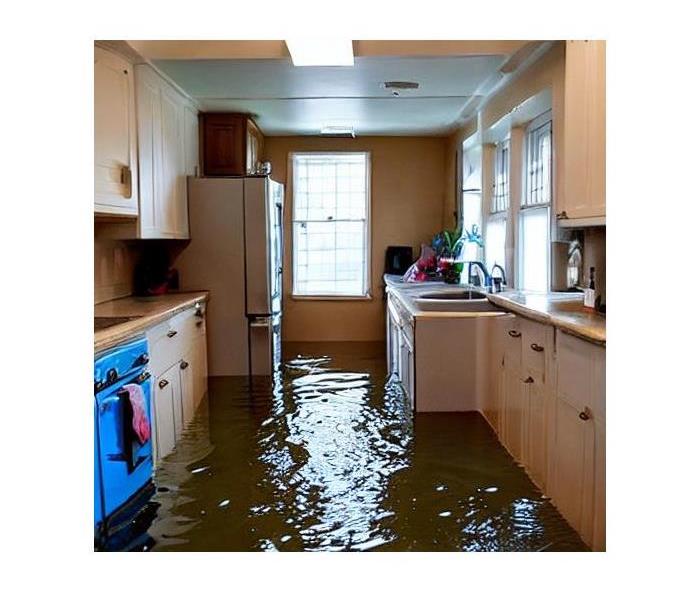 This is a photo of a water damage where major and small appliances were affected and required evaluation and inspection.
This is a photo of a water damage where major and small appliances were affected and required evaluation and inspection.
Do my appliances need to be replaced after a flood?
If you have had water damage in your home or business, you may ask yourself what do I do with my appliances? Are my appliances still usable? How do I make sure they are safe to use?
Here are some useful tips to help you determine whether your appliances are salvageable, how to dry them, and how to test them for use.
Your major appliances can be a concern after major water damage. Flooding can affect the electrical and gas lines, which can be extremely hazardous if they are not handled or inspected properly. In the wake of a flood, it is important to cut the gas and power lines before inspecting the stability of your major appliances. You should not light a match, turn on lights or use any electric devices near the water-damaged area.
Signs of a leak in your gas line may include but are not limited to the smell of a rotten egg, open flames, or damaged electrical appliances that may interfere with or ignite the gas.
Here are some steps you can take concerning your appliances in the aftermath of a flood.
- Shut off the main breaker.
- Use caution when handling appliances attached to the water lines that may contain mold and or sewage.
- Determine how long the appliances were submerged in water and which parts were directly affected.
- A professional should inspect water-logged appliances.
- Never disconnect or reconnect appliances while in standing water.
- Never turn on your HVAC system, this can spread mold throughout your home or business.
- Have your HVAC system inspected to ensure the air quality and safety of your patrons or family.
Appliances should be inspected and deemed safe prior to use.
- Inspect each appliance one by one.
- Replace the pilot for gas stoves.
- Replace refrigerator controls and thermostats if necessary.
- Replace timer controls on the dishwasher and other appliances.
- Thoroughly clean and inspect small appliances such as microwaves and toasters.
- SERVPRO of Media can help by providing our specialty cleaning services.
- Inspect and replace affected lighting.
How to determine whether to repair or replace effected appliances
The main factor to consider would be the cost of repair vs replacement. Typically it is more cost-effective to replace rather than repair a major appliance but it is not always the case
-Factors to consider may include but are not limited to
-Warranty or Insurance coverage for appliance
-Purchase date and age of the appliance
-The amount of time the appliance was submerged in the water
-rusting or corrosion damages
Safety of use of an appliance, after water damage takes place, is of the utmost concern regarding considering whether you should repair or replace an appliance. The last thing you need after one major elemental tragedy is a fire or explosion! When you are not sure what to do or how to go about making the assessment of whether you should replace or repair your major and small appliances proceeding a flood it is best to call a professional.
How do we help clean up after water damage at SERVPRO of Media
Our highly trained team of professionals is equipped with state-of-the-art equipment and is available 24/7/365 to help with all your water damage needs. Our technicians will have your business or property returned to its pre-damage condition. We are eager to make it “Faster to any disaster” and make it look “LIKE IT NEVER EVEN HAPPENED.”
How to prevent mold in your basement
6/19/2023 (Permalink)
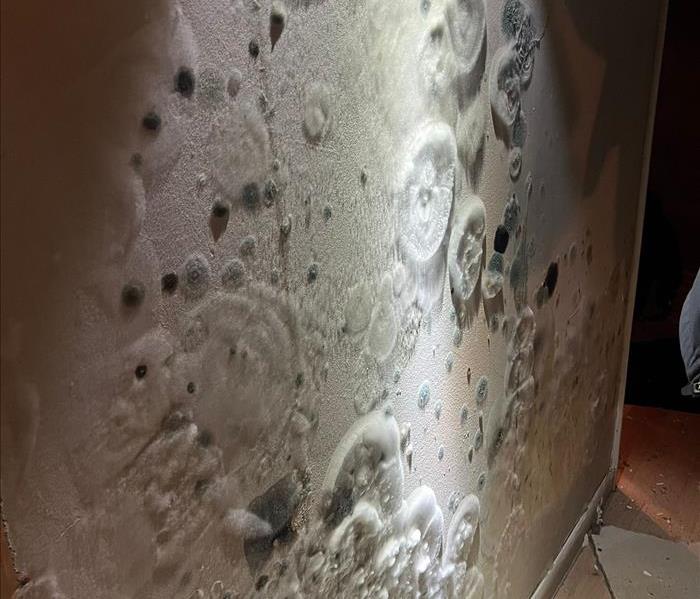 This is a picture of a mold infestation in the basement of a customer in Newtown Square that SERVPRO of Media remediated and repaired
This is a picture of a mold infestation in the basement of a customer in Newtown Square that SERVPRO of Media remediated and repaired
How to Prevent Growth of Mold in your Basement
Our basements are often a catch-all or unthought-of area in our homes, however, they are the most likely to develop a mold issue and in fact, require home or business owners to take proper precautions to prevent the growth of mold which can cause health as well as structural or cosmetic damages to our loved ones or property.
Here are some steps you can take to prevent the growth of mold in the basement of your home or business:
First and foremost know the humidity level in your basement should be between 30 and 50 percent. Basements typically tend to hold humidity so you can install a humidifier to reduce the levels. Be sure to check the tank and filters frequently to ensure the efficiency of your dehumidifier.
Another effective way to prevent basement mold growth is to ensure proper ventilation. Basements are often poorly ventilated, which can lead to a buildup of moisture. You can install a ventilation system to improve air circulation in your basement. This will help to reduce the humidity levels and prevent mold growth.
It is also important to check your basement for cracks and leaks which would effect the dampness in your basement. If the outside is getting in, prioritize fixing this issue by sealing your basement properly from the outside elements.
Keeping your basement clean and clutter free is another way to prevent mold from infesting your basement unknowingly. Mold growth can truly thrive in a dusty inconspicuous environment. Out of sight out of mind is not ideal when it comes to mold infestations. It is imperative that you keep your basement clean and clear of clutter to be vigilant in mold prevention.
If you are planning to finish your basement rather than utilize it for storage purposes it is recommended that you use mold-resistant building materials for your drywall paint and sealing and insulation processes.
It is important to stay on top of the awareness that mold growth is likely to occur in your basement because it is dark and damp, even when all proper precautions have been taken mold can transpire. We highly recommend that even after all precautions have been taken that you take the time to regularly inspect your basement to make sure that no mold is growing! This ensures that should mold arise it can be remediated before it becomes a threat and spreads in your home or business!
If you find or suspect mold in your home or business our team of highly trained professional technicians are equipped with the knowledge and power to contain and remediate a mold infestation and restore your property to its pre-damaged condition.
What’s Causing Your Mold Growth
There are many different factors that could be leading to mold growth at your home. These are the most common causes we run into:
- Leaks from Appliances
- A sink or toilet or tub that overflowed
- Damp or wet basements
- HVAC Issues
- Foundation leaks or cracks
- Leaking or cracked water pipes or fixtures
- Issues with plumbing
- Leak in roof or siding
- Lack of Ventilation causing humidity or condensation
- Clog or drain issues.
- Flood or water damage
How much will it cost to remove the mold and restore my business or property?
The reality is there is no way to give you an answer to that question without having our team of certified technicians come and inspect the mold damages. This is the only way to accurately quote you any type of pricing for mold removal and remediation. The cost is determined by many factors. It is likely that some or all the costs may be covered by your insurance. SERVPRO® of Media works with your insurance.
Factors that are taken into consideration to make this assessment include but are not limited to the following:
- Dimensions of the affected area
- Time spent on labor and supplies to restore our business or property.
- The amount of water extracted as well as time and accessibility to extract water from the affected area.
- Labor to repair the source of moisture.
Can MOLD Destroy Your Home?
The negative effects on your home can be catastrophic if left untreated. Mold can destroy or damage the following:
- Appliance Damages
- Damage to personal property
- Health concerns
- Cosmetic and structural damages
How to prevent mold in your basement
6/19/2023 (Permalink)
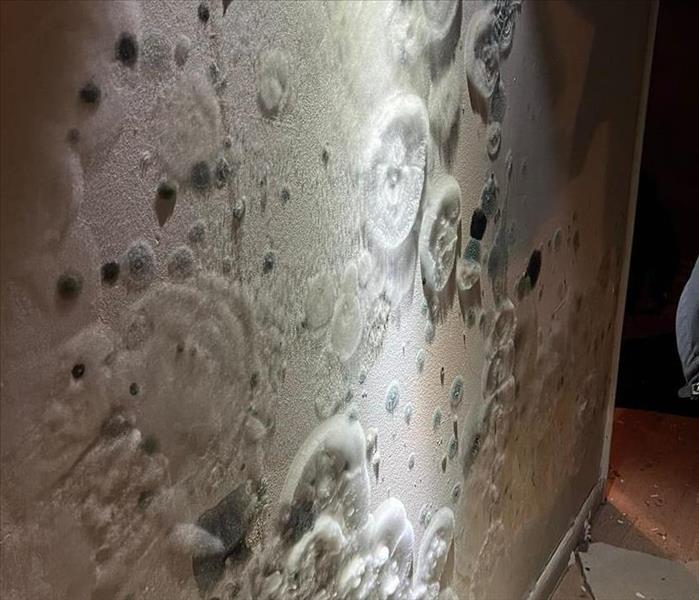 This is a picture of a mold infestation in the basement of a customer in Newtown Square that we remediated and repaired
This is a picture of a mold infestation in the basement of a customer in Newtown Square that we remediated and repaired
How to Prevent Growth of Mold in your Basement
Our basements are often a catch-all or unthought-of area in our homes, however, they are the most likely to develop a mold issue and in fact, require home or business owners to take proper precautions to prevent the growth of mold which can cause health as well as structural or cosmetic damages to our loved ones or property.
Here are some steps you can take to prevent the growth of mold in the basement of your home or business:
First and foremost know the humidity level in your basement should be between 30 and 50 percent. Basements typically tend to hold humidity so you can install a humidifier to reduce the levels. Be sure to check the tank and filters frequently to ensure the efficiency of your dehumidifier.
Another effective way to prevent basement mold growth is to ensure proper ventilation. Basements are often poorly ventilated, which can lead to a buildup of moisture. You can install a ventilation system to improve air circulation in your basement. This will help to reduce the humidity levels and prevent mold growth.
It is also important to check your basement for cracks and leaks which would effect the dampness in your basement. If the outside is getting prioritize fixing this issue by sealing your basement properly from the outside elements.
Keeping your basement clean and clutter free is another way to prevent mold from infesting your basement unknowingly. Mold growth can truly thrive in a dusty inconspicuous environment. Out of sight out of mind is not ideal when it comes to mold infestations. It is imperative that you keep your basement clean and clear of clutter to be vigilant in mold prevention.
If you are planning to finish your basement rather than utilize it for storage purposes it is recommended that you use mold-resistant building materials for your drywall paint and sealing and insulation processes.
It is important to stay on top of the awareness that mold growth is likely to occur in your basement because it is dark and damp, even when all proper precautions have been taken mold can transpire. We highly recommend that even after all precautions have been taken that you take the time to regularly inspect your basement to make sure that no mold is growing! This ensures that should mold arise it can be remediated before it becomes a threat and spreads in your home or business!
If you find or suspect mold in your home or business our team of highly trained professional technicians are equipped with the knowledge and power to contain and remediate a mold infestation and restore your property to its pre-damaged condition.
What’s Causing Your Mold Growth
There are many different factors that could be leading to mold growth at your home. These are the most common causes we run into:
- Leaks from Appliances
- A sink or toilet or tub that overflowed
- Damp or wet basements
- HVAC Issues
- Foundation leaks or cracks
- Leaking or cracked water pipes or fixtures
- Issues with plumbing
- Leak in roof or siding
- Lack of Ventilation causing humidity or condensation
- Clog or drain issues.
- Flood or water damage
How much will it cost to remove the mold and restore my business or property?
The reality is there is no way to give you an answer to that question without having our team of certified technicians come and inspect the mold damages, this is the only way to accurately quote you any type of pricing for mold removal and remediation. The cost is determined by many factors. It is likely that some or all the costs may be covered by your insurance. SERVPRO works with your insurance.
Factors that are taken into consideration to make this assessment include but are not limited to the following:
- Dimensions of the affected area
- Time spent on labor and supplies to restore our business or property.
- The amount of water extracted as well as time and accessibility to extract water from the affected area.
- Labor to repair the source of moisture.
Can MOLD Destroy Your Home?
The negative effects on your home can be catastrophic if left untreated.
- Appliance Damages
- Damage to personal property
- Health concerns
- Cosmetic and structural damages to business or residence
Beyond water removal: How SERVPRO of Media restores indoor air quality after a flood
6/15/2023 (Permalink)
When it comes to water damage restoration, there is more to consider than simply removing the water. A flood can leave a lasting impact on the indoor air quality of a property, posing risks to the health and well-being of its occupants. Recognizing the significance of this issue, SERVPRO® of Media goes above and beyond mere water removal, taking comprehensive measures to restore and improve indoor air quality for your home in the aftermath of a flood.
Excess moisture from a flood creates an environment that fosters the growth of mold, bacteria, and other contaminants. These hidden threats can silently deteriorate indoor air quality, leading to respiratory problems and other health concerns. SERVPRO of Media understands the connection between water damage and indoor air quality, and we approach flood recovery with a holistic perspective. With a commitment to creating a healthy living environment, SERVPRO of Media's approach encompasses not only the removal of water but also the remediation of mold, the cleaning of air ducts, the elimination of odors, and ongoing maintenance to sustain optimal indoor air quality.
The impact of water damage on indoor air quality
Water damage can have a significant and far-reaching impact on indoor air quality, posing risks beyond visible damage. When a property experiences a flood or water intrusion, the excess moisture creates an ideal breeding ground for mold, bacteria, and other microorganisms. As these contaminants multiply and thrive in damp environments, they release airborne particles and potentially harmful spores into the air.
These airborne particles can have detrimental effects on occupants' respiratory health, leading to allergies, asthma, and other respiratory issues. The presence of mold spores in the air can trigger allergic reactions in susceptible individuals and worsen existing respiratory conditions. Additionally, bacteria and other pathogens carried by floodwater can contaminate the air, increasing the risk of infections and other health concerns. Furthermore, the high humidity levels resulting from water damage can cause the deterioration of building materials, such as drywall and carpets, leading to the release of airborne particulates. These particulates can include dust, dirt, and even potentially hazardous substances, depending on the nature of the floodwater.
The combination of moisture, mold, bacteria, and particulates can create an unpleasant and unhealthy indoor environment. The musty odor associated with mold growth is not only unpleasant but can also indicate the presence of hidden mold colonies. In addition, prolonged exposure to high levels of moisture and contaminants can compromise the property's structural integrity, leading to further deterioration and potential safety hazards.
SERVPRO of Media recognizes the importance of mitigating these risks and employs comprehensive strategies to restore and improve indoor air quality in the aftermath of a flood. Through thorough drying, mold remediation, air duct cleaning, and odor elimination, we aim to create a clean and healthy living environment free from the harmful effects of water damage.
How to prevent poor indoor air quality on your own post water damage
At SERVPRO of Media, we understand the importance of maintaining good indoor air quality, especially in the aftermath of water damage. We are committed to providing comprehensive solutions to restore and enhance the air quality in your property. While waiting for our professional assistance, there are steps you can take on your own to prevent poor indoor air quality. Following these recommendations can help create a safer and healthier environment for yourself and your loved ones.
Water damage can have far-reaching effects, not only on the structural integrity of your property but also on the air you breathe. Excess moisture can lead to the growth of mold and mildew, which release airborne particles and allergens that can compromise indoor air quality. Promptly addressing these issues mitigates potential health risks and ensures a comfortable living or working space.
From removing standing water and increasing ventilation to cleaning and disinfecting affected areas, we will guide you through the necessary steps to prevent mold growth, remove contaminants, and improve indoor air quality. Remember, the health and well-being of your family, employees, or tenants are our top priorities. Let's delve into the actionable strategies that will empower you to take charge of indoor air quality during the interim period after water damage.
Remove standing water
One of the critical steps in preventing poor indoor air quality after water damage is the prompt removal of standing water. When water enters your property, it can quickly saturate various materials, leading to increased moisture levels and creating an ideal environment for mold growth. Immediately removing standing water is essential to minimize the potential health risks associated with mold and other contaminants.
To effectively remove standing water, you can utilize buckets, mops, or wet/dry vacuums. Begin by extracting as much water as you can manually. For more extensive or severe water damage incidents, it may be necessary to seek professional assistance from SERVPRO of Media, as we have specialized equipment to handle significant water extraction tasks.
By removing standing water, you not only prevent further damage to your property but also inhibit the growth and spread of mold spores. Mold can release harmful airborne particles that trigger allergies and respiratory issues, leading to poor indoor air quality. Acting quickly to remove standing water helps mitigate these risks and creates a healthier environment for occupants.
If the standing water is contaminated, such as in the case of sewage backups or flooding from external sources, it's crucial to take appropriate precautions. Use protective gear, such as gloves and boots, and consider wearing a mask to minimize exposure to potentially harmful substances.
Increase ventilation
Another essential step in preventing poor indoor air quality after water damage is to increase ventilation within your property. Proper ventilation helps promote airflow, aids in drying out damp areas and reduces the chances of mold and mildew growth, ultimately improving the overall air quality. To enhance ventilation, begin by opening windows and doors if it is safe to do so. This circulates fresh air and helps remove excess moisture from the affected areas. If weather permits, keeping windows and doors open for extended periods can aid in drying.
In addition to natural ventilation, you can utilize fans and dehumidifiers strategically. Fans help to increase air movement, facilitating faster evaporation and drying. Place fans in areas where water damage has occurred, directing them towards damp surfaces. This assists in drying out materials, preventing moisture buildup, and reducing the risk of mold growth.
Dehumidifiers are another valuable tool in improving ventilation and controlling moisture levels. These devices extract excess moisture from the air, helping to maintain optimal humidity levels and inhibit mold growth. Consider placing dehumidifiers in areas prone to high humidity or where water damage has occurred, such as basements, bathrooms, or laundry rooms.
When increasing ventilation, monitoring and managing the relative humidity levels on your property is crucial. Aim to maintain a humidity range of 30-50% to prevent excessive moisture, which can contribute to mold growth and compromise indoor air quality. You can utilize a hygrometer, a device that measures humidity, to monitor and adjust levels accordingly.
Clean and disinfect
As part of the process to prevent poor indoor air quality after water damage, it is crucial to thoroughly clean and disinfect the affected areas. Cleaning and disinfection play a vital role in removing contaminants, reducing the risk of mold growth, and improving overall air quality within your property.
Start by removing any debris, dirt, or mud that may have been brought in by the water. Use a broom, mop, or wet/dry vacuum to clean up the visible dirt and debris. This initial cleaning step helps prepare the area for further disinfection and prevents the spread of contaminants.
Next, prepare a cleaning solution by mixing water with a mild detergent or a specialized disinfectant recommended for water damage situations. Apply the solution to all hard surfaces that come into contact with the water, including floors, walls, baseboards, and furniture. Use a cloth, sponge, or mop to thoroughly clean and scrub these surfaces, removing all visible dirt, residue, and potential pathogens. Pay special attention to areas prone to mold growth, such as damp or dark corners, and any areas submerged in water for an extended period. These areas may require more thorough cleaning and disinfection to eliminate potential mold spores and bacteria.
After cleaning, proceed with using a suitable disinfectant product. Follow the instructions on the disinfectant label for proper application and contact time to ensure its effectiveness. Disinfect high-touch surfaces such as doorknobs, light switches, countertops, and bathroom fixtures to minimize the spread of germs and maintain a hygienic environment.
It is important to note that porous materials, such as carpets, upholstery, and certain types of furniture, may require specialized cleaning or may need to be discarded if they cannot be adequately cleaned and dried.
Remove wet materials
To prevent poor indoor air quality after water damage, it is essential to promptly remove wet materials from your property. Wet materials, such as carpets, rugs, insulation, drywall, and furniture, can retain moisture and become a breeding ground for mold and bacteria if not addressed quickly. Start by identifying and removing any visibly wet or water-damaged items. Carpets and rugs, in particular, tend to absorb a significant amount of water and can be challenging to dry completely. If possible, lift and roll the wet carpets and rugs, and remove them from the affected areas. This helps prevent further damage to the underlying flooring and facilitates drying.
In addition to carpets and rugs, inspecting and removing any water-damaged furniture or upholstery is crucial. These items can also absorb moisture and become a source of mold growth. Depending on the extent of the damage, some furniture pieces may be salvageable through professional cleaning and restoration, while others may need to be disposed of to prevent further contamination and maintain indoor air quality.
Take note of any wet insulation or drywall that may have been affected by the water damage. Wet insulation loses its effectiveness and can become a breeding ground for mold. Similarly, wet drywall can become weakened and may need to be replaced. Consult with SERVPRO of Media to assess the extent of the damage and determine the appropriate course of action for these materials. Carefully handling wet materials is essential, especially if the water damage involves contaminated water sources such as sewage backups or flooding. Wear appropriate protective gear, such as gloves and masks, to avoid potential health hazards.
Monitor humidity levels
Monitoring humidity levels is crucial in preventing poor indoor air quality after water damage. Excessive moisture in the air can contribute to mold growth, musty odors, and overall discomfort. Regularly monitoring and controlling humidity levels can maintain a healthier indoor environment. Use a hygrometer, a device specifically designed to measure humidity, to monitor the relative humidity in different areas of your property. Ideal humidity levels typically range between 30% and 50%. If the humidity level exceeds this range, it is crucial to take steps to reduce it.
To control and maintain optimal humidity levels, consider using dehumidifiers in areas prone to high humidity or water damage. Dehumidifiers help extract excess moisture from the air, promoting faster drying and inhibiting mold growth. Place them strategically where water damage occurs, or moisture accumulates, such as basements, bathrooms, or laundry rooms.
Regularly check and empty dehumidifier collection trays or buckets to ensure they operate efficiently. Clean or replace air filters in dehumidifiers as the manufacturer recommends to maintain their effectiveness.
In addition to using dehumidifiers, ensure proper ventilation throughout your property. Good airflow helps in reducing humidity levels by allowing moisture to dissipate. Open windows and doors whenever weather permits, and use fans to enhance air circulation. This helps in drying out damp areas and preventing excessive moisture buildup.
By monitoring and controlling humidity levels, you can effectively prevent the growth of mold, mildew, and other contaminants. Maintaining optimal humidity improves indoor air quality and creates a more comfortable and healthier living environment for you and your occupants. Remember, if you are unsure about managing humidity levels or suspect significant water damage, it is advisable to seek professional assistance from SERVPRO of Media. Our team has the expertise and equipment to assess and address water damage-related concerns, including humidity control, ensuring your property's air quality is restored to its best condition.
Inspect for mold
Inspecting for mold is crucial in preventing poor indoor air quality after water damage. Mold can thrive in damp and dark environments, and its presence can lead to various health issues and respiratory problems. Conducting a thorough inspection allows you to identify any potential mold growth and take appropriate actions to address it.
Start by visually inspecting the affected areas for visible signs of mold, such as black or greenish patches on walls, ceilings, or other surfaces. Pay attention to areas directly exposed to water or with prolonged moisture exposure. Mold can also hide behind furniture, inside cabinets, or within wall cavities, so it's essential to thoroughly examine these spaces as well.
Use your sense of smell to detect musty or earthy odors, as they can be indicators of hidden mold growth. Even if mold is not visible, its distinct odor may suggest its presence. Take note of any areas with persistent musty smells and include them in your inspection process.
In some cases, mold growth may not be apparent through visual inspection alone. In such situations, consider utilizing moisture meters or thermal imaging cameras to detect hidden moisture pockets or areas of potential mold growth. These tools can help identify moisture sources behind walls, under flooring, or other concealed areas prone to mold development.
If you identify areas of concern or suspect mold growth, it is important to address the issue promptly. Contact SERVPRO of Media for professional mold remediation services. Our trained technicians can conduct further testing, including air quality testing, to assess the extent of the mold problem and develop an effective remediation plan.
How SERVPRO of Media Ensures good indoor air quality post water damage
Thorough drying: The first step to clean air
At SERVPRO of Media, we understand the critical importance of thorough drying when it comes to restoring indoor air quality after water damage. When a flood or water intrusion occurs, excess moisture can permeate various materials within a property, creating a perfect breeding ground for mold and bacteria. We acknowledge that addressing this issue is crucial to promoting clean and healthy air for our clients.
As a reputable restoration firm, we use cutting-edge drying procedures and high-quality equipment to ensure thorough and quick drying. Our professional specialists are equipped with powerful extraction equipment, dehumidifiers, and strategically placed air movers to hasten the evaporation and removal of moisture. By implementing these measures, we create optimal conditions for drying, mitigating the risk of mold growth and bacterial proliferation.
Thorough drying not only prevents further damage but also reduces overall humidity levels within the property. By effectively decreasing the moisture content in the air, we create an inhospitable environment for mold and bacteria, significantly improving indoor air quality.
By promptly addressing the moisture issue, we also minimize the likelihood of secondary damage, such as structural deterioration and the release of particulates into the air. Our expertise in moisture control enables us to mitigate risks effectively, preventing further deterioration of materials and reducing the release of dust and debris that can contribute to poor air quality.
Thorough drying, thus, serves as the foundation for achieving clean air during the flood restoration process. At SERVPRO of Media, we prioritize this critical step and utilize our expertise to thoroughly dry every affected area. By mitigating the risks associated with excessive moisture, we prevent further damage and create a healthier indoor environment for our clients.
Mold remediation: Combating the silent invader
At SERVPRO of Media, we understand the insidious nature of mold and the significant impact it can have on indoor air quality. Mold is a silent invader that can thrive in damp and humid environments, posing serious risks to both property and human health. We take mold remediation seriously and employ comprehensive strategies to combat this invisible threat.
Our mold remediation begins with thoroughly inspecting and assessing the affected areas. Our trained technicians use advanced techniques and equipment to identify the extent of mold growth and the underlying causes. We understand that mold can hide in hard-to-reach places, and our expertise allows us to uncover and address all areas of concern.
Once the assessment is complete, we develop a customized mold remediation plan tailored to the specific needs of each property. Our experienced team follows industry best practices and utilizes state-of-the-art techniques to safely and effectively remove mold colonies. We implement containment measures to prevent the spread of mold spores during the remediation process and employ specialized equipment to capture and filter out airborne particles.
Our focus extends beyond just removing visible mold. We understand the importance of addressing the root cause of mold growth, which often stems from moisture or water intrusion issues. Our team works diligently to identify and rectify these underlying problems, ensuring a long-term solution to prevent mold recurrence. In addition to the physical removal of mold, we also prioritize proper cleaning and sanitization of the affected areas. We use EPA-approved antimicrobial treatments to eliminate any residual mold spores and inhibit their future growth. Our goal is to restore the air quality and create a safe and healthy living environment for our clients.
Mold remediation requires expertise, attention to detail, and a thorough understanding of the factors that contribute to mold growth. SERVPRO of Media has a dedicated team of professionals trained in the latest mold remediation techniques. Our commitment to combating the silent invader ensures that we deliver effective and comprehensive solutions to restore indoor air quality and provide peace of mind for our clients.
Air duct cleaning: Removing contaminants and allergens
As a leading restoration company, SERVPRO of Media recognizes the significant role that air ducts play in maintaining indoor air quality. Over time, air ducts can accumulate dust, dirt, allergens, and other contaminants, which can be detrimental to the health and well-being of occupants. We prioritize air duct cleaning as an essential step in our flood restoration process to remove these pollutants and ensure clean, fresh air for our clients.
Our highly trained technicians utilize specialized equipment to thoroughly clean and sanitize air ducts. We understand that each air duct system is unique, and our approach is tailored to meet the specific needs of each property. Using industry-leading techniques, we dislodge and remove built-up debris, dust, and allergens from the ductwork. During the air duct cleaning process, we also pay close attention to the components within the system, including registers, grilles, and filters. We clean and sanitize these elements to ensure that no residual contaminants are left behind, promoting optimal indoor air quality throughout the property.
By removing contaminants and allergens from the air ducts, we help prevent them from circulating back into the living spaces. This not only improves the air quality but also reduces the risk of respiratory issues and allergic reactions among occupants. Our thorough and meticulous approach to air duct cleaning ensures that the entire system is free from harmful particles, providing a healthier and more comfortable environment.
In addition to the health benefits, air duct cleaning also enhances the efficiency of HVAC systems. When air ducts are clogged with debris and contaminants, it can restrict airflow and strain the system, leading to decreased efficiency and higher energy consumption. By removing these obstructions, we help optimize the performance of HVAC systems, resulting in improved energy efficiency and potential cost savings for our clients.
At SERVPRO of Media, we prioritize the importance of air duct cleaning as a crucial component of flood restoration. We understand that clean air ducts are essential for maintaining a healthy indoor environment. With our expertise, state-of-the-art equipment, and commitment to excellence, we deliver thorough and effective air duct cleaning services that remove contaminants and allergens, ensuring clean and fresh air for our clients.
Odor elimination: A breath of fresh air
At SERVPRO of Media, we understand the profound impact that lingering odors can have on the comfort and livability of a property. Whether it's the result of water damage, mold growth, or other sources, unpleasant odors can persist long after the initial cause has been addressed. We prioritize odor elimination as an integral part of our flood restoration services, ensuring our clients can enjoy fresh air in their homes or businesses.
Our experienced technicians employ advanced techniques and industry-leading equipment to effectively eliminate odors at their source. We begin by identifying the underlying cause of the odor, whether it's from water damage, mold, smoke, or other contaminants. By addressing the root cause, we ensure a thorough and lasting odor-elimination process.
Once the source has been identified, we utilize a combination of specialized treatments and technologies to neutralize and eliminate the odors. We understand that simply masking the odors is not a viable solution. Instead, we focus on eradicating the odor molecules and restoring a fresh and clean environment.
Our odor elimination process includes the use of powerful deodorization agents that penetrate deep into the affected materials, eliminating odors at their source. We also employ ozone treatments, hydroxyl generators, and thermal fogging to reach even the most inaccessible areas, ensuring that no trace of the odor remains. Our knowledgeable technicians assess the extent of the odor problem and determine the most effective strategies and treatments to restore a pleasant and odor-free environment.
Ongoing maintenance: Sustaining healthy indoor air quality
At SERVPRO of Media, we believe that maintaining healthy indoor air quality is an ongoing commitment. After completing flood restoration services, we emphasize the importance of continued maintenance to sustain our clients' clean and fresh environment. Our comprehensive approach to ongoing maintenance ensures that indoor air quality remains at its best, providing a healthier and more comfortable living or working space.
We understand that even after the initial restoration, properties can still be susceptible to potential issues that can impact air quality. That's why we offer customized maintenance plans tailored to the specific needs of each property. Our trained professionals conduct regular inspections and assessments to identify any emerging concerns and take proactive measures to address them promptly.
One essential aspect of ongoing maintenance is regular air duct cleaning. Over time, dust, debris, and allergens can accumulate in the air ducts, compromising air quality. In addition to air duct cleaning, we also recommend periodic mold inspections. Mold can be a persistent issue, especially in areas that have experienced water damage or high humidity levels in the past. Our mold inspections help detect any signs of mold growth early on, allowing us to take immediate action and prevent potential air quality issues.
Another vital component of ongoing maintenance is the regular cleaning and maintenance of HVAC systems. Dirty filters, malfunctioning components, or inefficiencies in the HVAC system can adversely impact air quality. Our technicians are trained to clean, service, and maintain HVAC systems, ensuring optimal performance and minimizing the risk of airborne pollutants.
Furthermore, we offer professional advice and recommendations to our clients regarding everyday practices that help maintain healthy indoor air quality. This includes proper ventilation, controlling humidity levels, and regular cleaning routines. Our expertise and guidance empower our clients to actively contribute to sustaining a clean and healthy living or working environment.
About SERVPRO of Media
SERVPRO of Media is your reliable partner in restoring good air quality post water damage. With years of experience and a team of skilled professionals, we are committed to providing top-notch services to help you breathe easy again.
We understand the importance of addressing air quality concerns after water damage incidents, as excess moisture can lead to mold growth and other airborne contaminants. Our experts employ advanced techniques and state-of-the-art equipment to thoroughly dry affected areas, remove harmful particles, and restore clean and healthy indoor air. We conduct thorough inspections to identify any hidden mold growth or lingering moisture, and our specialized cleaning and disinfection processes ensure that all surfaces are thoroughly treated.
With our attention to detail and dedication to customer satisfaction, you can trust SERVPRO of Media to restore your property to its pre-damage condition, promote excellent air quality, and provide you with peace of mind. Schedule an appointment with us now to ensure the excellent air quality of your home with our superb water damage restoration services.
SERVPRO of Media offers round-the-clock certified water damage restoration services in Newtown Square, PA
5/9/2023 (Permalink)
Blog Summary: SERVPRO of Media offers tips for preventing water damage and the benefits of working with certified professionals. They proudly provide accredited water damage restoration services to help property owners in Newtown Square recover from water damage.
The spring season brings with it a unique set of challenges for water damage restoration in Newtown Square, PA. With heavy rain, snowmelt, and flooding all common occurrences during this time of year, homeowners and business owners must be prepared for the potential for water damage. SERVPRO® of Media discusses the causes of water damage during the spring season, the challenges of water damage restoration, and the benefits of working with certified professionals.
Causes of water damage during the spring season
As the snow melts and heavy rains come down, water damage can be a major concern for homeowners and business owners in Newtown Square, PA. Snowmelt can cause flooding in basements and crawl spaces, while heavy rains can lead to water seeping into walls and ceilings and damage to roofs and foundations. In addition, spring storms can bring heavy winds, which can cause damage to windows, doors, and other openings. All these events can lead to costly water damage repairs if not addressed quickly and correctly.
Challenges of water damage restoration during Spring
Restoring a home or business after water damage can be a difficult process, and the spring season brings its own set of challenges. For example, the presence of moisture can make it difficult to access certain areas of the property, while the warm weather can lead to the rapid growth of mold and mildew. In addition, the presence of standing water can create a breeding ground for insects and rodents, which can spread disease and cause further damage. As such, it is essential to work with experienced professionals like SERVPRO of Media who are equipped to handle these difficulties.
Tips for preventing water damage
Home and business owners in Newtown Square can take several proactive steps to reduce the risk of water damage during the spring season. It is important to check for any potential weak spots in the property, such as loose shingles or cracks in the foundation. Inspecting the plumbing and checking for any signs of leaking or damage is also beneficial. Additionally, it is wise to keep gutters and downspouts clear of debris, as this can help to ensure that water flows away from the property.
Benefits of professional water damage restoration services
When it comes to water damage restoration, it is essential to seek assistance from certified professionals like SERVPRO of Media. Their experienced professionals can identify the source of the damage and determine the best course of action to restore the property. Working with certified professionals from SERVPRO of Media can also help ensure that the repairs are done correctly, as they have the knowledge and expertise to address any potential issues. Additionally, experienced restorers can help to prevent further damage by addressing the problem quickly and efficiently.
Choose SERVPRO of Media’s water damage restoration services in Newtown Square, PA
Water damage restoration during the spring season in Newtown Square, PA, can present many challenges. From heavy rain and snowmelt to flooding and the potential for mold and mildew growth, the spring season can be particularly difficult for homeowners and business owners. The best way to avoid costly repairs is to take proactive steps to protect the property and to seek professional help as soon as possible. SERVPRO of Media is proud to offer certified water damage restoration services and is available 24/7 to help property owners in Newtown Square recover from water damage.
You can contact them by phone at (610) 566-5720 or email them at office@SERVPROmedia.com.
SERVPRO of Media invites community involvement in flood restoration services in Springfield, PA
5/9/2023 (Permalink)
Blog Summary: SERVPRO of Media is committed to helping the Springfield, PA community and is leveraging a number of strategies to do so, including building partnerships with local organizations and initiatives, hosting community events and information sessions, and engaging with community members through social media and public outreach.
Springfield, PA—SERVPRO® of Media, a leading provider of disaster restoration services in the Springfield, PA, area, encourages community members to join in their efforts to restore their areas after floods and other disasters. The company is committed to helping the community rebuild when disaster strikes. They are also dedicated to providing assistance to those in need.
Floods can devastate a community, leaving behind extensive damage to homes and businesses. For communities affected by such disasters, restoring their homes and properties can be daunting. For this reason, community involvement is essential in the flood restoration process. Community-led efforts can help to provide the resources, expertise, and awareness needed to effectively and efficiently rebuild.
The benefits of community involvement in flood restoration services
Community involvement in flood restoration services provides many benefits to the Springfield, PA, area:
- It increases access to resources and expertise. By engaging with local organizations and initiatives, community members can identify and access the resources necessary to restore the area.
- Community involvement can heighten awareness and understanding of the flooding issue, bringing attention to the issue and inspiring action.
- Increased support and collaboration among community members can support the restoration process and ensure long-term success.
Strategies for encouraging community involvement
To effectively encourage community involvement in flood restoration services, SERVPRO of Media utilizes these strategies:
- The company believes in building partnerships with local organizations and initiatives to ensure access to resources and expertise.
- SERVPRO of Media hosts community events and information sessions to bring awareness to the flood damage issue and provide an opportunity for community members to get involved.
- The company engages with community members through social media and public outreach to increase support and collaboration.
Community involvement in flood restoration services in Springfield, PA
Through the years, the efforts of SERVPRO of Media and its community have been championing restoration efforts in the area after devastating floods and other natural disasters. Partnering with local organizations, they can access the resources needed to complete the restoration process. Additionally, the events and information sessions they host resulted in increased awareness of climate change and the problems it brings and motivated community members to take action. Finally, engaging with community members through social media and public outreach resulted in increased support and collaboration, which was essential to the success of the restoration process.
SERVPRO of Media - leading flood restoration services provider in Springfield, PA
SERVPRO of Media is a leading provider of flood restoration services in Springfield, PA, and its neighboring areas. They are dedicated to providing assistance to those affected by the devastating floods. Their services include water extraction, structural drying, and mold remediation, as well as content cleaning and restoration.
SERVPRO of Media’s community focussed flood damage restoration process includes:
- Water extraction: The process of removing standing water from a home or business, either through pumping or manual extraction.
- Structural drying: The process of removing moisture from walls, floors, and other surfaces to prevent mold growth.
- Mold remediation: The process of removing mold from a home or business, including cleaning, disinfecting, and removing any affected materials.
- Content cleaning and restoration: The process of cleaning and restoring furniture, electronics, and other items damaged by the flood.
- Building partnerships with local organizations and initiatives: Working with local organizations and initiatives to access resources and expertise for flood restoration efforts.
- Hosting community events and information sessions: Organizing events and information sessions to bring awareness to the flooding issue and provide an opportunity for community members to get involved.
- Engaging with community members through social media and public outreach: Utilizing social media and public outreach to increase support and collaboration among community members.
SERVPRO of Media is committed to helping their community rebuild after disasters occur. Call them at (610) 566-5720 or email them at office@SERVPROmedia.com.
SERVPRO of Media provides fire damage restoration services for local businesses in Broomall, PA
5/9/2023 (Permalink)
Blog Summary: SERVPRO of Media explains that the extent of the loss of revenue for a business following fire damage will depend on how long it takes for them to recover. Fire damage in Broomall, PA, can significantly impact the local economy. Hence, business owners should focus on how to minimize losses by creating effective disaster preparedness plans. These plans can aid in minimizing the financial implications of fire damage.
Cost of fire damage
The costs associated with fire damage can vary greatly. Businesses may need to replace or repair damaged inventory, equipment, and buildings. They may also need to hire specialized contractors to help with the cleanup and restoration process. Insurance coverage is essential for business owners to ensure they can cover the costs of the damage. According to SERVPRO of Media, the estimated cost of fire damage can range in tens of thousands of dollars, depending on the severity of the damage.
Loss of revenue
The extent of the loss of revenue for a business will depend on the amount of time it takes to recover. If a business is unable to open and operate right away, it can expect to lose customers, which can have a long-term effect on its bottom line. Business owners should focus on ways to minimize losses, such as offering online services or temporary discounts.
Economic impact on Broomall
A fire damage disaster in Broomall, PA, can significantly impact the local economy. Business closures will reduce the number of jobs and the amount of money flowing through the community. The government and local community may provide assistance to business owners in the form of grants or loans to help with the recovery and rebuilding process. The long-term financial effects of the fire may include higher insurance premiums and taxes.
Preparing for the worst
Having an effective disaster preparedness plan in place can help business owners minimize the financial implications of fire damage. SERVPRO of Media recommends creating emergency plans that include identifying potential risks, securing important documents, and establishing emergency contacts. Business owners should also take steps to minimize future risks, such as investing in fire safety systems and regularly inspecting their property.
Fire damage restoration by SERVPRO of Media for Broomall, PA, businesses
The financial implications of a fire damage disaster in Broomall, PA, can be devastating for local business owners. It is crucial for business owners to understand the potential costs associated with the damage and to plan ahead to mitigate losses. With the proper preparation and assistance, business owners can recover and rebuild their businesses.
SERVPRO of Media offers comprehensive fire damage restoration services to help business owners in Broomall, PA, recover and rebuild after a fire. Their experienced team can provide the following:
- Fire damage assessment
- Emergency board-up and tarping
- Cleaning and deodorizing
- Restoration and rebuilding
- Storage solutions
- Document restoration
- Disaster recovery planning
SERVPRO of Media is dedicated to providing quality service and restoring peace of mind for business owners affected by fire incidents.
For more information about the financial implications of fire damage and SERVPRO of Media’s fire damage restoration services, contact SERVPRO of Media at office@SERVPROmedia.com or (610) 566-5720.
SERVPRO of Media Warns Newtown Square, PA residents of common causes of water damage and how to mitigate them
4/18/2023 (Permalink)
Blog Summary: Common causes of water damage include leaky pipes, incorrect plumbing, appliances, and natural disasters. To mitigate water damage, it is recommended to regularly check for leaks, install a water alarm, regularly maintain appliances, and install a sump pump.
Newtown Square, PA – SERVPRO® of Media, a leading water damage restoration company, is warning residents of Newtown Square, PA, of the common causes of water damage and how to prevent them. The company specializes in helping homeowners and business owners who need help with water damage repair and restoration.
“Water damage is one of the most common problems homeowners and business owners face,” said owner Michael May, Jr. “It’s important to be aware of the different causes of water damage and how to prevent them.”
Common causes of water damage
Water damage can be caused by many different things. Here are some of the most common causes of water damage in Newtown Square, PA:
- Leaky Pipes: Pipes can become worn down over time and can develop leaks. If these leaks are not caught in a timely manner, they can lead to water damage in walls, floors, and other areas of the home or business.
- Incorrect Plumbing: Improperly installed plumbing can lead to water damage. This can include incorrect venting, inadequate insulation, and improper installation of pipes.
- Appliances: Appliances can malfunction over time and cause water damage. This includes refrigerators, dishwashers, washing machines, and water heaters.
- Natural Disasters: Severe weather can cause water damage due to flooding. If a heavy rainstorm occurs, it can lead to flooding and water damage in the home or business.
How to mitigate water damage
Fortunately, there are some steps that can be taken to help mitigate water damage. Here are some tips to help tackle water damage in Newtown Square, PA:
- Check for Leaks: Regularly check for leaks in pipes, appliances, and other areas of the home or business. If a leak is found, it should be repaired immediately to avoid further damage.
- Install a Water Alarm: Installing a water alarm can help alert you to water damage before it becomes a larger problem. These alarms detect when water is present and can alert you to the problem.
- Regular Maintenance: Regularly maintain appliances and other areas of the home or business to help prevent water damage. This includes replacing appliances' hoses and seals, checking for pipes' cracks, and regularly checking for leaks.
- Install a Sump Pump: Installing a sump pump can help protect your home or business from flooding due to heavy rains.
Why Choose SERVPRO of Media
If you experience water damage in Newtown Square, PA, contact SERVPRO of Media for expert water damage restoration services. The company offers 24/7 emergency services so that you can get help when you need it most. They specialize in water damage repair and restoration and are equipped to handle any size job.
SERVPRO of Media is committed to helping Newtown Square, PA residents tackle and repair water damage. The company offers a wide range of water damage services, including water damage restoration, water removal, and drying services.
SERVPRO of Media is dedicated to helping property owners in Newtown Square, PA, protect their homes and businesses from water damage. The company is committed to providing the best quality service and customer satisfaction.
Whether you own a residential or commercial property like Regal Edgmont Square, and you need help with water damage restoration, reach out to the trusted professionals at SERVPRO of Media. Their professionals study IICRC standards and best practices in water restoration, fire restoration, mold remediation, carpet and upholstery cleaning, and other cleaning and restoration courses.
For more information about water damage restoration services in Newtown Square, PA, call SERVPRO of Media today at (610) 566-5720 or visit their website. They can be reached via email at office@SERVPROmedia.com.
SERVPRO of Media offers expert advice on water removal and homeowner's insurance in Newtown Square, PA
4/18/2023 (Permalink)
Blog Summary: SERVPRO of Media also provides a number of other services, including mold remediation, air quality testing, and HVAC cleaning. They are dedicated to quickly responding to water damage emergencies 24/7.
Residents of Newtown Square, Pennsylvania, are aware of how crucial it is to safeguard their houses from water damage. However, a lot of people might not be aware of the risks associated with water removal and their homeowner's insurance policy. In order to assist homeowners, SERVPRO® of Media is available to provide guidance on the fundamentals.
The team of experts at SERVPRO of Media, a seasoned supplier of water removal and restoration services in Newtown Square, Pennsylvania, is licensed, experienced, and accessible around the clock to assist with any water damage emergency. The finest level of customer service and work efficiency is what SERVPRO of Media is dedicated to delivering.
Water damage: What homeowners need to know
Water damage can be a stressful and costly experience for homeowners. It is important for homeowners to be aware of how their insurance policy may affect their water removal and restoration process.
“The first thing a homeowner should do is contact their insurance company and discuss the details of their policy," said Michael May, Jr., owner of SERVPRO of Media. "It's important to be aware of what is covered and what is not covered under your policy, and to understand the process of making a claim.”
Homeowners should also be aware that there are certain types of water damage that are not covered by homeowners’ insurance. These include damage caused by flooding, storm surge, broken water pipes, and sewer backups. It is important to be aware of the source of the water damage and to document the damage, as this will help in the claims process.
Tips for Homeowners Facing Water Damage
Those who own property and have been exposed to water damage due to flooding, heavy rains, or other sources should adhere to these procedures.
Be aware of the water source: Homeowners' insurance typically does not provide coverage for damages caused by external water sources, such as flooding or storm surges.
Document the damage: Capture images and accumulate proof of the injury.
Contact a water removal specialist: It's important to reach out to an expert in water damage management as soon as possible to halt any additional harm done to your home.
Make a claim: It is advisable for homeowners to submit a claim to their insurance provider promptly if the damage falls within the scope of their homeowners' insurance policy.
SERVPRO of Media: Professional Water Removal Services
SERVPRO of Media is available on a 24/7 basis to offer proficient water extraction and repair services. Their team of professionals is appropriately certified and has the knowledge to deal with all kinds of water damage, such as flooding, storm surges, and other causes.
SERVPRO of Media is equipped with top-notch water removal and drying technology to swiftly and effectively eliminate water and moisture from the building. Furthermore, other services are available, such as mold remediation, air quality testing, and HVAC cleaning.
Michael May, Jr., the owner of SERVPRO of Media, acknowledged the stress and concern associated with water damage. "We are ready to assist you by providing efficient water removal and restoration services," says Michael. "We are devoted to providing exceptional customer service and expertise, and we offer free estimates for water removal and restoration services," he further concludes.
SERVPRO of Media is prepared to help with any water damage emergency situations all day, every day. They recognize the impact of water damage can be expensive and an emotional concern, so they are devoted to helping homeowners through the process.
For more information about water removal services available to the Penn Wynne Wynnewood, PA, residents, contact SERVPRO of Media at (610) 566-5720 or visit their website at https://www.SERVPROmedia.com/.
Mitigating secondary damage during flood restoration in Newtown Square, PA
4/18/2023 (Permalink)
Blog Summary: The team of certified technicians at SERVPRO of Media is equipped with the knowledge and skills to restore properties to preloss condition, as well as the specialized equipment and experience needed to prevent secondary damage. They are committed to providing the highest level of customer service and satisfaction and are experienced in assisting with filing insurance claims.
Newtown Square, PA – SERVPRO® of Media provides top-notch flood restoration services in Newtown Square, Pennsylvania, and the surrounding areas. With a focus on preventing secondary damage during the restoration process, they are ready to respond to flooding and water damage emergencies 24 hours a day, 7 days a week.
SERVPRO of Media is a locally owned and operated business that provides 24-hour emergency service in Chester, Delaware, Montgomery, and Philadelphia Counties. They are a trusted leader in the restoration industry, providing quality services to residential and commercial properties. With the use of the latest technology and specialized equipment, their team of certified technicians is trained to quickly and efficiently evaluate and respond to flooding and water damage emergencies.
SERVPRO of Media has the expertise and experience to handle any water damage emergency. From initial and ongoing training at SERVPRO’s corporate training facility to regular IICRC-industry certification, their staff is equipped with the knowledge and skills to restore your property. They are dedicated to providing the highest quality workmanship and customer service and understand the importance of minimizing any further damage the flood water could cause.
"We understand the stress and worry that comes with a flood emergency, and we're here to help," said owner Michael May, Jr. "We work quickly and efficiently to make sure the damage is controlled, always keeping the safety of our customers and employees in mind."
SERVPRO of Media has the specialized equipment and experience needed to prevent secondary damage from occurring. This includes using dehumidifiers, air movers, and specialty drying equipment to accurately assess the damage and dry the affected areas to prevent further damage. The team will also inspect for hidden moisture and take the necessary steps to ensure all affected areas are thoroughly dried and any potential water damage is mitigated.
Secondary damage from flooding can include the growth of mold and mildew, weakened or compromised structural integrity of the home or building, and the corrosion of electrical wiring, plumbing, and other metal components. If left unchecked, secondary damage can cause health issues and significantly increase the cost of restoration. SERVPRO of Media is committed to preventing secondary damage from occurring by using the latest technology and specialized equipment to assess the damage and thoroughly dry the affected areas accurately.
SERVPRO of Media is also experienced in assisting with the filing of insurance claims. They will work with your insurance company to ensure that the proper documentation is provided to expedite the claims process. They are committed to providing the highest level of customer service and satisfaction.
"Our technicians have the experience and knowledge to quickly evaluate and respond to flooding and water damage emergencies,” said Michael May, Jr. “We are prepared to provide you with the highest level of service while restoring your property to its preloss condition.”
SERVPRO of Media is ready to serve you 24 hours a day, seven days a week. For more information on SERVPRO of Media and their flood restoration services in Newtown Square, PA, please visit https://www.SERVPROmedia.com/ or call (610) 566-5720.
Why Choose Flood Restoration Services from SERVPRO of Media
Flooding due to extreme weather conditions can lead to significant harm to either a residential or commercial property, and this can trigger an immense level of anxiety for the property owner or business proprietor. SERVPRO of Media understands that things can be perplexing and exasperating for the property owner. You can count on their specialists to handle both you and your possessions with a high level of attentiveness and care.
The team at SERVPRO of Media and Central Delaware County is committed to swiftly addressing any flood or storm damage emergencies you may face. With their expertise in storm damage restoration, comprehensive training, extensive experience, and state-of-the-art equipment, they have the capability to restore your home or commercial property in Media to its pre-existing condition.
A potential cause of fire or water damage: Leaving appliances running when no one is home
3/13/2023 (Permalink)
Blog Summary: SERVPRO of Media highlights how the homeowner can avoid fire damage and water damage disasters by turning off appliances before leaving the house or going to bed.
SERVPRO® of Media, which specializes in fire damage and water damage restoration services, urges homeowners to turn off major appliances when leaving home. Otherwise, the consequences could be catastrophic.
Home appliances make life around the house more comfortable, save time, conserve energy, and use much less water than in the past. While older dishwashers use as many as ten to fifteen gallons of water per load, more modern units use between one and four gallons of water. A new washing machine needs only about seven gallons of water, but the older versions need up to 19 gallons of water. Technology has revolutionized the functionality of both the dishwasher and the washing machine. An ENERGY STAR-certified clothes dryer cuts energy consumption by as much as 20%, saving the homeowner more than $200 over the appliance's lifetime. ENERGY STAR certification is not currently available for space heaters, but electric infrared space heaters are nearly 100% efficient in converting electricity to heat.
How frequently are these appliances used in the average home?
- Dishwasher: 5 loads per week
- Washing machine: 6 loads per week
- Clothes dryer: 6 loads per week
The growth of the virtual workforce has contributed to an already expanding demand for space heaters to heat single rooms or enclosed workspaces. Space heaters can be found in almost every home or apartment.
Though these four appliances — the dishwasher, the washing machine, the clothes dryer, and the space heater — are more efficient and safer than ever, leaving them unattended while in operation increases the risk of fire damage, water damage, or both.
How a dishwasher can cause water and fire damage in the home
Since 1994, the water needed for a dishwasher to clean dishes has dropped dramatically. However, a leak in the door or from the pump, which allows water to escape before sensors shut off the flow, could result in a water release. If the appliance has been left unattended, the water release could be as much as seven gallons per minute. That quick trip to the grocery store to pick up a few items for the evening meal could be disastrous.
The dishwasher also poses a fire hazard. A water or moisture leak around the detergent dispenser may allow water to come in contact with wiring that can short-circuit and cause a fire. If the heating coil in the bottom of the dishwasher tub malfunctions or comes in contact with a flammable item, a fire could result. When the fire department extinguishes the flames, the disaster now includes large-scale water damage.
In Massachusetts, a house fire was caused by an unattended dishwasher. According to a statement from the Department of Fire Services, “The family turned on the dishwasher before leaving the house in the morning. The fire was spotted and reported by a local animal control officer who was passing by. The family dog perished in the fire. Investigators were able to determine that the fire started in the kitchen at the dishwasher. Other causes were ruled out. Chief Lavoie said, ‘This fire teaches us two things: that fire will always catch us by surprise and that it is important not to leave major appliances running, like dishwashers, washing machines, dryers or space heaters, when you leave the house.’”
How a washing machine can cause water damage in the home
The supply lines to the washing machine are often hidden from view for aesthetic reasons. A small leak can persist for months without being noticed. Eventually, soft flooring, swollen baseboards, warping sheetrock, or a moldy, musty smell exposes the leak. If left unchecked and unchanged, a supply line may burst, spewing seven to nine gallons of water per minute into the laundry room. If the appliance is “home alone,” the scope of the property damage could involve many rooms and the crawlspace since a leak in the drum or at the pump can release a dozen or more gallons of water onto the floor.
How a clothes dryer can cause fire damage and water damage in the home
The fire risk hazard caused by a clothes dryer is greatest when the lint filter and exhaust duct have not received routine maintenance. Check and clean the lint filter after every load. The clothes dryer is a “hot” appliance with temperatures reaching 125 to 130 degrees Fahrenheit. If the lint filter or vent duct is clogged, temperatures could go even higher. Avoid drying clothing that has been exposed to flammable chemicals. Wash the garments twice if needed to remove grease, oils, and solvents that ignite in the intense dryer heat.
Overloading the dryer with heavy towels, thick bedspreads, or bulky winter coats puts undue stress on the appliance, which may lead to overheating and fire. The heating unit needs a rest and cool-down between loads. Never leave the machine running while everyone is outside, away from home, or sleeping.
When installing a new dryer, purchase a new electrical cord. Do not use the old cord, which could be worn and damaged. Also, install smooth-walled ducts. The accordion duct allows for the buildup of lint in the tubing, which increases the risk of fire. Use clamps or duct tape to connect the pipes.
How a space heater can cause fire damage to the home
An unattended space heater is a culprit in far too many house fires. This appliance accounts for 8 out of 10 fatal house fires caused by a heat source.
- A damaged or faulty cord
- The use of an extension cord with the appliance
- Infrequent maintenance which allows for the buildup of dust, lint, grease, and grime
- Operating the unit too close to flammable materials
- Leaving the unit on and unattended
A common thread in water damage and fire damage caused by appliances is leaving the appliance unattended while in operation. By paying attention to the machine while it is operating or shutting it off when leaving home, many fire damage and water damage disasters can be avoided.
What to do when a fire damage or water damage disaster occurs
Property owners near Regal Edgmont Square can call the property damage cleanup and restoration professionals at SERVPRO of Media, PA, when a fire damage, smoke damage, or water damage disaster happens. A crew of IICRC-certified technicians arrives in about an hour and utilizes the latest equipment, cutting-edge technology, and advanced cleaning techniques. The rapid response and quick cleanup process help return life to normal as soon as possible.
For more information about Newtown Square, PA, water damage restoration, contact SERVPRO of Media at (610) 566-5720 or by email at office@SERVPROmedia.com.
How a frozen pool can potentially lead to a water damage disaster requiring water removal services
3/13/2023 (Permalink)
Blog Summary: SERVPRO of Media highlights how frozen swimming pools can cause water leaks. The water damage caused by these leaks may require water removal services from a professional water damage cleanup and restoration company with the right equipment for the job.
SERVPRO® of Media has the equipment and expert workforce to provide water removal services, dehumidification, cleanup, and restoration in the event that pool pipes freeze and leak, causing flooding in the basement or crawl space.
Pool leaks can be an ongoing issue in many homes, especially in climates where the winter temperatures can drop well below freezing and stay there for a while. Pool leaks may stem from a variety of reasons, including:
- Inferior construction
- Improper installation
- Manufacturer’s defects
- Lack of maintenance
- Wear and tear over time
- Equipment failure
- A power surge or lightning strike
- Extreme cold
A swimming pool industry professional familiar with pool maintenance and pool winterizing in a cold climate provides the following advice: “The number one concern you should have for your pool after experiencing freezing weather conditions is that you might have a broken or cracked pipe somewhere in your pool system...possibly multiple cracks or breaks. When water freezes it expands and the force generated by expanding ice is enough to split pipes, crack concrete, break pumps, filters, or heaters...pretty much any and every part of your pool can be broken by the force of water expanding as it freezes.”
1. Leaks may be difficult to detect
The signs of a leak may come and go as conditions around the pool change. The best way to detect a leak is to carefully monitor changes in water levels after a cold snap. A pool service professional can also do a pressure test on the system for potential leaks.
2. Freezing weather may damage the pool pump
Cold temperatures can cause cracks in the pump and any plumbing connections to the pump. If the pump fails to prime, the cause may be a leak due to freezing. Unexplained water around the pump signals a potential water leak. If the pump is next to the foundation of the home, the leak could damage the foundation and flood the crawl space or basement. Cracks in the pump housing cannot be repaired. The only solution that prevents a water leak and potential water damage is a pump replacement.
3. A frozen pool filter may leak and cause water damage
The filter tank can develop cracks or rupture if the water inside the tank freezes. A large crack or split will allow large amounts of water to escape the tank. More minor hairline fractures may be more difficult to detect. The pressure gauge may also be damaged if the filter tank freezes.
4. Water leaks may occur if the pool heater freezes
In extremely cold conditions, a pool heater can freeze. The result is a damaged heater and potential water leaks. Operating the heater in frigid weather can also damage the unit. Highly acidic condensation is generated, which can corrode components in the unit, leading to premature failure. If the heater freezes, a cascade of negative consequences could develop. The pump could freeze, connections could break, and the pool could freeze over.
Rolling blackouts, water leaks, and water damage
Rolling blackouts during an extreme cold snap can lead to catastrophic pool failure. The entire system could freeze. The pump, filter, skimmer, pipes, and connections may need extensive repairs or complete replacement. A backup power source such as a whole-house generator may be the only tenable solution.
Is water damage from a pool leak covered by a homeowners insurance policy?
Pool leaks are a common cause of water damage. Insurance experts at AgileRates address this question, writing, “Homeowners insurance covers damage to your home. This means that if your leak has caused water damage to other parts of your home, your insurance provider might cover the damages, even if fixing your pool isn’t covered. If you think you have a leak, the sooner you can get it fixed, the less likely it is that there will be additional damage to other parts of your home.”
What to do if a pool leak causes water damage
A pool leak can cause water damage, structural damage, and mold infestation. When the water damage requires water removal services, contact SERVPRO of Media, PA. The team arrives on the scene in about an hour to begin the cleanup and restoration process. The well-trained and IICRC-certified team utilizes powerful pumps, wet-dry vacuums, heavy-duty dehumidifiers, and rapid-spin fans to deal with water and moisture issues. The process includes advanced cleaning and restoration techniques, sanitizing, disinfecting, and deodorizing with EPA-approved products. The rapid response and quick cleanup process get life back to normal as soon as possible.
To learn more about water damage cleanup services in Penn Wynne, Wynnewood, PA, and nearby areas call SERVPRO of Media at (610) 566-5720. The office can also be contacted by email at office@SERVPROmedia.com.
The Do’s and Don’ts of Landscaping over the Septic Tank to Prevent Septic-Related Flood Damage
3/13/2023 (Permalink)
Blog Summary: SERVPRO of Media offers advice on beautifying and benefiting the septic drain field without causing septic-related flood damage.
SERVPRO® of Media provides flood restoration services for clients in Media, PA, and the surrounding area. When the cause of the flooding is a sewage backup, professional cleaning and restoration services are essential for a thorough restoration project that leaves the flooded areas of the home clean, sanitary, and safe.
The leach field for Newtown Square, PA, homes with a septic tank needs to be carefully managed to prevent any interference with the septic system. With the correct landscaping, this section of the yard can present a strong aesthetic appeal while boosting the efficiency and safety of the septic system hidden beneath the soil.
Below are some septic-friendly plants and landscaping principles that help homeowners create a safe, beautiful lawn over the septic leach field.
What to look for in septic-safe plants
Landscaping over the septic system brings benefits and risks. A nominal approach of gravel or plain soil exposes the location to storm runoff and erosion. A cover of wisely chosen vegetation prevents erosion and absorbs excess water, which reduces the risk of flooding. Vegetation cannot correct substantial grading issues. A certified landscape architect can advise on resolving drainage issues and flooding on or near the drain field.
The top priority of any planting plan involving a septic drain field is dealing with roots and root structures. A deep, thick mat of roots in and around the septic tank and drain field can lead to clogged or broken pipes, a ruptured tank, a sewage spill around the tank, or a sewage backup in the home. Toilets, tubs, and showers may ooze raw, smelly, unsanitary sewage. If the pressure within the system is not released, sewage drain pipes in the basement or crawl space can crack or separate, leading to a massive sewage spill.
Drought-tolerant plants do not require irrigation. Too much water on top of the septic system slows the evaporation rate. Evaporation is essential to the function of the system. Alkaline cleaners that get into the system elevate salt levels in the soil around the system, creating unfavorable conditions for plants that are sensitive to high salt levels in the soil. If the pH levels do not benefit the plants, the homeowner wastes time and money.
Soft, woody, shallow-rooted grass and weeds benefit the drain field by stabilizing the moisture content in the soil. When it comes time to dig up the septic tank lid or access pipes buried in the ground, tender plants make digging and excavating easier. Shallow-rooted, herbaceous, flowering annuals and perennials bring depth and color to the drain field. The local lawn and garden store or agricultural extension agent can provide advice on what to plant.
How shrubs and trees can cause a sewage backup
Most trees and shrubs have extensive root systems, and the tough, woody roots and stems are not septic-safe. Trees and shrubs growing near the septic system should be professionally removed to prevent damage. Failure to deal with these plants can damage the system and eventually cause sewage backups. For the sake of the septic system, avoid planting any trees or shrubs in the vicinity of the septic system.
How to safely landscape for a lovely septic leach field
- Avoid installing plants, shrubs, or trees with deep root structures near a septic tank or leach field.
- Protect the septic tank and drain field with root barriers. Thick landscape fabric or wooden planks that impede the growth of roots and shield the septic system will work. The barriers should extend to a depth of at least two feet and should be five feet or more from the leach field.
- Avoid cultivating edible plants, such as vegetables, berry bushes, or culinary herbs, on or near the septic drain field. Contaminants from the system could be trapped in the surrounding soil. These contaminants are taken up by the roots of nearby vegetation, including plants in a vegetable or herb garden. Any cultivated or wild plant growing on or near the septic system should be considered unfit for human consumption. Also, wear protective gloves when handling plants and grass clippings from the drain field. Flowers growing in or near the drain field should not be picked and displayed in the home.
- Check the soil pH to ensure the conditions are suitable for whatever vegetation is planted over the drain field.
- Do not install plants directly over the septic tank. Every several years, the lid may need to be excavated and removed to pump out the tank. The additional weight of raised beds on the septic tank area could possibly damage the tank. The additional bedding soil can adversely impact the evaporation rate of the drain field, and the decrease in efficiency may result in more frequent pumping.
A sewage backup requires immediate professional attention. Cleanup and restoration can be messy. The IICRC-certified professionals at SERVPRO of Media have the training, experience, and equipment for a quick, safe, and sanitary cleanup and restoration. Available 24/7, 365 days a year, including holidays, the flood damage cleanup crew can be on the scene in about an hour.
To learn more about flood damage restoration, contact SERVPRO of Media by phone at (610) 566-5720 or by email at office@SERVPROmedia.com.
Why Choose SERVPRO for your Emergency Board-Up Services?
2/28/2023 (Permalink)
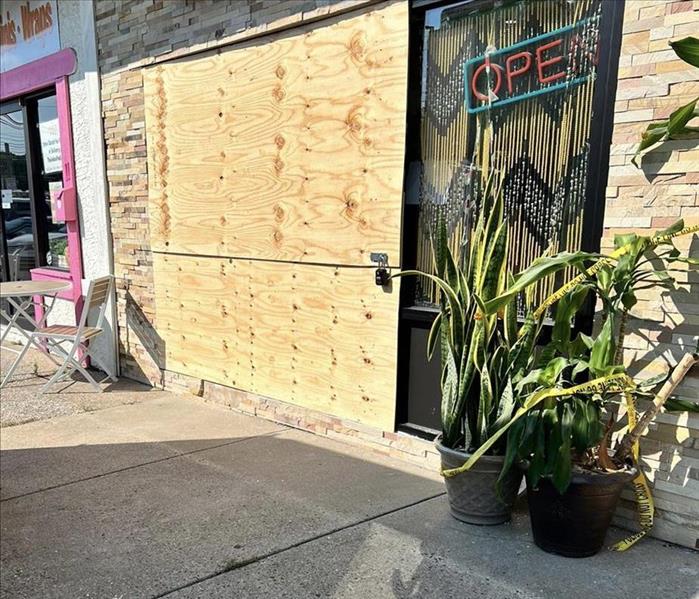 SERVPRO of Media was quick to the call of this local business who required Emergency Board-Up Services after a vehicle drove through front door.
SERVPRO of Media was quick to the call of this local business who required Emergency Board-Up Services after a vehicle drove through front door.
Should disaster strike and your business or home is suddenly left with outdoor exposure and vulnerability SERVPRO of Media is available 24/7, 365 days a year with our on call services to help you protect your home or business!
If your exterior windows doors or walls are damaged, you will need professional board-up services to secure your property. Our highly trained professionals can assist with approved board-up techniques to help minimize further damage and protect your home or business from weather, animals, and illegal entry.
Nature, has a mind of its own and when you are faced with: flood cleanup, wildfires, tornadoes, hurricanes, blizzards or if a tree falls on your home…you need a professional to assess the structure and perform board up services The reality is that they can have a devastating effect on your home, turning your life upside-down with little to no warning.
SERVPRO of Media's highly-trained professionals are close by and customer-focused. Our goal is to restore your home or business to usual as quickly as possible. Whether you have minor storm damage or a matter of larger magnitude, we have the experience and are fully equip to handle all the damages and restore your property.
The Connection Between Commercial Insurance Claims and Property Damage
2/28/2023 (Permalink)
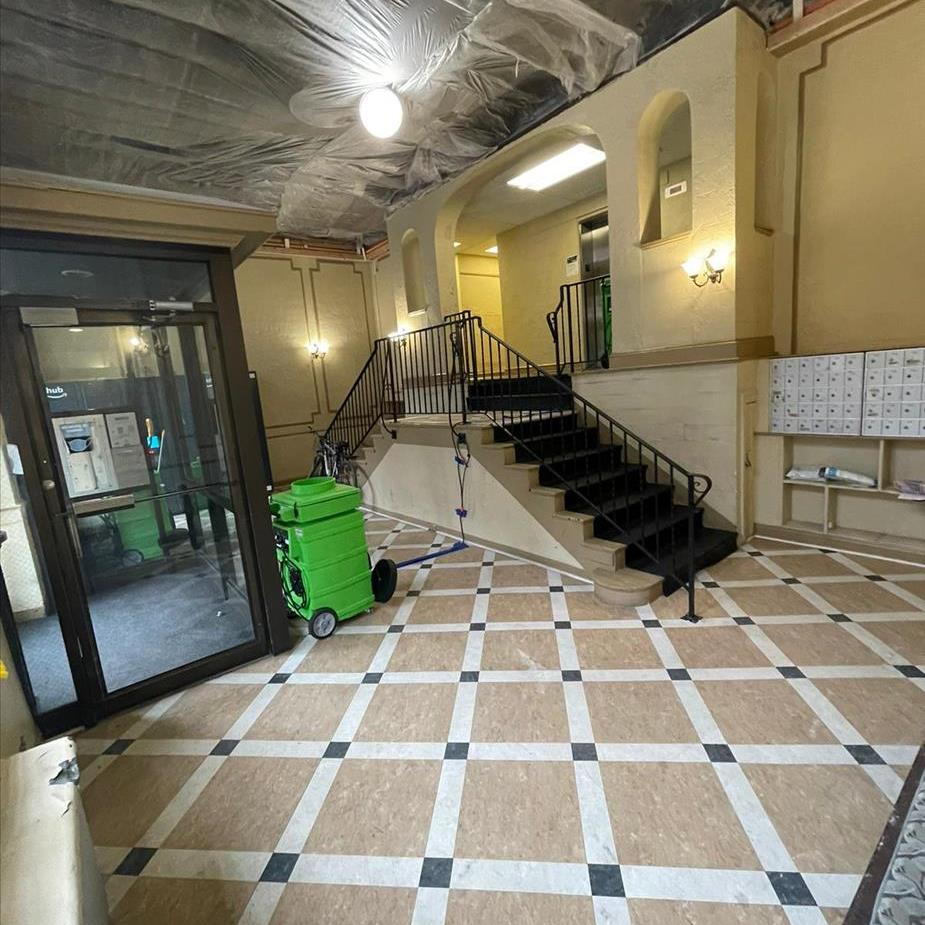 This local commercial business used our services to maintain business as usual during flooding, thanks to SERVPRO of Media's amazing technicians!
This local commercial business used our services to maintain business as usual during flooding, thanks to SERVPRO of Media's amazing technicians!
Blog Summary: SERVPRO of Media highlights a study from The Hartford that outlines the most common and most expensive categories of commercial insurance claims, many of which are caused by property damage disasters.
It is essential to protect your home or business against, fire damage, storm, and water damages in a brick-and-mortar location. Damages to your property can be devastating to your building structure and delay the provision of services, diminishing ROI and have the potential to cause an enterprise to close down. It can be easy to fall into the mind set that it won’t happen to you.
SERVPRO of Media has serviced property damages and the restoration needs of our community for over twenty-five years. Our team understands how devastating is can be when a commercial property damage happens to your business. Whether your business is big or small, we would like to highlight some statistics to relay the reality of the possibility of property damages occurring at your facility. These commercial insurance claim statistics are a clear depiction of just how likely disaster in fact to strike.
The Connection Between Commercial Insurance Claims and Property Damage
In a study by the Hartford, two main factors were analyzed.
Frequency in a particular type of claim or “CLAIM FREQUENCY”
Cost of Claim “CLAIM SEVERITY”
The study identified the top ten most common commercial insurance claims and ranked the average claim size. The property damage-related statistics below provide business owners and property owners with a perspective that can be quiet sobering.
According to The Balance Small Business, “In recent years, The Hartford analyzed data from claims filed by small business owners over a five-year period. The claims had been filed under more than one million property and liability policies. The analysis indicated that 40% of small businesses would likely incur a property or liability loss within the next 10 years.”
- Water damage and freeze damage: 15% of claims
Water damage is number two on The Hartford’s claim frequency list, this is a common issue for business owners will more then likely face the average cost of $17,000 plus for water and freeze claims. The Balance Small Business notes, “Businesses can avoid freezing losses by clearing roofs of snow and ice, training key workers how to shut off the water, and maintaining an adequate temperature indoors so pipes don’t freeze.”
- Wind damage and hail damage: 15% of claims
The third most frequently incurred damage is a storm damage. Storm damages costs averaging in about $26,000 per claim. High winds and hail can cause structural damage that can lead to water intrusion. Severe weather can make projectiles of trees tree branches, improperly anchored equipment and can be quite destructive. Landscaping maintenance can reduce risk of damage. It is also important when a severe storm is on the horizon to take the proper precautions and have a storm prep plain that will mitigate wind and hail damages. We would suggest securing equipment and furniture located outdoors and reinforcing windows or doors that could be shattered by debris or hail.
- Fire damage: 10% of claims
Fire damage is number four on the frequency list but, in the category of severity of claims ranks in at number three! These damages average in totals of $35,000 plus. Which is almost two times more money then water or freeze damages.
Prevention is crucial. Fire damages can be expensive and extensive. The Hartford advises businesses to practice fire drills regularly and create an emergency preparedness plan, to test detectors regularly and maintain an up-to-date fire extinguisher or extinguishers available.
- Customer slip-and-fall accidents: 10% of claims
Slip and fall accidents can sometimes also be attributed to water damages. For instance, a customer might slip on a water spill that was not dealt with promptly or a slippery patch of moisture from a hidden water leak. These accidents can be costly and average at about $20,000 for personal injury damages.
How to Move Forward After Commercial Property Damage
Property Damages fall into the top five most common commercial insurance claims, it is important for business owners to prepare and plan for property damages in order to be retro active in the event that any one of these very unpreferred but extremely likely damages occurs. Thorough preparation and periodic maintenance and inspection are key damage prevention when unpredictable fire, water or storm damages occur in Broomall, PA. SERVPRO of Media is available 24/7, 365, for all of your fire water and storm damage disasters. Our trained professional technicians are on call and ready for all your damage remediation and clean up needs. Our rapid attention to your business and needs allows you to resume business as usual and recover financially restoring your business to its pre damaged condition as quickly as possible “LIKE IT NEVER EVEN HAPPENED.”
To learn more about SERVPRO of Media’s commercial damage restoration services, call (610) 566-5720 or email office@SERVPROmedia.com
What is an ERP and why should you choose SERVPRO?
2/28/2023 (Permalink)
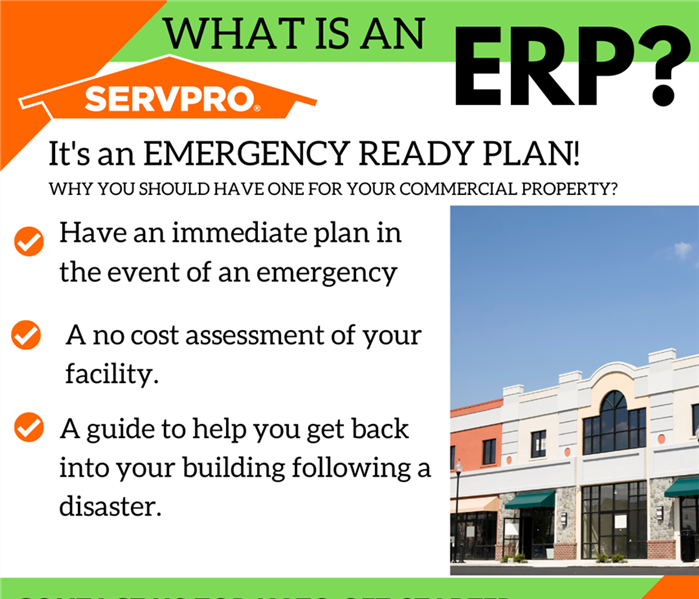 When you choose SERVPRO of Media while you can never know when disaster may strike, our goal is to make sure your prepared when it does!
When you choose SERVPRO of Media while you can never know when disaster may strike, our goal is to make sure your prepared when it does!
Here are a few reasons you should call us today to schedule an appointment for your very own Emergency Readiness Plan:
We can assist you immediate plan of action can help minimize the downtime to your business in an emergency. Provides facility details such as shut-off valve locations, priority areas, and priority contact information. You’ll have a quick reference of what to do, how to do it, and who to call ahead of an emergency so you are “Ready for whatever happens.”
Planning ahead by preparing an Emergency Ready Plan with our certified technicians gives you and your business the opportunity to have a provider that is recognized as an industry leader and is close by.
Having a professional to call right away who is versed and experienced reduces stress in times of disaster and makes for an easier insurance claims process! SERVPRO® of Media will help you navigate the insurance claims process and coordinate the necessary paperwork for a quicker, easier experience.
Call today to establish your business's ERP with one of our highly trained and certified technician's!
SERVPRO of Media offers tips on how to avoid property damage from a fire caused by gasoline usage.
2/28/2023 (Permalink)
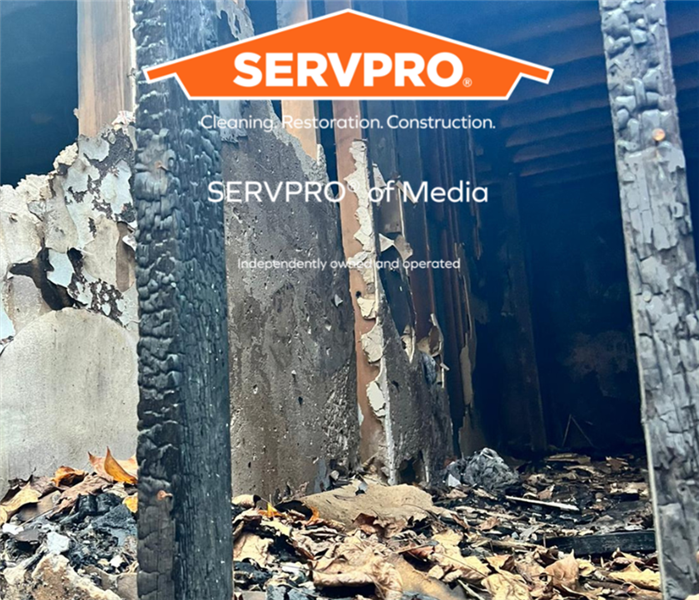 Disaster caused by fire can be catastrophic, SERVPRO of Media is equip for all of your fire damage, smoke damage and restoration needs!
Disaster caused by fire can be catastrophic, SERVPRO of Media is equip for all of your fire damage, smoke damage and restoration needs!
Fire damage restoration is often a complex project involving not only fire damage but also smoke damage, water damage, and mold growth. According to the National Fire Protection Association, the leading causes of house fires include unattended cooking fires, heating equipment, electrical and lighting issues, arson, and smoking materials. The water damage from the fire department’s efforts to extinguish the flames may end up being a major cleanup and restoration project. Smoke from a low-flame fire can contaminate the entire structure with soot, toxins, and odors. Since a fire produces a multi-faceted cleanup and damage restoration event, prevention, early detection, and rapid extinguishing are crucial.
Flammable Substances in the Typical Home
The typical home and garage have numerous household products that are highly combustible. Examples include:
- Aerosols such as hair spray, deodorant, disinfectant spray, starter fluid, insect spray, oven cleaner, etc.
- Rubbing alcohol and alcohol-based products such as hand sanitizer
- Common household products such as paint thinner, fingernail polish remover, furniture refinishing products, some car care products, lamp oil, paraffin, and kerosene
- Gasoline
Gasoline is dangerous when used or stored improperly. Due to its highly flammable properties and its many uses around the home, gasoline deserves special attention.
Preventing Fire Damage Resulting From the Use of Gasoline
From cars to lawnmowers, gasoline powers everyday life. However, the improper use and storage of this valuable commodity can cause fire damage or injuries. The following tips can help keep the family and home safe around gasoline:
- Follow safe storage practices. Store gasoline in a container engineered and sold specifically for that purpose. Containers with a volume of less than five gallons are best since the smaller quantity is easier to carry safely. Do not fill containers completely; instead, allow some room for expansion. Ensure that the container is tightly sealed when storing and before pouring. Avoid spillage as much as possible.
- When filling vehicles and equipment with gas, make sure the area is outdoors and well-ventilated. Also, if the vehicle or equipment has recently been used, allow it to cool off before refilling it. Diesel produces fewer fumes and burns more slowly than gasoline, but homeowners should practice the same safety precautions with both substances.
- Place a container on a flat, level surface before filling the container or transferring gasoline from one container to another. Some gasoline pumps are positioned on a raised concrete island. Before filling the container, make sure it is stable and away from the edge of the island. The safest policy is to place the container beside the raised island where there is little or no possibility of tipping. Again, take great care not to spill any gasoline.
- Follow a spill cleanup drill. Give immediate attention to gasoline spills, whether large or small. Clean up the gasoline with paper towels, rags, sawdust, or granular absorbent products, and dispose of the soiled items in a safe and environmentally sound manner. Never flush any gasoline-soaked items down the toilet. The gasoline can disrupt the bacterial breakdown that is necessary for a septic tank to function properly. A sewage backup, as well as damage to the septic system, can be very costly to diagnose and repair.
In the event of a large spill, seek assistance from the local government, such as the fire department or hazardous waste disposal center, about the safest way to clean up a large gasoline spill.
- Never store gasoline in the home or in an attached garage. A lawn shed a safe distance from any structure or automobile is best. Store gasoline away from heat sources such as a space heater, a furnace, or an electrical generator. Any device with an electrical arc poses a potential fire hazard from gas fumes.
- Avoid dangerous explosions which can result from the misuse of gasoline. When used as a solvent or cleaner, gasoline can be deadly. Do not substitute gasoline for the appropriate fuel when using a kerosene heater, oil lamp, or camp stove. Never smoke when handling gasoline or any other flammable liquids.
- Keep gasoline out of reach of children. Storing gas under lock and key is recommended.
When misused or spilled, gasoline can erupt into flames instantaneously, engulfing whatever is nearby and causing serious bodily injury or catastrophic property damage. In the event of fire damage, reach out to the fire damage and smoke damage restoration experts at SERVPRO of Media. They provide twenty-four-hour emergency service and a rapid response within an hour of the initial call. The highly trained restoration technicians are equipped to handle any size or type of disaster. Locally owned and operated, the SERVPRO team cares about the clients they serve.
Contact SERVPRO of Media for more information about fire damage cleanup in Media, PA. The office can be reached by phone at (610) 566-5720 or by email at office@SERVPROmedia.com
SERVPRO of Media provides twenty-four-hour emergency service, with highly trained restoration technicians who are equip to handle any size of disaster.
As spring ushers in periods of freezing and thawing, Newtown Square, PA, residents need to prepare their homes to weather the unpredictable weather.
2/24/2023 (Permalink)
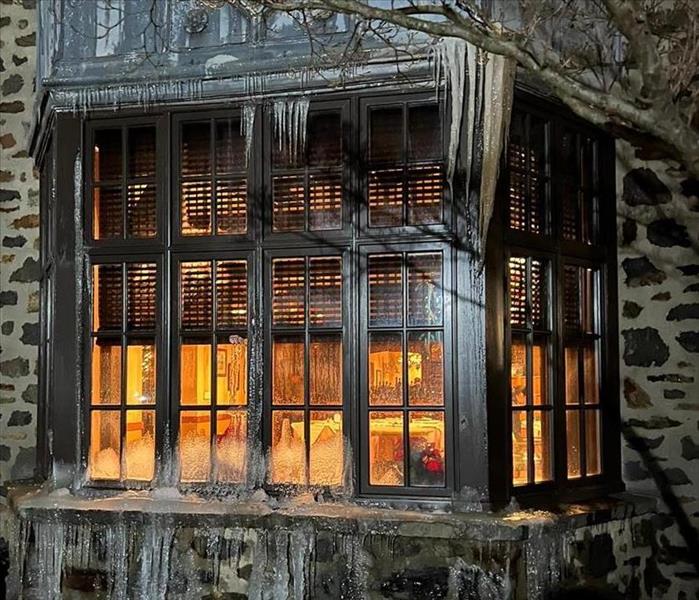 This window endured severe water damage and extreme freezing weather conditions.
This window endured severe water damage and extreme freezing weather conditions.
When a storm damage disaster strikes, SERVPRO of Media is prepared and ready to assist clients in Newtown Square, PA, and surrounding areas with water and flood restoration services, as well as storm cleanup. The damage restoration company’s rapid response helps homeowners and businesses recover from severe weather quickly and efficiently.
Early spring is that time of year when the weather is sometimes warm and calm and at other times cold and turbulent. Temperature variations can be extreme, and it is hard to predict when the shift will occur. The collision of warm air and cold air in the atmosphere can produce some of the most violent weather conditions, including tornadoes, large hail, and flooding.
In addition to producing storm activity, the freeze/thaw cycle is notable for making Pennsylvania roads more treacherous because the fluctuating temperatures create potholes. According to a Pennsylvania DOT publication, the freeze/thaw cycle is defined as “The calendar period between approximately February 15th and April 15th…” During the months of February through April, Pennsylvania residents would do well to not only pay more attention to the roadways but to also pay attention to their homes in preparation for potential water damage brought about by the storms and flooding of spring.
Listed below are some vital tips for the homeowner to prepare a home for unpredictable spring weather that can bring water damage, storm damage, and flooding. Many of these tips can also be useful for business owners.
Tip one: Inspect the grade around the foundation of the home.
When the home’s foundation is properly graded, water adequately drains away from the structure. The optimal slope is one inch per foot for the first five to ten feet. Re-grade any areas where the slope angles toward the foundation. Remove any obstructions such as timbers, bricks, or other debris that could hinder the free flow of water away from the foundation.
Tip two: Ensure flood drains around the home flow freely.
Leaves, grass, pine needles, mulch, and paper can build up on top of a drain grate, restricting the flow of water. A heavy thunderstorm can overwhelm the clogged drain, turning the yard into a shallow pond. The water can flood into the garage or seep into the crawl space. Even though the home or business may not be in a flood plain or qualify for flood insurance, insufficient grading and clogged drainage systems can create a situation that results in a micro-flood involving only one of two properties.
Tip three: Remove any obstructions from floor drains inside the home.
A floor drain can limit the scope of a water intrusion from a burst pipe, tub overflow, or roof leak, saving the homeowner time and money for a water damage restoration. However, if the drain is covered with items that restrict the flow of water into the drain, the results could be disastrous.
Tip four: Perform seasonal maintenance on gutters and downspouts.
Leaves, sticks, pine needles, and dirt can clog gutters and downspouts. When gutters are neglected over a prolonged period, the buildup of organic matter and sediment can foster the growth of saplings in the gutters. Overflowing gutters can cause structural damage to the home, promote mold growth, and lead to a flooded crawlspace.
Tip five: Consider installing water alarms and flood sensors.
Certain factors expose the home to flooding, and some homes are more flood-prone than others. Check the local flood map to see if the house falls in a flood plain.
Trust SERVPRO of Media for water damage restoration services in the event of a water damage disaster from storm damage, flooding, a burst supply line, or a sewage backup in Newtown Square, PA, or surrounding areas. Crews are available 24/7, 365 days a year, including holidays. A rapid response avoids advanced secondary damage from exposure to water and moisture. Trained, experienced, and certified technicians utilize the latest equipment and cleaning techniques to restore a home or business to its pre-disaster condition. Homeowners receive a detailed estimate with photo and video documentation. The staff at SERVPRO can handle the insurance claims process from beginning to end. The property damage professionals can also manage and coordinate all aspects of the project from start to finish, removing extra work and stress from the client’s shoulders.
For more information about SERVPRO of Media’s flood damage cleanup services, contact the team by email at office@SERVPROmedia.com. A customer representative can also be reached by phone at (610) 566-5720.
How proper tree care can help minimize storm and water damage to Newtown Square, PA, Homes
2/17/2023 (Permalink)
Blog Summary: SERVPRO of Media explains the connection between tree care and property damage mitigation.
SERVPRO® of Media, PA, offers storm damage and water damage restoration services when falling limbs or trees cause structural damage to a home or business. Broken limbs and toppled trees account for a significant amount of storm damage and water damage done to homes. Heavy rains, supersaturated ground, and high winds can affect both healthy and diseased trees. Proper care includes fertilization, treatment for diseases, selective pruning, reshaping, and, at times, tree extraction.
A home’s treescape must be safe for the family to work and play under. Secondly, a beautiful treescape adds real value to a home. In an article at HGTV entitled “Increase Your Home’s Value With Mature Trees,” Valerie Finholm states, “Towering trees on your property provide more than beauty — they increase the value of your home. Several recent nationwide surveys show that mature trees in a well-landscaped yard can increase the value of a house by 7 percent to 19 percent.”
Listed below are several tips to keep the treescape healthy, safe, and beautiful.
Tip: Know the difference between a healthy tree and a diseased tree. Healthy trees are strong trees, and strong trees are at a lower risk of limb shed, splitting, or falling over due to root failure during severe weather. The homeowner should be alert to these key indicators of an unhealthy tree.
Tip: Cracks and splintering in large, supporting branches and in the trunk indicate the tree has suffered trauma from sustained winds, a microburst, a lightning strike, or impact from an adjacent tree that has experienced limb shed or that has fallen down. Sustained winds coupled with the weight of heavy rain or sleet and ice can weaken branches until they eventually snap. As the branches plummet to the ground, other branches can be broken off or damaged. Some branches become snagged in the canopy, creating a serious risk to anyone or anything under the tree. Damaged or snagged branches need to be removed as soon as possible. A competent arborist can save the tree and reshape the canopy in a way that preserves much of its beauty. Extraction need not be the only option.
Tip: Balance is essential for a beautiful and safe tree canopy. A leaning tree is a potentially dangerous tree. A leaning tree exerts massive stress on the trunk and the root system. A steep degree of angle can cause diseased or damaged limbs to snap. Winds can magnify the stress on the tree, causing it to break off at the trunk. If the ground is wet from a prolonged period of rain, the root system may give way altogether, allowing the tree to come crashing to the ground. In some cases, younger trees can be positioned upright and then anchored in place. This feat requires the expertise of a well-equipped and competent tree service professional.
Tip: Disease spells disaster for a tree if not caught in time. Signs of the disease include rotting limbs, rotting spots in the trunk and roots near the trunk, fungus or mold on the bark, peeling bark, insects boring into the tree, and limb and leaf shed. Sometimes the tree will “bleed” sap or give off a distinct odor. If a screwdriver or knife blade can be easily plunged into a limb or the trunk, immediately have an arborist examine the diseased tree and the entire arbor for disease spread. When diagnosed and treated early, the tree may be able to be nursed back to health.
Tip: An aging, distressed tree may have hollow sections anywhere from the trunk to the union of large branches and sometimes in the larger branches. If squirrels, chipmunks, snakes, and birds suddenly disappear into thin air, they may have pulled a “Houdini” and slipped into a knot hole or hollow to avoid being detected by predators, pets, or humans. Have the situation assessed by a certified arborist. Unfortunately, in serious cases of rotting and hollowing out, extraction may be the best and safest avenue.
Caution: A falling limb may cause damage to the limbs below in the canopy. Sometimes, other trees may be affected by the limb shed. However, if a tree topples in the yard, other trees could be severely damaged. To resolve the hazard, multiple trees may need to be removed. The beauty of the total arbor may be marred, but the treescape will be safe and healthy.
Bonus tip: Keep a close eye on those beautiful, shade-giving trees. Take quick action to call in a professional at the first signs of cracks, splintering, limb shed, leaf shed, rotting, fungus, or hollowing. An experienced, certified arborist can remedy most issues with strategic trimming or pruning, a treatment protocol for disease, and an ongoing fertilization regimen.
What to do if a tree causes storm damage and water damage
A limb puncture in the roof can lead to tens of thousands of dollars in water damage in a home. If a limb or tree damages the home’s roof resulting in water damage, contact the water damage cleanup and restoration professionals at SERVPRO of Media. The trained and certified professionals arrive on-scene in about an hour to begin the cleanup and restoration process. If needed, emergency tarping can be applied to stop the roof leak. The team can handle the entire project, from cleanup to rebuild services to the insurance claims process.
Contact SERVPRO of Media to learn more about water damage restoration in and around Regal Edgmont Square, Newtown Square, PA. The office can be reached by phone at (610) 566-5720 or by email at office@SERVPROmedia.com.
A five-step action plan for addressing water damage in a commercial setting
2/17/2023 (Permalink)
Blog Summary: SERVPRO of Media provides water removal, water damage restoration, and other property damage restoration services to businesses that have suffered a property damage disaster.
When a water damage disaster happens in a commercial setting, SERVPRO® of Media, PA, arrives on-scene in about an hour, 24/7, 365 days a year, including holidays, to begin the water removal process. Heavy-duty wet/dry vacuums quickly remove the water, and powerful dehumidifiers remove the remaining moisture. SERVPRO’s rapid response and quick cleanup enable the business to restore normal operations.
Businesses must overcome daily challenges to stay profitable and keep their doors open. A commercial water damage disaster is one of the most common and costly challenges. For a small business, the question is “when,” not “if” water damage will occur. The leading causes of commercial water damage are leaks from faulty plumbing, malfunctions in the HVAC system, and leakage from an appliance such as a dishwasher, refrigerator, or supply line to the ice maker. The probability of a water intrusion from storm damage or a water release from a toilet, appliance, or fire sprinkler head justifies the expense of having commercial property insurance.
At the first signs of commercial water damage, immediately take action to resolve the issue. Delays allow the problem to worsen, resulting in greater damage and a more expensive cleanup and restoration project. Also, the insurance company may reduce or decline payment in instances of neglect. Here is a guide for dealing with water damage issues in the commercial environment.
A five-step plan to take care of commercial water damage cleanup and restoration
This five-step action plan walks the business owner, facilities supervisor, or property manager through the cleanup and restoration process so the business can resume normal business operations.
Step #1: Locate the source of the leak
Water leaks come in two types: a water intrusion and a water release. A water intrusion involves the introduction of water from outside the structure. Examples of water intrusion include:
- Flash flooding
- Roof leaks from wind damage, a limb puncture, or a leak around a roof vent
- Leaks around windows, doors, and skylights
- A gutter overflow into an attic space
- Water seeping into the garage or shipping area from under the rollup door
A water release is the introduction of water into the structure from water sources inside the structure. Examples of a water release include:
- A fire sprinkler
- A burst supply line to the ice maker, dishwasher, or sinks in the production area or bathrooms
- A burst pipe from an overhead waterline
Identifying the source of the leak may require the trained eye of a professional.
Step #2: Stop the leak
A water intrusion due to roof damage from severe weather may require emergency tarping by a roofing contractor. If the damage is from a broken limb or fallen tree, the services of an arborist with heavy equipment may be required.
A water release from a burst pipe, ruptured supply line, or fire sprinkler can be resolved by shutting off the main water valve. It may be possible to isolate the leak and shut off an inline valve to the supply line. If necessary, shut off the water main.
Step #3: Report the incident to the insurance company
Contact the insurance company as soon as possible. The same day as the incident is best. Also, document the damage with images and video. Upload images and videos to the cloud to free up storage space for the documentation process.
Step #4: Clean up and restore the water damage
Qualify and hire a property damage cleanup and restoration company to handle the project. Look for the following features when screening potential service providers:
- Locally owned and operated
- Specializes in commercial property damage cleanup and restoration
- IICRC-certified technicians
- Utilizes the latest equipment, cutting-edge moisture-detecting technology, and advanced cleaning techniques
- Available 24/7, 365 days a year, including holidays
- Provides a detailed, well-documented estimate, including images and video, which will prove very helpful in the insurance claims process
- Handles the insurance claims process from beginning to end
- Positive references and online reviews
Step #5: Resume normal business operations
A reputable water damage restoration company with a proven track record of serving commercial clients will provide a rapid response time and a quick cleanup and restoration, allowing the affected business to resume normal business operations without delay.
SERVPRO of Media, PA, meets all these expectations and more. The SERVPRO team can handle any size of disaster, including large-scale commercial property damage disasters.
Contact SERVPRO of Media for more information about Penn Wynne, Wynnewood, PA, water removal services. The office can be reached by calling (610) 566-5720 or emailing office@SERVPROmedia.com.
Five ways to avoid broken windows, water intrusion, and flood damage
2/17/2023 (Permalink)
Blog Summary: SERVPRO of Media provides flood restoration services for homes and businesses that have been damaged by water intrusion and flooding from storm damage.
SERVPRO® of Media, PA, offers flood restoration services to Media, PA, and the surrounding metro Philly area. The area is no stranger to severe weather. Over the last twenty years, over a dozen hurricanes and tropical storms have impacted Pennsylvania, including Media and the Philly area. The strong winds and heavy rains never fail to cause wind, water, and storm damage to homes and businesses caught in the harsh weather. The high winds can shatter windows, causing serious water damage.
Windows allow sunlight to stream into the home, bringing with it the following benefits:
- Saves on power bills by reducing the need for artificial lighting
- Promotes a sense of comfort
- Reduces eye strain
- Stimulates productivity by enhancing mood and improving air quality
- Invigorates house plants which in turn benefits the occupants of the home
- Reduces anxiety and stress
- Provides Vitamin D and helps with reducing seasonal affective disorder
- Improves sleep
- Increases the value of the home
Protecting the home’s windows is a top priority. Strong, straight-line winds, heavy hail, or wind-driven debris can damage the glass, allowing water to enter the structure and cause significant damage. Below are practical tips to ensure that the only thing that enters the home through the windows is sunlight.
1. Install protective storm shutters
Storm shutters constructed of natural wood or composite material are strong enough to withstand the stresses of high or hurricane-force winds. Initial installation requires some planning and scheduling, and the project is best implemented when the skies and the forecast are clear. These shutters are an excellent option and can be reused whenever severe weather threatens.
Bonus budget tip: Use thick (at least 5/8-inch) plywood if storm shutters are not available or are not in the budget. The plywood works well, is easily installed, and can be stored and reused. If the winds are strong enough to launch heavy debris such as lawn furniture, toys, bicycles, tree limbs, or garbage cans, the plywood makes a strong shield to protect the windows and everyone inside the home.
2. Avoid taping windows
Applying tape in an X-shape to the inside of the windowpane is useless in strengthening the windowpane and, in fact, may increase the risk of serious injury if the pane should break due to the high winds. The tape prevents the window from breaking into smaller, less harmful shards. The safest course of action is to stay away from windows, storm doors, and sliding doors during severe weather. An interior closet or bathroom is best unless the home has a basement, which is the safest place to seek refuge from severe weather.
3. Close windows to prevent wind and water damage
Hurricanes and tornadoes are associated with areas of low atmospheric pressure. Contrary to popular belief, opening a window does not keep the panes from shattering from the positive pressure inside the home. In fact, the house allows the positive air pressure to dissipate very quickly. The windows are in no real danger. An open window will let wind-blown rain flood the room, causing extensive water damage. Close all windows to keep the home dry and safe.
4. Store potential projectiles in a safe place
Strong winds can send heavy and light objects tumbling across the yard at dangerous speeds. These hurdling torpedoes can smash through screened porches, car windows, and house windows. Swing sets should be solidly anchored in the ground. Yard items that can take flight include garbage cans and lids, lawn furniture, bicycles, plastic toys, tools, a wheelbarrow, and light lawn ornaments. Windows can shatter upon impact, sending a shower of glass shards into the room.
5. Install impact-resistant window film
Window film, also referred to as anti-burglary film, covers the entire pane. If the window does break, the film holds the pieces together, avoiding the dangers of glass shards flying through the room or littering the floor. No impact-resistant film makes a windowpane “hurricane-proof.” The window may be held together in the adhesive grip of the impact-resistant film even though the entire home collapses under the stress of gale-force winds. Avoid using impact-resistant window film as a substitute for storm shutters or plywood.
What to do when storm damage and flooding occur
High winds, heavy rains, and flash flooding can cause extensive property damage needing immediate attention. When water is knee-deep in the basement and water is cascading onto the dining room table with a festive splash, turn to the professionals at SERVPRO of Media for help. Crews can be on the scene in about an hour to begin the restoration process. Available 24/7, 365 days a year, including holidays, the IICRC-certified technicians utilize heavy-duty equipment, cutting-edge technology, and advanced cleaning techniques to finish the project quickly so life can return to normal for the customer.
For more information about flood restoration services in Newtown Square, PA, call the SERVPRO of Media office at (610) 566-5720. The team can also be reached by email at office@SERVPROmedia.com.
How to safely use a fireplace and avoid a fire and water damage disaster
1/26/2023 (Permalink)
Blog Summary: SERVPRO® of Media provides tips for safe burning practices when using a fireplace.
SERVPRO of Media, PA, recommends homeowners exercise safe fireplace burning practices to prevent a fire damage disaster that requires fire and water damage restoration services. Safe burning starts with what goes into the fireplace. Some items should never be burned in a fireplace, and the list of what not to burn in the fireplace may be surprising.
Any treated wood
While arsenic is no longer used in pressure-treated wood as of January 1, 2004, old pressure-treated wood is harmful due to residual amounts of arsenic. Decking, support beams, and plywood treated with arsenic should be discarded appropriately. Never burn the wood in the fireplace, wood stove, firepit, or on an open fire. Woods that have been painted, varnished, or stained will also give off toxic fumes and smoke if burned. The adhesives used in the manufacture of plywood will produce toxic fumes as well.
Cardboard, corrugated boxes, and printed paper
Both solid fiberboard (e.g., cereal boxes) and corrugated boxes (e.g., pizza boxes) should not be burned in a fireplace. Chemicals used in the manufacturing and printing of these items can emit toxic chemicals and fumes. Gift wraps, magazines, coupon inserts, and colorful mailers should not be burned in the fireplace. A page or two of plain newsprint with black print can start a fire. Burning paper can float out of an unprotected chimney, putting the roof and yard at risk of catching fire.
Liquid accelerants
Examples of accelerants that should not be used to start a fire in the fireplace include such items as lighter fluid, charcoal lighter fluid, gasoline, kerosene, diesel fuel, motor oil, engine starter fluid, rubbing alcohol, liquors, fingernail polish remover, paint thinner, hair spray, wasp spray, spray lubricants, or any other flammable liquids or sprays. Most of the above items are highly combustible and can flare up when ignited. Methanol and petroleum-based products give off toxic fumes when combusting, and accelerants generate a very high heat that can damage the chimney or cause it to ignite, which could burn a home to the ground.
Wet firewood
Moisture in wet or green firewood increases smoke production and rapid creosote buildup, elevating the risk of a chimney fire. Use seasoned firewood and avoid burning evergreens such as pine for the same reasons. Make sure logs are free of poison oak or poison ivy.
Other items that should not be burned in the fireplace:
- Wood pallets may be treated with pesticide to prevent the spread of the ash tree borer.
- Driftwood contains harmful metal salts absorbed from the ocean.
- Plastics give off toxins which cause numerous health effects.
- Fabrics produce lots of toxic smoke, which increases creosote buildup.
- Small batteries can give off toxic fumes and can explode under extreme heat.
- Fresh fruit peels smolder, which increases creosote buildup. First, dry the peels of apples, lemons, or oranges, then burn them in the fireplace for an aromatic evening by the fireplace.
- Leaves burn very hot and can cause a chimney fire. Wet leaves give off lots of smoke that increase creosote buildup in the chimney.
Basic fireplace safety tips
This winter season will see many families relying more heavily on their fireplaces and wood stoves as temperatures drop and energy costs skyrocket. These basic fireplace safety tips will help keep the home both warm and safe.
- Inspect the fireplace and chimney at least once a year, preferably in the fall, before cold weather arrives.
- Always use a fireplace screen to prevent embers from escaping the fireplace.
- Keep combustibles at least three or more feet away from the fireplace.
- Avoid putting combustible decorative items on the hearth.
- Always have a fire extinguisher nearby when burning the fireplace.
- Never leave a burning fire unattended.
- Install smoke alarms outside every bedroom and change the batteries at least once a year. The kitchen, den, laundry room, and garage should have smoke detectors.
- Keep children and pets a safe distance from the fireplace.
- Create an emergency fire escape plan and conduct drills with the family.
- Pre-qualify a property damage cleanup and restoration company before a fire, smoke, or water damage disaster occurs.
What to look for when choosing a damage restoration company in Media, PA
A locally owned and operated company is invested in the community. Word of mouth, BBB ratings, and social media reviews should validate a solid track record of excellent customer service. Trained and IICRC-certified technicians should have industry-leading equipment, cutting-edge technology, and the latest cleaning techniques and EPA-approved cleaning products. Services should be available 24/7, 365 days a year, including holidays. Can the company promise a quick response time of about an hour or so? A reputable company will inspect and assess the damage before providing a detailed, well-documented estimate that includes images and video. Choose a damage cleanup and restoration company that can handle the insurance claims process from beginning to end.
For more information about fire and water damage restoration and cleanup services for the areas near Regal Edgmont Square, Newtown Square, PA, email SERVPRO of Media at office@SERVPROmedia.com or call (610) 566-5720.
Three ways that water intrusion can damage the garage and create the need for water removal
1/26/2023 (Permalink)
Blog Summary: SERVPRO® of Media advises homeowners to be aware of the damaging effects water damage can have on the garage.
Homeowners may be under the impression that heavy and prolonged rainfall, high moisture levels, and flooding will not cause significant water damage in the garage, and they may assume that they will not need water removal services. After all, the space consists of a concrete floor, bare walls, and a garage door. Windows are few, and no one takes their muddy shoes off to enter the garage. However, serious water damage is quite possible in the garage.
Water damage in the garage may go unnoticed or ignored until the damage becomes evident. If left unchecked, the water damage will require repairs and even restoration. Delays in dealing with water damage will impact the insurance claims process and the eventual payout. Neglecting a property damage issue, especially water damage, may result in the forfeiture of an insurance claim since the damage was more the result of neglect instead of the original water damage incident. Below are some examples of the damaging effects water can have on the garages of homes in Penn Wynne, Wynnewood, PA.
1. Primary and secondary structural damage to the home
Though it may appear that the concrete floor of the garage is rock-solid, in reality, the slab is porous. When the floor becomes saturated from flooding, it cannot absorb any more water. The water in and on the concrete releases moisture that can seep into any wood framing that might be present in the garage. Adjacent rooms and the attic above the garage can be damaged by the water and moisture from the concrete floor.
2. Damage to items stored in the garage
A typical two-car garage ranges in size from 400 (20X20) to 576 (24X24) to 720 (24X30) square feet. The temptation to use some or all of the space for storage is sometimes unavoidable. Items stored in the garage include junk, old magazines, important financial documents, clothing, holiday decorations, unused furniture, memorabilia, recyclables, antiques, and other valuable keepsakes and heirlooms. Constant exposure to moisture and the occasional mini-flood from heavy downpours can ruin these items. Antiques, old records, and photo albums may not be worth much in the event of an insurance claims payout, but their sentimental value is priceless.
3. Mold infestation
The typical garage is warm, moist, and dark. Add to this recipe limited ventilation and lots of organic matter for food. The garage is a prime breeding ground for mold. From the garage, mold and mildew can easily migrate to the rest of the home, including the attic or bonus room above the garage.
Key indicators of water damage in the garage
Watch for these warning signs that can tip off a homeowner to water damage in the garage. Catching and resolving the water damage can save thousands in water damage cleanup and restoration.
- Unexplained water puddles on the garage floor
- The deterioration of sections of the concrete floor into small flakes and chips, also known as spalling
- Large cracks in the floor
- Exposed structural steel in the concrete floor
- A musty smell and black, green, or brown stains on the floor, walls, and items in the garage
How to deal with water damage in the garage
First, the homeowner needs to identify the source of the water intrusion and resolve it. Action steps may include the following:
- scheduling a gutter inspection by a licensed roofing contractor
- adding a ventilation system in the garage to increase airflow
- having a landscape architect check the grade around the foundation of the home
- lowering the garage door when inclement weather is approaching
The best way to take care of any water damage is to hire a reputable property damage cleanup and restoration company to remove any standing water, dry out the affected areas with industrial-strength dehumidifiers, restore any damaged personal belongings stored in the garage, and mitigate mold issues. Do not be surprised if the mold infestation extends far beyond the garage. The crawl space, attic, and any rooms attached to the garage may also be affected.
The professionals at SERVPRO of Media are available 24/7, 365 days a year, including holidays. The rapid response and quick water damage cleanup process return life to normal as soon as possible. The homeowner or business will receive a detailed estimate. SERVPRO of Media can handle all aspects of the project, including the demolition and reconstruction of the damaged structure, and the team manages the claims process from beginning to end with no headaches or hassle for the property owner.
To learn more about Penn Wynne, Wynnewood, PA, water removal services, contact SERVPRO of Media by calling (610) 566-5720. The office can also be reached by email at office@SERVPROmedia.com.
Five landscaping considerations that can help prevent storm damage and flood damage
1/26/2023 (Permalink)
Blog Summary: SERVPRO® of Media advises homeowners about landscaping strategies that aid in flood damage prevention.
SERVPRO of Media has provided flood restoration services for many homes in the Newtown Square, PA, area. The team knows that after flooding and flood damage, homeowners wonder what they could have done to prevent the disaster. One way to avoid flooding is through landscaping strategies. Landscaping offers many benefits to the home, including improving drainage to prevent water damage and reducing the likelihood of storm damage to the house and personal property. Below are five practical landscaping tips to help homeowners tend their yards while keeping water and storm damage concerns in mind.
Tip: Practice proper tree care
A home’s treescape provides shade, saves on energy bills, creates ambiance, and can add significant value to the selling price of a home. Though the project may be costly and involve permitting and paperwork with the governing municipality, do not delay removing dead, diseased, or rotten trees. Secure the services of a reputable, experienced, and well-equipped tree service to extract the trees. The dead tree may drop limbs or, worse, fall over while being tied off or cut down. The collateral damage to the home, vehicles and bystanders could be financially catastrophic. If the price quote for a job seems too good to be true, the reason may be the arborist does not carry adequate insurance. Dead trees and limbs can fall during high winds. Tree removal makes this type of damage avoidable.
Healthy trees need regular maintenance, especially if the canopy is near the home or overhangs the roof. Limb impact damage to siding, trim, paint, gutters, or windows caused by a tree near the structure is considered regular wear and tear over an extended period of time and would not be covered by insurance. A limb puncture to the roof may go unnoticed until a cascade of water pours into the attic, causing ceiling and wall water damage in the rooms below.
Tip: Avoid planting trees and shrubs near the septic system
When designing and installing a new landscape plan, avoid planting trees and shrubs on or near the septic drain field or main sewer line. The sewer line may be damaged during the planting process, resulting in a sewage backup disaster. Over time, roots from trees and shrubs can clog the drain field or crack the sewer line. The repairs to the sewage system will be costly, and a sewage backup in the home can result in costly cleanup and restoration.
Tip: Carefully manage water runoff around the home
Make sure the grade around the home slopes away from the foundation at one inch per foot for at least six to ten feet. Do not pile mulch next to the foundation since the excess moisture can cause mold or wood rot. Periodically inspect downspouts to determine if the connections are secure and do not leak.
Tip: Inspect and clean out the gutter system on a seasonal basis
Clogged gutters frequently cause serious water damage in the attic, siding, ceilings, and walls inside the home. Clean the gutters several times when the leaves begin to fall during autumn. A heavy thunderstorm with high winds can strip a tree bear. A mature oak tree may have as many as 200,000 or more leaves clinging tenaciously to its branches. If the yard has pine trees near the home, high winds and heavy rain can cause a massive needle loss that can clog gutters. Hire a professional to clean the gutters if there is any concern at all about falling from the ladder.
Tip: Install a sump pump as a last line of defense and test it regularly
When the gutters are clogged, when the downspouts are releasing water next to the foundation, when the slope away from the foundation is too shallow to divert water from a heavy downpour away from the structure, and when the foundation is allowing hundreds or thousands of gallons of water to seep into the basement or crawl space, let the sump pump do its work. Clean out and test the system several times a year. Include a backup battery system in case the power goes out.
Pre-qualify SERVPRO as the dedicated property damage cleanup and restoration company
The best time to find and choose a dedicated property damage cleanup and restoration company is before fire damage, smoke damage, water damage, or storm damage disaster has occurred. There is time to review the company’s website, read reviews, check references, and get to know the team. SERVPRO of Media provides a rapid response and a quick cleanup and restoration. The team is available 24/7, 365 days a year, including holidays. Customers received a detailed, well-documented estimate with images and video. SERVPRO handles the insurance claims process from beginning to end.
For more information about flood restoration services in Newtown Square, PA, call SERVPRO of Media at (610) 566-5720 or email office@SERVPROmedia.com.
How clogged gutters can lead to extensive water damage in and around the home
1/2/2023 (Permalink)
Blog Summary: SERVPRO of Media highlights the many ways a home can suffer water damage from clogged gutters.
SERVPRO® of Media highlights the need for water damage restoration that can arise when clogged gutters are undetected or neglected, leading to a water intrusion and the potential for extensive water damage. Gutters clogged with leaves, sticks, pinecones, and living plants are unsightly, and unsightly gutters ruin curb appeal and decrease property values. Clogged gutters can also overflow, causing extensive property damage to the home.
Fall and spring are the best times to clean out gutters. It is recommended to have several gutter checks in autumn when the leaves begin to fall and at least one inspection around the end of March. A mature oak tree may have between 200,000 and 500,000 leaves on its branches, and many of these leaves will wind up on the roof and in the gutters. Only one inspection at Halloween or Thanksgiving is risky, but an inspection at Halloween, Thanksgiving, and Christmas brings peace of mind, especially when temperatures drop, the snow falls, and the risk of ice dams forming is elevated.
While most or all of the leaves have fallen by the end of December, pine needles and other debris can clog the gutters. A Spring gutter clean may involve a visual check of the gutters and roof. The Spring inspection will bring peace of mind when the first thunderstorm of the season stalls over the neighborhood, dropping several inches of rain on the roof. Knowing that the gutters are in good shape eliminates worries about potential water damage.
Damage caused by clogged gutters
Listed below are five types of damage clogged gutters can cause around a home.
1. Damaged foundations
The primary purpose of gutters is to capture water and direct it to the downspouts. The downspouts lead the water away from the foundation of the home. Some homeowners attached extensions to the downspouts to ensure the water is deposited safely from the foundation. Overflow from clogged gutters is deposited very close to the foundation. The saturated ground expands and then contracts when the water evaporates. The positive and negative stress on the foundation can cause the foundation walls to develop cracks. The cracks weaken the foundation and allow water to seep into the basement or crawl space. The compromised foundation can set off a cascade of issues that undermine the home's structural integrity. A bi-annual gutter cleaning can help the homeowner avoid catastrophic water damage and repair and reconstruction of the foundation.
2. Rotting wood
Gutters are attached to wooden fascia boards. Water from clogged gutters can overflow and cause the facia boards to rot, and wooden siding is also vulnerable to wood rot when gutters overflow.
3. Landscaping damage
A well-landscaped yard can experience water damage from overflowing gutters. The excess water can wash away rich topsoil needed for plant nutrition, and some shrubs and plants may not thrive in the wet conditions caused by water overflow. The replacement cost for a mature shrub or bush could easily be several hundred dollars. Mulch can be washed away, littering the yard with debris.
4. Ice dams
During the cold winter months, clogged gutters trap water that can freeze, producing buildup known as ice dams. When the ice begins to melt, the water can seep into the roof, causing water damage to the attic, walls, and interior ceilings. Mold, wood rot, and structural damage are inevitable If the gutter problem is not resolved. Moisture mitigation, mold remediation, and the repair and replacement of sheet rock and structural timbers could have been avoided with a simple gutter inspection and cleanout.
5. Pest problems
During the warmer months, the water and moisture trapped by clogged gutters create an ideal breeding ground for mosquitoes. Moisture that seeps into the attic and behind the siding also creates an inviting habitat for termites. Roaches, silverfish, and ants appreciate the moist environment, as well. An increase in the pest population inside the home may signal the need for a water damage inspection and a gutter check to identify the source of any moisture.
What to do when a water intrusion and water damage have occurred
If a water intrusion from clogged gutters has affected the attic, ceilings, walls, baseboards, flooring, and other home parts, the homeowner should immediately clean the gutters. Next, the services of a reputable, certified, and professional water damage cleanup and restoration company can be secured to remove any water and reduce moisture levels with high-powered, fast, and efficient dehumidifiers. Once the damaged areas are thoroughly dried out, the SERVPRO of Media team can begin repairing and restoring the damaged home. Delays can lead to advanced secondary damage, including mold, wood rot, and pest infestation.
For more information about water damage restoration services for not just homes but also businesses like Regal Edgmont Square, 4777 West Chester Pike, Newtown Square, PA 19073, contact SERVPRO of Media at (610) 566-5720 or at office@SERVPROmedia.com
Eight tips on how to prevent a water damage during a holiday vacation
1/2/2023 (Permalink)
Blog Summary: SERVPRO® of Media offers eight steps to help homeowners have peace of mind while on vacation during the holiday season.
SERVPRO of Media, PA, a leader in property damage cleanup and restoration, is aware of seasonal hazards and restoration services that might be needed in the event of property damage at homes in Penn Wynne Wynnewood, PA, and nearby areas.
A holiday vacation can be a time of renewal and refreshment for the upcoming year. However, leaving home unoccupied can be unnerving. What if something goes wrong? Worry and anxiety have the potential to ruin time away from work, spending time with the extended family, celebrating the holidays, reflecting on the past year, and planning for the year ahead.
Below are some helpful tips to prevent water damage and to help vacationing homeowners avoid worrying about their homes.
Water damage is the second most common reason homeowners file an insurance claim. The fact that there are many causes of water damage may explain the frequency of insurance claims. Water damage may be caused by the following:
- Heavy rainfall and localized flash flooding
- Roof damage from high winds in combination with heavy precipitation
- Overflow from clogged gutters that floods the basement or crawl space
- Icy weather
- Leaking pipes
- Appliance malfunctions (burst supply lines)
A water intrusion is always disruptive, inconvenient, time-consuming, and usually involves some expense to clean up and restore. When that leaking water pipe or clogged HVAC condensate pan has been dripping for days or weeks, the damage can be extensive. Water flows from a burst supply line at about five gallons per minute. A much slower leak of 5 gallons per hour will dump 120 gallons of water per day onto the kitchen or bathroom floor. If the bathroom is upstairs, the homeowners could be in for a disheartening surprise when they walk through the front door to find two weeks of water, almost 2,000 gallons, in their flooded home. A minor water leak has escalated into a major catastrophe, including extensive advanced secondary damage. Carpets, rugs, flooring substrates, HVAC ducts, insulation, walls, ceilings, baseboards, and anything touching the wet floor can be ruined by extended contact with water and moisture.
Steps to prevent water damage in the home while on a holiday vacation
These eight steps can help guard a house against most types of water damage and enable the entire family to relax and enjoy the holiday vacation with family and friends.
Step #1: Conduct a thorough inspection for leaks at least two weeks before departure
Check the home for leaks in time enough to make any repairs before leaving for the vacation. The inspection should include the following:
- Pipes and connections under all sinks
- Supply lines and connections to the dishwasher, washer, and refrigerator
- Water heater (Check for cracks, rust, and moisture in the leak pan.)
- Roof (Look for damaged or missing shingles, clogged gutters, and damaged or missing vents.)
- Attic (Check for signs of a roof leak or water damage due to overflow from clogged gutters.)
- Basement and crawl space (Scan the basement or crawl space for signs of a leak.)
During the inspection, sniff for any moldy or mildewy smells. This first step is the most critical since the goal is to identify and resolve any existing water leaks or water damage before the start of the holiday vacation.
Step #2: Shut off the water supply to the entire home
Dramatically reduce the risk of water damage by shutting off the water supply at the main water valve. Run the faucets and flush all toilets to drain the pipes. This action will prevent pipes from bursting in case of freezing weather.
If circumstances do not allow the water to be shut off at the main valve, then shut off the valves to the appliances with supply lines, such as the washer, refrigerator, and dishwasher. Include supply lines to toilets and faucets in this step.
Step #3: Conduct a gutter check
Clean out the gutters before departure. By the time Thanksgiving and Christmas arrive, most of the leaves should be off the trees. Ensure any leaves, sticks, or debris are not clogging the gutters. Downspouts should be connected and extended six to ten feet from the home's foundation. The grade around the house should slope away from the foundation at about one inch per foot for at least ten feet.
Step #4: Test the sump pump
Clear out any debris in the reservoir. Listen for strange sounds in the pump. If a backup system is not in place, consider upgrading before the vacation begins.
Step #5: Insulate exterior faucets and exposed water pipes to make them freeze-proof
Keep the home’s temperature high enough to prevent interior pipes from freezing. Open the doors to cabinets with sinks.
Step #6: Leverage leak-detection technology to prevent water damage
This technology is affordable, effective, and often can be installed by the savvy homeowner.
Step #7: Have a family member or friend check the home once or twice
Leave written instructions for what to do in an emergency, including telephone numbers of a plumber, electrician, and property damage cleanup and restoration company. Include the location of the main water valve, the thermostat, and the electrical panel.
Step #8: Pre-qualify SERVPRO of Media.
SERVPRO of Media is an excellent choice for the dedicated property damage cleanup and restoration professional that will be contacted in case of water damage or other types of property damage. The SERVPRO team is available 24/7, 36 days a year, including all holidays. A crew can be onsite in about an hour or so. A detailed estimate with full documentation, including images and video, will be provided. SERVPRO of Media can handle the insurance claim process from beginning to end.
Contact SERVPRO of Media to learn more about the company’s seasonal hazards and restoration services. The office can be reached by phone at (610) 566-5720 or by email at office@SERVPROmedia.com.
How a frozen fire sprinkler system can cause both fire damage and water damage
1/2/2023 (Permalink)
Blog Summary: SERVPRO of Media explains how frozen pipes in a fire sprinkler system can increase the risk of fire and water damage.
The professionals at SERVPRO of Media, PA, provide fire and water damage restoration services to homeowners and businesses that have suffered a property damage disaster from burst pipes due to an ice blockage in a fire sprinkler system. Homeowners, business owners, and property managers are well acquainted with the disruption, inconvenience, and stress associated with frozen pipes when a winter blast roars through the Northeast and descends on Newtown Square, PA, and the surrounding area. The frozen water inside plumbing pipes expands, exerting greater and greater pressure until the pipes fracture, sending cascades of water into the home, business, or manufacturing facility. The resulting water damage disaster creates a complex matrix of problems.
Ice buildup in a fire sprinkler system elevates the risk hazard in the home, apartment complex, or commercial structure. The safety of residents, employees, and customers is negatively impacted. A blockage in the sprinkler system impedes or eliminates the life-saving capabilities of the affected fire sprinkler system. If the sprinkler system pipes freeze and rupture, a condition known as a “freeze break” in the fire safety realm, the results could be catastrophic unless a shut-off tool is located and employed to shut off the water to the sprinkler system.
Besides the extremes of an ice blockage or a freeze breakage which render the fire sprinkler system useless in a residential or commercial setting, other less obvious but quite hazardous circumstances emerge. The subtle situations can be life-threatening for the people in the structure, whether commercial or residential. Homeowners, business owners, and property managers must pay attention to the issues encompassing fire sprinkler systems.
Incremental impact on the integrity of the fire sprinkler system
Not all ice blockages in a fire sprinkler system completely cut off the flow of water through the system or end in a water damage disaster. Cycles of freezing and thawing may occur in the system’s pipes when the pipes are exposed to low temperatures for an extended period. This unusual occurrence sets up a vicious cycle that dramatically stresses the pipes in the fire sprinkler system. Pipes that freeze and thaw after a freeze event may appear unscathed. However, the integrity of the pipes may be compromised. Hairline cracks may grow progressively worse over time, resulting in what initially is a slight or minor water release. The owner or property manager can be assured that the problem will not remain static and unchanged. Compromised pipes in a fire sprinkler system can burst, causing substantial flood damage to furniture, stock, merchandise, equipment, and buildings. A fire sprinkler shut-off tool is quite helpful in this situation to prevent further water damage.
Difficult to locate and expensive to repair
When ice begins to form in a fire sprinkler system, pressure is exerted on the unfrozen water in the pipes. Now under intense pressure, this unfrozen water can burst pipes in areas of the sprinkler system that did not freeze. It may seem strange that an unfrozen section of the sprinkler system might experience ruptures. These unanticipated leaks are difficult to anticipate and spot. The cost of the water damage repairs and any inventory loss can be high.
The prominent place of prevention in protecting the fire sprinkler system from freezing
The best strategy to avoid fire and water damage from a freeze-related break in a fire sprinkler system is prevention. The following recommendations are a good starting point:
- Identify sections of the fire sprinkler system with an elevated risk of freezing during a cold snap. Fire sprinkler systems in stairways, hallways, and unheated warehouse areas are susceptible to freezing.
- Mitigate the risk hazard by insulating the sprinkler system pipes or increasing the heat sent to these areas by the HVAC system or other heat source.
- Follow a prescribed inspection and maintenance on the fire sprinkler system.
- Submit to required annual inspections by regulating agencies such as the fire department. Promptly implement any recommendations and required actions resulting from the third-party inspection.
- Have a sprinkler shut-off tool accessible in the event of a sudden, unexplained sprinkler system activation.
Dry sprinkler systems may also have water buildup from condensation. Proper maintenance can eliminate any risk hazards arising from the presence of water in the system.
What to do if a fire or water damage disaster occurs
An ice blockage in a fire sprinkler system prevents the system from extinguishing a fire, putting a home or business at greater risk of fire damage. A freeze break in a fire sprinkler system can cause extensive water damage in a house, apartment, or business. Before a disaster strikes, pre-qualify the fire and water damage cleanup and restoration specialists at SERVPRO of Media. The team is available 24/7, 365 days a year, including holidays. A crew can be at the scene in about an hour or so. Technicians are IICRC-certified, undergo continuous training, and are experienced.
To learn more about water and fire and water damage restoration services for Newton Square businesses, email SERVPRO of Media at office@SERVPROmedia.com. The office can also be called at (610) 566-5720.
Helping homebuyers avoid purchasing a home with an active mold infestation and mold damage
11/16/2022 (Permalink)
Blog Summary: When purchasing a home, homebuyers will want to make sure that the house does not have a mold problem that will require mold remediation services. SERVPRO® of Media is sharing a mold inspection checklist to help people identify and avoid mold-infested homes.
The experts at SERVPRO of Media are dedicated to providing dependable water damage restoration and mold remediation services for Newtown Square, PA, clients, including homebuyers who have purchased a house that needs mold remediation.
When and where to inspect for mold
Before ever making an offer on a home, go over the property with a mold checklist in hand to avoid assuming a problem that nobody wants to have, especially a new homeowner. A spot check on both outside and inside the home may reveal evidence of mold. Recommended equipment includes an LED headlamp for hands-free inspection, nitrile gloves, protective eyewear, and a mask. Document the inspection with images and video with a smartphone.
Phase one: Start on the outside of the home.
Begin the inspection before ever entering the home. Outside evidence of mold growth may indicate the presence of mold on the inside of the house.
Step #1: Examine the roof and gutter system for damage and signs of leaks.
Step #2: Check sidings, windows, and doors for damage. Leaks through siding, windows, and doors are a major cause of water damage and mold in homes.
Step #3: Look for cracks in the foundation and moisture in the crawl spaces.
Phase two: Inspect the interior of the home.
Step #1: Do a sniff test.
- A musty, mildewy, earthy smell is a strong indication of moisture and mold issues.
Step #2: Check ceilings, walls, and windows.
- Are there any brown, green, or black stains on ceilings, or especially on exterior walls?
- Are there any discolorations, warping, or swelling trim and baseboards around or below windows?
- Do exterior doors open and close smoothly?
Step #3: Give bathrooms a close look.
Bathrooms are typically the wettest rooms in a home and are vulnerable to mold from moisture and heat.
- Use the flashlight to expose any leaks or mold under the vanity. Feel supply line connections for leaks. Sniff for a mold odor. Test the floor for moisture, softness, or warping.
- Are stains on the caulking around toilets, showers, and bathtubs?
- Do the bathroom fixtures, walls, and ceilings have mold?
- Test all bathroom exhaust fans. Look for stains around the fan. A leaky roof stack can be a harbinger of extensive damage in the attic.
Step #4: Give the kitchen special attention.
- Use a flashlight to shed light on the area under the sinks. Check the walls, floor, drains, and supply lines for leaks. Press on the floor to see if it is dry and firm. Are there any signs of repairs?
- Examine the flooring under the refrigerator and dishwasher. Look for mold on the walls surrounding the refrigerator and on the appliance.
- Test the exhaust fan above the stove. Is the area around the fan and under the hood clean of grease and grime buildup? Is the stove light in good working order?
- Convert the stove light to an LED bulb, which burns much cooler and is just as bright.
Step #5: Shed some light on the attic areas.
- Start out with the sniff test.
- Check for stains or mold on the flooring, trusses, rafters, and sheathing.
- Mold thrives on paper, cardboard boxes, and clothing, which are often stored in the attic. Touch, smell, and visually inspect the contents of the attic for evidence of mold.
- Are all exhaust fans vented through the roof?
- Are there any signs of wild animals living in the attic?
Step #6: Visually inspect the HVAC system.
This system is complicated and technical. Moisture and electricity do not mix well, so be careful when scoping out the HVAC system.
- Open the access panel and perform the sniff test for mold.
- Use the flashlight to check for dust buildup, leaks in the condensate pan, and mold growing on or around the system. If the HVAC blower is in the attic, check the ceiling and walls above the system for signs of a leak. Look for any signs of rust on the unit.
- Check the cool air return covers for dirt, grime, and mold.
Phase three: Contact the mold professionals at SERVPRO® of Media.
If the decision is made to purchase the home, then congratulations! If mold is an issue, the mold removal professionals at SERVPRO of Media can handle any size mold issue and do it quickly, which is crucial when buying a new home or an investment property.
For more information about SERVPRO of Media’s mold remediation services, contact the office by email at office@SERVPROmedia.com or by phone at (610) 566-5720.
Why should homeowners not attempt a DIY restoration project after water damage from a burst pipe?
11/16/2022 (Permalink)
Blog Summary: SERVPRO of Media urges homeowners to avoid DIY restoration after burst pipe water damage.
SERVPRO® of Media offers cleanup and restoration of water damage from burst water pipes. Media, PA, residents can trust the restoration specialists to thoroughly clean up and restore water from a ruptured supply line to a washer, ice maker, sink, or toilet. If a water pipe bursts and floods a basement with thousands of gallons of water, technicians can pump the basement dry quickly and efficiently with high-capacity pumps, industrial-strength wet/dry vacuums, and powerful dehumidifiers.
A water damage, fire damage, or a smoke damage disaster can have catastrophic consequences for the homeowner. Property damage can be extensive, and the inconvenience and disruption may be more difficult to handle than the actual property damage. The property owner is faced with a major decision: How to move forward with the cleanup? Should it be a DIY project, or should the cleanup and restorations be passed off to professionals with advanced equipment, the proper cleaning techniques, and safe sanitizing and disinfecting products?
The truth is that the cleanup and restoration process is a challenging and sometimes hazardous undertaking. The homeowner may have experience in general cleaning techniques and basic building construction, including plumbing and wiring, but the disaster cleanup and restoration process are multi-faceted, requiring a keen eye and experience working in disaster settings. Consider these compelling reasons why the best, most efficient, and safest course of action is to secure the services of an IICRC-certified professional restoration company to handle the water damage cleanup and restoration project.
1. Unknown or unanticipated hazards
The homeowner who occasionally tackles a DIY project around the home is often familiar with the structure. A disaster such as extensive flooding from roof damage or a flooded basement from a burst pipe may create a scenario that is loaded with dangers. Storm damage can cause ceilings to collapse when the homeowner begins to probe around while assessing the damage. A flooded basement may increase the risk of electric shock, and debris hidden under the water’s surface can cause lacerations, puncture wounds, or trip-and-fall injuries. Wet particle boards can give way underfoot, leading to a back injury or broken limb. Standing or puddled water on the kitchen floor can create conditions that raise the potential for a slip-and-fall injury.
Health issues abound in a catastrophic property damage disaster. The basement does not have to flood for the risk of electrical hazards to exist. Damaged wiring or a poorly grounded electrical appliance can give a pretty hefty jolt of electricity to the unsuspecting and poorly equipped DIYer. Gas lines may be intact after a flood, but the improper relocation of the appliance can rupture the line or compromise a fitting, leading to a dangerous and volatile gas leak. Unforeseen dangers lurk in the water-damaged home or business, and examples include bacteria, mold, or raw sewage. Raw sewage dramatically elevates the risk factors involved in property damage cleanup and restoration. Protective clothing, eyewear, gloves, and strong EPA-approved cleaning products are required for safe, thorough cleanup and restoration.
Bonus tip: When flooding, fire damage, and smoke damage are extensive, avoid entering the home alone. Damage restoration professionals follow the strictest safety precautions.
2. Lack of proper cleaning equipment
Disaster cleanup and restoration require more than the basic mop, sponge, and bucket. Industrial-grade wet-dry vacuums, high-speed pumps, rapid-spin fans, and commercial-grade dehumidifiers are used to tackle the toughest jobs in the shortest amount of time to prevent advanced secondary damage. Professionals also use deodorizers, disinfectants, and sanitizers that remove bad odors, pathogens, and mold.
3. The danger of hidden damage
IICRC-certified technicians are trained and skilled in finding hidden water damage. The unsuspecting homeowner is likely unaware of the many places water damage can hide. Professionals anticipate moisture and mold behind walls, in appliances, and in outlets. The professionals at SERVPRO of Media carefully and thoroughly inspect the home or business that has suffered a property damage disaster for hidden damage.
4. Advanced secondary damage
A swift response and a fast cleanup and restoration of a water, storm, fire, or smoke damage disaster are essential to prevent advanced secondary damage such as mold, warping, and wood rot. Permanent damage can occur to electronics, documents, books, leather goods, artwork, and furniture if water is not quickly removed and if moisture is not reduced to acceptable levels. A DIY cleanup and restoration project can take days or weeks to execute, and the delay can allow damage to progress far beyond the scope of the original disaster.
A property damage disaster is disruptive, inconvenient, and stressful. Trust the cleanup and restoration to the professionals at SERVPRO of Media to get the job done quickly, safely, and thoroughly. They know what to look for and where to look to ensure that no damage goes unrepaired. The team of professionals at SERVPRO of Media is IICRC-certified and ready to serve the damage restoration and cleaning needs of Media, PA, and the surrounding areas.
Contact SERVPRO of Media for more details about water and fire damage repair and restoration in Media, PA. The office can be reached by emailing office@SERVPROmedia.com or calling (610) 566-5720.
Water damage restoration for water leaks resulting from overstressed plumbing at businesses
11/16/2022 (Permalink)
Blog Summary: SERVPRO of Media explains how the holiday shopping rush can lead to an increased number of people needing to use a retail establishment’s facilities and how the extra use can cause clogged pipes, toilet backups, and water leaks.
The holidays are one of the busiest and most profitable times of year for retail businesses, but the extra load of seasonal shoppers could overstress the plumbing, resulting in a water damage disaster that eats into holiday profits. At SERVPRO of Media, the team is highly trained in commercial property damage restoration and understands just how devastating a water damage disaster can be to a business, especially during the holidays. Frustration abounds when a business has to temporarily close down during the peak of Black Friday weekend or Christmas shopping. By inspecting and preparing the plumbing system before the rush arrives, business owners can minimize the potential for a catastrophic water leak that turns a white Christmas into a black water Christmas.
Check for evidence of preexisting stress on the plumbing
Commercial plumbing is designed to withstand the demands and complexities of a commercial environment. However, pipes that are already on their last leg will be more vulnerable to failure due to the pressure of increased use. Signs of compromised plumbing can manifest in several ways.
- Pay attention to flow issues.
Is the water flow through the building restricted or reduced? Are toilet backups a constant problem? Abnormalities in water flow could point to a clog or damaged pipe.
- Look out for leaks.
Take note of all leaks — both large and small — that appear to originate from the plumbing. If the leak is small and is caught quickly, an employee or the janitorial staff may be able to mop up the water intrusion without leaving any lingering issues. However, large leaks or hidden water leaks may have caused enough damage to require the services of a water damage restoration company.
Signs of a hidden water leak include:
- discoloration of walls or floors
- peeling paint
- warped walls
- a musty smell of mold or mildew
- a visible mold infestation that occurs away from any known water sources
- unexplainable increases in water utility costs
Hidden water leaks can be especially disastrous because they are difficult to notice, allowing even a slow, small leak to cause major issues over time.
- Inspect for obvious damage.
Serious losses can be averted if the business owner or an employee spots plumbing damage early so that it can be repaired before the system fails. Keep an eye out for cracks, burst pipes, pipe swelling, loose fixtures, and broken connections.
Remediate factors that stress the plumbing system
The holiday season can be stressful enough for families and business owners, but the plumbing system does not have to be stressed too. While the plumbing cannot take a vacation over the holidays, the business owner can help out the situation by relieving some of the issues that push pipes past their limit.
- Prioritize pipe maintenance.
Every five or so years, bring in a plumbing professional to perform a video pipe inspection of the system. The technician will use a waterproof high-resolution camera attached to a flexible rod to obtain a live video feed of the situation inside the pipes. If the video detects any issues, the plumbing team will provide the appropriate maintenance or repairs.
- Reduce water pressure in the building.
Highly pressurized water can undermine the connections and seals of commercial plumbing, leading to leakage in the affected areas. A commercial plumber will be able to determine if the pressure is too high and can install a water pressure regulator if necessary.
- Encourage proper flushing practices.
When items other than toilet paper are introduced into the plumbing system, clogs can arise. Remind employees that only toilet paper should be placed in the toilets, and post restroom signage communicating the same message to customers.
- Invest in a commercial water softening system.
According to the United States Geological Survey (USGS), “The simple definition of water hardness is the amount of dissolved calcium and magnesium in the water. Hard water is high in dissolved minerals, largely calcium and magnesium.” These minerals accumulate in a building’s pipes, decreasing the flow of water through the plumbing. Over time, the sludge can completely obstruct the system, and since hard water buildup is difficult to remove, the pipes may need to be replaced. In local areas where hard water flows through the water supply, the business owner can purchase a water softener to remove unwanted minerals.
Call SERVPRO® of Media to restore the holiday cheer
When a pipe bursts or a toilet overflows at a local business in Broomall, PA, the business owner can rely on the water removal and restoration technicians at SERVPRO of Media to remediate the damage. The company provides a 24/7 emergency response and is available year-round, even on holidays. The restoration and cleanup process is completed rapidly, enabling the business to pivot right back into the most important retail season.
For more information about SERVPRO of Media’s water removal, commercial water damage restoration, and sewage cleanup services, contact the office at (610) 566-5720 or office@SERVPROmedia.com.
Does the Carpet Need Cleaning? Seven Signs That Call for Professional Carpet Cleaning Services
10/11/2022 (Permalink)
Blog Summary: SERVPRO of Media provides carpet cleaning services for homeowners in Media, PA, and surrounding communities.
SERVPRO of Media, PA, provides property damage cleanup and restoration, including carpet cleaning services. A habit of routine vacuuming and the quick cleanup of spills, stains, and mud helps keep the carpet serviceable and presentable between cleanings. Outlined below are seven signs that carpeting in Media, PA, homes needs a professional deep cleaning.
#1. The carpet no longer matches the upholstery and drapes.
If the carpet’s original color is a mystery and no longer matches the décor, the services of a professional carpet cleaning company are needed. Discoloration sends a strong signal that the carpet needs attention. High-traffic areas typically show wear and dirt by turning a darker shade.
#2. Carpet hygiene has long since been abandoned.
If the habit of taking shoes off at the door has been replaced by the habit of leaving shoes on and tracking grime throughout the home, the carpet not only needs a deep clean but also thorough disinfection and sanitization. Shoes track dirt, grease, and pathogens throughout the residence, making the carpet unsightly and unsanitary.
#3. Carpeting retains its stains.
The impulse is to let mud and spills set up so they will be easier to clean. If a stain has the opportunity to dry, the carpet can be permanently damaged. Pet stains demand immediate attention; otherwise, the stain will not be able to be removed from the carpet. Professional skills and industry-leading cleaning products must be applied to remedy the blemish.
#4. The carpet stinks.
The occupants of a home will grow accustomed to carpet stench. The smell may be noticeable after the homeowner returns from being away from the house for several hours. Close friends and family may comment on the foul smell when visiting. If strangers mention the scent, it is time to schedule a professional carpet cleaning.
Carpet fibers can absorb odors. Scented topical treatments, which are then vacuumed, may mask the smell for a while. Smoke and pet urine call for professional-grade deep cleaning and sanitizing. A strong odor may indicate that the carpet has been stained or contaminated with a fluid.
#5. The carpet is visually unappealing.
If the carpet has taken on a dingy, grungy appearance, professional deep cleaning can refresh and revive the colors and texture. If colors and designs are muted and dull, and if the texture is matted and crushed, a good cleaning will restore the luster, vibrance, and fluffiness of the floor covering. Some carpet manufacturers require that their products receive a particular type of cleaning, and violation of the manufacturer’s specifications may render the warranty null and void.
#6. The carpet is no longer soft and luxurious.
If the carpet feels rough, hard, gritty, or compressed, it is probably loaded with dirt, sand, pet hair, or other debris. Give the carpet a “white sock” test. Rub a clean white sock over several spots on the carpet. If the sock is dirty, it may be time for a cleaning.
#7. The carpet is so old it is valuable.
Premium carpets may be manufactured with delicate materials. Antique or oriental rugs may be woven with wool or other animal hair. These fibers require special training and expertise to safely and effectively clean without ruining the materials or disturbing the colors. Some modern, common fibers require special attention, such as nylon carpeting. Over time, the carpet may flatten and lose luster. A competent, knowledgeable, professional carpet cleaning can revive these delicate carpets.
When carpets need cleaning, disinfecting, and deodorizing, trust the carpet cleaning professionals at SERVPRO® of Media. The IICRC-certified team has the knowledge, training, and expertise to clean carpet that suffers from the normal wear and tear and dirt and grime of everyday use. Because SERVPRO of Media is a full-service damage restoration and cleaning company, technicians also are able to clean and restore carpet that has been involved in a property damage disaster involving fire, smoke, and water damage. Pet stains, nicotine, body fluids, and biohazard cleanup and restoration are carpet cleaning challenges the SERVPRO team overcomes on a regular basis. For effective, professional carpet cleaning solutions, SERVPRO of Media is an excellent choice for homeowners in Media, PA, and neighboring communities.
For more information about the cleaning and damage restoration company, email SERVPRO® of Media at office@SERVPROmedia.com or call the office at (610) 566-5720.
Signs of Tree Damage and What to Do in the Case of Storm Damage from a Fallen Tree
10/11/2022 (Permalink)
Blog Summary: SERVPRO of Media offers tips on how to spot tree damage and how to take care of storm damage from fallen trees and limbs.
SERVPRO® of Media is available 24/7, 365 days a year, including holidays, to provide storm damage cleanup and restoration services for Media, PA, homes, and businesses. In September of 2021, the remnants of Hurricane Ida dumped nearly five inches of rain on the metro Philly area, including Lancaster County. Some areas received over nine inches of rain. Flash flooding and strong winds accompanied the rain. The winds, in conjunction with the saturated soil, resulted in toppled trees, broken limbs, and downed power lines. Many homes suffered structural damage from the flooding and from the storm-damaged trees. The team at SERVPRO of Media offers this advice on tree care to help residents maintain a healthy, beautiful, and safe treescape.
Signs a tree is a potential risk during storms
All trees are vulnerable to the forces of nature. The cold months bring the threat of ice, sleet, and snow. During the warmer months, high winds and rainfall can put trees in jeopardy. High winds can cause limb loss. In extreme conditions, a tree may topple over, creating a domino effect throughout the canopy in which other trees fall or are damaged. If the trees are near a home or business, storm damage to the structure is inevitable. Here are some signs that a tree may be susceptible to limb loss or toppling over during a storm.
Factors contributing to tree failure
Many factors can compromise tree strength and stability. Decay, tree wounds, and shallow root systems are some leading culprits. Normally, a tree’s root system spreads out almost half as much as the canopy, but in urban areas where construction is very active, a root system can be damaged by grading, trenching, and excavating. Encroachment can hinder the outward spread of roots, which not only deliver nutrition but also serve as anchors. A compromised root system puts a tree at risk of windthrow, the technical term for uprooting or toppling.
Tree selection in a subdivision may result in trees with root systems that function best in forests. However, these trees are sometimes transplanted in soil that is shallow or rocky. Once the trees reach maturity, the soil hinders the root system from firmly anchoring the trees. The mature trees are vulnerable to windthrow and put the homes in the neighborhood at risk of property damage should the trees topple over during severe weather.
A treescape with an integrated network of tree limbs and root systems may withstand powerful winds. However, efforts to thin the treescape can leave the remaining trees vulnerable to high winds.
Tall trees are at greater risk of toppling than shorter trees. Tall, fully-leaved trees catch the wind, which transfers lever-like power to the trunk. The forces can rip the tree out of the ground. Broken limbs, peeling bark, and scraped wounds make a damaged tree susceptible to a pest infestation, further rot, and possibly the need to be removed.
Trees, in general, are at risk if wind speeds are high. Some tree varieties have less resilience to withstand wind force. Examples include Bradford pear, balsam fir, cedar, and white spruce, as well as older water oaks, older willow oaks, some hemlocks, and several varieties of pine trees.
How to inspect a tree
Visually inspect the tree from top to bottom, from a distance, and from close by. Use binoculars, if necessary. Drone technology is affordable and accessible to assist with examining the treescape.
Note any of the following issues:
- Deadwood or brown leaves in the crown of the tree
- Wounds caused by prior limb loss
- Unusual lean (which may indicate damage to the anchor root or unequal weight distribution from rot and disease)
- Multiple trunks (in the shape of a ‘U’ or a ‘V’)
- Splits in one or more trunks
Also, note ground disturbances from trenching, ditch digging, grading, and tilling activity within the bounds of the tree canopy. Construction near trees, including driveways, walkways, a garden, or utility line work, can damage shallow feeder roots and destabilize a tree.
Seven signs that a tree needs immediate attention
- Damaged or peeling bark
- New roots have recently become exposed
- Cracks in the trunk or at the base of long limbs
- Soil that is heaving or cracking opposite any tree lean
- Sparsity of foliage for no apparent reason
- Brown or fall colors during the summer months
- Carpenter ants, conks, or mushrooms on or near the trunk
Tree safety action steps
Immediate action steps are necessary to keep the area under the tree canopy safe and to prevent storm damage from falling trees and limbs.
Step #1: Contact a bonded, insured, and certified arborist to schedule an onsite consultation. Some issues can be remedied with treatments for disease and strategic pruning. Removal may be required in some instances.
Step #2: Take extreme precautions to stay safe. Cordon off the high-risk area around the tree. Relocate vehicles at a safe distance from damaged or dangerous trees. Stay out of the part of the home that would be damaged if the tree suffered a catastrophic failure.
Storm damage cleanup and restoration
If a limb or tree should puncture the roof or house envelope, contact the professional storm damage cleanup and restoration team at SERVPRO® of Media, PA, for emergency tarping, water removal, drying, and dehumidification. The water and moisture need to be within acceptable levels to prevent advanced secondary damage, including a mold infestation. SERVPRO can handle the cleanup and restoration, including major repairs to the roof, ceilings, walls, and flooring.
For more information about storm damage restoration in Broomall, PA, and surrounding areas, contact SERVPRO of Media by calling (610) 566-5720 or by emailing office@SERVPROmedia.com.
Helping Newton Square, PA, Homeowners Avoid Fire Damage by Practicing Proper Chimney Maintenance
10/11/2022 (Permalink)
Blog Summary: SERVPRO of Media highlights chimney maintenance tips to prevent fire damage from chimney fires.
A chimney fire is a traumatic fire damage event for the occupants of a home. Some chimney fires occur without the residents even being aware of the danger. A chimney fire has the potential to cause extensive property damage as well as personal injury. The proper use and maintenance of fireplaces and wood stoves can prevent chimney fires and save lives. Homeowners can practice the chimney maintenance tips below for a warm, safe home during the winter.
Tip: Schedule a chimney inspection every year in the early fall.
Both the National Fire Prevention Association and the Chimney Safety Institute of America recommend chimneys be inspected and cleaned on an annual basis. An inspection in the early fall will discover any animal or insect nests built the previous spring and summer. The homeowner can light the first fire of the year knowing the chimney is clean and structurally sound.
When hiring a chimney professional, look for these key features:
- Sweeps the flue to remove loose soot and creosote (Animal and insect nests and other debris should be removed from the smoke chamber, smoke shelf, and firebox.)
- Presents a written, well-documented report on the condition of the chimney (This report may include images and video of the chimney.)
- Recommends repairs and offers advice on how to better care for the chimney
- Guarantees to clean up any mess from the inspection and maintenance process
Tip: Use safe firewood.
Dense hardwoods such as oak, maple, and elm are best for the fireplace or wood stove. The hardwoods cure best when split, stacked, and allowed to dry out in a well-ventilated area for six months to a year. The moisture content should be 20% or less. Cracks on the ends of the split logs indicate sufficient curing may have taken place. A moisture meter can verify the moisture content of the wood.
Evergreens dry out more quickly, but the creosote content is much higher. The temptation is to burn cardboard and Christmas wrapping paper in the fireplace or wood stove. Paper fires burn very hotly, increasing the risk of igniting creosote in the chimney. Do not burn wood that has been treated or painted since the wood releases dangerous toxins during combustion.
Tip: Be familiar with the manufacturer’s installation, operation, and maintenance guidelines.
Be able to manage the combustion air intake for the fireplace or wood stove. Fire requires oxygen. Make sure the appliance has adequate airflow for the fire to burn efficiently. Creosote will build up if the fire is smoky and smoldering. If the appliance has a glass front, watch for smoke stains on the glass, which may indicate the fire is not burning hot enough.
The manufacturer’s established maximum burn times, an indication of the fire’s temperature, may vary. The type and condition of the wood, the type of chimney, the season of the year, the location of the appliance, and the stove’s (or fireplace’s) interaction with other heating appliances in the home can and do influence burn times.
Tip: Monitor the fire’s burn temperature.
Two options are a magnetic thermometer and a probe thermometer. A magnet thermometer attaches to the stove surface or a connector pipe. The optimum surface temperature is 300-500 degrees Fahrenheit.
The probe thermometer provides a more accurate temperature measurement because it registers the core temperature of the flue gases rising from the fire. The optimal temperature range is 600-1000 degrees Fahrenheit. By keeping the fire burning at or within optimal temperature ranges, creosote accumulation can be prevented or minimized.
Tip: Have a Class ABC fire extinguisher near the woodstove or fireplace.
Make sure everyone in the home who is physically capable understands how the device works and how to use it in the event of a fireplace fire. Special chimney fire extinguishers are available to prevent a chimney flare, but these extinguishers function best in an airtight system. Never use accelerants in a woodstove or fireplace.
Tip: Consult a licensed professional chimney sweep before using chemical additives to control creosote.
Be aware that the thickness and extent of the creosote may require multiple applications to achieve satisfactory results.
A fire damage disaster often involves structural damage from the flames. Smoke and soot create a toxic environment for humans and pets. Water damage from the fire hose used to extinguish the flames may be more extensive and costly to remediate than the actual fire damage. The professionals at SERVPRO® of Media are available 24/7, 365 days a year, to provide a rapid response and quick cleanup and restoration when a complex fire damage disaster occurs. Delay allows the situation to grow in scope and severity, adding unnecessary expense and hassle to the project. The best time to reach out to a fire damage cleanup and restoration company is before a fire. Waiting until after a disaster has occurred can be a disaster! Call today while the home is not in flames, the roof is not leaking, the ceilings are not sagging, the walls are not warping, the floors are not buckling, the sewage is not backed up, and mold has not made a meal of anything organic in the home.
Contact SERVPRO of Media to learn more about fire damage restoration in Newtown Square, PA. The office can be reached by phone at (610) 566-5720 or by email at office@SERVPROmedia.com.
Strategies to Prevent Fire Damage in Dormitories as Students Return to College This Fall
9/7/2022 (Permalink)
Blog Summary: SERVPRO of Media highlights fire damage prevention strategies for colleges as students head back to school.
The team at SERVPRO® of Media, PA, is certified in fire damage and water damage cleanup and restoration services, as well as smoke removal services. When a fire occurs, the damage scene is complex and toxic, requiring a multi-faceted cleanup and restoration solution. Student displacement presents a challenge to institutional administrators who must find accommodations on a campus that is likely at peak residential capacity at the commencement of the fall semester. SERVPRO of Media is available 24/7, 365 days a year, including holidays. SERVPRO can tackle fire damage in a single dorm room fire or scale to meet the challenges of dormitory buildings that sustained extensive damage. The fast response and quick cleanup and restoration have the students back in their rooms and resuming their normal routines as soon as possible. SERVPRO of Media offers these fire safety strategies to avoid fire damage as students return to campus this fall.
Campus life in a college dorm room can be exciting, fulfilling, comical, and sometimes hazardous. FEMA reports the following statistics: “According to the U.S. Fire Administration (USFA), an estimated 3,800 university housing fires occur each year in the United States with 88 percent being cooking fires. The leading causes of campus-related fires include: 1) cooking (hot plates, microwaves, portable grills, etc.); 2) arson; 3) careless smoking; 4) unattended candles; and 5) overloaded extension cords, power strips, and outlets.”
The last time most incoming freshmen received any fire safety education was many years earlier while they were in elementary school. To prevent fires in campus housing, a culture of fire safety must be inculcated in the student body. This goal can be effectively achieved through ongoing fire safety education. Emphasis should be placed on the primary fire hazards in the dorm room: cooking, careless smoking, candle safety, and the proper use of extension cords, power strips, and outlets. Many colleges and universities are smoke-free and candle-free (except with special permission). Regularly scheduled fire drills are a loud reminder of the need to be mindful of ever-present fire hazards. The drills will also familiarize students with predetermined evacuation routes.
The value of pre-qualifying a damage restoration company
By pre-qualifying a dedicated property damage cleanup and restoration company, institutional administrators only need to make one phone call when a disaster strikes. The SERVPRO franchise family has a solid reputation as an industry leader spanning over fifty years and is a trusted partner with institutions and property management companies around the US. Consider these key factors when formulating a disaster readiness response or when reviewing and revising current response protocols for the upcoming academic calendar.
- Core competencies: Fire damage, smoke damage, water damage, flood damage, biohazard cleanup (drugs), crime scene cleanup, suicide and accident cleanup (blood and body fluids), Certified SERVPRO Clean services (COVID)
- Certification: SERVPRO technicians are trained to the highest industry standards through IICRC, the Institute of Inspection Cleaning and Restoration Certification, a non-profit organization for the Inspection, Cleaning, and Restoration Industries.
- Bonded, licensed, insured, and a top choice of insurance companies when a disaster strikes
- Massive scalability: SERVPRO has the capacity to respond with one, five, or fifty (or more) crews in the event of a large loss disaster such as a large-scale structure fire, flash flood, tornado damage, or vandalism/graffiti incident. The concentration of franchise service providers in the greater Philadelphia area uniquely qualifies SERVPRO to meet any large-scale need. SERVPRO of Media can tap this asset-rich reserve almost instantly and activate a rapid, highly coordinated response.
- Documentation: Upon arrival, a highly trained technician conducts a thorough inspection and assessment of the damage scene. A detailed, well-documented estimate, including images and videos, is provided to the client. SERVPRO uses Xactimate, the industry-standard estimating software utilized by insurance companies.
- End-to-end service, including working with the insurance company and providing general contracting services for the restoration/rebuild phase of the overall project
- Availability: The fire damage restoration professionals at SERVPRO of Media are available 24/7, 365 days a year, including holidays.
- Free consultation: SERVPRO of Media helps businesses, industry, medical facilities, property management companies, and institutions of higher learning formulate a customized disaster response plan. This Emergency Readiness Plan is tailored to fit the client’s individual needs.
For more information about fire prevention strategies, property damage cleanup and restoration, or a customized Emergency Readiness Plan in Newtown Square, PA, contact SERVPRO of Media by email at office@SERVPROmedia.com. The office can also be contacted by phone at (610) 566-5720.
The Value of Safe Smoking Policies for Avoiding a Fire Damage Disaster at Broomall, PA, Restaurants
9/7/2022 (Permalink)
Blog Summary: SERVPRO of Media encourages safe smoking practices as a way to prevent fire damage in restaurants.
SERVPRO® of Media provides fire damage restoration, smoke odor removal, and water removal services to businesses that have suffered a fire damage disaster. SERVPRO’s commitment to implementing a rapid response and quick cleanup makes its commercial services a solid choice for businesses, especially restaurants.
The importance of cigarette smoking policies at restaurants and bars
Prior to 2004, only two states had enacted laws completely banning smoking at worksites, restaurants, and bars. In recent years, other states have followed suit. In 2008, Pennsylvania passed into law the Clean Indoor Air Act, which restricted smoking in certain “public places.” The Pennsylvania law defines a “public place” as “An enclosed area which serves as a workplace, commercial establishment or an area where the public is invited or permitted.” The term includes facilities that provide “education, food or healthcare-related services.”
With these restrictions in place, restaurants and other public venues with high foot traffic need to provide proper disposal sites for discarding smoking materials. Designated smoking areas should be clearly marked. Stringent housekeeping practices need to be implemented, as well. The goal of these efforts is to limit the ignition of combustible materials and to reduce the likelihood that a fire will spread if it should start.
By adopting and implementing the following practices, a restaurant or other smoke-free business can accommodate the needs of patrons who smoke while also avoiding fire hazards related to smoking materials. Some of these measures also seek to reduce the potential for spreading should a fire break out.
Commercial insurance experts recommend the following safety measures specifically for restaurants, but other businesses may benefit from implementing these strategies: “Designate smoking areas at least 25 feet away from buildings, combustible materials, vegetation or refuse collection areas. Areas that allow smoking and areas that prohibit smoking should be clearly marked with appropriate signage. All smoking materials should be disposed of in acceptable receptacles and kept away from ignition sources. Disposal devices should be appropriately marked, be constructed of non-combustible materials, and have steep sides to keep materials inside the device. If smoking is allowed inside the building, then properly designed ashtrays should be provided in smoking areas to prevent cigarette butts or ashes from falling or rolling onto combustible materials. Ashtrays should only be dumped into designated disposal containers with a lid and filled with a medium that can safely extinguish a fire, such as sand or water. If smoking materials are going to be placed into a dumpster they should be thoroughly wetted down with water. Smoking materials may still be smoldering, so it is best to wet these down prior to disposal in a garbage dumpster. Make sure your dumpster is located at a minimum of 10 feet away from the building, but further away is preferred. A fire extinguisher should be placed in the area with a maximum travel distance of 75 feet away from the smoking area. By following the advice above, restaurant and bar owners can help protect their businesses from accidental fire while also abiding by smoking bans. Promoting a smoke-free workplace has many benefits, including limiting secondhand smoke exposure and reducing the chance of an accidental fire.”
Why choose SERVPRO of Media to remediate restaurant fire damage
Media, PA, is renowned for its great shopping, fine dining, and live entertainment! These establishments depend on repeat and regular business from loyal patrons, new customers, and out-of-town visitors enjoying the sights, sounds, and cuisine of the Philadelphia metro area.
When a fire damage disaster strikes a restaurant, a rapid fire damage restoration process is crucial to get the doors open and the revenue flowing. A team of cleanup and restoration professionals from SERVPRO of Media can be on-scene in about an hour to inspect and assess the damage and begin the cleanup. A fire damage disaster involves fire, smoke, soot, chemical fire suppressants, and water. Certified, experienced, and well-equipped technicians tackle the complex cleanup and restoration challenges with the goal of helping the damaged establishment resume normal business operations as soon as possible. The SERVPRO franchise family can, without delay, scale to meet any size disaster.
Contact SERVPRO of Media for more details about the company’s fire and water damage restoration services in Broomall, PA. The office can be reached by email at office@SERVPROmedia.com or by calling (610) 566-5720.
Four Landscaping Projects to Reduce the Risk of Basement Flooding in Newtown Square, PA, Homes
9/7/2022 (Permalink)
Blog Summary: SERVPRO of Media explains how landscaping projects can both minimize the risk of basement flooding and make the home more beautiful.
SERVPRO® of Media, PA, provides fire damage, smoke damage, and water damage restoration services. When a homeowner is faced with a flooded basement, these property damage services are indispensable. To help homeowners avoid basement flooding, the professionals at SERVPRO of Media offer the landscaping strategies outlined below.
A dry basement is important for a clean, healthy, and safe environment in the home. A wet, damp basement facilitates the growth of mold and mildew, which can damage anything stored in the basement. The excessive moisture promotes wood rot and rust. Pests such as cockroaches, silverfish, centipedes, and earwigs thrive in the moist environment. During dry spells, ants will crawl into a home in search of moisture and respite from the heat.
Remedies for basement moisture can be very expensive. The installation of a French drain, a sump pump system, and waterproofing are examples. However, less expensive landscaping strategies can be pursued prior to implementing the more costly and invasive solutions. A multi-faceted approach may result in significant cost savings as well as a dry basement.
Below are four landscaping projects that can help minimize the risk of basement flooding.
1. Install a rain garden.
Rain gardens are recessed areas designed to capture excess rainwater from walkways and the lawn. The water is diverted away from the foundation. The bedding soil is comprised of sand, organic matter, and the existing topsoil. This blend enhances proper drainage while inhibiting the accumulation of standing water. The prime location for the garden is away from the foundation between the home and the street. Install low-maintenance plants to control erosion and slow absorption into the ground.
Native plants are an excellent choice for these rain gardens. Hardy, drought-resistant native plants serve as a natural barrier to any street runoff. The extensive root systems of native plants filter contaminated water before it can leach into the groundwater below. Native plants also attract insects that help pollinate surrounding vegetation.
2. Improve the grade around the foundation.
Sometimes, something as simple as adjusting the grade around the foundation of the home solves the basement moisture problem. The grade or slope should be steep enough to drain excessive amounts of water away from the foundation. The recommended slope is one inch per foot, up to ten feet away from the structure. If the grading is close to these specifications, a homeowner can improve the grade where needed with a few wheelbarrow loads of dirt. More extensive grading revisions may require the services of a landscape company with the equipment to haul in more dirt and shape it to the proper grade.
3. Create a barrier between planting beds and the foundation.
If a planting bed is nestled next to the foundation, a shallow gravel barrier can be installed as a break between the mulch in the bed and the foundation. Mulch retains water and moisture that may seep into the basement or crawl space. This gravel landscape feature provides an aesthetically pleasing separation between the mulch and the side of the home. The gravel allows water to drain away from the house.
4. Consider installing a dry creek bed.
On a grander scale, some homeowners create a dry creek bed in the middle of the yard. The large trench is lined with long-lasting, water-permeable landscape fabric and then filled with river rock. The feature is sloped to carry water away from the foundation and the larger area surrounding the home. Discharge from the downspouts can be directed to the dry creek bed. Not only is the prominent feature a beautiful addition to the landscape, but it is also a very effective means to conduct water away from the perimeter of the home.
Some new home construction includes the installation of a French drain. Post-construction installation of this solution is exceedingly expensive. A comprehensive drainage solution may include the installation of a sump pump system in the crawl space or basement.
Bonus Tip: Keep gutters and downspouts clean and flowing freely.
Clean and free-flowing gutters and downspouts effectively capture and transfer large amounts of roof water away from the home. If gutters become clogged and overflow, this water is deposited next to the foundation and may cause basement flooding. If a downspout detaches from the gutter or if a discharge pipe disconnects from the downspout, hundreds of gallons of water will be deposited next to the home with any major downpour. The results could be disastrous. Consider installing one of the gutter guard products that keeps debris from clogging gutters and downspouts.
Inspect gutters, downspouts, and discharge pipes to ensure the entire system is free-flowing and functioning properly. Something as simple as cleaning the gutters, repairing a disconnected downspout, and extending discharge pipes to at least ten feet away from the foundation could eliminate the need to spend thousands of dollars on the installation of a sump pump system or a French drain.
Even the best efforts to control drainage issues can be overwhelmed by severe weather or derailed by a malfunction. In the event of a flooded basement, reach out to the professionals at SERVPRO of Media. Experienced technicians have the training, experience, high-capacity water removal equipment, rapid-spin fans, and industrial-grade dehumidifiers to deal with a flooded basement or other water damage disaster.
For more information about flood damage restoration in Newtown Square, PA, call SERVPRO of Media at (610) 566-5720 or email office@SERVPROmedia.com.
Helping Media, PA, Businesses Recover from a Property Damage Disaster
8/11/2022 (Permalink)
Blog Summary: SERVPRO of Media highlights the steps a business must take to safely respond to and recover from fire, water, storm, or flood damage.
SERVPRO of Media outlines steps to assist businesses in safely responding to and recovering from a commercial property damage disaster. Business owners, management, and employees experience a range of emotions in the midst of the chaos and confusion. An initial shock is accompanied by uncertainty, helplessness, and grief before the damage is inspected and assessed.
When a business faces a property damage disaster, a clear path forward is important for the success of the business and the morale and confidence of the staff. An accurate property damage assessment and a rapid response are crucial if the business is to survive the crisis. The following steps help a business safely implement property damage recovery.
- Make sure everyone is safe.
- Secure the property.
- Make initial contacts and file reports.
- Take a detailed inventory.
- Document thoroughly.
Step #1: Ensure the safety of employees, onsite vendors, and any visitors that might be on the premises.
First, make sure that everyone is safe and stays safe. If a fire, severe weather, or chemical spill has rendered portions of the building unsafe, confirm that all personnel, including visitors, have evacuated the facility and made it to a safe location. A Readiness Plan will include evacuation routes, central meeting locations, and a check-in protocol to verify the building is clear. Assess any injuries, including emotional trauma. Provide initial first aid and any assistance that might be needed to stabilize immediate needs until first responders and other emergency personnel arrive.
The temptation is to re-enter the facility to recover personal items or important business documentation, account for missing persons, or begin the recovery process. No unauthorized personnel should be allowed back into the building until emergency officials give approval.
Step #2: Secure the location and equipment.
Once the damage scene is safe, take steps to protect equipment, documents, and inventory from further damage. Tarp or shield equipment and other valuable property. Relocate what items can be safely moved to protected and undamaged areas of the building. If structural damage has been catastrophic, relocate machinery, raw materials, and inventory to a safe, secure location. To ensure continuity of coverage, notify all insurers of changes in the status and location of all items. Avoid any unnecessary exposure to further financial loss.
If circumstances permit, implement emergency repairs to prevent damage from the elements, including severe weather. Board up the property to avoid trespassing or theft. Carefully clean up damage and debris to make the facility safe. Inspect the security system for functionality and use it even if the facility has been shut down and evacuated.
Step #3: Make first contacts and file initial reports.
Set aside time to inform the insurance company that a property damage incident has occurred and that a loss claim will be filed. The insurer will clarify if a police report regarding the incident is needed. Cases of vandalism, theft, or arson would be instances where a copy of this report might be requested.
During these initial contacts and reports, take detailed notes of all activities, including date, times, contact information, and a brief summary of conversations. Highlight action steps and follow-up. Loss reports are crucial for reimbursement and replacement payouts from the insurance company. Images and videos of the damaged property are essential. Review the security footage of when the damage occurred. Back the files up and save them on the cloud, where they are safe from corruption or deletion and can be easily accessed by third parties if needed.
Step #4: Take inventory of the damage.
Make a detailed list of equipment, machinery, raw materials, inventory, and any other items that might be covered under the policy. Separate damaged items from undamaged items. Do not discard or destroy items that seem beyond salvaging. If a salvageable item is discarded, the insurance company may not provide replacement value if the decision was made without consulting the insurer.
Step #5: Document, document, document!
Documentation should be thorough, detailed, and accurate when reporting the remaining equipment and inventory. Precise quantities and verifiable costs of equipment and goods are helpful to include in the document. Any reports or filings should be duplicated in hard copy and digital format and then stored offsite or on the cloud for safekeeping. Receipts, bills, invoices, orders, payments, and other documentation related to the commercial property should be retained and put in safe, accessible storage.
The benefits of working with SERVPRO of Media
When disaster strikes a business, every day lost to cleanup, restoration, and recovery translates into lost business, lost customers, employee migration, and possibly inventory degradation. SERVPRO arrives on-scene, inspects and assesses the damage, and provides the customer with a detailed, documented estimate. The cleanup and restoration process begins immediately because insurance companies and customers trust the professionals at SERVPRO. By bringing SERVPRO into the recovery and damage restoration process, a business can be confident that cleanup and restoration will be quick, allowing a swifter return to normal business operations.
For more details about commercial water damage restoration in Newtown Square, PA, contact SERVPRO of Media by calling (610) 566-5720. The office can also be reached by emailing office@SERVPROmedia.com
Common Causes of Household Odors and How a Restoration Company Can Help Overcome the Smell
8/11/2022 (Permalink)
Blog Summary: SERVPRO of Media highlights seven sources of foul smells in the home and offers tips on how to make the home smell fresh and clean.
The team of IICRC-certified professionals at SERVPRO of Media, PA, utilizes the latest equipment, advanced moisture-detecting technology, and cutting-edge cleaning techniques and products to provide cleaning and mold remediation services. These tools give technicians a solid advantage when addressing foul odors in the home.
Common Sources of Foul Odors in a Home
Household odors are annoying, embarrassing, and sometimes even cause health effects. The foul smells alert the homeowner to situations that need immediate attention for the happiness and health of the home. Here are seven common sources of bad odors in Broomall, PA, homes.
1. Mold
Mold is one of the most common causes of foul odors in the home. Signs of mold include black, green, or bronze stains on walls, ceilings, and cabinets. The telltale sign of mold is the distinctive musty smell.
Tip: The first step in addressing a mold issue is to identify and resolve any moisture issues. Leaky pipes must be repaired. Exhaust fans in the bathrooms and kitchen must be functional and adequate to remove excessive moisture. A home dehumidifier may need to be installed to reduce overall air moisture, and the crawl space may need to be encapsulated with a moisture barrier. A sump pump and a dehumidifier can eliminate moisture in the basement and crawl space.
2. Natural Gas
Natural gas may be causing a foul odor in the home. The rotten-egg smell is added as a safety precaution since natural gas is odorless.
Tip: If the smell of gas is detected, inspect the stove and any pilot lights for leaks. Open doors and windows to allow fresh air into the home, and call the utility company or a professional for assistance. Take all necessary safety precautions, including evacuating the house.
3. Sewer Odors
If there is a sulfuric or rotten-egg smell in the home, the source may be one or more unused sinks in the guest bathroom. Drains have a u-shaped joint just below the drain hole. The curved pipe captures water which acts as a seal to prevent noxious odors from the sewer or septic tank from seeping into the home. If the water is not replenished by occasional usage, evaporation will eventually eliminate the barrier and allow the offensive odors to escape into the house.
Tip: Recharge the water in the u-shaped joint on a weekly basis. The water will also serve to flush any organic matter through the system, reducing odors in the bathroom.
4. Pet Smells
Pet odors can be a real nuisance. “Accidents” on the floor or furniture, wet fur, glandular emissions, pet bedding, and whatever is on their paws from the yard or pasture are sources of pet odors.
Tip: Regular baths and grooming will take care of pet odors at the source: the pet. Carpets, area rugs, flooring, furniture, and pet bedding need to be cleaned several times a year to reduce odors.
5. Smoke Smells
Smoke from cigarettes, cigars, or a pipe is obvious upon entering a home. The smell is everywhere. Tobacco smoke coats flat surfaces and penetrates porous materials such as upholstery, curtains, clothing, and carpet. The lingering odor is challenging to remove. The nicotine and other chemicals are also known as third-hand smoke.
Tip: Removal of cigarette smoke requires a whole-house approach. All surfaces must be washed with a safe, effective cleaning product. Rubber gloves, protective eyewear, a mask, long sleeves, and long pants are necessary to protect against nicotine poisoning. Walls and ceilings may need to be sealed with a high-quality stain- and odor-blocking primer before applying paint.
6. The Kitchen Trash Can
Household garbage can produce strong, disgusting smells that contaminate the home.
Tip: Solutions include using a kitchen trash can with a lid. Use a plastic bag in the can to keep the inside of the trash can clean. Empty the trash regularly. Avoid putting scraps and grease in the garbage. Sprinkle baking soda in the bottom of the can to absorb odors. Wash the can with an all-purpose cleaner or a bleach solution to remove grime and kill bacteria.
7. Decaying Animals
Something as small as a decaying tiny mouse can create a strong, pungent odor that can make a home uninhabitable. A dead animal in the crawl space, in the attic, or between walls can be difficult to find and remove.
Tip: Professional services may be needed to locate the issue, clean it up, sanitize the area, and deodorize the home.
SERVPRO of Media specializes in odor control in the home. If the situation has gotten out of hand, the IICRC-certified technicians have the equipment, advanced cleaning techniques, and EPA-approved products that can make a smelly home clean, fresh-smelling, and healthy.
Contact SERVPRO of Media to learn more about mold remediation and odor removal services for the Broomall, PA, area. The cleaning and damage restoration company can be reached by phone at (610) 566-5720 and by email at office@SERVPROmedia.com
Fire Safety Tips for Power Outages Resulting from Severe Weather and Storm Damage
8/11/2022 (Permalink)
Blog Summary: SERVPRO of Media explains how an electrical failure from storm damage can increase fire hazards. The damage restoration company also shares fire safety tips to prevent fire damage after severe weather.
SERVPRO of Media is well acquainted with the fire risks caused by power outages from storm damage. The team also realizes that a power outage can be inconvenient. However, it is easy for homeowners to be lulled into a false sense of security when the power goes out and the lights go down. An outage does not eliminate the potential for a secondary fire risk not directly associated with electrical current. Even though no electrical current from the power station is flowing through the wires into the home, it does not mean the system cannot be hot. The following tips shed light on some of the fire risks caused by a power outage in Newtown Square, PA.
To reduce fire risks during a power outage, the team at SERVPRO of Media, PA, offers the following important safety tips:
Tip #1: Before an outage, make sure smoke alarms and carbon dioxide alarms are in proper working order.
Do not be alarmed when the power goes out, but make sure that backup battery-operated smoke alarms and carbon monoxide alarms are functioning and have batteries that are less than a year old. Alarms connected directly into the electrical system will not work during a power failure unless they have a battery backup. When the skies are clear, install battery-only smoke and CO alarms to ensure the home is safe from fire and CO poisoning 24/7, power or no power.
Tip #2: Have a plan to get out when the power goes out.
Prepare and practice an evacuation plan that gets everyone safely out of the home during an emergency. The evacuation may be difficult and dangerous if the power is out. Everyone should know how to quickly and safely exit the house in near or total darkness. Areas of the home may be completely dark during the daylight hours, so do not count on the need for the evacuation to occur when the sun is shining. A basement can be instantly shrouded in darkness in the middle of the day if a storm or fire knocks out the power.
Tip #3: Stockpile LED flashlights and batteries.
LED flashlights and lanterns offer long hours of bright illumination and are many times more efficient than traditional flashlights. LED bulbs are durable and can take a pounding. Candles and oil lanterns pose a serious fire hazard and should only be used as a last resort.
Tip #4: Keep the outdoor grill outdoors.
During a winter power outage, it may be tempting to use a gas grill to heat the home. This practice is extremely dangerous. Stay safe by keeping the outdoor grill outdoors and only using it for cooking.
Tip #5: Use generators with caution.
The generator should be UL approved and suited for the purpose for which it was purchased. Avoid overloading the unit. It should have proper connection receptacles and circuit breakers. Never operate a gasoline or propane generator in the home. Follow the manufacturer’s instructions for proper operation and maintenance, and store fuel in a safe, dry place at least fifty feet from any structure.
Tip #6: Only use heaters approved for indoor use.
Snow, sleet, ice, and frigid temperatures can disrupt the power grid during the winter. Open windows to allow for adequate ventilation. Fire risks are high when the unit is still hot. Let the unit cool before taking it outside the home for refueling.
Tip #7: Ensure appliances that generate heat are turned off or unplugged.
If the power went out during meal preparation, it is easy to forget the stove was in use. If the power comes on, the results could be disastrous. Unattended cooking is one of the leading causes of home fires. Curlers, a curling iron, a hair dryer, an iron, a bathroom space heater, or other heat-generating devices can cause a fire damage disaster when the power returns.
What to do after storm damage or fire damage
Residents and businesses can call the team at SERVPRO of Media when fire damage, storm damage, or any other property damage disaster strikes. The dedicated professionals at SERVPRO are available 24/7, 365 days a year, including holidays. They arrive on-scene in about an hour to inspect the damage and provide a detailed, well-documented estimate to the homeowner. In addition, SERVPRO can handle the insurance claims process from beginning to end.
To learn more details about SERVPRO of Media’s water removal services, call the storm damage restoration company at (610) 566-5720 or email office@SERVPROmedia.com
High Winds: A Destructive Cause of Storm Damage to Media, PA, Homes and Businesses
7/25/2022 (Permalink)
Blog Summary: SERVPRO of Media explains the dangers of high winds and offers tips for preventing property damage.
Storm damage from high winds can devastate a home. Warm weather brings with it strong, sometimes violent, thunderstorms. Heavy rain, hail the size of golf balls, and high winds from this turbulent weather can damage a home or business severely. Fierce winds can leave the yard littered with shingles, uproot trees or snap them off at the trunk, peel away siding from a home or detached garage, and destroy a storage building or shed. Annually, financial losses from wind and storm-related flooding soar into the tens of billions of dollars. Much of these losses are due to hurricanes, tornadoes, and flooding, but high winds alone can cause severe structural damage to homes and businesses.
Types of Winds
The South Central region of Pennsylvania, including Delaware County, experiences several different types of storm winds. One of the most common wind types is straight-line wind. As the name states, these winds travel in a straight line along a uniform path. On the other hand, a hurricane or tornado produces winds that rotate in a vortex. The larger storm cell may take a circuitous route through the state. Straight line winds are produced by thunderstorms, which are a common occurrence in the area around Delaware County.
The National Weather Service classifies a wind as damaging if its wind speed is clocked above 50 miles per hour. Homeowners should not be lulled into thinking that a wind must exceed 50 miles per hour before it can cause severe property damage. Small, isolated wind gusts of 20 mph can damage older or compromised roofs and other structures.
Risk Hazards Based on Wind Speeds
An understanding of the risk hazards associated with certain wind speeds can help Media, PA, residents and businesses take the necessary precautions to avoid property damage and personal injury when turbulent weather is in the forecast.
Wind-speed-related damages are described by the National Weather Service (NWS) in the following categories:
25-30 mph:
No formal wind advisory is posted by the NWS. However, a heightened awareness should be exercised.
- Powerlines begin to sway.
- Large tree branches begin to agitate.
- Aging trees may shed weak or diseased limbs in parking lots, streets, rooftops, and lawn areas.
- Umbrellas are useless and may be damaged beyond repair if opened in these conditions.
- Walking is more difficult and may put the elderly or weak at a high risk of falling.
30-40 mph:
These winds elicit a wind advisory from the NWS.
- Lightweight, unsecured items such as a garbage can, lawn furniture, a grill, or a trampoline may take flight and cause damage to nearby homes or vehicles.
- Entire trees are shaking. The larger canopy becomes a swirling sea of motion.
- These wind speeds make it difficult to drive a vehicle and can blow small unsecured objects such as plastic lawn furniture around. Entire trees will be in motion.
40-45 mph:
Wind speeds of 40 or more miles per hour trigger the issuing of a High Wind Watch from the NWS. This heightened state of alert is a signal to residents and business owners to secure or store objects that may become wind-driven projectiles. Avoid driving except in emergency situations.
- Twigs, small branches, and larger weakened limbs break. As they plummet to the ground, these limbs may break other limbs. Stay away from trees as much as possible in these high-wind conditions.
- Walking becomes hazardous.
- Loose shingles can become dislodged. The impact from a shingle flying from the roof at 45 miles per hour can cause serious injury to the face and eyes. Exposed substrate on the roof can lead to water damage in the attic. If the roof is not soon tarped, water damage could be extensive.
45-55 mph:
Some degree of wind damage is inevitable in these conditions.
- Shingles, rooftop HVAC systems, roof ventilation fans, or chimneys may be loosened, dislodged, or toppled, resulting in water damage to the structure.
- Larger tree branches and compromised or dead limbs may break and cause property damage or serious personal injury or death.
55-65 mph:
Windspeeds this high are rare in this region.
- Trees may be uprooted, especially if the ground is saturated from excessive rainfall.
- Wind-induced power outages are possible.
- Driving and any outside activity is ill-advised.
65+ mph:
Weather conditions with these wind speeds are treacherous.
- The highest risk of damage to homes and businesses occurs when wind speeds reach 65 mph or greater. Heavy to severe structural damage may occur.
- Trees may be uprooted, damaging or destroying anything in the impact zone.
- Travel is dangerous due to the high winds and debris in the streets and roadways.
- Above-ground powerlines suffer heavy damage.
Five Tips to Minimize or Prevent Wind Damage
- Secure lightweight lawn furniture and other loose items that might take flight when wind speeds increase. Remember to put the recycle bins and the new grill in the garage.
- Restaurants and businesses with umbrellas and picnic tables should bring the umbrellas inside and make sure the picnic tables are securely anchored to the ground or concrete.
- Have the roof, gutters, downspouts, and windows inspected and assessed each Spring or after severe weather by a licensed, bonded, and insured roofing contractor.
- Secure the services of a certified arborist to remove problematic trees and branches from the treescape.
- Pre-qualify a damage restoration company when the skies are clear and the winds are calm. A frantic, pre-dawn scramble to secure the services of a cleanup and restoration company can be stressful. SERVPRO of Media, PA, is available 24/7, 356 days a year, including holidays. A skilled, equipped, and certified team can arrive in about an hour to begin the cleanup.
For more information about storm damage restoration in Newtown Square, PA, and surrounding areas, contact SERVPRO of Media at (610) 566-5720 or email office@SERVPROmedia.com
Fire Classifications: Important Facts for Preparing for and Protecting against Fire Damage
7/25/2022 (Permalink)
Blog Summary: SERVPRO of Media explains fire classifications and how to recover from the fire damage that different types of fires leave in homes and businesses.
Fire damage protection specialists distinguish between several types or classes of fires. Factors involved in determining the classification of a fire include:
- How fast the fire burns
- How dangerous the fire is
- How a fire is safely and effectively extinguished
The Five Fire Classifications
Fire classification is primarily determined by what caused the fire or what fuels the fire. A thorough knowledge of fire classifications aids homeowners and commercial facilities in identifying fire risks and implementing fire prevention and fire suppression strategies.
Class A: Solid materials
This most common fire type occurs when ordinary combustible materials such as wood, paper products, textiles, garbage, and plastic items catch fire. Because Class A fires are common in homes, businesses, and industries, it is essential to have a general-purpose fire extinguisher on hand, as well as extinguishers for specific conditions.
Recommended fire extinguisher: ABC dry chemical, foam, water, water mist
Class B: Liquids or gas
Class B fires involve petroleum products and other flammable liquids and gases, such as paint, kerosene, diesel, gasoline, and propane.
Recommended fire extinguisher: ABC dry chemical, CO2, clean agent, water mist
Class C: Electrical failure wiring, electronics, or appliances
Electrical fires often occur in facilities relying upon a high usage of electronics and electrical equipment, such as a data center or a mechanized distribution center. Prevention and rapid suppression are crucial. Aging facilities with compromised wiring present a high risk.
Recommended fire extinguisher: ABC dry chemical, CO2, clean agent, water mist
Class D: Metallic substances
Class D fires can be challenging and dangerous to extinguish. Laboratories and chemical plants are vulnerable to Class D fires since flammable items such as titanium, sodium, magnesium, zirconium, and aluminum are often found in these settings. A dry powder suppression solution is recommended to smother any flames. Water can make the situation worse.
Recommended fire extinguisher: Dry powder
Class K: Cooking oil or grease
Class K fires involve flammable cooking liquids. Restaurants and the food service industry are vulnerable since oils, grease, and vegetable and animal fats often fuel Class K fires. Class K fires are dangerous because they can flare up and spread very quickly.
The ‘K’ in Class K does not stand for ‘kitchen.’ A Class K fire extinguisher deploys a fine mist consisting of potassium acetate, potassium carbonate, or potassium citrate. The alkaline mist forms a soapy foam that reduces vapors, steam, and the fire’s risk of re-igniting. Water is not a recommended suppression agent for Class K fires.
Recommended fire extinguisher: Wet chemical, water mist
The Key to Survival: Preparedness
The key to early detection and rapid suppression is preparedness. Preparedness involves three important areas:
- Acquiring the appropriate fire extinguishers for the class of fire for which the home or business is most at risk
- Engaging in regularly scheduled fire safety training
- Maintaining fire safety equipment and keeping it in peak condition
The right equipment, the best training, and proper maintenance can and do save lives. Ask anyone who has been in a house fire or an industrial fire. Minutes matter. Seconds save lives.
Step #1: Acquire the correct fire extinguisher.
Different types of fire extinguishers have been developed to address the five different types of fire. The various types of fire extinguishers best suppress the fire based on what is burning or what caused the fire to ignite in the first place. By having the right extinguisher on hand, the homeowner, employee, or fire safety team at a facility can extinguish the fire safely and quickly.
Step #2: Conduct ongoing fire safety training.
Fire prevention, safe practices during a fire, and fire suppression techniques are three essential components of fire safety training. The fire extinguisher is the first response before the first responders arrive on the scene from the fire department. Every capable person should know the following information.
- Location: Where fire extinguishers are located or stored
- Operation: How to effectively and safely use a fire extinguisher
- Application: Which fire extinguisher is best for the type of fire that has broken out
- Assessment: whether to fight the fire or flee for safety until first responders arrive
When a fire is advanced and is too dangerous to address with minimal equipment and limited manpower, safety is the top priority. It is always best to immediately alert first responders. Fire readiness should include evacuation practice, and routes should be clearly marked. Regular fire safety training keeps everyone informed, increases awareness of technology, and improves skills in using fire suppression equipment.
Step #3: Conduct regular inspections, maintenance, and testing.
Equipment works best when at its best. Replace fire extinguishers that are expired. Local fire regulations often include mandatory building inspections by local fire officials to ensure code compliance in the areas of fire protection systems, occupant capacity, and fire alarm requirements.
A fire damage disaster creates a multi-dimensional damage site involving fire, smoke, soot, water, toxic chemicals and vapors from the combustion process, and chemicals from any fire suppressants deployed in extinguishing the fire. The complex environment requires the services of fire damage restoration professionals who are well-trained, experienced, well-equipped, and confident working in a highly toxic setting. Available 24/7, 356 days a year, including holidays, the SERVPRO team provides a rapid response and a quick cleanup and restoration. This prompt action returns life to normal as soon as possible.
For more information about SERVPRO of Media’s fire damage cleanup services in Broomall, PA, and nearby areas, reach out to the office by phone at (610) 566-5720 or email office@SERVPROmedia.com
What Are the Warning Signs of an Imminent Roof Collapse?
7/25/2022 (Permalink)
Blog Summary: SERVPRO of Media helps homeowners, businesses, and property managers recognize critical signs that a roof collapse might be about to occur.
When severe weather blasts through a community, hundreds and possibly thousands of homes and other structures may suffer some degree of water damage and storm damage to the roof. In some situations, the sudden catastrophic failure of a roof is the result of multiple incidents, each event weakening key components of the roof structure until a catastrophic failure occurs. A roof will present certain signs that indicate an impending collapse.
Failure to notice these signs and take appropriate action creates risk hazards for the property owner. Employees and customers are put at risk of injury from falling debris or a slip-and-fall injury from the water intrusion. Depending on the size of the collapse, business operations may be disrupted, interrupting the flow of goods and services to clients and customers. Equipment, machinery, inventory, and electronics are vulnerable to water damage. If the roof failure occurs in a home, the family may be forced to move out for a while. The resulting chaos and confusion are traumatic for everyone, including the pets. A damaged or collapsed roof allows rain to enter the home or business until the roof is tarped, temporarily patched, or fully repaired.
Signs of a Potential Roof Collapse
Regular inspections and preventative maintenance are more desirable than a major repair and recovery effort. It is crucial to identify any signs of roof issues that indicate a possible collapse. Here is what Newtown Square, PA, property owners need to know.
1. Weather-related damage
Wind and water damage can compromise the integrity of a roof. If heavy rainfall overwhelms roof drains, the weight of the accumulating water could collapse a portion of the roof. Thousands of gallons of water could flow into the structure, damaging equipment, raw product, and finished goods. Warm-weather downpours are not the only roof risk hazard.
During the cold months, snow accumulation exerts constant stress on a roof. According to the National Oceanic and Atmospheric Administration, Delaware County received 27.6 inches of snow on January 7, 1996, the snowiest day on record for the county. The “Blizzard of 96” blanketed the Northeast, causing widespread roof damage from ice dams. Several buildings in the region experienced catastrophic roof failures, including a nursing home.
A severe weather event should heighten awareness and prompt inspections for roof damage and a potential water intrusion.
2. Sagging
A roof collapse is the result of an incremental process of forces that weaken a roof. A total roof collapse typically requires an extreme force, such as would be seen during a tornado. The weakest areas of the roof begin to show the first signs of pending danger. A sagging roof is a signal to schedule an immediate inspection by a licensed, reputable roofing contractor.
3. Bowing and bending roof supports
A sign of structural stress is rippling or bowing in roof supports. When this sign of roof trouble manifests itself, the property owner or facilities manager must take immediate action to discover the source of the stress on the supports.
4. Hairline fractures and cracks in masonry
Shifting and bowing can cause cracks in a building’s brick façade, and cracks may develop in the foundation as well. The source may be the normal settling that every building experiences, but fractures and cracks can also be caused by changes in the structural integrity of the roof.
The interior ceiling and walls of a home or building can send signals of a possible roof catastrophe and water intrusion. The first inclination is to focus on the foundation. This initial reaction has merit. When searching for the causes of the structural damage, look down at the foundation, but also remember to look up at the roof.
5. Roof leaks
An unmistakable warning sign that the roof has been compromised is a roof leak. A leak indicates that the roof structure is being penetrated by water and moisture. This leak, if not resolved, will have a growing negative impact on the roof. Leaks do not remain localized. As the roof issues grow, so do leaks. Leaks are a warning to the homeowner to locate the breach in the roof and identify the underlying causes of this breach in structural integrity before a devastating collapse takes place.
6. Other signs the roof might be in danger of collapsing
Unexplained creaking, windows and doors that refuse to close quietly and snugly, and leaking sprinkler heads that appear to be out of alignment also indicate potential roof problems.
Time for an Inspection and Rapid Action
When any of these signs are detected, the time for a thorough inspection is immediate. An unrelenting downpour, high winds, or a heavy snowfall can overwhelm a roof and bring portions crashing to the floor or flying into the neighbor’s yard. When a significant property damage disaster occurs, call the professionals at SERVPRO of Media. Available 24/7, 365 days a year, the cleanup and restoration team rapidly responds with the training, certifications, equipment, and skills to quickly restore the property to its pre-disaster condition.
To learn more about Newton Square, PA, water damage restoration, contact the SERVPRO of Media office by calling (610) 566-5720. The team can also be reached by email at office@SERVPROmedia.com
Is House-Sitting a Good Strategy to Prevent Water Damage When the Homeowner Is Traveling?
6/9/2022 (Permalink)
Blog Summary: SERVPRO of Media helps homeowners determine if hiring a house sitter is the right decision.
The water damage restoration experts at SERVPRO of Media understand the reservation and angst that homeowners feel when taking an extended vacation or long business trip. The thought of leaving a residence unattended for a couple of weeks or even a month or two to visit family or travel the country leaves a pit in the stomach. What if something happens, such as a fire, smoke, or water damage disaster. What if the home is broken into, vandalized, and robbed? Imagine a river of water from a burst water pipe snaking its way through the upstairs hallway, then cascading down the stairs for two weeks, a month, or longer. A flow rate of ten thousand gallons of water per day (seven gallons per minute) is a lot of water flooding into a home. After a week of unrelenting water flow, there would be seven feet of water in a basement measuring 2500 square feet. The homeowner’s concern and worry are legitimate!
The Benefits of Hiring a House Sitter
Hiring a house sitter to live in the home or apartment while the owners are away or to check on the residence daily offers many benefits.
Benefit: Provides a measure of home security
A house sitter can ward off unwanted opportunists who would burglarize, vandalize, or take up residence in the home while the owners are away. Activity in the home or the presence of a vehicle in the driveway alerts potential criminals that someone is present and will protect the house.
Benefit: Ensures claims payment should the home be robbed
A home left vacant for more than 30 days might not be covered by insurance if the residence is robbed. Also, insurance premiums may increase once a house is burgled.
Benefit: Cares for pets
A house sitter providing care for two medium-sized dogs can save the traveling homeowner several thousand dollars in boarding fees over a period of a month. Boarding kennels and catteries can be expensive in the Metro Philadelphia area.
Benefit: Provides basic home maintenance
A house sitter will collect the mail, keep the yard clean, and take care of any home maintenance emergencies, including property damage disasters, that might occur while the owners are away.
Caution: Be aware of potential liabilities should the house sitter cause a property damage disaster.
If the house sitter is a friend or family member and causes water damage by allowing the tub to overflow or causes a house fire by unsafe smoking practices, insurance may not cover the damages. The homeowner may be responsible for damages to the home, apartment, or other apartments in the complex.
Real estate experts offer the following advice: “If you’d hired a professional house-sitting service, you’d have a better chance of getting them to cover the damage. But not so with a friend looking after your place for free.”
Alternative Options to Hiring a House Sitter
Options other than a professional house-sitting service or a family or friend staying in the home or apartment are available, but these alternatives have some drawbacks.
Option: Install a home security system with optimal camera coverage.
Modern surveillance technology is affordable and features amazingly clear video and audio that can be managed from an app on the homeowner’s smartphone or other devices. However, constantly monitoring the app while on vacation, in a business meeting, or visiting the grandchildren can feel like a chore.
Option: Install leak sensor technology.
Advanced leak detection technology is capable of sending a notification of a leak to a cell phone or computer. Some devices can also shut off water flow to the leaky pipe. Devices can also be installed to shut off the water main in the event of a burst pipe. Shut-off mechanisms limit the scope of the water damage, but the homeowner will not have access to running water until the leak is repaired and the water main is turned on.
Pre-Qualify SERVPRO of Media for Water Damage Cleanup and Restoration
Experienced, trained, certified, and trustworthy technicians from SERVPRO of Media can be on the scene in about an hour, which is a more rapid response than many plumbers can provide when a call comes in at 2:00 am in the morning. Arrangements can be made so that if a property damage disaster occurs while the occupants are out of town, the SERVPRO team can enter the premises, mitigate the water leak, inspect and assess the damage, and provide an estimate with images, video, and written documentation. Meanwhile, the crew is at work beginning the water damage cleanup and restoration process. SERVPRO is a franchise built on a solid foundation of integrity, trust, and exceptional customer service. For the homeowner planning a lengthy vacation or just wanting to remove the guesswork from dealing with a property damage disaster, pre-qualify with SERVPRO of Media, PA, today.
To learn more about emergency water damage restoration services in Springfield, PA, and surrounding areas, call SERVPRO of Media at (610) 566-5720. The office can also be contacted by emailing office@SERVPROmedia.com
Commercial Property Damage Restoration for Media, PA, Businesses
6/9/2022 (Permalink)
Blog Summary: Media, PA, is home to many types of thriving businesses. SERVPRO of Media can address commercial property damage situations for a wide variety of different commercial environments.
The team at SERVPRO of Media, a residential and commercial property damage restoration company, counts it a privilege to be a member of the Media, PA, business community. The SERVPRO of Media family lives and works in the community, and they know and experience firsthand the quality of life and the deep sense of community that unites residents in “Everybody’s Hometown.”
For almost 30 years, SERVPRO of Media has enjoyed the many benefits of doing business in Media, PA, and the surrounding area. The town of Media strives to foster a business-friendly environment, making the borough an attractive place to start or relocate a business.
Media possesses a rich history and stays grounded in this heritage. Progressive leadership remains tethered to the historic, social, and economic moorings that make Media a great place to live and work. Solid home values and a brisk real estate market in Media reflect a robust local economy and demonstrate that many folks find Media a wonderful town in which to live and work.
Media boasts a thriving downtown that has blossomed into a bustling and vibrant hub of commerce and entertainment. The district features dozens of restaurants, pubs, and retail stores, and residents and visitors have access to eight banks and dozens of offices and service firms. In addition, the Media Theater has garnered national attention. Media’s gravitas has made it a backdrop for many political events, including visits from prominent political leaders from the White House to the State House.
There is plenty to do in Media, and people are talking about it! Newspapers, TV and radio stations, and other news outlets in Delaware County and Philadelphia provide broad media coverage of Media’s Veterans Day parades, The Blues Stroll, the Media 5-Miler, and other events.
Property Damage Restoration Services for the Media Business Community
Available 24/7, 365 days a year, including holidays, SERVPRO of Media can provide property damage solutions for many different commercial environments. Commercial damage restoration occurs on a large scale, and the disaster environment often encompasses a complex matrix of structural, electrical, chemical, and toxic hazards. The restoration professionals must possess the technical knowledge and skill to clean up and restore the disaster. They must also be able to work effectively and efficiently in environments that put their own personal safety at risk.
Every day a business is shut down or operates at below capacity negatively impacts the bottom line. A quick response and a rapid restoration process can determine whether a company is able to continue to provide services, produce its products, meet payroll, and pay bills.
SERVPRO of Media prides itself on its quick response, rapid cleanup and restoration, and ability to scale to meet any size and type of disaster. Powerful equipment can tackle the largest jobs. IICRC-certified technicians overcome cleanup challenges using advanced cleaning techniques and EPA-approved products. The SERVPRO team takes every precaution to keep everyone, including themselves, safe and out of harm’s way.
Be Ready before Disaster Strikes
Media-area businesses should pre-qualify a local restoration company before a fire, smoke, or water damage disaster occurs. Frantic early-morning calls to local restoration companies for emergency services create unnecessary and costly delays that can prolong recovery. Hours lost searching for and then interviewing potential service providers can be avoided. One phone call to SERVPRO of Media, a trusted name in the property damage restoration industry, will have a crew on the scene in about an hour to inspect and assess the situation. Cleanup and restoration begin immediately. The detailed and thoroughly documented estimate meets or exceeds the requirements for filing insurance claims. In fact, SERVPRO of Media is known for its expertise in handling the insurance claims process from end to end, including documentation certifying the completion of work.
Locally owned and operated, SERVPRO of Media stands with Media businesses that need damage restoration services. The team also stands behind its work and is dedicated to meeting the highest standards and providing excellent customer service. Whether Media, PA, businesses need water, fire, storm, or mold restoration services, they can turn to the experienced technicians at SERVPRO of Media.
Call SERVPRO of Media at (610) 566-5720 for more information about commercial water damage restoration in Broomall, PA, and surrounding communities. The office can also be contacted by emailing office@SERVPROmedia.com
Newtown Square, PA, Damage Restoration Professionals Provide Mold Remediation for Basements
6/9/2022 (Permalink)
Blog Summary: The IICRC-certified technicians at SERVPRO of Media remediate basement mold growth in Newtown Square, PA, homes and businesses.
For nearly thirty years, the team of professionals at SERVPRO of Media, PA, has been providing property damage restoration services, including mold remediation services. They have the training, experience, cutting-edge equipment, advanced cleaning techniques, and EPA-approved products to tackle any type or size mold problem.
Basic Facts About Mold Growth in the Basement
Mold is everywhere. It is impossible to achieve 100% elimination of mold in the home. The key is to reduce moisture and dampness and remove or minimize any food sources.
Consider the following mold facts: “Mold can grow anywhere it can find oxygen, moisture, and organic material, and it’s particularly happy in damp, humid areas of the home — so it’s no surprise that mold in the basement is a common problem for homeowners. Basement mold is often the result of a source of moisture — leaky foundations or condensation from appliances are typical culprits. One of the first steps in the prevention of basement mold is to ensure that your basement is free of any moisture and doesn’t support a damp, humid environment where mold can thrive.”
Mold in the Basement
Dark and slimy mold in the basement is smelly and unsightly. Like a chameleon, mold can color shift from green to black or gray. The presence of mold in the basement or anywhere in the home may signal a moisture problem or water intrusion. If neglected or ignored, a moisture problem can cause extensive damage. Procrastination on the part of the homeowner to deal with the problem may result in a denial of an insurance claim to repair the damage.
A knowledge of the causes of mold growth in the basement empowers the homeowner to halt or prevent mold growth, saving money on remediation and expensive repairs. Here are some of the most common causes of mold growth in the basement.
1. Plumbing Problems
The basement often contains many plumbing touchpoints such as pipes, drains, and faucets for a variety of home systems. A detailed inventory of the basement yields many potential sources of water, moisture, and elevated humidity.
- Toilets (supply lines, tank leaks/condensation, overflows, and backups)
- Tub and shower overflows and leaks
- Sinks and faucets (supply line leaks, drain backups/leaks)
- Washing machines (tub and pump leaks, supply line breaks, drain blockages)
- Dryer
Any water release or inadequate drainage provides the moisture mold needs to get a foothold and thrive in the basement.
2. Wood and Fabrics
Mold requires organic matter for food. Flooring, framing in the walls and ceiling, and furniture are mold favorites. The fabric in clothing, bedding, upholstered furniture, and drapes is porous and absorbs moisture, making it a prime target for mold.
3. HVAC Ductwork
HVAC ductwork is a prime location for mold growth, given the moisture in the moist air being pushed through the system. The condensate drip pan is a breeding ground for mold and should be inspected and cleaned annually. Condensation on the exterior and interior of the HVAC ducts adds moisture into the basement ecosystem, accelerating mold growth.
4. Inadequate Ventilation
Poor ventilation contributes to mold growth in the basement. Restricted airflow elevates the moisture and humidity in the basement environment, which is a recipe for a mold explosion. Signs of poor air circulation include:
- Strong, lingering odors
- Discolored, dull flooring
- Glass surfaces (windows, mirrors, tabletops) that have a frosted appearance
- Rust stains on metallic pipes
Enhanced air ventilation reduces the moisture and humidity mold spores need to survive and thrive.
5. Exterior Flooding
Heavy rain and melting snow can oversaturate the soil around the foundation of a home, causing water to seep into the basement or crawl space. The influx may be so great that the basement waterproofing system and sump pump are overwhelmed.
Cracks in the foundation can compound the problem. Mold may grow in the space between walls and the foundation. A mold inspection can detect any hidden mold growing behind drywall. A technician can drill a hole in the wall and insert a tool that tests for mold.
Why Choose SERVPRO for Mold Remediation
If not quickly treated, a minor mold problem can rapidly expand into a major infestation. Highly trained and IICRC-certified technicians arrive within an hour after the initial contact to begin the mold removal process. This rapid response interrupts the progress of mold damage, lessens additional damage, and reduces the expense of the remediation project.
For more information about services offered in Newtown Square, PA, and nearby areas, contact SERVPRO of Media by phone at (610) 566-5720 or by email at office@SERVPROmedia.com
Steps for Safely Dealing with Sewage Damage in the Basements of Newtown Square, PA, Homes
5/24/2022 (Permalink)
Blog Summary: SERVPRO of Media removes sewage backups in the basement. Using the best equipment and cleaning techniques, the cleaning professionals leave the basement clean, sanitary, and odor-free.
SERVPRO of Media provides sewage backup and water damage restoration services 24/7, 365 days a week, including holidays. When a sewage backup occurs, beginning the cleanup process as soon as possible is crucial to maintaining a sanitary and safe environment.
When dealing with flooding or a sewage backup in the basement of a Newtown Square, PA, home, follow the safety precautions listed below.
1. Avoid contact with raw sewage.
A sewage backup in the basement is a very unpleasant and undesirable situation. Raw sewage has a foul smell that will eventually spread to the entire structure if preventative measures are not taken to reduce or restrict airflow. The smell of raw sewage is caused by hydrogen sulfide.
Do not allow sewage to come in contact with the mouth or eyes. Pay special attention to any open wound, such as a cut, scrape, or sore, and make sure that the wound is protected from exposure to the sewage.
2. Stop the flow of sewage and water into the basement.
Do not flush the toilet since each flush introduces more raw sewage to the basement. Shut off water to the entire basement if burst pipes are the source of the water intrusion. Clean water released through a tub overflow or a burst pipe can mix with raw sewage, elevating the risk hazard to a black water incident. Black water refers to water contaminated with raw sewage.
3. Wear personal protective gear (PPG).
Rubber gloves, long sleeves, a face shield or protective eyewear, and a mask are essential to preserving safety. Rubber boots or hip waders should also be worn.
4. Take special measures to prevent the spreading of raw sewage throughout the home.
Cross-contamination can expand a localized sewage spill into a whole-house disaster scene. An expanded contamination site enlarges the scope of the project and adds significant expense to the cost of the cleanup and restoration. Ways through which contaminated liquid and residue can be spread through the home include:
- Foot traffic from contaminated boots and shoes
- Paw traffic from household pets
- Touching doorknobs, light switches, faucet handles, and toilet flush handles with contaminated hands or gloves
- Sharing cell phones or other devices
These and other touchpoints can elevate a minor, messy inconvenience into a major cleanup project that costs thousands of dollars to remediate.
5. Hire a reputable property damage cleanup and restoration professional to handle the sewage cleanup and restoration.
The service provider should be bonded, licensed, and insured, and technicians should have IICRC certifications. The right equipment, cutting-edge moisture detecting technology, advanced cleaning techniques, and high-quality cleaning, disinfecting, and deodorizing products are necessary if the disaster site is to be restored to an odor-free, sanitary, and safe condition.
6. Evacuate vulnerable adults, children, and pets from the home.
Do not re-enter the structure until the sewage has been removed and the cleaning and restoration professionals acknowledge the site is clean and safe. Re-entering the house before the sewage is cleaned up can lead to cross-contamination.
How to Be Prepared for Sewage Damage
Pre-qualify a dedicated cleanup and restoration professional before a disaster strikes. A worst-case scenario is making frantic phone calls to damage restoration companies at 1:00 am while raw sewage spills out of the toilet or floor drain into the basement. Add a plumber to the pre-qualification list. In most instances, a reputable cleanup and restoration company will be able to turn off the main water valve or shut off the valve to a supply line. The solutions for a sewage backup may be more complex and involved.
SERVPRO of Media has the experience, certifications, equipment, cleaning techniques, and EPA-approved cleaning, sanitizing, and deodorizing products to clean up and restore a basement sewage backup.
A Best-Case Scenario in a Bad Situation
After receiving cleanup services for wastewater that caused basement water damage, a satisfied SERVPRO customer wrote in an online review, “Dominick and his team were very respectful of my belongings, they had great customer service, they were always on time and communicated well when they would be arriving, they were extremely thorough with their cleaning and sanitizing of the basement that was affected by wastewater. I will be recommending them to my friends & family if anyone is in need of restoration or for any of their other services.”
For more information about SERVPRO of Media’s water damage restoration services, contact the team of damage restoration professionals by phone at (610) 566-5720. The office can also be reached by emailing office@SERVPROmedia.com
How to Prevent Flood Damage from Affecting Springfield, PA, Office Buildings
5/24/2022 (Permalink)
Blog Summary: SERVPRO of Media offers tips to prevent flood damage at office complexes in Springfield, PA.
Flood restoration services are vitally important for an office complex that has suffered a storm and flood damage disaster. SERVPRO of Media, PA, understands the importance of providing a fast response and rapid cleanup and restoration so that business operations can return to normal as soon as possible. The owner of an office complex needs to embrace a two-pronged approach to address flood damage: adequate insurance coverage and effective flood damage prevention strategies.
The Importance of Sufficient Flood Damage Insurance
Commercial property damage insurance can protect an office complex from fire damage and acts of vandalism. However, inadequate flood damage coverage could spell the end of a business if severe weather causes flooding. Typical commercial property damage policies do not cover weather-related flooding. Coverage is available through the National Flood Insurance Program (NFIP).
Federal flood insurance is not without its challenges. NFIP insurance adjustors may not cover water damage resulting from roof damage caused by high winds. The NFIP policy may only cover actual cash value, which leaves the business owner liable for depreciation and any deductibles. NFIP also offers federal disaster loans. These loans must be repaid, and failure to understand the repayment terms can be financially catastrophic.
The Benefits of Commercial Property Damage Insurance
The NFIP policy should be supplemented with commercial insurance that specifically covers flood protection. The private policy should cover adverse events such as internal flooding (pipe leaks), a water intrusion (roof leak), and natural disasters (flooding in the wake of a hurricane). Though costly, the supplemental coverage saves millions of dollars in losses.
Flood Damage Prevention Strategies
Securing comprehensive insurance policies is an effective strategy to protect the property owner’s investment and mitigate flood risks. Property owners can also reduce the risk of flood damage costs by implementing several practical tips.
Tip #1: Conduct scheduled inspections of the facility, focusing on flooding and water intrusion issues.
The recommended frequency is two or three times a year. If the summer months are unusually wet, a midsummer inspection might be needed. In the event of severe weather such as a hurricane, tornado, or tropical depression, initiate an inspection with the facilities manager to check for signs of flooding or high humidity. A mold infestation could be in progress. A strong smell of mold or mildew may require a closer examination by a professional.
Tip #2: Pay special attention to the walls and the basement floor.
Look, smell, and feel for signs of a water intrusion. Residue, mold, and mildew trailing down the wall are key indicators of an issue. Puddled water or water stains on the floor signal the possibility of a leak. Listen for dripping water. Cracks in the walls or flooring may eventually progress to the point where water intrusion is likely. Fire sprinkler heads should be included in the inspection protocol. An annual inspection by a professional is advisable.
Tip #3: Conduct tests on the sump pump system.
Test not only the main sump pump but also the backup system. Clean out any debris in the drain. In some instances, a commercial dehumidifier may need to be installed. If a dehumidifier is in place, include it in the inspection. A heavy-duty dehumidifier can be expensive, but the quality is worth the price, the peace of mind, and a mold-free basement.
Tip #4: Invest in pre-emptive measures to prevent flood and water damage.
These measures include waterproof sprays, caulking, or wraps. In an older structure, the property owner would do well to consider taking on the extra expense of ordinance and law coverage in the commercial property insurance policy. This rider covers the added cost of restoring damaged property to local construction ordinances and current building codes.
Tip #5: Know the extent and limitations of coverage on private flood insurance.
A specific flood policy may not automatically cover all flood-related losses. Payment for inventory losses and structural damage are covered. The private flood policy should also cover the following items:
- Drying and dehumidification
- Replacement of the boiler if needed
- Cleaning the HVAC system, including ductwork
- Mold remediation
- Debris removal
Tip #6: Consider choosing cost replacement endorsements.
The business owner has a variety of policy endorsement options from which to choose. These endorsements offer added protection against a covered loss. Careful consideration must go into each decision.
Business income loss is an endorsement that replaces the following losses in the event of flood damage that interrupts normal business operations:
- Net profits
- Payroll
- Regular expenses
Coverage is limited to a specific time frame after the adverse event. Coverage for extra expenses is included. A business that has been severely damaged may have to vacate the premises for a time. This payout for additional expenses can be used for construction costs, rent for temporary office space, and other miscellaneous costs related to a covered event.
In the event of a flood damage disaster in an office complex or other commercial setting, trust the professionals at SERVPRO of Media. The company’s fast response and rapid cleanup enable a business to restore normal business operations as soon as possible, saving time and money. SERVPRO leverages the best equipment, advanced technology, and the latest cleaning techniques and products to complete the job in a timely and safe manner. Pre-qualify a property damage cleanup and restoration company before a disaster strikes.
For more information about flood damage restoration services in Springfield, PA, contact SERVPRO of Media by calling (610) 566-5720 or by emailing office@SERVPROmedia.com
How Proper Use and Maintenance of the Stove Can Help Prevent Kitchen Fire Damage
5/24/2022 (Permalink)
Blog Summary: SERVPRO of Media highlights strategies to prevent the stove from becoming the source of kitchen fire damage.
SERVPRO of Media offers fire damage restoration services to help homeowners recover from a fire damage disaster. According to the National Fire Protection Association, cooking is the #1 cause of house fires in the US, and 172,900 home cooking fires are reported each year. Forty-nine percent of all reported home fires in the US are cooking-related. Ranges or cooktops were involved in sixty-one percent of reported home cooking fires. Cooking safety, especially around the stove, is a key factor in kitchen safety. Here are some stove safety, usage, and maintenance tips to deter fire damage in the kitchen.
Gas Stove Safety and Maintenance Tips
Most homeowners who currently have a gas stove inherited the appliance from the previous owner, and the stove came with the house when it was purchased. Most rental homes have the stove or cooktop that was installed by the previous owner, occupant, or the original builder. The stove is one of the essential appliances that comes with and stays with the home at the time of sale. Unless the homeowner brings their own stove, they need to know how to use, clean, and service the unit that came with the home or apartment.
Homeowners who are not accustomed to a gas stove’s open flame may be somewhat intimidated by the new cooking experience. The solution is to be familiar with how the gas stove works, how to safely enjoy its many benefits, and how to properly maintain this versatile appliance. Follow these stove safety, usage, and maintenance tips to avoid fire damage in the kitchen.
Tip #1: Inspect the gas line for damage and possible leaks.
When first moving into a home, inspect the gas lines for visible damage and leaks. Even very small leakages can create a hazard in a home. An effective method to determine if a line is leaking is to use a gas leak detector substance. After being applied to gas line connectors, the substance will produce bubbles if any gas is escaping in the areas where the substance was administered. Gently nudge or jiggle the gas line to see if a slight movement can allow gas to escape. If the line and connections do not produce bubbles, then the homeowner can begin cooking on the appliance.
Tip #2: Purchase and install several carbon monoxide detectors in adjacent rooms.
Gas leaks can arise without warning. A device to detect a leak is vital to home safety. A home with gas lines should have at least three or more carbon monoxide detectors. Position the devices low to the floor as instructed in the installation directions. Natural gas is heavy and sinks to the floor, filling a room from the bottom up. Do not place a detector in the kitchen because the normal operation of the stove will set off the alarm. The real danger is when residual gas builds up throughout the rest of the home.
Occasionally test the devices to ensure they are functioning correctly. If a detector activates, the homeowner should introduce fresh air into the home by opening doors and windows. Evacuate the structure and contact first responders or a gas line service technician.
Tip #3: Clean gas burners periodically or as needed.
Gas burners are simple and easy to clean. Electric burners are more difficult to clean and often do not receive the necessary attention to keep the elements clean and safe.
The process of cleaning a gas stove involves removing the grate, burner cap, and burner. Soak and scrub the pieces. Removal and replacement are relatively easy, and there is no danger of electrical shock.
If a burner is only partially lighting, clean out any grease or gunk with a few strokes from a wire brush or a brush with stiff nylon bristles. Disassembly is not required.
Tip #4: Monitor the burner flame.
The burner flame should not extend beyond the bottom of the pot or pan. Chefs like cooking on gas stoves because they have more control over the process. Flames that lick up the side of a pot can catch clothing on fire or cause serious burns to the cook’s hands or arms.
Tip #5: Always use the proper knob setting for an efficient and safe flow of gas through the burner.
Follow the manufacturer’s instructions for lighting the stove. If the flame is turned down too low, the light could be lost while gas continues to flow out of the gas line, creating a fire hazard. Always be sure to turn the burner completely off when finished cooking.
Tip #6: Exercise caution with burner knobs.
Burner knobs open and close the gas lines and may also create a spark that ignites the flame. Protect the knobs from being damaged by an impact from heavy pots and iron frying pans. Avoid leaning on the knobs. Burner knobs are sturdy but can be damaged.
Tip #7: Exercise extreme caution when moving a gas stove.
The gas line has very limited or no flexibility. Avoid disturbing the gas line when cleaning the stove.
The tips listed above are intended to promote gas stove safety and prevent fire damage. If fire damage does occur in Broomall, PA, turn to the fire damage restoration professionals at SERVPRO of Media. The office can be reached by email at office@SERVPROmedia.com or by calling (610) 566-5720.
Why Odor Removal Is a Key Part of the Fire Damage Restoration Process
4/22/2022 (Permalink)
Blog Summary: SERVPRO of Media highlights the odor removal process, an essential part of a fire damage remediation project.
The professionals at SERVPRO of Media are skilled at tackling the many challenges of fire and water damage restoration. A fire destroys personal belongings and causes structural damage to a home or business. The damage restoration company is tasked with cleaning up not only damage directly related to the flames but also damage resulting from extinguishing the flames. The water and chemicals used to put out the fire must be cleaned up, and smoke and soot residue must be removed. Once all the water is evacuated, the contents have been cleaned, and the structure has been repaired, restoration specialists must remove the smoke odor. Even if the residence is physically restored to its pre-disaster condition, the lingering smell of smoke is a very strong indicator that the fire damage cleanup and restoration project is incomplete. The structure that has been damaged by fire must not only look great, but it must also smell smoke-free. Odor removal is an essential service that caps off a fire damage restoration project.
One of the greatest challenges facing a fire damage restoration professional is the removal of the smoke odor. The success of this crucial phase of the restoration process involves the utilization of specialized equipment and advanced cleaning techniques and products that only a property damage restoration professional can provide. Technicians should be IICRC-certified and must be knowledgeable, experienced, and skilled to operate the equipment in a safe and effective manner. They must also be aware of the hazards of working in an environment that has sustained fire and smoke damage and take the necessary precautions, including wearing the appropriate personal protective gear (PPG). A DIY fire damage cleanup and restoration project is not advisable for the untrained, ill-equipped, and inexperienced. The risk hazards and complexity of the cleanup and restoration are too great.
The Sources of Smoke Odors
Incomplete combustion produces lots of smoke. The smoke is rich in toxic gases, soot (particles), and oils. The combination of volatile molecules from these particles, oils, and gases released during combustion produces a noxious smoke odor.
Smoke odor is so pungent because of the diverse materials in a typical home, such as the following:
- Protein: hair, wool, meat, leather
- Cellulose: Wood, cotton, hemp, plants
- Synthetic materials: Vinyl, plastic, nylon
- Toxic metals and chemicals: particleboard, OSB, electronics, aerosols, paints, solvents, household cleaning products
The wide variety of combustible substances calls for knowledgeable technicians who are proficient in the complex procedures required for fire damage cleanup and restoration.
Steps to Remove Smoke Smells
Step #1: Identify and eliminate the source of the odors.
Remove fire- and smoke-damaged items such as drywall, flooring, furniture, cabinets, electronics, appliances, and personal belongings, including clothing. Once removed from the fire-damaged area, the items may be restored or discarded, depending on their condition.
Step #2: Clean salvageable items.
Exterior surfaces are pressure washed, scrubbed, and disinfected. Mild soap and thorough rinsing are applied to interior walls and surfaces. Closets, drawers, and cabinets are cleaned inside and out. Furniture, fabrics, and carpet are cleaned at a remote location.
Step #3: Clean the HVAC system, including air ducts.
The HVAC system must be cleaned early in the restoration process to prevent recontamination of the site. The complex, delicate system requires professional expertise and special equipment.
Step #4: Eliminate the airborne smoke smell.
Once the sources of the odor have been identified and eliminated, the smoke-contaminated air must be completely removed from the structure. Complete smoke odor removal can be achieved using proven technologies.
- HEPA filtration removes 99.7% of the airborne particulate matter that triggers the smell of smoke. Once the air is scrubbed and the sources of smoke odor have been eliminated, other technologies and techniques can be utilized.
- Thermal fogging neutralizes smoke odors with fragrance modification technology. A thermal fogger emits a misted, petroleum-based deodorizer which permeates the entire structure. Strict application guidelines are followed to ensure everyone’s safety, and the application process requires everyone not using PPG to evacuate the building.
- Vapor modification is a method that deploys vaporized non-flammable, non-toxic, non-oily aromatic mineral oils throughout the home with fans and blowers. This technology is effective on porous materials in furniture and upholstery and is also safe for humans and pets.
- Ozone machines use ozone to neutralize stubborn protein smoke, but technicians follow safety guidelines to avoid risk hazards associated with breathing ozone.
- Hydroxyl generators destroy pathogens and eliminate VOCs (volatile organic compounds) and odors from indoor air using an advanced oxidation process.
Smoke odor removal requires knowledge, expertise, and the right tools and cleaning products. The odor removal experts at SERVPRO of Media are trained to identify and eliminate the smoke odor at its sources. Technicians receive IICRC training in odor removal and deodorization technology and methods.
To learn more about Broomall, PA, fire damage restoration, call SERVPRO of Media at (610) 566-5720 or email the office at office@SERVPROmedia.com
When to Choose Professional Restoration Services Over a DIY Project
4/22/2022 (Permalink)
Blog Summary: SERVPRO of Media highlights six types of people who should avoid DIY damage restoration projects.
SERVPRO of Media understands that a water damage disaster can be a stressful, frustrating, and disruptive situation, especially for homeowners who are unable to undertake the water damage restoration process on their own. The property damage restoration specialists at SERVPRO are committed to providing a rapid response and efficient and thorough cleanup and restoration services, as well as a sense of encouragement for homeowners who cannot manage the situation as a DIY project.
A DIY water damage cleanup and restoration project is not practical or feasible for everyone.
Circumstances where enlisting the services of a professional is the best practice.
- The elderly
A slip-and-fall injury can put an elderly loved one in the hospital and rehab for months. Also, a broken leg or hip can lead to aging parents having to move out of their own home to recover with a relative or to stay in an assisted living center.
The emotional stress of dealing with a major property damage disaster such as a supply line bursting or a sewage backup can be overwhelming for an older person. A large-scale water intrusion or a cooking fire is a situation that the elderly with physical limitations should not attempt to remediate on their own.
Finally, the physical stress of mopping, lifting heavy buckets of water, climbing a ladder, or getting up and down from one’s knees can put a strain on the joints, the back, and the heart. Past or present injuries can become aggravated, and recent surgeries can be negatively impacted. Also, older individuals are more susceptible to straining a muscle or other injuries.
- People with physical limitations
People with limited mobility, poor eyesight, lack of physical strength and stamina, or recent injuries should avoid undertaking a water damage cleanup project. A chronic illness or a recent surgery are compelling reasons to call in a professional to take care of the remediation process after a property damage disaster.
The realization that the job is too big to tackle alone can be frustrating and disappointing. A call to the professionals at SERVPRO of Media can begin the process of remediating the property damage and remedying the anxiety resulting from the disaster.
- People suffering from health conditions aggravated by poor air quality
Property damage to a structure can create poor air quality, which can negatively affect people who suffer from breathing related health conditions. In a water damage situation, bulk water needs to be removed immediately. Rapid-spin fans and commercial-grade dehumidifiers must be deployed to dry up the remaining water and moisture. Allowing the residual water to linger is an invitation for a significant mold infestation, which could lead to health effects.
- Homeowners who lack knowledge, equipment, and training
Property damage cleanup and restoration require knowledge, training, expertise, the proper equipment, specialized cleaning techniques, and EPA-approved cleaning, disinfecting, and deodorizing products. Personal protective gear such as protective eyewear, masks, gloves, boots, face shields, respirators, hardhats, and knee pads are essential for safety. Advanced moisture-detecting technology is indispensable to ensure and certify that the site meets drying standards. Many of these items need special instruction for proper use. The homeowner or business owner who does not know what to do and who does not have the needed tools, equipment, and safety gear should not proceed with a DIY property damage cleanup and restoration.
- Homeowners with scheduling issues
Tight schedules at work, school, and home can make a DIY water damage cleanup project impossible to accomplish quickly enough to avoid advanced secondary damage such as a mold infestation. An upcoming vacation or business trip may be impossible to reschedule. Entertainment in the home for a holiday, anniversary, or birthday necessitates immediate action from the homeowner to secure water damage cleanup services.
People with physical limitations, health concerns, or heavy life and work commitments should avoid water damage DIY projects. The professionals at SERVPRO of Media offer a rapid response, 24/7, 365 days a year, including holidays. Customers are provided a detailed, documented estimate. The SERVPRO team can manage the insurance claims process from beginning to end, avoiding headaches and hassles for the homeowner.
For more details about Newtown Square, PA, water damage restoration, contact the SERVPRO of Media office by phone at (610) 566-5720 or by email at office@SERVPROmedia.com
Helping Businesses in Springfield, PA, Recover ROI after Property Damage Disaster
4/22/2022 (Permalink)
Blog Summary: SERVPRO of Media highlights several steps a business can take before and after a disaster to recover ROI in the wake of property damage.
SERVPRO of Media understands that when a business suffers a property damage disaster and needs storm, fire, or water damage restoration services, the consequences can be devastating to the building, the business’s daily activities, and the bottom line. Cleanup and restoration must be rapid and thorough for the resumption of normal business operations, a stable revenue cycle, and a return to profitability. Weathering a natural disaster or recovering from fire damage, a water intrusion, or sewage backup now shifts to the overall survival of the company. Effective management of the disaster recovery process is pivotal for a business’s success and ROI going forward.
Steps to Follow to Recover ROI After a Disaster
A solid, stable enterprise can weather a property damage disaster disrupting a day or two of normal business operations. The key to survival is a rapid cleanup and restoration that avoids a prolonged interruption of the business’s revenue cycle. Here are steps to disaster recovery that will have a positive ROI.
When Disaster Strikes
Step #1: Reach out to the insurer and inform them of the property damage disaster.
An immediate response neutralizes inertia, stimulates activity, and generates momentum in the cleanup and restoration process. Unnecessary and prolonged delays in reporting can impact claims coverage.
Disturbing the disaster site can complicate the assessment and estimating process. Document the disaster scene with photos and descriptive video. Take the initiative to protect lives, important documents, data, electronics, equipment, product, and inventory. Some commercial insurers may dispatch a rapid-response team to assess the site.
Cleanup immediately following the disaster may involve the removal of damaged inventory, merchandise, equipment, insulation, or flooring. Do not discard any of these items, which provide evidence of the severity of the disaster on the business.
Step #2: Seek assistance to overcome financial hurdles.
Assistance to weather the “financial storm” after the storm or other disaster may be available through the Small Business Administration and the Office of Disaster Assistance. Any business, large or small, located in a declared disaster area qualifies to make an application for a low-rate, long-term loan to fund recovery from property damage. The SBA recognizes that a business may sustain real economic injury and accepts applications from eligible businesses seeking relief in the form of a working capital loan.
Loan amounts, interest rates, and repayment terms are generous to subsidize the repair and replacement of machinery, inventory, and property. Additional monies above the disaster damages may be obtained for uninsured or under-insured losses to protect the property against future disasters of the same type.
Homeowners and renters can secure SBA disaster relief loans to repair or replace personal belongings and for home repairs needed as a result of the impact of the natural disaster.
Step #3: Keep the lines of communication open and flowing.
As soon as possible, provide customers, clients, and relevant vendors with a status update. Update the company’s website to reflect the status of business operations moving forward, including:
- Ordering
- Shipments
- Inventory
- Re-opening and business hours
Reach out across multiple channels, including texts, voice mails, and various social media platforms. Inform clients, customers, and vendors of the company’s status. Transparency in the moment of crisis demonstrates the management team, staff, and employees know how to overcome challenges that build trust with customers, clients, vendors, and fulfillment partners.
Step #4: Do not expect a rapid federal relief response.
Be aware that FEMA may be slow to deliver aid, especially if the disaster is widespread. Private insurance or an SBA loan will deliver needed capital at a faster pace than FEMA.
What to Do Before a Disaster Strikes
Preparation is the key to surviving a property damage disaster and re-engaging business operations.
Step #1: Formulate a coherent, executable backup plan.
A business continuity plan is a pathway to recovery. The business continuity plan includes the following elements:
- Preparation, planning, and drills before the disaster
- Response during the disaster, which may be several days if the culprit is a slow-moving tropical storm or hurricane
- Data backup action plan before, during, and after the disaster
- Cleanup and restoration immediately after the disaster
- Strategies to fill and track orders or provide client services
- Vendor workarounds
- Short-staff solutions such as remote work and critical-needs staffing
- Rapid funding pipelines to supply pressing needs for working capital during an interrupted revenue cycle
Consult with data recovery vendors and cloud services providers for an integrated, seamless, and secure response and recovery.
Step #2: Review and update insurance coverage.
Private sector insurance coverage is more agile and responsive than FEMA. Be aware that many policies do not cover earthquake and flood damage. A rider may be needed to cover wind damage from a hurricane or a power outage from severe weather.
Step #3: Pre-qualify a damage restoration company before a disaster strikes.
Look for these vital features:
- Rapid response within one hour
- 24/7, 365 days a year, including holidays
- Solid references and reviews
- Experienced in handling the challenges of cleanup and restoration in a commercial setting
- Licensed, bonded, insured, and possessing the industry-standard IICRC certifications
- Rapid scalability to handle any size and type of disaster
- Locally owned and operated
SERVPRO of Media provides commercial damage restoration services for Springfield, PA, businesses, both large and small. The office can be contacted by phone at (610) 566-5720 or by email at office@SERVPROmedia.com
Water Damage Prevention Tips for the Spring Cleaning Season
3/14/2022 (Permalink)
Blog Summary: SERVPRO of Media highlights water damage prevention practices that homeowners can incorporate into their 2022 spring cleaning process.
Home maintenance is a never-ending list of chores, many of which must be repeated on a regular basis to ensure the home runs smoothly and without interruption from dust and dirt, as well as water damage or fire damage. Spring is accompanied by an extra load of home maintenance inspections, chores, and repairs. The harsh winter months take their toll on the roof, gutters, landscaping, and hardscapes around the house, and preparations must be made for the summer’s hot temperatures and severe weather. High winds, hail, heavy downpours, and potential flooding are seasonal challenges every homeowner faces. The period from June to November brings the threat of hurricanes, tropical storms, heavy thunderstorms, and tornadoes.
Besides these severe weather conditions, other causes of a water damage disaster include faulty plumbing, a ruptured appliance supply line, a messy sewage backup, or burst pipes from an unexpected late freeze. The opportunities for a surprise water intrusion are numerous.
With a few minor adjustments to the spring-cleaning list, Springfield, PA, homeowners can protect their homes from an unwanted water damage disaster. Any property damage disaster is disruptive and stressful. Below is a list of tips with some proactive steps to help prevent a water intrusion from happening at all.
Six Water Damage Prevention Tips for 2022
#1: Inspect the roof and give the gutters a good cleaning
Leaves and sticks can clog gutters during the winter. Spring and summer cloudbursts can dump inches of rain per hour onto the roof. If the water flow in the gutters is impeded in any way, an overflow is sure to occur. Clean and flush gutters so they are free-flowing. Inspect downspouts to ensure they are connected and are removing water away from the foundation of the home.
#2: Consider a sump pump solution to a basement and crawl space water intrusion
A sump pump system is a reliable solution to evacuate excess water from the basement or crawl space before it becomes a problem. A backup pump and an alternative power source are crucial to ensure the system functions properly during a power outage. The exhaust pipe should be located away from the foundation to prevent evacuated water from seeping back into the structure. The configuration and installation of the system are best left to licensed, bonded, and insured professionals who know sump pumps.
#3: Install backflow valves
Heavy water flow can overwhelm the capacity of a home’s plumbing system. When drains overflow and sewage systems back up, the sewage must go somewhere. The path of least resistance sends sewage into sinks, tubs, and showers. Appliances such as the washing machine and dishwasher are not immune to the sewage backup into the home. Since it contains raw sewage, the water is toxic and a danger to the health and well-being of both humans and pets. A certified, licensed, and bonded plumber can install valves and plugs that effectively prevent a hazardous backflow in the event of flooding.
The pathogens in contaminated water make for a hazardous cleanup scene requiring PPE (Personal Protective Equipment), special cleaning products, and certified technicians who know what they are doing. The odor must be eliminated, and the damage zone must be sanitized to make it a livable and safe environment for humans and pets.
#4: Install septic tank flood alarms
Septic tank flood alarms alert the homeowner that the septic tank may be close to full. During periods of heavy rainfall, such as in the aftermath of a hurricane or a stalled tropical storm, the sewage leach field may become saturated and unable to absorb water from the septic tank. The full tank will back up into the home if the household’s water usage is not immediately curtailed. Even if the septic tank was recently pumped, the excess wet weather may necessitate an immediate re-pumping to prevent a sewage backup. Once the weather clears and the ground dries up, the leach field will be able to disperse the liquids and absorb more of the fluids in the septic tank.
#5: Inspect for leaks while spring cleaning
When spring cleaning, look, listen, and smell for leaks around faucets, under cabinets, around toilets, and under appliances. Secure the services of a certified, licensed plumber to remedy these issues. A DIY disaster could be much more costly than the expense of hiring a plumber.
#6: Pre-qualify a property damage restoration company before a disaster strikes
If a large-scale spring storm strikes the Media, PA, area, the homeowner may find it all but impossible to reach a damage cleanup and restoration company. Thousands of homeowners and businesses may all be calling at the same time. With a pre-qualified service provider, one call achieves results. If the damage restoration company selected is SERVPRO of Media, a crew arrives on the scene within an hour.
To learn more details about Media, PA, water damage cleanup, call SERVPRO of Media at (610) 566-5720 or email office@SERVPROmedia.com
Five Technologies That Can Help Broomall, PA, Property Owners Weather Storm Damage
3/14/2022 (Permalink)
Blog Summary: SERVPRO of Media offers five technology tips that help homeowners survive and recover from severe weather and storm damage.
SERVPRO of Media, PA, is dedicated to providing the best storm damage restoration services for homeowners and business owners who have suffered storm damage from severe weather, including high winds, heavy rains, and flooding. Successfully weathering a storm damage disaster involves three components:
- Preparedness
- Survival
- Recovery
Technology is an important element in each of these components. When disaster strikes, the right technology can make a power outage or lull in the Wi-Fi manageable. The professionals at SERVPRO of Media offer the following technology tips to help the homeowner and business owner stay safe while weathering the storm.
Tip #1: Purchase a battery jump-start pack
This rechargeable device can jump-start a vehicle and recharge a cell phone, laptop, or tablet. Simple units are affordable, compact, portable, and easy to use. Some units come with onboard LED lights. Other battery backup power solutions are available, but they can be expensive. Consult with an electrician for the best options.
Tip #2: Have an ample supply of batteries and flashlights
In a disaster situation, darkness is dangerous. A surplus of flashlights is an asset when the power grid is offline. LED flashlights burn brighter and last many times longer than traditional flashlights. Compact, durable, and shock-resistant, this technology is a true life-saver. Models that are water-resistant and that operate on rechargeable lithium batteries should be included in the inventory of emergency lighting. Build up a supply of batteries with a long shelf life of at least five years. As time passes, use aging batteries and replace them with fresh batteries.
Tip #3: Acquire a weather radio and learn how to use it
Regions of the United States subject to snowstorms, severe thunderstorms, and turbulent weather from tornadoes, tropical storms, and hurricanes on occasion experience extended power outages from damage to the power grid. In these situations, accurate information is crucial for safety and survival. A reliable, sturdy weather radio can be a life-saver. In this digital age, the radio may seem like a technological dinosaur, but when the electricity is out and the Wi-Fi is down, a weather radio could be a life-saver. These radios receive information and instructions that are relevant for specific locations. The Emergency Broadcast System is fortified to withstand disasters and keep the news flowing. Homeowners are advised to purchase better quality units that run on batteries, solar power, or a hand-crank generator. Two radios are better than one. Store the radios in secure locations that are easily accessible. The weather radio gives listeners a heads up on immediate and future weather conditions.
Tip #4: Obtain several water purifiers
Water is essential for survival. The human body can only last around three days without water intake. According to Medical News Today, “The body needs lots of water to carry out many essential functions, such as balancing the internal temperature and keeping cells alive… For most people, drinking when they feel thirsty will provide them with more than enough water to function and thrive.”
The need for water may vary with age, health, physical activity, and temperature. Ensure an adequate and safe water supply by having water filters that remove both pathogens and sediment.
Tip #5: Invest in a generator
A typical thunderstorm might knock out power for a few hours. A large tornado, stalled tropical storm, or hurricane can leave tens of thousands of people without power and water for days and weeks. In these extreme situations, a generator might be a viable solution. A small generator can run an appliance or string of lights, while a whole-house generator can power most or all of the home. Consult with a licensed electrician when researching, purchasing, and setting up a generator. Be sure to keep a base supply of fuel on hand, and if the forecast calls for extreme weather, stock up on fuel.
SERVPRO of Media uses cutting-edge technology for storm damage and water damage remediation. Sophisticated moisture-detecting devices ensure SERVPRO technicians meet or exceed industry standards for dehumidification and moisture removal. Failure to remove moisture from water-damaged structures can lead to mold and wood rot. Certain devices allow technicians to remove water and moisture behind walls and under flooring without having to conduct a large-scale demolition. Other technology assists in document restoration and mold remediation. Advancements in cleaning techniques improve efficiencies and ensure the site is clean, sanitary, and safe. SERVPRO franchises utilize the industry-standard estimating software, Xactimate. This app enables SERVPRO of Media to efficiently handle the insurance claims process from beginning to end.
Contact SERVPRO of Media for more details about storm damage cleanup in Broomall, PA, and neighboring areas. The office can be reached by phone at (610) 566-5720 or by email at office@SERVPROmedia.com
Four Ways a Commercial Damage Restoration Project Differs from a Residential Project
3/14/2022 (Permalink)
Blog Summary: SERVPRO of Media highlights four key factors that make commercial restoration different from residential restoration.
SERVPRO of Media, PA, provides both residential and commercial damage restoration and restoration services. In many ways, property damage restoration in these two venues is similar. A home and a commercial setting such as a professional office, retail outlet, or manufacturing facility both require:
- A reputable property damage restoration company that is bonded, licensed and insured
- A rapid response
- Immediate scalability to meet the challenge of an expanding disaster scene
- An inspection, assessment, and industry-standard estimate with detailed documentation of damages
- Competent, quality-conscious technicians who are trained, certified and experienced in a broad spectrum of property damage restoration services
- Compassionate, conscientious, and caring staff
- A culture of professionalism
- Advanced, industrial-grade equipment to meet any restoration challenge
- Cutting-edge technology for moisture detection, mold mitigation, biohazard cleanup, document, and artwork restoration, and electronics restoration
- Safety protocols and PPG (Personal Protective Gear)
- Advanced cleaning techniques and safe cleaning, sanitizing, and deodorizing products
- Validation of services and industry-standard reporting apparatus for insurance and regulatory purposes
These factors are crucial for any residential or commercial venue and for any disaster type.
Commercial Restoration and Residential Restoration Compared
Commercial and residential property damage disasters share many non-negotiable requirements, as mentioned above. However, some distinct differences do exist. These differences factor into the decision-making process when choosing a restoration company to restore property damage at a commercial facility in Newtown Square, PA.
1. The scope of the restoration project
One difference between a commercial damage cleanup and restoration and a residential project is the square footage of the disaster. The scope of a residential restoration is usually smaller than that of a commercial facility. A typical home might total a few thousand square feet under the roof; a full basement can double this total. In contrast, a four-story office complex might encompass 5,000 square feet per floor. A weekend fire sprinkler failure on the top floor might infiltrate all four floors and the basement loading and storage area.
A commercial restoration company must have the expertise, appropriate equipment, and adequate manpower to rapidly mitigate the water damage before advanced secondary damage further complicates the water removal, dehumidification, cleanup, and restoration process. The choice to use a cleanup and restoration company only accustomed to small-scale residential projects could be a disastrous decision!
2. Stringent regulations and restrictions
The regulations and restrictions that apply to some commercial settings complicate the cleanup and restoration process. A medical facility cleanup may call for special personal protective equipment, while a daycare facility may require strict sanitation. A food packaging plant such as a commercial bakery requires meticulous attention to detail to ensure a safe and healthy environment. These settings demand the services of restoration technicians who possess expertise, skill, and appropriate training.
3. Sophisticated and expensive equipment
The residential setting will have its share of appliances, electronics, and equipment such as a microwave oven, home theater, and an all-in-one printer. A commercial environment might have sophisticated machinery, several 3-D printers, and a bank of computers valued at millions of dollars. When appliances and equipment are damaged in the home, often it is more cost-effective to discard the damaged items and purchase replacements. In the commercial setting, the cleanup and restoration, though costly, might be only a fraction of replacement costs for some of the damaged equipment. The removal, restoration, and re-installation of the equipment require knowledge and meticulous care.
In many instances, the location and positioning of machines, equipment, workstations, cubicles, testing centers, open spaces, and the copy center are configured to accommodate manufacturing processes, facilitate workflow efficiencies, enhance safety, and channel traffic within the commercial structure. Disruption of the flow of products, information, or client services can be very costly to a manufacturing unit, professional office, or medical clinic. The damage restoration company that takes on a commercial project must pay close attention to details.
4. Complex ventilation systems
Commercial ventilation systems carry a heavy load and are more complex than the typical residential HVAC system. The health and safety of dozens or hundreds of employees, customers, clients, students, or patients depend on the successful cleaning and restoration of the ventilation system in a commercial facility. Chemicals and contaminants must be removed to ensure proper air quality after fire and smoke damage, water damage, or a biohazard incident.
SERVPRO of Media has the equipment, highly trained and experienced technicians, knowledgeable support staff, and the skills and knowledge base of over 1700 other SERVPRO franchises around the country. The professionals at SERVPRO can handle the small-scale residential property damage disaster and the complex, large-scale commercial property damage disaster that requires the rapid, multi-front deployment of local or regional SERVPRO franchises.
Operations managers, facility specialists, property management companies, and homeowners are advised to pre-qualify a competent, capable, caring property damage cleanup and restoration company that can handle any size or type of disaster, 24/7, 365 days a year with a rapid response.
For more information about commercial damage cleanup, contact SERVPRO of Media by phone at (610) 566-5720 or by email at office@SERVPROmedia.com
How SERVPRO of Media Builds Relationships with Employees, Clients, Other Businesses, and the Community
2/18/2022 (Permalink)
Blog Summary: SERVPRO of Media prioritizes building relationships in order to better serve Broomall, PA, and surrounding communities.
At SERVPRO of Media, the team of property damage restoration experts understands that cultivating strong, long-lasting relationships is the key to encouraging a positive work environment and consistent client satisfaction.
How SERVPRO of Media Builds Relationships with Employees
As the company’s main touchpoint with clients, employees are a central focus when it comes to building relationships. A team that has a solid working relationship will be able to create and maintain great relationships with clients.
One of the ways SERVPRO of Media invests in its employees is through industry-leading training and education. SERVPRO of Media is an IICRC-certified firm, and the team studies the standards and best practices established by the Institute of Inspection Cleaning and Restoration Certification (IICRC), the certifying body for the restoration, cleaning, and inspection industries. Both initial training and ongoing training are conducted at SERVPRO’s corporate training facility.
Education does not just benefit the customer; it also benefits the employee. Proper training empowers technicians to have confidence in their ability to handle the restoration project. Being able to step in as experts who can quickly and dependably solve the client’s property damage problem generates a sense of accomplishment that comes from helping customers in time of need.
Certifications held by various technicians at SERVPRO of Media include:
- WRT - Water Damage Restoration Technician
- ASD - Applied Structural Drying Technician
- AMRT - Applied Microbial Remediation Technician
- FSRT - Fire & Smoke Damage Restoration Technician
- OCT - Odor Control Technician
- HST - Health and Safety Technician
- CCT - Carpet Cleaning Technician
- ECTP - Employee Certification Training Program
SERVPRO also invests in the safety of its employees by providing them with the best and safest equipment, cleaning solutions, and personal protective gear. Due to the nature of property damage incidents, the task of restoration and remediation can be hazardous if technicians are not supplied with the correct tools and safety techniques.
How SERVPRO of Media Builds Relationships with Clients
Customer satisfaction is a priority at SERVPRO of Media. The team understands that property owners are usually in the middle of a property damage crisis when they make the call for emergency services. A homeowner may be facing a flood that has waterlogged precious keepsakes, while a business owner may be facing a fire that has endangered the entirety of the company’s inventory.
Empathy, compassion, and respect are the core principles that underlie each interaction SERVPRO of Media has with clients. The damage restoration company strives to not only restore the customer’s home or business but to also restore peace of mind to the customer by remediating stress and worry.
SERVPRO of Media provides 24/7/365 availability, including on holidays. In addition, the team manages the insurance claims process and works with the insurance company, lifting a burden from the client’s shoulders.
How SERVPRO of Media Builds Relationships with Other Businesses
SERVPRO of Media often receives referrals from contractors in other business sectors. These service providers have seen the team of restoration technicians in action and are confident in recommending SERVPRO of Media to their own clients and even their family members.
According to one review of the damage restoration company, “Any crew member I’ve met from this company has been really nice and easy to work with. All the work I’ve seen handled by them has been very good as well. I would feel very comfortable referring them to any of my friends and family as well as hiring them myself.”
How SERVPRO of Media Builds Relationships with the Community
The SERVPRO of Media family is proud to support charities and events in the local area. Having a presence in the community is essential for strengthening relationships, and the team enjoys the opportunity to meet their neighbors. SERVPRO of Media has been a participant at local events such as the 2019 Haverford Home & Garden Show.
A representative of SERVPRO of Media states, “SERVPRO of Media takes great pride in being a part of the Media community. We understand that communities like ours hold America together. We want to do our part to ensure the Media community thrives by helping those less fortunate, keeping the area safe, and making our community the best it can be.”
To learn more about the Broomall, PA, damage restoration company, call the office by phone at (610) 566-5720. SERVPRO of Media can also be contacted by email at office@SERVPROmedia.com
Helping Newtown Square, PA, Homeowners Prevent Flood and Storm Damage This Spring
2/18/2022 (Permalink)
Blog Summary: As spring ushers in periods of freezing and thawing, Newtown Square, PA, residents need to prepare their homes to weather the unpredictable weather. SERVPRO of Media offers tips on how homeowners can avoid spring flooding and storms that cause water damage.
When a storm damage disaster strikes, SERVPRO of Media is prepared and ready to assist clients in Newtown Square, PA, and surrounding areas with water and flood restoration services, as well as storm cleanup. The damage restoration company’s rapid response helps homeowners and businesses recover from severe weather quickly and efficiently.
Early spring is that time of year when the weather is sometimes warm and calm and at other times cold and turbulent. Temperature variations can be extreme, and it is hard to predict when the shift will occur. The collision of warm air and cold air in the atmosphere can produce some of the most violent weather conditions, including tornadoes, large hail, and flooding.
In addition to producing storm activity, the freeze/thaw cycle is notable for making Pennsylvania roads more treacherous because the fluctuating temperatures create potholes. According to a Pennsylvania DOT publication, the freeze/thaw cycle is defined as “The calendar period between approximately February 15th and April 15th…” During the months of February through April, Pennsylvania residents would do well to not only pay more attention to the roadways but to also pay attention to their homes in preparation for potential water damage brought about by the storms and flooding of spring.
Listed below are some vital tips for the homeowner to prepare a home for unpredictable spring weather that can bring water damage, storm damage, and flooding. Many of these tips can also be useful for business owners.
Tip one: Inspect the grade around the foundation of the home.
When the home’s foundation is properly graded, water adequately drains away from the structure. The optimal slope is one inch per foot for the first five to ten feet. Re-grade any areas where the slope angles toward the foundation. Remove any obstructions such as timbers, bricks, or other debris that could hinder the free flow of water away from the foundation.
Tip two: Ensure flood drains around the home flow freely.
Leaves, grass, pine needles, mulch, and paper can build up on top of a drain grate, restricting the flow of water. A heavy thunderstorm can overwhelm the clogged drain, turning the yard into a shallow pond. The water can flood into the garage or seep into the crawl space. Even though the home or business may not be in a flood plain or qualify for flood insurance, insufficient grading and clogged drainage systems can create a situation that results in a micro-flood involving only one of two properties.
Tip three: Remove any obstructions from floor drains inside the home.
A floor drain can limit the scope of a water intrusion from a burst pipe, tub overflow, or roof leak, saving the homeowner time and money for a water damage restoration. However, if the drain is covered with items that restrict the flow of water into the drain, the results could be disastrous.
Tip four: Perform seasonal maintenance on gutters and downspouts.
Leaves, sticks, pine needles, and dirt can clog gutters and downspouts. When gutters are neglected over a prolonged period, the buildup of organic matter and sediment can foster the growth of saplings in the gutters. Overflowing gutters can cause structural damage to the home, promote mold growth, and lead to a flooded crawlspace.
Tip five: Consider installing water alarms and flood sensors.
Certain factors expose the home to flooding, and some homes are more flood-prone than others. Check the local flood map to see if the house falls in a flood plain.
Trust SERVPRO of Media for water damage restoration services in the event of a water damage disaster from storm damage, flooding, a burst supply line, or a sewage backup in Newtown Square, PA, or surrounding areas. Crews are available 24/7, 365 days a year, including holidays. A rapid response avoids advanced secondary damage from exposure to water and moisture. Trained, experienced, and certified technicians utilize the latest equipment and cleaning techniques to restore a home or business to its pre-disaster condition. Homeowners receive a detailed estimate with photo and video documentation. The staff at SERVPRO can handle the insurance claims process from beginning to end. The property damage professionals can also manage and coordinate all aspects of the project from start to finish, removing extra work and stress from the client’s shoulders.
For more information about SERVPRO of Media’s flood damage cleanup services, contact the team by email at office@SERVPROmedia.com. A customer representative can also be reached by phone at (610) 566-5720.
How Homeowners Can Prevent Fire Damage Related to the Use of Gasoline
2/18/2022 (Permalink)
Blog Summary: SERVPRO of Media offers tips on how to avoid property damage from a fire caused by gasoline usage.
Fire damage restoration is often a complex project involving not only fire damage but also smoke damage, water damage, and mold growth. According to the National Fire Protection Association, the leading causes of house fires include unattended cooking fires, heating equipment, electrical and lighting issues, arson, and smoking materials. The water damage from the fire department’s efforts to extinguish the flames may end up being a major cleanup and restoration project. Smoke from a low-flame fire can contaminate the entire structure with soot, toxins, and odors. Since a fire produces a multi-faceted cleanup and damage restoration event, prevention, early detection, and rapid extinguishing are crucial.
Flammable Substances in the Typical Home
The typical home and garage have numerous household products that are highly combustible. Examples include:
- Aerosols such as hair spray, deodorant, disinfectant spray, starter fluid, insect spray, oven cleaner, etc.
- Rubbing alcohol and alcohol-based products such as hand sanitizer
- Common household products such as paint thinner, fingernail polish remover, furniture refinishing products, some car care products, lamp oil, paraffin, and kerosene
- Gasoline
Gasoline is dangerous when used or stored improperly. Due to its highly flammable properties and its many uses around the home, gasoline deserves special attention.
Preventing Fire Damage Resulting From the Use of Gasoline
From cars to lawnmowers, gasoline powers everyday life. However, the improper use and storage of this valuable commodity can cause fire damage or injuries. The following tips can help keep the family and home safe around gasoline:
- Follow safe storage practices. Store gasoline in a container engineered and sold specifically for that purpose. Containers with a volume of less than five gallons are best since the smaller quantity is easier to carry safely. Do not fill containers completely; instead, allow some room for expansion. Ensure that the container is tightly sealed when storing and before pouring. Avoid spillage as much as possible.
- When filling vehicles and equipment with gas, make sure the area is outdoors and well-ventilated. Also, if the vehicle or equipment has recently been used, allow it to cool off before refilling it. Diesel produces fewer fumes and burns more slowly than gasoline, but homeowners should practice the same safety precautions with both substances.
- Place a container on a flat, level surface before filling the container or transferring gasoline from one container to another. Some gasoline pumps are positioned on a raised concrete island. Before filling the container, make sure it is stable and away from the edge of the island. The safest policy is to place the container beside the raised island where there is little or no possibility of tipping. Again, take great care not to spill any gasoline.
- Follow a spill cleanup drill. Give immediate attention to gasoline spills, whether large or small. Clean up the gasoline with paper towels, rags, sawdust, or granular absorbent products, and dispose of the soiled items in a safe and environmentally sound manner. Never flush any gasoline-soaked items down the toilet. The gasoline can disrupt the bacterial breakdown that is necessary for a septic tank to function properly. A sewage backup, as well as damage to the septic system, can be very costly to diagnose and repair.
In the event of a large spill, seek assistance from the local government, such as the fire department or hazardous waste disposal center, about the safest way to clean up a large gasoline spill.
- Never store gasoline in the home or in an attached garage. A lawn shed a safe distance from any structure or automobile is best. Store gasoline away from heat sources such as a space heater, a furnace, or an electrical generator. Any device with an electrical arc poses a potential fire hazard from gas fumes.
- Avoid dangerous explosions which can result from the misuse of gasoline. When used as a solvent or cleaner, gasoline can be deadly. Do not substitute gasoline for the appropriate fuel when using a kerosene heater, oil lamp, or camp stove. Never smoke when handling gasoline or any other flammable liquids.
- Keep gasoline out of reach of children. Storing gas under lock and key is recommended.
When misused or spilled, gasoline can erupt into flames instantaneously, engulfing whatever is nearby and causing serious bodily injury or catastrophic property damage. In the event of fire damage, reach out to the fire damage and smoke damage restoration experts at SERVPRO of Media. They provide twenty-four-hour emergency service and a rapid response within an hour of the initial call. The highly trained restoration technicians are equipped to handle any size or type of disaster. Locally owned and operated, the SERVPRO team cares about the clients they serve.
Contact SERVPRO of Media for more information about fire damage cleanup in Media, PA. The office can be reached by phone at (610) 566-5720 or by email at office@SERVPROmedia.com
The Importance of Having the Sewage System Pumped Before a Sewage Backup Occurs
2/1/2022 (Permalink)
Blog Summary: SERVPRO of Media offers five tips about septic tank pumping that can help homeowners avoid a disastrous sewage backup.
SERVPRO of Media, PA, is the property damage restoration company to call when a sewage backup occurs. The team utilizes industry-leading equipment, training, protective gear, and EPA-approved cleaning and disinfecting products. The trained professional technicians of SERVPRO help to restore the home or business that has suffered a sewage backup to a clean and safe environment.
Septic system longevity depends upon an intentional effort to properly maintain the system. A key component of a solid maintenance program involves having the septic tank pumped at the appropriate time. By scheduling septic pumping according to the rhythm of life in the home, the homeowner can prevent major issues from developing and extend the life of the system. Many residents forget, neglect, or put off maintenance until it is too late. SERVPRO of Media, PA, offers this advice to help homeowners, businesses, or any facility that has a septic system grasp the importance of proper care and maintenance.
Tips for Peak Septic Tank Performance
Tip #1: Time it right.
Many factors influence the frequency of scheduling an appointment with a reputable, bonded, and insured septic system maintenance and repair company. These considerations include:
- The size of the tank
- The number of people living in the home
- Frequency of flushing
- Frequency of baths and length of showers
- What is flushed down the toilet
- What is poured down the drain of the kitchen sink
- Additional guests
- The use of a garbage disposal
If any of these factors are excessive, then the time to pump the septic tank may need to be yearly. Premature pumping has no downside. The septic professional can evaluate any build-up and determine its source. The homeowner can make adjustments that lead to a reduction in the frequency of pumping and that extend the life of the system. While the tank is open, the technician can inspect and clean the filter if one is in use.
Tip #2: Reduce the build-up before there is a backup.
The property owner who procrastinates in pumping out the septic tank will end up with a tank filled with solids. This build-up of solids can lead to issues more costly to resolve than a simple pumping. By following a customized pumping plan, the homeowner or business can avoid the overflow of solids into the leach field. Excessive solids in the tank can cause backups and slow the rate of drainage into the leach field.
Tip #3: Proactive pumping prevents backup and other problems.
Proactive maintenance can help prevent the following issues:
- Backups
- Cracked and leaking pipes
- Slow and insufficient drainage of liquids into the leach field
- Foul odors and strange sounds
A sewage backup is a black water event where the water has been contaminated with urine, raw feces, and toxic pathogens. Professional technicians equipped with appropriate personal protective equipment should be tasked with carrying out the sewage cleanup project.
Tip #4: Clean out potential clogs.
Certain items should never be flushed, and even some products described or marketed as “flushable” should not be flushed down the toilet. Here are some prime examples of potential clogs that, if not removed, can obstruct pipes and restrict the flow of liquid waste into the leach field.
- Cooking grease
- Food scraps
- Paper towels, napkins, or facial tissue (Only toilet paper is engineered to break down when flushed.)
- Feminine hygiene products
- Baby wipes and disinfecting wipes (even if the wipes are classified as “flushable”)
- Pet litter (including brands classified as “flushable”)
- Cotton products and clothing
- Diapers (even “flushable” ones)
- Hair and dental floss
- Bleach (Bleach is not an effective drain opener and can react with other chemicals in the drain, giving off harmful fumes.)
- Toys
The first step is to immediately stop flushing these items down the toilet. The second step is to have the septic tank pumped to remove clogs. It does not take many wipes, tissues, or paper towels to disrupt the septic system. Clumped pet litter can gum up pipes and gum up the leach field.
Tip #5: Pre-qualify a restoration company with expertise in water damage and sewage backup cleanup and restoration.
A sewage backup is a highly toxic water damage disaster that requires a special skill set, experience, the proper equipment, commercial-grade personal protective equipment, and advanced cleaning techniques. Specialized cleaners, disinfectants, sanitizers, and deodorizers must be carefully utilized to achieve a clean, safe, and palatable environment.
SERVPRO of Media is able to meet the challenges of a sewage backup. Water removal, drying, dehumidification, cleaning, and restoration services are provided by experienced, highly trained, and certified technicians who work carefully to restore the disaster site to a clean and safe environment. Crews are available 24/7, 365 days a year, including holidays, and typically arrive at the client’s home in about an hour. When a sewage backup is involved, this quick response is vital to prevent advanced secondary damage and hasten the recovery process.
To learn more about SERVPRO of Media’s sewage and water damage cleanup services, contact the office by email at office@SERVPROmedia.com. The team can also be reached by calling (610) 566-5720.
Flooded Basement Horror Story Highlights the Importance of Reliable Water and Flood Restoration
2/1/2022 (Permalink)
Blog Summary: When the home or basement floods, the homeowner needs to entrust the restoration project to a reliable damage restoration company that can implement a rapid response.
SERVPRO of Media provides the Newtown Square community with dependable water damage restoration services. Technicians are trained and certified in property damage restoration and utilize state-of-the-art equipment, advanced technology, and safe cleaning products. The team understands the importance of reliable water damage restoration services and the difference it can make on the scope of the job, the overall cost of the project, and the lives of the people impacted by the disaster.
The Uncertainties of Home and Basement Flooding
A flooded basement horror story in Forbes highlights the importance of reliable flood damage restoration. According to the article, “Shawn Hill and his family came home from a camping trip to find their finished basement was flooded, and ‘the carpet was soupy and it smelled horrible,’ said Shawn. While this situation was anything but ideal, they were lucky to have a home warranty, so they filed a claim right away, and a plumber came out to assess the damage. Unfortunately, the plumber found that the bottom of their water heater had completely rusted out and they needed to replace it right away. While the Hill’s home warranty covered the call to the plumber, it did not cover the water heater, which they had to pay for out of pocket.”
Having just purchased a house, the Hill family had to turn to their savings to replace the water heater. By the next day, the old water heater was removed, and a new fixture was installed.
Here is where the saga of the flooded basement truly becomes a horror story. The day after the water heater was replaced, the basement flooded again. The homeowner explained the distressing details, “Turns out, it wasn’t the water heater. It didn’t rust out and cause all of this water damage. One of our kids put a toy down the toilet and the mainline was jammed. Getting the mainline cleaned was 100% covered by our home warranty. We got duped by the first contractor we ever hired.”
Three Concerns: Water Removal, Rapid Response, and Contractor Reliability
When a large-scale water damage disaster occurs, an immediate response is a priority, especially in the case of a fully-furnished basement that features furniture, appliances, memorabilia, or electronics. Truck-mounted high-pressure pumps can make short work of massive amounts of water. For context, one foot of water in a two-thousand square foot basement is almost 15,000 gallons of water. Rapid-spin fans and dehumidifiers complete the task of moisture removal.
1. The Water Issue
Items damaged by a water intrusion involving clean water can be dried, repaired, cleaned, and salvaged. Electronics can be professionally dried, and furniture or carpeting can be fully restored. However, if the water lingers for an extended period of time, the consequences can be catastrophic.
In 48 hours or less, water intrusion can deteriorate into black water, causing the area to rapidly become toxic. Black water and materials affected by it must be removed properly. Most porous and absorbent items contaminated by black water are unsalvageable. Additionally, if black water is involved in a flood, it may be much more challenging to dry out the house due to safety considerations. A certified professional company should always be used to remediate water damage issues involving black water.
In a situation like the horror story described in Forbes, the flooded basement was a black water catastrophe because the water remained for more than 48 hours in the basement. The detail about a toy lodged in the drain indicates the presence of sewage in the intrusion.
2. The Timing Issue
A delay in the removal of bulk water, moisture, and high humidity levels leads to secondary damage that can cause more damage than the initial water intrusion event. Advanced secondary damage complicates the restoration process. Swollen baseboards and warped drywall must be replaced, and flooring substrate may not be salvageable when it deteriorates.
3. The Trust Issue
An element of the water damage horror story was the plumber’s apparent misrepresentation of the source of the water intrusion. Homeowners should seek out qualified, reliable, and trustworthy service providers. Anxiety and stress are already at high levels when the roof leaks, the power goes out, or the basement floods. When a dependable, competent service provider answers the phone, a huge weight begins to lift from the distressed homeowner.
Amid the uncertainties of dealing with flooding, the one certainty is that SERVPRO of Media can thoroughly remediate the damage and minimize secondary damage. Homeowners who need water damage remediation and flood cleanup services in Newtown Square, PA can reach out to SERVPRO of Media by calling (610) 566-5720 or by emailing office@SERVPROmedia.com
What Commercial Claim Statistics Reveal About the Frequency and Costs of Property Damage
2/1/2022 (Permalink)
Blog Summary: SERVPRO of Media highlights a study from The Hartford that outlines the most common and most expensive categories of commercial insurance claims, many of which are caused by property damage disasters.
Protecting a facility against water damage, fire damage, and storm damage is an essential part of doing business in a brick-and-mortar location. A property damage disaster can devastate a structure, delay the provision of services, and diminish ROI, potentially causing the enterprise to close down. However, it can be all too easy for business owners to fall into the mindset of “Disasters happen to other businesses but not to my business.”
For over twenty-five years, SERVPRO of Media has served the property damage restoration needs of the community, and the team understands just how devastating commercial property damage can be to businesses, big and small. To help business owners understand the possibility of property damage occurring at their facility, SERVPRO of Media is highlighting commercial insurance claim statistics that reveal just how likely a disaster is to strike.
The Connection Between Commercial Insurance Claims and Property Damage
According to The Balance Small Business, “In recent years, The Hartford analyzed data from claims filed by small business owners over a five-year period. The claims had been filed under more than one million property and liability policies. The analysis indicated that 40% of small businesses would likely incur a property or liability loss within the next 10 years.”
This study by The Hartford analyzed two factors — how frequently a type of claim was made and how much the claim cost. These categories are described as “claim frequency” and “claim severity.” The study identified the top ten most common commercial insurance claims and ranked the average claim size. The property damage-related statistics below provide business owners and property owners with a sobering perspective.
Water damage and freeze damage: 15% of claims
Coming in at number two on The Hartford’s claim frequency list, water damage is a common problem that many businesses will face. On average, water and freeze claims cost $17,000. The Balance Small Business notes, “Businesses can avoid freezing losses by clearing roofs of snow and ice, training key workers how to shut off the water, and maintaining an adequate temperature indoors so pipes don’t freeze.”
Wind damage and hail damage: 15% of claims
Storm damage falls just below water damage on the frequency list. Costing around $26,000 for the average claim, wind and hail damage can cause structural damage and enable water intrusion. Dead tree limbs and improperly anchored equipment can become destructive and deadly projectiles when lifted airborne by the raging winds of severe weather. If storms are in the forecast, businesses can mitigate wind and hail damage by pruning dead or dying branches from trees, securing equipment located outdoors, and reinforcing windows that could be shattered by hail or debris.
Fire damage: 10% of claims
While fire damage is number four on the frequency list, it is number three in claim severity. The average fire damage insurance claim totals approximately $35,000, which is more than twice as expensive as a water or freezing damage claim.
Since fire damage can be so costly, prevention is crucial. The Hartford advises businesses to adopt an emergency preparedness plan and carry out fire drills, as well as test smoke detectors and fire extinguishers on a regular basis.
Customer slip-and-fall accidents: 10% of claims
While not directly related to property damage, slip-and-fall incidents can sometimes be attributed to water damage. For instance, a customer might slip on a water spill that was not dealt with promptly or a slippery patch of moisture from a hidden water leak. These accidents can be costly. $20,000 is the average claim amount for a slip-and-fall incident.
How to Move Forward After Commercial Property Damage
With property damage issues falling in the top five most common commercial insurance claims, business owners need to prepare and plan for property damage, even while praying that such a disaster never strikes their building. Thorough preparation and periodic maintenance and inspection can go a long way towards damage prevention, unforeseen disasters can arise. When water, fire, or storm damage happens at Broomall, PA, commercial facilities, business owners can trust SERVPRO of Media to rapidly respond to the situation and provide damage remediation and cleanup services that allow companies to quickly resume normal business operations and recover financially.
To learn more about SERVPRO of Media’s commercial damage restoration services, call (610) 566-5720 or email office@SERVPROmedia.com
How Homeowners Can Help Prevent Fire Damage by Safely Storing Flammable Household Items
12/28/2021 (Permalink)
Blog Summary: SERVPRO of Media highlights seven common household products that are flammable and can lead to fire damage.
One of the risks of homeownership is the potential for fire damage, a costly and traumatic experience that no homeowner wants to face. SERVPRO of Media is highlighting seven items, which are commonly found around the house, that can lead to a dangerous blaze that inflicts expensive property damage on a home.
Cosmetic Products
Some of the chemicals found in beauty and skincare products are very flammable. Products contained in aerosol canisters are especially dangerous because the highly pressurized container can explode under the right conditions. According to Safety Management Group, “As long as the can and the dispensing device remain intact, aerosol cans are safe. But any number of problems, such as a puncture, a faulty valve, excessive temperatures, or corrosion can result in unintended depressurization.”
Safety Management Group also provides the following recommendations for the storage of aerosol containers: “Aerosol cans should always be stored in dry areas where they will not be exposed to excessive temperatures. As the temperature rises, pressure in the can will increase, and ambient temperatures about 120 degrees Fahrenheit may lead to explosions….Aerosol cans should never be placed in fires or heated locations, because they may explode, and the propellant may be flammable.”
Skin creams, specifically paraffin-based ones, present another safety concern. Allure, a beauty publication, highlights a report that warns that “if someone uses skin-care products with paraffin on a regular basis but doesn’t change or wash their bedding or clothing often, the paraffin residue can soak into the fabric. Then, if that fabric comes in contact with a cigarette, or a flame from a heater or candle, that residue can act as an accelerant.”
Nail Polish and Nail Polish Remover
Because of their acetone content, nail polish and nail polish remover present a fire risk and should never be used or kept near an open flame. Regarding nail polish, Firefighter Insider notes, “Nail polish is usually flammable, at least when wet. Most nail polishes use an acetone base, which is flammable. However, once the nail polish dries it is usually no longer flammable, though it can still catch fire in some situations.”
Nail polish remover, on the other hand, often has a high acetone content and remains in a state that is extremely vulnerable to catching fire. Even non-acetone nail polish remover is very flammable due to the presence of chemicals such as ethyl acetate and methyl acetate.
Hand Sanitizer
COVID-19 has generated a renewed appreciation for cleanliness and precautionary measures, such as using hand sanitizer. However, people should be aware that alcohol-based sanitizers are highly flammable and can be ignited quickly. Occasionally, even static electricity can cause sanitizer to burst into flames.
Rubbing Alcohol
Rubbing alcohol is a common household product used for purposes such as first aid, cleaning, disinfecting, and deodorizing. This substance is also extremely flammable and should be treated with caution when used.
The Environmental Protection Agency (EPA) warns homeowners against using rubbing alcohol to eliminate bedbugs. The EPA states that “this compound vaporizes quickly, is flammable and has caused numerous house fires when used to control bed bugs.”
Laundry Supplies
From laundry detergents to fabric softeners, products used for cleaning clothes abound with chemicals that are easily set on fire. Wherever flammable chemicals are present, safe, secure storage is key to ensuring that the conditions for triggering a raging house fire are never met.
Vehicle Care Products
The garage is filled with substances that can catch fire or accelerate an existing fire. Products that should be treated with care include:
- Gasoline
- Motor oil
- Brake fluid
- Auto wax
- Polish
- Antifreeze
In addition to implementing safe storage practices for hazardous substances, consider investing in non-flammable, non-toxic, and eco-friendly auto care supplies.
Pool Care Products
Homeowners may not realize how dangerous pool chemicals can be. In Massachusetts, only a few states over from Pennsylvania, the State Fire Marshal issued a statement to remind pool owners to exercise caution when handling pool chemicals. According to the press release, “‘Pool chemicals can be dangerous when they become wet or are mixed with other chemicals,’ said State Fire Marshal Ostroskey, ‘The two most important things to remember are: always mix pool chemicals outdoors; and powder in the water, never water in the powder.’” The press release went on to highlight several incidents involving pool products, including a June 2020 situation involving accidental explosions caused when the resident combined two pool chemicals.
Should a fire occur at a home, the homeowner can turn to SERVPRO of Media to provide an emergency response. Relying on industry-leading training and equipment, the fire damage restoration technicians will work rapidly and thoroughly, enabling clients to enjoy a prompt return to the comfort of their homes.
To learn more about fire damage restoration services in Newtown Square, PA, call SERVPRO of Media at (610) 566-5720. The damage restoration company can also be contacted by email at office@SERVPROmedia.com
Staying Safe During Winter Storms: What Homeowners Can Do to Avoid Injuries
12/28/2021 (Permalink)
Blog Summary: SERVPRO of Media alerts local residents to the many potential injuries that can be suffered due to a winter storm, including frostbite, hypothermia, slip-and-fall injuries, and injuries from damage to the home from situations such as a fallen tree.
Winter storms and the accompanying hail, freezing rain, snow, and high winds can lead not only to property damage but also to personal injury. To avoid falling victim to broken bones and other injuries this winter, local residents must be aware of the potential dangers that winter weather brings so that they take steps to protect against harm.
Frostbite
Frostbite occurs when the skin and the tissue beneath freeze. Signs of frostbite include numbness, skin discoloration, and the presence of a hard or waxy appearance to the skin. The three stages of this condition are frostnip, superficial frostbite, and deep frostbite; while frostnip can be treated by rewarming the affected areas, superficial frostbite and deep frostbite must be treated by a medical professional.
Wind chill is a factor that contributes to the speed of frostbite onset. According to the National Weather Service, “Wind chill is the air temperature the skin feels when it is exposed to the wind. The wind chill temperature is always lower than the actual air temperature. The wind chill is dependent on air temperature and wind speeds with the colder the air temperature and the higher the wind speed, the colder the wind chill. Exposure to very low wind chills will allow for frostbite to take effect in a much shorter amount of time than higher wind chills.”
Hypothermia
Classified as a medical emergency, hypothermia describes the condition of losing body heat faster than the body can generate warmth, which causes a person’s temperature to drop below 95 F. For comparison, the typical healthy temperature is approximately 98.6 F. The dangerously low temperatures caused by hypothermia can lead to organ failure and, if untreated, death. Hypothermia frequently results from cold weather exposure, as well as being immersed in icy water.
Slip-and-fall injuries
The presence of icy surfaces makes slip-and-fall injuries a real concern. Taking a tumble on a slippery patch of ice could result in an injury as mild as a few bruises or as severe as several broken bones. Falling is of particular concern for the elderly, who are more susceptible to sustaining broken bones.
The National Floor Safety Institute provides the following slip-and-fall statistics: “Falls account for over 8 million hospital emergency room visits, representing the leading cause of visits (21.3%). Slips and falls account for over 1 million visits or 12% of total falls. Fractures are the most serious consequences of falls and occur in 5% of all people who fall….Of all fractures from falls, hip fractures are the most serious and lead to the greatest health problems and number of deaths.”
Burns
To stay warm during winter storms, some homeowners turn to portable space heaters, fireplaces, wood stoves, and candles to keep out the cold. However, improper or careless use of heating devices can lead to burn injuries and potentially a house fire that causes extensive fire damage.
Burns are commonly categorized by three levels of severity — first-degree burns, second-degree burns, and third-degree burns. The Mayo Clinic advises, “The treatment of burns depends on the location and severity of the damage. Sunburns and small scalds can usually be treated at home. Deep or widespread burns need immediate medical attention.”
Who to Call When Winter Storms Damage a Home
If a tree weighed down by ice and snow falls on the roof of a home, the gaping hole in the roof allows snow, sleet, and freezing rain into the house, causing a water damage disaster when these icy substances melt. The stress, anxiety, confusion, and fear that result from winter storm damage can be overwhelming, especially if a family member has been injured.
When clients call on SERVPRO of Media for flood damage restoration, the team of technicians delivers a compassionate, considerate, and caring response that relieves stress and gives confidence and hope to victims of winter storm damage. The damage restoration company provides emergency service and responds rapidly 24 hours a day, 7 days a week, and 365 days a year, even on holidays. Whether homeowners need water, fire, smoke, mold, or storm damage restoration services, they can turn to SERVPRO of Media to remediate the damage so that life can return to normal.
For more information about flood damage restoration services in Media, PA, contact SERVPRO of Media by email at office@SERVPROmedia.com or call (610) 566-5720.
What Are Some Common Sources of Water Intrusion at a Commercial Facility?
12/28/2021 (Permalink)
Blog Summary: SERVPRO of Media highlights the five common causes of commercial water damage and offers tips on how a business can handle a water damage disaster when it strikes.
SERVPRO of Media provides commercial damage restoration for fire and smoke damage, water damage, and sewer backups. The damage restoration company also offers deep cleaning services for businesses during the ongoing COVID-19 pandemic. The restoration professionals at SERVPRO are experienced, highly trained, and well-equipped to handle the demanding challenges of commercial property damage cleanup and restoration.
A water damage incident at a business can produce a cascade of disastrous consequences such as:
- Lost or slowed productivity spanning days or weeks
- Revenue declines from lost sales
- Increased overhead to cover workarounds
- Customer migration to other suppliers or service providers
- Employee migration to competitors or other jobs
- Repair or replacement of damaged equipment, electronics, and tools
- Replacement of damaged raw goods used in the production process
- Inventory spoilage
- Damage cleanup and restoration expenses
- Increased insurance premiums
The actual cost of the cleanup and restoration may be minimal when compared to the cumulative economic impact on business operations, sales, the revenue cycle, customer satisfaction, and employee retention.
Prevention strategies and a recovery response plan are necessities for the business owner, operations manager, facility supervisor, or commercial property management company. Prevention, response, and remedy begin with identifying the most common causes of water damage at a business. Awareness of the most common causes of water damage in a commercial setting will assist the key decision-makers as they identify vulnerabilities and exposure to liabilities.
The roof
Roof leaks are an ongoing challenge and require constant attention. Regularly inspect a flat roof for pooling water. A square foot of water one inch deep weighs in at 5.2 pounds. A clogged drainage system can turn a commercial flat roof into a shallow pond weighing thousands of pounds. This additional stress can create a leakage nightmare.
Prevention strategy: Frequently Inspect the roof membrane, perimeter flashing, and roof penetrations (drains, pipes, and vents). Schedule an inspection with a professional commercial roof contractor. Re-caulk and re-seal before issues arise.
Equipment and appliances
Facilities with equipment that utilize water are constantly vulnerable to a water damage incident. Water heaters, air conditioners, and water filtration systems, as well as equipment involving pipes, tubes, filters, or gaskets in the production process, are at risk for a potential water leak. Significant water damage can occur if the leak happens outside the hours of normal business operations.
Prevention strategy: Schedule regular equipment inspections and maintenance. Take both written and photographic documentation of warning signs such as bulges, cracks, rust, and unexplained moisture. Periodically replace water supply lines. Re-caulk and re-seal cracks and crevices. Locate the source of leakages and abnormal deposits of moisture, and repair the leaks.
Remember to include the office refrigerator, ice maker water supply line, and in-line water filtration system in the inspection and maintenance schedule. A ruptured supply line can flow at a rate of 3 gallons per minute, or almost 1500 gallons during the eight-hour third shift when many offices are dark and deserted.
Pipes and drains
The plumbing system in a commercial setting is subject to constant usage and occasional damage from equipment. A one-eighth-inch crack can flood the office, waiting room, or sales floor with 250 gallons of water in a 24-hour day. A flooded showroom is not a welcomed sight on Monday morning.
Prevention strategy: Look for visible signs of a leak, including moisture, rust, blue stains, cracking, and bulging. Check for scale buildup inside pipes. Pipes susceptible to freezing should be adequately insulated. Consider installing a passive leak detection system where appropriate.
Sprinkler systems
Sprinkler systems are commonplace in commercial buildings to extinguish flames or at least to minimize fire damage. When a fire sprinkler system malfunctions, the water damage can be extensive.
Prevention strategy: Regular inspection and quick repair are the best course of action to prevent or minimize a water damage disaster when dealing with a sprinkler system.
Severe weather
Thunderstorms, tornadoes, hurricanes, flash floods, and snowstorms are unavoidable. Business owners and property owners should be aware of exactly what the commercial property damage insurance policy will cover and will not cover. If any exposures are identified, seek advice from the agent about adding endorsements to close gaps in the policy. The time to learn about coverage is before a property damage disaster occurs.
Preparedness strategy: A structurally sound roof, clean gutters, clear drains, a leak detection system, and an emergency-ready plan are important factors in helping a building weather a storm or other natural disaster. A site analysis of the landscape, including slope, grade, and drainage, may indicate the need to make manageable adjustments that could potentially prevent localized site flooding during a heavy downpour from a stalled thunderstorm or slow-moving tropical storm or hurricane.
What to do after water damage
Pre-qualifying a property damage restoration company before the water damage occurs can save precious time and prevent advanced secondary damage. Look for these features and services in a damage restoration company.
- Available 24/7, 365 days, including holidays
- Rapid response within an hour or less
- Detailed estimate with documentation including video and images
- Insurance claim management from start to finish
- Can handle any size and type of disaster
- The best equipment and highly-trained, certified technicians
- Experience handling commercial property damage restoration
- A positive track record validated by reviews and references
SERVPRO of Media meets each of the criteria listed above and more. A SERVPRO of Media representative will also work closely with business owners and property managers to formulate a Ready Plan tailored to the specific needs of the client.
To learn more information about Broomall, PA, commercial water damage, call SERVPRO of Media at (610) 566-5720. The office can also be contacted by email at office@SERVPROmedia.com
A Homeowner’s Guide to Prequalifying a Damage Restoration Company
11/24/2021 (Permalink)
Blog Summary: SERVPRO of Media offers advice on pre-qualifying a damage restoration company and explains why SERVPRO is a great choice for the local community.
SERVPRO of Media, PA, is committed to serving the needs of property owners who need emergency damage restoration services. Knowledge, expertise, certifications, industrial-grade equipment, advanced technologies, the ability to leverage the resources of 1,700 franchises, and dedication to customer satisfaction are some of the compelling reasons to choose SERVPRO of Media, PA when disaster strikes.
When is the best time to choose a property damage restoration company?
The best time to select a property damage restoration company is before a disaster strikes. This pre-qualification process will require some time to work through the information and speak with representatives from each company. However, when a disaster strikes, one phone call is all it takes to have help on the way.
When pre-qualifying a Media, PA, damage restoration company, take into consideration the following suggestions:
Read reviews.
Spend some time reading social media reviews on Facebook and Google. What is the company’s Better Business Bureau rating? Are most of the reviews favorable? When an unfavorable review has been posted, does the company make efforts to address the complaint and resolve the matter to the satisfaction of the customer?
Request references from the restoration company.
A reputable company will not hesitate to comply with a request for references. Any hesitation to fulfill the request is a red flag. Follow up on the references provided.
Reach out to neighbors, friends, and family.
A property damage disaster touches many lives. There are 14,000 water damage incidents each day and almost 360,000 house fires annually. It is almost certain that a neighbor, family member, or friend has had some encounter with a property damage restoration company. Solicit feedback from these acquaintances about their experiences.
Recommendations can be obtained from the insurance agent.
A homeowner’s insurance agent is an excellent resource for dependable restoration companies. It is in the agent’s best interest to make sure clients have a positive experience when going through a property damage disaster.
Resist the temptation to go with the first company contacted.
There is wisdom in having many options from which to select. One company may emphasize water damage restoration and mold mitigation and do a fine job in this disaster niche. However, competency in fire and smoke damage or a biohazard cleanup may be lacking. Look for a company with a long list of IICRC certifications that include fire, smoke, water, and storm damage competencies.
Reject high-pressure salesmen offering gifts, gimmicks.
Companies with a long history of solid performance in the property damage restoration industry do not need to employ high-pressure sales tactics, huge discounts, and “one-time” special offer gimmicks.
Reject companies that cannot manage the insurance claims process from start to finish.
The insurance claims process is extremely complicated. Maneuvering through this process can leave the client frustrated, angry, and dissatisfied. A competent property damage restoration company will highlight this feature as a benefit the customer should desire.
Refuse companies that cannot give proof of insurance, bonding, and licensing.
When a customer allows a property damage restoration without proper insurance, bonding, and licensing to provide services at their home, they take on significant risk, especially if an employee is injured or an accident causes further damage to the structure. A reputable company makes the commitment to ensure employees and customers are safe and protected.
Why Choose SERVPRO of Media?
A residential property damage disaster disrupts everyday life. The goal of the property damage restoration team is to restore the home to its pre-damage condition as soon as possible. A high level of trust and confidence in the chosen company is essential since technicians will be working in the home and handling the homeowners’ personal belongings. In the midst of the turmoil, compassion on the part of the technicians is essential. The impact of seeing family heirlooms damaged or destroyed can be emotionally devastating. There are no IICRC certifications for compassion, kindness, and empathy. Nonetheless, these character skills make a world of difference when a homeowner’s world has been turned upside down by a fire damage, flood damage, smoke damage, or water damage disaster.
SERVPRO of Media, PA, has been locally owned and operated by Michael May, Jr. for 27 years, and the company’s technicians live and work in the communities they serve. SERVPRO of Media is the damage restoration and cleaning brand Media residents know and trust.
For more information about pre-qualifying SERVPRO of Media, contact the damage restoration company by phone at (610) 566-5720 or by email at office@SERVPROmedia.com
What Are Some Common Causes of Leaks in and Around the Chimney?
11/24/2021 (Permalink)
Blog Summary: SERVPRO of Media shares five reasons why the chimney of a home in Media, PA, may be leaking.
The water damage restoration technicians at SERVPRO of Media are committed to helping homeowners recover from water damage. A small roof leak, if it goes unnoticed, can expand into a major water damage disaster costing thousands of dollars or more to repair.
The chimney is a large opening in the roof whose purpose is to provide appropriate ventilation for the fireplace. Also, the chimney must protect the home from the outside elements. When correctly designed, installed and maintained, the chimney will perform its function well. Smoke will be directed out of the home and away from the roof. Rain, sleet, and snow will be kept out of the house. The occupants of the residence will be safe, warm, and dry.
If moisture appears around the chimney on the inside of the home after rain or snow, the chimney may have a leak. A wet spot on the ceiling in the vicinity of the chimney is a telltale indication of a water intrusion. A small leak in or around the chimney over an extended period of time can lead to a large water damage disaster. By understanding the dynamics of a chimney leak, Newtown Square, PA, homeowners will know where and when to look for a leak and can prevent a potential disaster. When a leak is discovered, trained professionals can inspect the chimney, identify the source of the leak, and make repairs to ensure the issue is resolved and the chimney is functioning properly. Listed below are five common causes of water leaks in or around the chimney.
- Rain
One of the most common issues with chimneys is rain leaking through the top of the structure. While several reasons can account for this water intrusion, the most common cause is a cracked, malfunctioning, or missing chimney top cap. A water intrusion resulting from a faulty chimney cap puts the chimney and structure of the home at risk. The moisture can cause the damper to rust, resulting in chimney deterioration and major repairs.
The solution to the unwanted moisture in the chimney is to replace or repair the chimney cap. A competent chimney sweep should be able to handle the matter efficiently and safely.
- Cracks in the chimney crown
Issues with the chimney crown, the piece of cement at the top of the chimney, can also result in leaks. The crown prevents moisture from seeping between the spaces created by the flue lining and the masonry of the chimney itself. If damaged, the crown will not work correctly, and moisture will penetrate it, leading to water damage and possibly a mold infestation.
These cracks will expand over time, allowing more and more moisture into the structure. The accelerated deterioration can cause severe damage. An annual inspection by trained professionals can spot these cracks and make the necessary repairs to stop the moisture intrusion.
- Damaged chimney flashing
Flashing is utilized to create a tight, waterproof seal where the chimney joins with the roof. If this seal is compromised, water can leak into the chimney and the attic causing water damage. A problem with flashing is a very common cause of water damage from chimney leaks.
- Chimney cracks that are seeping water
Chimneys are usually constructed of bricks and mortar, both of which are porous and can absorb water. During cold weather, moisture can cause cracks in the bricks and mortar, resulting in leaks. Bricks and mortar can act like a sponge, soaking up water and then wicking that moisture into the chimney and the attic, causing serious water damage. Solutions include repairing cracks in the bricks and putting a watertight sealant on the exterior of the chimney.
- Moisture in the attic
Condensation from the chimney can cause excess moisture in the attic. The condensation issue is prevalent during the warm months when the attic is warm and the chimney is cooler. This residual moisture can lead to mold, mildew, and wood rot.
A chimney leak can involve secondary water damage, which is difficult to repair because it is extensive and may include mold remediation. Water damage restoration and structural damage repairs may require the dismantling of walls, ceilings, and baseboards. The presence of stagnant gray water or black water necessitates the use of appropriate personal protective equipment. Certain areas will need to be treated for mold. The job site will require disinfecting, sanitizing, and deodorizing with EPA-approved solutions to make the environment clean, fresh, and safe.
For more details about Newtown Square, PA, water damage restoration, email SERVPRO of Media at office@SERVPROmedia.com. The office can also be contacted by phone at (610) 566-5720.
What Are the Benefits of the Certified: SERVPRO Cleaned Program for Broomall, PA, Businesses?
11/24/2021 (Permalink)
Blog Summary: SERVPRO of Media provides local businesses with the Certified: SERVPRO Cleaned program, a commercial cleaning regimen designed to combat viral pathogens.
As a full-service damage restoration and cleaning company, SERVPRO of Media understands how disruptions affect homeowners and businesses. In recent memory, few events have been more disruptive than COVID-19. The ongoing pandemic continues to emphasize the importance of cleanliness, especially at businesses and commercial facilities. With the constant influx and outflow of people into and out of a building, business owners or property managers will want to do their due diligence to ensure that the space is as clean, safe, and healthy as possible.
Consulting with a Commercial Cleaning Professional
When hiring a company for commercial cleaning and disinfecting services, the business owner will want to identify a team that is experienced in cleaning commercial facilities and has the right equipment to complete the job. A cleaning protocol that can be tailored to the specific needs of the building is ideal.
At SERVPRO of Media, technicians provide a defensive viral pathogen cleaning program called Certified: SERVPRO Cleaned. Because not all businesses have the same disinfection needs, the program is designed to serve the unique needs of facilities in a wide variety of business sectors.
SERVPRO of Media assigns the commercial client a Cleaning Protocol Specialist who identifies the cleaning considerations of the individual business. Certified: SERVPRO Cleaned evaluates a variety of factors, including the following:
- In what industry does the business operate?
- What is the size of the business?
- How many high-frequency touchpoints are present in the facility?
- What amount of foot traffic does the business see on a regular basis?
- Where do congestion points occur?
The Commercial Cleaning Process: What to Expect
Once a plan of action for cleaning the facility is decided upon, SERVPRO of Media’s cleaning experts implement a deep clean of the premises. Certified: SERVPRO Cleaned far exceeds standard janitorial cleaning practices; the program involves proactive cleaning that targets and defends against viral pathogens.
The company uses proprietary hospital-grade cleaning solutions that have been approved by the Environmental Protection Agency (EPA). One of the products that SERVPRO of Media utilizes to clean facilities is SERVPROXIDE, a hospital-grade disinfectant certified by the National Sanitation Foundation (NSF) for direct food contact surface use.
In addition, the team has training and experience in biohazard cleaning and decontamination for both porous and non-porous surfaces. Technicians are educated in the proper cleaning techniques through an industry-leading, proprietary training program. Clients can trust that these professionals will always adhere to the highest standards set by the Centers for Disease Control and Prevention (CDC).
How Can Businesses Communicate a Culture of Cleanliness to Customers?
After cleaning the client’s facility, SERVPRO deploys communication touchpoints to inform the business’ customer base that the business is committed to making a healthy environment its top priority. From signage to markers for the business’s digital footprint, SERVPRO’s trusted and time-tested brand reassures both customers and employees that the premises have been cleaned and disinfected by industry-leading service professionals.
A key visual element is the Certified: SERVPRO Cleaned shield, an emblem that is posted on the front window of a business cleaned by the SERVPRO team. The shield, along with other graphics, serves as a beacon that confidently welcomes consumers into a comfortable, secure, safe, and healthy facility.
Commercial Cleaning: A Valuable Service for Delaware County Communities
Over the course of the COVID-19 pandemic, SERVPRO of Media has had the privilege of serving the cleaning needs of businesses through the community, including the areas of Media, Broomall, and Newton Square.
One client posted the following review of the commercial cleaning services that the SERVPRO of Media team provided: “We have used SERVPRO of Media to disinfect over 100 store locations since the COVID-19 pandemic began. They have not failed us once. Melissa always answers my calls no matter what time I call her and services us immediately. I highly recommend using SERVPRO of Media for all your cleanup and restoration needs, especially in emergency situations!”
Another reviewer wrote, “Great customer service experience provided by Brenda, she was quick and responsive. Rob provided a thorough COVID-19 cleaning of our facilities. He was on-time, professional, and very knowledgeable about the service he was providing.”
To learn more about Broomall, PA, commercial cleaning services or to inquire about the Certified: SERVPRO Cleaned program, contact SERVPRO of Media by email at office@SERVPROmedia.com. The staff can also be contacted by phone at (610) 566-5720.
Seven Tips for Preventing a Mold Infestation in the Basement
10/19/2021 (Permalink)
Blog Summary: When homeowners have to deal with mold growth in the basement, they can turn to SERVPRO of Media, a local leader in restoration, remediation, and cleaning.
The damage restoration and cleaning technicians at SERVPRO of Media have the training and expertise to remediate mold in a home, including in the basement. The connection between basements and mold growth is understandable, considering how damp, dark, and poorly ventilated most basements are. Listed below are some measures to prevent a major infestation in the basement.
- Eliminate sources of dampness to lower humidity.
Mold thrives in moist environments where the humidity is above forty-five percent. Since the typical basement suffers from poor ventilation, moisture levels tend to be above this level. Humidity levels can be monitored using an inexpensive household digital hygrometer. Basement humidity levels can be controlled with a high-quality dehumidifier, which may range in price from $200 and up. The typical basement scenario does not require a commercial-grade dehumidifier to solve humidity issues.
- Clear out the clutter.
Clothing, shoes, furniture, stuffed animals, holiday decorations, and books restrict airflow and provide food for mold. Solutions include conducting a major cleanout, as well as storing items in plastic containers that take up less space and do not restrict airflow.
- Make sure rainwater and snowmelt flow away from the home’s foundation.
Adequate ground slope – 1 inch per six to ten feet – around the home’s perimeter, as well as free-flowing gutters and downspouts, can go a long way to prevent water from seeping into the basement. Mold needs water. Cut off the water supply, and mold growth will decline dramatically.
- Wrap or cover exposed pipes with insulation.
Condensation on cold water pipes acts as an irrigation system that invites mold growth around the pipes. Pipe wrap or foam pipe sleeves inhibit condensation and mold growth on the pipes.
- Mop up spills and leaks.
Promptly repair pipe and drain leaks. Mop up any standing water to prevent slip-and-fall injuries and to reduce the humidity in the basement. If the spill or leak is limited to a small area of flooring or carpeting, use a wet-dry vacuum to extract the water. Fans, a dehumidifier, or a hairdryer can be used to dry out carpeting, upholstery, or other items soaked by the spill or leak. Open windows and doors to increase natural airflow. If the flooded area is large and unmanageable, bring in a water damage restoration company.
- Install an exhaust fan and run it periodically.
The improved airflow will dry out humid basement air after a period of rain, snow, or high humidity. An exhaust fan is an affordable tool to keep the basement dry and reduce the potential for mold growth in the basement.
- Make sure the basement is waterproof.
Foundation leaks are a constant source of moisture in the basement. Seal cracks and holes in the walls and floor. Replace carpet and wood flooring with a non-porous surface. Consult with a waterproofing professional for advice on a comprehensive strategy to reduce water intrusion issues related to the foundation. A sump pump with a backup may be needed.
Why choose SERVPRO of Media for basement mold remediation?
SERVPRO of Media has the Applied Microbial Remediation Technician certification from the Institute of Inspection Cleaning and Restoration Certification. This certification testifies to the team’s proficiency in remediating mold.
When clients call SERVPRO for mold remediation services, they will receive an inspection and mold damage assessment in accordance with local and state laws. SERVPRO can advise customers on the documentation protocol process and provide guidance based on the customer’s unique situation.
Technicians carefully inspect the home or business for visible signs of mold and utilize technologies to detect mold and hidden water sources. The SERVPRO professionals use various containment procedures, such as negative air chambers, to prevent the spread of mold during the remediation process. Specialized equipment filters microscopic mold spores from the air, and powerful air scrubbers and HEPA vacuums prevent the spread of these spores during the mold remediation process.
Antifungal and antimicrobial treatments eliminate mold colonies and help prevent new colonies from growing. The SERVPRO technicians will remove mold-infested porous materials where needed. These contaminated items such as drywall and carpeting will be disposed of safely and properly. Restorable items affected by mold will be thoroughly cleaned and disinfected. The mold remediation specialists are also trained to remove odors associated with a mold infestation.
For more information about the Media, PA, damage restoration company, contact SERVPRO of Media by email at office@SERVPROmedia.com. The office can also be reached by calling (610) 566-5720.
What Steps Can Newtown Square Property Owners Take to Protect Their Homes from Storm Damage?
10/19/2021 (Permalink)
Blog Summary: SERVPRO of Media shares strategies for protecting homes in Newtown Square, PA, from severe weather, heavy rain, and storm damage.
As a local leader in storm damage restoration, SERVPRO of Media is aware that Newton Square, Media, and the greater Lancaster County area have faced extraordinary amounts of rainfall on several occasions over the last year. In August 2020, Media and Newton Square received more than five inches of rain from tropical storm Isaias. As recently as September 1, 2021, areas of the Mid-Atlantic, including Lancaster County, Media, and Newton Square received between 3.5 inches and 8 inches in the aftermath of Hurricane Ida. Flooding and property damage were extensive. An average of 6 inches of water fell on this region of Pennsylvania in twenty-four hours or less.
Potential Catchment: Water on the Roof
The catchment is an area that serves to catch water, such as a roof. Potential catchment refers to the amount of water that a roof can catch and direct into the gutters and away from a structure. The potential catchment for a 2,000 square foot home is 2000 X 0.56 per inch of rain. When six inches of rain fell on roofs in Media, Newton Square, and the greater Philadelphia area, 6,720 gallons of water flowed over the shingles and into the gutter system.
Media, PA, and the surrounding communities average 43 inches of rain per year. In 2020 and then again in 2021, two months’ worth of rain fell in just one day. The result was massive flooding and property damage. By following the basic maintenance steps outlined below, the homeowner can prevent leaks and protect the home from rain throughout the year.
Tip #1: Maintain gutters and downspouts.
Begin by cleaning out gutters and downspouts twice a year. The ideal times are late spring and fall after the leaves have fallen. Gutters and downspouts free of debris are much less likely to clog and cause roof leaks leading to water damage.
Keep trees trimmed and keep branches away from the roof so that few, if any, leaves will land on the roof. Fallen leaves will end up in the gutters and downspouts. Intentional pruning by an experienced arborist can keep trees healthy and beautiful and the roof free of leaves.
Then, inspect the gutter slope. If needed, adjust the gutters to gently slope toward the downspout; the correct gutter slope will prevent water from pooling in the gutters. Downspouts should funnel water away from the foundation of the home. Excess water accumulating at the foundation is an invitation for the basement to flood.
Tip #2: Inspect window air conditioners for leaks.
Window AC units are growing in popularity in the Mid-Atlantic and northeast. Listed below is a checklist to guard against any water damage from a faulty installation or equipment malfunction.
- For wall-mounted units, make sure the size of the internal drainpipe is sufficiently large enough to allow for water to flow freely out of the unit.
- Maintain fresh caulking and weather stripping around the unit to ensure a water-tight seal.
- Ensure that the unit is sloped at a two-degree tilt so that rain will be directed off of the air conditioner.
Tip #3: Consider sealing the roof deck.
High winds can cause havoc with the shingles and underlayment on the roof. Water can then seep through the cracks in the sheeting, flooding the attic and walls. Sealing the roof deck can prevent up to 95% of this type of water intrusion.
A Glowing Review of SERVPRO of Media’s Storm Damage Restoration Services
A satisfied customer provided this glowing review of the storm and water damage restoration services they received from the SERVPRO of Media team: “We had a lot of water in our basement after the big snowmelt and rainstorm. SERVPRO had done good work for us on smaller issues in the past, and we called them immediately. Even though it was Christmas Day, they had a team on-site within a few hours, and that team worked very hard well into the night to get the water pumped out and start the drying process. The next day they came back to do the baseboard work. The team had a positive attitude and did good work, and we were pleased with their responsiveness.”
When storm damage strikes, call on the team of professionals at SERVPRO of Media. They are on call 24/7 and can respond in an hour. When storm damage has resulted in a major water intrusion through the roof or gutters, a quick response can prevent secondary advanced water damage, which adds time and expense to the restoration project. Pre-qualify SERVPRO of Media today so that when a property damage disaster does strike, one call is all that is needed to have a team of professionals on the scene and ready to restore the damage.
For more information about Newtown Square, PA, storm damage restoration service, contact the SERVPRO of Media office by phone at (610) 566-5720 or by email at office@SERVPROmedia.com
How Homeowners Can Proactively Implement Fire Safety Practices for Clothes Dryers
10/19/2021 (Permalink)
Blog Summary: Failure to clean the clothes dryer is the leading cause of fires resulting from this home appliance. By proactively cleaning and maintaining the clothes dryer, the homeowner can minimize the potential for fire damage in the home.
In the aftermath of a fire damage disaster, homeowners often feel confused and devastated. They find themselves in need of a trusted restoration company to help them deal with the situation and guide them through the recovery process, which can be challenging and stressful. Many fire damage disasters are unexpected events that catch people completely by surprise; however, the proactive homeowner can take preventative measures in and around the house to reduce the likelihood of fires. One key area to implement fire safety practices is in the care and maintenance of clothes dryers.
Clothes Dryer Fire Statistics
According to the U.S. Fire Administration, “2,900 home clothes dryer fires are reported each year and cause an estimated 5 deaths, 100 injuries, and $35 million in property loss….More home clothes dryer fires occur in the fall and winter months, peaking in January.” One of the most revealing statistics reported by the U.S. Fire Administration is that 34% of residential clothes dryer fires are caused by a failure to clean the appliance. In fact, a failure to clean is the top cause of home dryer-related fires.
Make Sure That the Dryer Is Properly Installed
After purchasing a clothes dryer, hire a professional to install the appliance. New clothes dryer units come with instructions and user manuals, and homeowners should familiarize themselves with these documents in order to properly use and care for the machine.
How to Safely Use a Clothes Dryer
Always make sure that the dryer has a lint filter that works properly and is not damaged, blocked, or loosely attached. The dryer’s wall damper should not be covered with a wire screen or cloth, which could accumulate lint and clog the vent. Never leave home or go to bed while the dryer is still running; instead, wait for the load of clothes to finish drying.
When drying a load of clothes, take care not to overload the appliance. Certain materials should never be put through the clothes dryer. These materials include:
- Plastic
- Rubber
- Foam
- Glass fiber (unless specifically permitted in the manufacturer’s instructions)
If the manufacturer’s instructions direct that the item should be dried away from heat, do not place the item in the clothes dryer. Items that have gasoline, alcohol, cooking oil, or other flammable substances on them should not be dried in a dryer. To avoid fire damage, the homeowner should dry these items outside or in a room that has good ventilation and is away from sources of heat.
How to Clean a Clothes Dryer
Regular cleaning of the clothes dryer is essential to prevent the appliance from becoming a fire hazard. The lint filter should be emptied both before and after the laundry is dried. Remember to clean out lint build-up at the back of the dryer. Every six months, use a nylon brush to clean the filter; however, this procedure may need to be done more often if the filter is clogged. Every three months, lint should be removed from the vent pipe.
Professional dryer cleaning is a good service to invest in periodically. If loads of laundry are taking more time than usual to dry, the homeowner will want to call in a professional to clean the appliance.
How to Maintain a Clothes Dryer
The U.S. Fire Administration provides the following tips for clothes dryer maintenance: “Inspect the venting system behind the dryer to ensure it is not damaged or restricted. Put a covering on outside wall dampers to keep out rain, snow, and dirt. Make sure the outdoor vent covering opens when the dryer is on. Replace coiled-wire foil or plastic venting with rigid, non-ribbed metal duct. Have gas-powered dryers inspected every year by a professional to ensure that the gas line and connection are together and free of leaks. Check regularly to make sure nests of small animals and insects are not blocking the outside vent. Keep the area around the clothes dryer free of items that can burn. If you will be away from home for an extended time, unplug or disconnect the dryer.”
What to Do If a Dryer Fire Occurs
When a clothes dryer causes fire damage in the home, the best course of action is to quickly secure the services of a fire damage restoration company to prevent secondary damage such as water damage and mold growth. If the homeowner took steps to prequalify a restoration company before the fire damage incident, he or she only has to make one call to have technicians quickly arrive on the scene. Pennsylvania homeowners in the areas of Media, Newtown Square, and Broomall can turn to SERVPRO of Media for restoration services for fire damage, smoke damage, water damage, storm damage, and mold growth.
To learn more about SERVPRO of Media’s fire damage restoration services, contact the Broomall, PA, damage restoration company by calling (610) 566-5720. The office can also be contacted by email at office@SERVPROmedia.com
The Benefits of Investing in Commercial Cleaning Services for Ceilings, Walls, and Floors
9/14/2021 (Permalink)
Blog Summary: SERVPRO of Media, PA provides time-tested and industry-approved cleaning methods along with EPA-approved cleaners for cleaning ceilings, walls, and floors.
SERVPRO of Media, PA, offers commercial cleaning services for ceilings, floors, and walls. Technicians have specialized training in time-tested and industry-approved cleaning methods, and SERVPRO’S proprietary cleaning system enables the team to properly clean and restore a structure.
Clean ceilings: Why are they important?
While walls and floors receive fairly regular attention, the ceiling is an area of a building that rarely receives the attention it deserves because it often escapes notice. Clean ceilings are important to the health and safety of the occupants. Ceiling hygiene can be challenging, but safe, effective solutions are available.
What is up with the ceiling?
The maintenance team and property managers would do well to consider the substances that collect on ceilings:
- Dust, pet dander, and dirt
- Cooking grease and oily grime
- Nicotine from smoking
- Soot and residue from welding and any previous fires
- Cobwebs
- Animal and insect nests
- Fleas, lice, and mites
- Insect, rodent, bird, and bat feces
- Mold, mildew, algae
The accumulation of these substances on the ceiling creates an unpleasant environment for anyone that enters the facility.
The challenges of cleaning ceilings
Commercial ceilings can be difficult to keep clean, whether the space is a school, daycare, hospital, office, or manufacturing unit.
Commercial ceilings may vary in size from a few thousand square feet to several hundred thousand square feet. Ceiling height may well exceed the usual eight to ten feet of the residential structure.
Dropped ceilings employ ceiling tiles to conceal the actual ceiling. Exposed ceilings create interest by accentuating plumbing, ductwork, electrical conduit, fans, lighting, the sprinkler system, security cameras, and audio speakers. The additional surfaces can be challenging to access and clean. Dust and grime will find their way into every crevice.
The benefits of clean ceilings, floors, and walls
- Occupants can breathe easier and stay healthy.
An unclean workspace can lead to diminished productivity, lost time from work, absenteeism from school, and potential litigation from affected parties.
- A clean facility from the top down creates a positive first impression for customers and visitors.
Over time, stains will appear on ceilings. The causes may include condensation from fluctuating temperatures in the facility, a leak in the roof, or an internal plumbing leak. The visible stain does not make a positive impression on visitors to the facility. Also, a dirty ceiling will begin to stink over time. The building’s employees will grow accustomed to the odor, but customers, clients, and vendors will notice the smell almost immediately. The offensive smell will hurt business, as well as the company’s reputation.
- A clean work environment improves worker productivity.
Cleanliness in a commercial setting eliminates distractions and improves worker morale. Employees, clients, and customers notice and appreciate the attention paid to cleanliness and respond positively.
- A ceiling free of dust and oily grime is more fire-safe.
Dust and grime on rafters, girders, ductwork, plumbing, and electrical conduits can spread flames throughout a facility covering several hundred thousand square feet in a matter of minutes, causing the destruction of the facility and sometimes the loss of life.
When ceilings, floors, and walls need cleaning, call a professional cleaning company
An employer puts untrained employees at risk by having them clean ceilings, floors, and walls without the proper training and gear. The use of harsh chemicals can cause skin irritation, eye injury, and respiratory distress. In addition, some cleaning solutions are flammable and present a fire hazard. Improper cleaning techniques can damage the ceiling texture, wallpaper, or floor finishes.
When a business needs cleaning services that are beyond the scope of its janitorial staff, the business owner or property manager can call SERVPRO of Media to provide prompt service. The cleaning professionals at SERVPRO of Media have the training, equipment, safe cleaning solutions, and the necessary personal protective gear to safely and efficiently clean the ceilings, floors, and walls of an office complex, school, church, hospital, or manufacturing unit. The company can also provide other commercial cleaning services, including carpet and upholstery cleaning, air duct and HVAC cleaning, drapes and blinds cleaning, odor removal and deodorization, and proactive viral pathogen cleaning.
For more information about commercial cleaning in Media, PA, contact SERVPRO of Media by email at office@SERVPROmedia.com. The damage restoration and cleaning company can also be reached by phone at (610) 566-5720
How Broomall, PA, Homeowners Can Help Conserve Water in Their Homes
9/14/2021 (Permalink)
Blog Summary: For many homeowners, conserving water usage is a priority. However, even the most conscientious homeowner may not be able to prevent a water damage disaster. It is important to prequalify a water damage restoration specialist to provide services should water damage occur.
SERVPRO of Media, PA, understands the inconvenience, frustration, and stress homeowners experience when a water damage disaster occurs. These water conservation tips help prevent water damage while preserving one of the most precious resources on the face of the planet: Water. Along the way, these water conservation tips can also save money and time for Broomall, PA, homeowners, and businesses.
Clean water is a precious resource necessary for life. Clean drinking water is sometimes taken for granted until a stretch of dry weather brings fire safety warnings and water conservation alerts. Decades of public service announcements have encouraged people to stop washing half loads of laundry or to turn off the faucet while brushing one’s teeth, two simple practices that conserve a significant amount of water each year. Listed below are some other ways to avoid wasting hundreds of gallons of water a day!
- Maximize the dishwasher.
Avoid washing dishes by hand in the sink. The arduous task wastes both time and water. While the dishwasher is cleaning dirty dishes, the family can be multi-tasking elsewhere. As much as 27 gallons of water go down the drain when washing dishes by hand; in contrast, an ENERGY STAR-rated dishwasher uses three gallons of water. Avoid pre-rinsing dishes. Simply scrape off the food scraps, load the dishes and soap, and turn on the dishwasher.
- Have vehicles mechanically washed.
By relying upon the neighborhood automated car wash to keep the vehicle clean, a car owner can save up to 100 gallons of water. The modern carwash is very efficient and uses ten times less water than the DIY backyard enthusiast washing a personal vehicle.
- Leak test the toilet.
Put a drop of food coloring in the toilet tank. A change in the color of the water in the bowl indicates a leak, and a leaking toilet can waste up to 100 gallons of water per day. The remedy is a replacement rubber flapper or fill mechanism.
- Shut off the shower for the shave and shampoo.
Shutting off the water while shaving or washing one’s hair can save up to 2.5 gallons of water per minute. Ten minutes for a shave or a shampoo can save 25 gallons of water per shower.
- Go with the new high-efficiency appliances when replacing old appliances.
The local utility company may offer incentives and rebates on new water-saving faucets, showerheads, toilets, or washers. These appliances and fixtures will save the homeowner on water bills. If the appliance or fixture has an ENERGY STAR certification or a WaterSense label, expect to save money on both power and water bills.
- Look for leaks on the inside and the outside of the home.
Conduct a monthly leak hunt looking for dripping faucets, hoses, showerheads, and sprinklers. A new washer will stop most faucet leaks. Something as simple as attaching an automatic shut-off nozzle on the end of the garden hose could save five to seven gallons of water per minute.
Water conservation is challenging. Even the most conscientious homeowner may not be able to prevent a water damage disaster. In the event of a water damage disaster, the homeowner needs to identify the source of the water intrusion, stop the flow, and begin the water damage restoration process. Delay increases the scope of the disaster, which leads to a longer and more expensive restoration process.
While a wide-scale water damage disaster is a worst-case scenario, homeowners can take steps to implement a best-case response, which is outlined as follows: The water intrusion is discovered. The homeowner is able to immediately stop the intrusion by shutting off water to the leak, either at a supply valve or at the main water valve to the home. While all this activity is taking place, the homeowner calls SERVPRO of Media, a damage restoration company that the homeowner had prequalified earlier in the year. Within minutes of the call, a crew is activated and on the scene in less than one hour. Upon arrival, the water removal process begins.
The key to the best-case response listed above is prequalification. One call in preparation for a property damage disaster means that the homeowner only has to make one call in the event of a water damage disaster. SERVPRO prioritizes rapid response times to prevent advanced water damage.
For more information about Broomall, PA, water damage restoration, contact the SERVPRO of Media office by phone at (610) 566-5720 or by email at office@SERVPROmedia.com
Safe Practices for Enjoying Outdoor Fireplaces and Avoiding Fire Damage
9/14/2021 (Permalink)
Blog Summary: Many homeowners love to sit outside around the outdoor fireplace on a summer evening. SERVPRO of Media highlights fire safety tips related to outdoor fireplaces to help homeowners safely enjoy this activity.
SERVPRO of Media, PA, is dedicated to helping local residents recover from property damage disasters, including the aftermath of fire damage. The restoration process for fire damage involves smoke damage, water damage from the efforts to extinguish the blaze, and mold issues from that water. To help Newtown Square, PA and Central Delaware County residents safely enjoy time around the outdoor fireplace, the Media SERVPRO professionals offer these fire prevention safety tips.
Many homeowners enjoy lounging outside around the outdoor fireplace on a summer or fall evening. Outdoor fireplaces account for nearly four thousand grass and wildfires each year. Though enjoyable, outdoor fire features do pose a hazard, according to the National Fire Protection Association. Homeowners should be aware that outdoor fireplaces need the same maintenance and attention to safety as indoor fireplaces. These outdoor fireplace safety tips will keep family, friends, and pets safe.
Purchase a Safe and Reliable Outdoor Fireplace
Select the safest model. Look for the following features:
- Size: The firebox needs to comfortably handle three or four 16-inch standard-cut fire logs.
- Weight: If the unit needs to be portable, make sure it is light enough to easily maneuver around the patio or porch without tipping over.
- Thickness: A thin-walled firebox will not stand up under heavy usage. A firebox with a thicker wall is better.
- Cover: Purchase a unit with a lid. The lid prevents debris and ashes from littering the area around the fireplace.
- Fuel shutoff: Gas or propane units should have accessible controls, especially the gas shutoff valve.
- Vents and screens: Choose a unit with screens, smoke vents, and mesh protection that prevents embers from escaping and possibly causing fire damage.
The purchase of a safe fireplace unit is the best first step to a safe outdoor fireplace experience. Proper installation, use, and maintenance are essential to avoid damage to the unit and to prevent fires and personal injury. Keep these safety tips in mind when enjoying the outdoor fireplace or fire pit.
- Always keep an eye on the fireplace. An unattended fireplace, even if the screen is in use, is a potential fire hazard.
- Install a fire pad under and around the outdoor fire feature if the unit will not be installed on a brick, stone, or concrete foundation. Avoid using a fireplace on an unprotected wooden deck.
- Position the vents to channel smoke and embers upwards.
- Have a garden hose, extra buckets of water, or a working fire extinguisher accessible at all times.
- Trash, plastic, or pressure-treated lumber should never be burned in a fireplace. These items produce toxic gases that can cause serious respiratory issues.
- Do not operate a fireplace under limbs, vines, or electrical wires.
- Locate the fireplace at least ten feet or more away from the home, garage, shop, or storage buildings.
- Adequate ventilation and airflow are crucial for fireplaces and fire pits fueled by propane or gas.
- A clean and debris-free outdoor fireplace is safest. Regular inspections and cleanouts are recommended.
- Rusting and wear indicate that a fireplace needs to be taken out of service and replaced.
By purchasing a better-quality fireplace and following these recommendations for operation, homeowners can safely enjoy an outdoor fire.
Traditional Fire-Starting Tips for the Homeowner
The use of accelerants such as lighter fluid, motor oil, diesel, and gasoline is dangerous. For a safe, controlled, and steady burn, use dry wood. The process of starting a fire begins with gathering dry material and firewood.
- Tinder: Tinder consists of pine needles, pine cones, birch or cedar bark shavings, cotton balls, and dryer lint.
- Kindling: This next layer of material in the fire preparation process includes twigs, small sticks, and wood splinters about an inch in diameter. Stack the kindling over the layer of tinder in a pyramid. Ignite the heap with a match or long-stemmed lighter.
- Fatwood: Fatwood, a form of kindling from split pine tree stumps, is high in flammable resin content. As the wood dries out and hardens, the sap concentrates, making fatwood an efficient natural fire starter. Fatwood kindling can be laid crisscross or in a pyramid shape over the tinder.
- Slab wood: Slab wood is the bark edge of a log. Similar in appearance to pallet wood, slab wood is almost all sapwood and burns hot and quick. Fatwood and slab wood create an excellent base for starting larger fire logs or split wood.
- Standard-cut fire logs: Standard-cut firewood is usually about sixteen inches in length. Put these logs on the fire when the base is well-established.
These tips are intended to make time spent around the fireplace pleasurable and safe. However, should a fire damage disaster occur, SERVPRO of Media is available 24/7, 365 days a year, to assist homeowners with fire damage restoration and recovery efforts. From start to finish, SERVPRO of Media can handle everything, including insurance claims.
For more information about fire damage restoration in Newtown Square, PA, contact SERVPRO of Media by phone at (610) 566-5720. The team of fire damage restoration experts can also be contacted by email at office@SERVPROmedia.com
The Importance of Fire Safety Training in Commercial Environments Prone to Fire Risks
8/20/2021 (Permalink)
Blog Summary: In a commercial environment prone to fire risks, fire prevention and fire safety training is essential. SERVPRO of Media highlights the importance of fire prevention strategies for businesses.
Effective fire prevention strategies are essential to prevent commercial fire damage in Media, PA. Due to the raw materials involved in the production process or the process itself, certain industries are particularly susceptible to fires. This vulnerability to fire danger compels these industries to provide staff with fire prevention training to reduce these risks. If a fire should occur, resources must be tapped to get the business up and running as soon as possible. A key resource is a fire, smoke, and water damage restoration company with the knowledge, skills, and equipment to provide the needed restoration services.
Fire safety is a top priority and should be a prominent component of a company’s safety culture. Fire prevention needs to be an indispensable element of the daily workforce protocol. Fire safety strategies should be second nature for everyone who works in the industry. Over time, the workforce will embrace and internalize fire safety. Ongoing instruction and thorough training will instill the calm discipline required to respond to a fire emergency.
What are some common fire hazards?
All industries and businesses with on-site employees have some exposure to fire danger. However, some industries are more vulnerable. These vulnerabilities include:
- flammable materials, such as paper, fabric, and plastics, that are stored on-site or used in the production process
- chemicals such as solvents, petroleum distillates, and raw materials that, when combined with other ingredients in the production process, can ignite or explode
- various equipment, machines, and systems that utilize heat, require electricity, create friction, or produce sparks
If any of these vulnerabilities are present in an industry or business, fire safety should be at the core of the company’s training program.
Who should receive fire safety training?
Fire safety training should be mandatory for all employees, both old and new. New employees must receive upfront intensive training; however, established employees should not be exempted from frequent fire safety and prevention training. On-site product vendors and contract service providers should also be included in the fire safety training program for their own personal safety and to reduce potential liabilities should an injury or fatality occur during a fire.
Why is the management mindset essential?
A proactive management mindset is crucial if the workforce is to fully embrace fire prevention training. Experts in industrial fire prevention explain the vital role management mindset plays in establishing and maintaining an effective fire prevention training program: “How you [the business owner or senior management] approach and teach your staff of fire safety plays a large role in the overall effectiveness of training. Not only are you teaching the basics of fire prevention and safety, you are also showcasing the value of their life to you as the business owner.”
What are the benefits of fire safety training?
Listed below are some of the benefits of training management, staff, and the workforce on fire prevention and safety:
- Reduces the likelihood of a fire
Successful fire prevention is the single greatest indicator that fire prevention training is effective. Some fires such as those resulting from a natural cause like lightning are unavoidable. The prevention of one fire can justify the expense of implementing a fire prevention training program. Employee wages must be paid during the time spent in training. The cost of shutting down a production line to train the crew can be staggering.
However, a fire event can disrupt or shut down the entire facility for days or weeks. A partial rebuild might take portions of the facility offline for months. Equipment, resources, and inventory may be damaged or destroyed. Customer service can be interrupted. In the final analysis, fire prevention is worth the investment if it prevents a disaster that may have caused serious personal injury or fatalities.
- Minimizes property damage in case of a fire
Employees who know how to discharge a fire extinguisher, deploy a fire hose, and apply a fire blanket are, in many cases, capable of extinguishing a fire as soon as it erupts. Neutralizing a fire before it spreads out of control reduces the extent of the damage and the expense of restoration and repairs.
- Ensures proper and safe escape in case of a fire
A fire escape plan reinforced by having regular fire drills improves the safety of all employees. Regular fire drills reinforce familiarity with escape routes and the use of equipment to extinguish the fire.
- Opens up the lines of communication
A robust fire prevention program encourages management and employees to address concerns, ask questions, and propose improvements in prevention strategies. Employee insights can prevent fires and save lives.
Why call SERVPRO of Media, PA, for commercial fire damage restoration?
- Availability and rapid response
SERVPRO of Media, PA, is available 24/7, 365 days a year, and can be on scene within an hour. With each passing minute, advanced secondary damage increases the scope of the disaster and the cost of the restoration project.
- The ability to adapt and scale
Commercial fire damage almost always involves smoke and water damage. The area affected by the fire may range in size from a few thousand square feet to hundreds of thousands of square feet. The complexity of the disaster, the size of the facility, and the nuances of different environments are all factors that must be considered during the restoration process. A damage restoration company must be able to scale immediately and exponentially in order to handle a wide range of restoration challenges.
- The most advanced equipment, technology, and cleaning techniques
Commercial-grade equipment works quickly and efficiently, and the latest moisture detecting technology ensures that the water removal and drying process is thorough. The company uses proven cleaning techniques and EPA-approved cleaning solutions so that the client’s facility is clean and safe.
For more information about Media, PA, commercial fire damage restoration, call SERVPRO of Media at (610) 566-5720 or email office@SERVPROmedia.com
The Value of Employee Education in the Property Damage Restoration Industry
8/20/2021 (Permalink)
Blog Summary: SERVPRO of Media places great importance on employee education. Among other industry certifications, the company has received the certification of ECTP - Employee Certification Training Program.
The professional technicians at SERVPRO of Media, a damage restoration company serving the areas of Media, Newtown Square, and Broomall, often operate in dangerous and challenging environments. SERVPRO emphasizes the importance of training and certification to ensure the safety of the technicians, the provision of the highest quality restoration, and a superior customer experience. SERVPRO of Media has received ECTP certification, Employee Certification Training Program.
The Importance and Value of Professional Training and Education
Property damage disasters involving fire, smoke, water, sewage, and biohazards present serious challenges that require technicians to have extensive knowledge, thorough training, and problem-solving skills to safely and effectively address these situations. SERVPRO technicians receive rigorous and ongoing training to ensure excellent results for every type and size of property damage disaster.
Competency
Rigorous training across a broad spectrum of situations ensures a high level of competency on the part of the technicians. Property damage disasters are seldom simple and often involve a complex array of causes and effects. For example, a fire damage disaster requires knowledge, expertise, and training that also encompasses smoke damage, water damage, and potentially mold mitigation. The cleanup after an extensive fire must be meticulous and thorough, requiring skill in cleaning techniques.
Consistency
Certifications, training, and continuing education are important to guarantee consistency in the performance of property damage restoration services. Ongoing training reinforces the use of best practices, ensuring the consistent provision of high-quality property damage restoration services. Property damage restoration is a team effort.
Confidence
The various types of property damage disasters share a common set of challenges and solutions. Yet, no two fire damage disasters are identical. Every property damage disaster involves a danger factor unique to that type of disaster. A fire and smoke damage disaster creates a highly toxic environment. Technicians must wear full protective gear when working in hazardous situations. Fumes and soot must not be inhaled or allowed to come in contact with the eyes or skin. When SERVPRO professionals enter a fire-damaged home or business, they must be aware of physical dangers from a collapsing ceiling or floor. A water damage disaster that results in a mold infestation presents potential serious health effects to restoration specialists.
On a daily basis, SERVPRO professionals confidently and courageously work in hazardous environments. A thorough education in restoration techniques and safety protocols gives these valiant heroes the knowledge, training, and expertise needed to complete the restoration. Confidence in their training, equipment, techniques, cleaning solutions, and personal protective gear (PPG) empowers technicians to intentionally and efficiently tackle any size disaster, even disasters with elevated danger levels.
Customer Satisfaction
Highly competent technicians provide consistently high-quality job performance across the SERVPRO franchise family. Customer confidence and satisfaction peak when the certified, skilled, and confident technicians spring into action.
A Rich History of Emphasizing Training and Education
Since 1967, SERVPRO has been raising the bar of excellence in the mitigation and restoration industry. SERVPRO established the National Training Center in 1992 to instruct franchise owners and insurance industry employees in restoration and mitigation.
Employee Certification Training
Employee Certification Training is a self-paced program developed for the franchise employee who desires to obtain professional training and experience. Certification is awarded after the successful completion of course materials and an examination. Training modules include crew training, fire damage restoration, water damage restoration, and carpet and upholstery cleaning.
New Franchise Training
SERVPRO offers a fifteen-day in-house, hands-on training program at the corporate training facility. New franchise owners and their employees can benefit from the specially designed program. The program addresses fire and water damage restoration, carpet and upholstery cleaning, and mold mitigation.
E-Learning
Ongoing training to stay up-to-date on the latest advances includes web-based, self-paced video presentations and support materials. At the end of each module, technicians take a knowledge test to get credit for the instruction.
Other Training Opportunities
SERVPRO is distinguished as an IICRC-approved training school offering classes in fire damage and water damage restoration, carpet and upholstery cleaning, and applied structural drying in the specially built ASD (Applied Structural Drying) training facility.
SERVPRO’s commitment to continuing education includes credit and noncredit courses for insurance agents, insurance adjusters, real estate professionals, and franchise staff. These programs seek to increase knowledge of emergency mitigation in a broad range of property damage disasters.
SERVPRO’s emphasis on professional training and education yields many benefits, including:
- a highly competent team of technicians
- consistently high-quality job performance
- confident professionals with the courage to tackle any type of disaster
- unmatched customer satisfaction
To learn more about damage restoration in Newtown Square, PA, and surrounding areas, contact the SERVPRO of Media office by phone at (610) 566-5720. The team can also be reached by email at office@SERVPROmedia.com
How Media, PA, Homeowners Can Prepare for Thunderstorms and Severe Weather
8/20/2021 (Permalink)
Blog Summary: SERVPRO of Media highlights safety practices from the Red Cross. These tips can help people stay safe during a thunderstorm.
Storm damage in Media, PA, can be a frightening and stressful experience for homeowners. However, by following thunderstorm safety tips and best practices, homeowners can help minimize or prevent property damage caused by severe weather.
What Constitutes Severe Weather?
According to the Red Cross, “A thunderstorm is considered severe if it produces hail at least 1 inch in diameter or has wind gusts of at least 58 miles per hour. Every thunderstorm produces lightning, which kills more people each year than tornadoes or hurricanes. Heavy rain from thunderstorms can cause flash flooding, and high winds can damage homes and blow down trees and utility poles, causing widespread power outages.”
Before the Thunderstorm
Make sure all family members are equipped to meet the challenges posed by severe weather. Talk about storm safety with everyone in the household; even younger children can absorb age-appropriate safety tips. The individuals in the home should be very familiar with the following strategies:
- The designated place in the home for the family to shelter in during a storm (Generally, windowless bathrooms are considered a good place to shelter.)
- The evacuation plan should the family need to leave the house
- The protocol for reestablishing contact if family members are separated
In addition, put together an emergency kit, as well as a first aid kit. In order to use the first aid kit correctly, obtain first aid training, which could save lives in the aftermath of storm damage. Homeowners also can benefit greatly from online resources put out by reputable organizations like the Red Cross. Detailed storm safety checklists can help families identify the best strategies for weathering a storm. Look into weather and emergency apps for mobile devices; these valuable tools can give people a real-time look at how the storm is progressing.
Outside the home, remove dead or weak branches from trees and shrubs. Trimming the greenery will make it more resistant to gusts of wind. Identify outdoor living items that need to be brought inside or into the garage so that they will not be blown away by high winds and become projectiles that can damage houses.
During the Thunderstorm
If a thunderstorm is in the forecast, follow local news reports, weather apps on mobile devices, or the NOAA Weather Radio for storm updates. Cancel any planned outdoor activities to reduce the risk of injury. If thunder can be heard, people are at risk of being struck by lightning. National Weather Service recommendations advise people to remain inside for a minimum of thirty minutes following the last instance of thunder.
Remember, a severe thunderstorm watch indicates that conditions are present for a severe thunderstorm to potentially develop, while a severe thunderstorm warning indicates that a severe thunderstorm has actually been detected on radar or observed by storm spotters. By paying attention to warnings and taking the appropriate actions, homeowners can save lives and protect property.
In the event that a warning is issued, shelter in a sturdy structure. Evacuate mobile homes, which are susceptible to damage from high winds. Stay away from windows, doors, or skylights, which contain glass that is easily broken and could lead to cuts and lacerations. Do not bathe or shower. Avoid using plumbing.
After the Thunderstorm
If someone is struck by lightning, they will need emergency medical care, so call 9-1-1 immediately for lightning strike injuries. Since lightning strike victims do not retain an electrical charge, bystanders can check the injured person for burns, cuts, or other injuries. If the person is not breathing, CPR can be administered by an individual who has been trained in proper CPR techniques.
In the case of downed power lines or trees that have fallen on power lines, stay at a safe distance and report the situation immediately. When driving soon after a thunderstorm, never drive across a roadway that has been flooded. The depth of the water cannot accurately be gauged, and vehicles could be swept away by floodwaters.
Check for updates from local television channels, local radio stations, and NOAA Weather Radio. Local updates are especially important for determining the location and extent of road blockages, power outages, and similar information.
After storm damage, scammers are active, so homeowners should only trust a reputable, established storm damage restoration company to provide damage restoration services. SERVPRO of Media is a locally owned and operated business and has been serving the local community for 27 years. When thunderstorms damage homes or businesses in Broomall, PA, or the surrounding area, homeowners can turn to SERVPRO of Media for rapid, reliable restoration services.
For more details about storm damage restoration in Media, PA, contact SERVPRO of Media by email at office@SERVPROmedia.com or by phone at (610) 566-5720
How Delaware County Homeowners Could Be Affected by Storm Damage During Hurricane Season
7/13/2021 (Permalink)
Blog Summary: SERVPRO of Media highlights the storm damage risk from hurricanes and tropical storms for residents of Media, PA, and the surrounding communities.
As the Atlantic hurricane season approaches, homeowners and business owners across the east coast should begin preparing for the possibility of storm damage from hurricanes. According to the National Oceanic and Atmospheric Administration (NOAA), “The Atlantic hurricane season extends from June 1 through November 30.” NOAA’s Climate Prediction Center anticipates that the 2021 season will likely see above-normal activity, with forecasters projecting a 60% chance of above-average hurricane and tropical storm probability. The potential for severe weather during this time is a motivating factor for homeowners to plan their response to storm damage resulting from hurricanes and tropical storms.
Is Media, PA, at Risk of Storm Damage From Hurricanes?
Homefacts, an online resource for homebuyers, lists Media, PA, as having a “moderate hurricane risk.” The neighboring community of Broomall also has a moderate risk of hurricanes.
A History of Hurricanes in Delaware County and the Media, PA, Area
Recent hurricanes and tropical storms that have affected Media and surrounding communities include Tropical Storm Andrea in 2013, Hurricane Sandy in 2012, and Hurricane Irene in 2011. Both Hurricane Sandy and Hurricane Irene were destructive storms, and Sandy was the worst storm of the 2012 hurricane season in terms of strength, destruction, and deaths.
In 2012, Delaware County saw over 10,000 people without power as high winds and heavy rainfall from Hurricane Sandy churned through the area. Thankfully, Delaware County did not end up being directly in the path of the hurricane and was spared from a worst-case scenario. The Delaware County Daily Times wrote of the close call, “Just how bad the results could have been for Delaware County, no one knows for sure. But you can be sure that no one wants to find out. Steve Giancristoforo, the Delaware County System Communications Manager for the Delaware County Emergency Services and the Emergency Management Director for Tinicum Township, is one person who has to be prepared for that dreaded worst-case scenario. ‘There would have been considerably more damage,’ Giancristoforo said if Sandy’s path had been in line with Delaware Bay. ‘We tried to prepare for that. If you listen to what everybody was saying, we were in the direct path.’”
As with Hurricane Sandy, Delaware County residents were spared a worst-case scenario from Hurricane Irene in 2011. However, Irene caused “dangerous flooding” and storm damage throughout eastern and central Pennsylvania. The Philadelphia Inquirer reported, “Dangerous flooding threatened residents of Southeastern Pennsylvania and South Jersey early Sunday, as Hurricane Irene washed over the region with slow, damaging bands of heavy rain. The storm barreled into the Philadelphia region and the Jersey shore late Saturday and then pushed further north up the East Coast. Irene chased hundreds of thousands of people from their homes and from shore vacations; thousands ended up in temporary shelters.” Mayor Michael Nutter, the mayor of Philadelphia at the time, described Hurricane Irene as “one of the worst storm events that has hit Philadelphia in the last 50 years.”
Only a few miles away from Philadelphia, Delaware County experienced heavy flooding on Darby Creek, and local officials implemented evacuations in Darby, Eddystone, and Chester. Shelters were also opened for those displaced by the storm.
Recovering From Storm Damage in Media, PA
One of the chief advantages of working with SERVPRO of Media for storm damage restoration in Media, PA, is the company’s ability to call upon national storm resources to respond to a disaster. As part of the SERVPRO franchise, the company has access to the personnel and equipment of the SERVPRO network, which comprises over 1,700 franchises across the nation. In addition, elite and highly-trained Disaster Recovery Teams can be deployed to provide specialized services for severe storms and disasters. In contrast, other local damage restoration companies can easily be overwhelmed by a hurricane or severe storm.
The national scope of resources and personnel is complemented by SERVPRO of Media’s ties to the community. SERVPRO of Media is locally owned and operated, and the company’s team members live and work in the communities of Delaware County. When a hurricane or other severe weather event strikes the local area, the community can have confidence that the damage restoration company is genuinely invested in helping those affected by storm damage.
To learn more about water damage restoration in Broomall, PA, contact SERVPRO of Media by email at office@SERVPROmedia.com or by phone at (610) 566-5720.
How Practicing Proper Electrical Safety Can Help Homeowners Avoid a Fire Damage Disaster
7/13/2021 (Permalink)
Blog Summary: SERVPRO of Media is highlighting electrical safety tips to equip homeowners to prevent fire damage in their homes.
The fire damage restoration experts at SERVPRO of Media understand the close connection between electricity and fire safety in the home. Electrical outlets, plugs, power strips, and extension cords are a part of everyday life. With many more people working from home or engaging in virtual education, extension cords and power strips have multiplied around the home, increasing the strain on the home’s electrical system. Outlets, switches, appliances, and other electrical devices are undergoing a heavy workload.
How important is electrical safety?
According to a source in the insurance industry, this matter is crucial since fire departments respond to over ninety fires a day caused by electrical issues. “Electrical safety involving outlets, plugs, and extension cords is one of the most important home safety issues. U.S. fire departments respond to an average of 34,000 structure fires a year involving an electrical fire or malfunction…”
The homeowner now has access to many safe electrical choices ranging from tamper-resistant outlets to GFCI (Ground Fault Current Interrupter) receptacles. By incorporating these options into the home electrical system, the homeowner can reduce or eliminate electrical hazards that could potentially cause fire damage. Consider these safety tips when using electrical outlets, electrical cords, and extension cords.
Safety tips for electrical outlets
- Avoid a “hot unplug” by turning off appliances before unplugging them. A “hot unplug” can cause an arc inside the outlet. This arc has the potential to cause a fire.
- Upgrade outdated two-pronged outlets to three-pronged outlets. Enlist the services of a certified electrician for this upgrade.
- Make outlets safe for children. Replace standard receptacles with child-safe tamper-resistant receptacles in outlets located where children are present.
- Before using a new appliance, read the manufacturer’s instructions. Follow all instructions before inserting the plug into the outlet.
- Toasters, coffee makers, and hair dryers are examples of heat-producing appliances that use a large amount of wattage when in operation. Only one of these items should be plugged into a receptacle outlet at a time. Following this tip will ensure that the circuit is not overloaded.
- As a rule of thumb, plug only one high-wattage appliance or device into an outlet at a time. Examples would include a microwave, AC window unit, dehumidifier, blender, food processor, or power tool.
- Install ground-fault circuit interrupters (GFCIs) to prevent electrical shock hazards. The rooms that need GFCI outlets the most are the kitchen, bathroom, laundry room, basement, garage, and outdoor areas such as an outdoor kitchen or workbench. Any location where electrical equipment is exposed to moisture or can get wet is a prime location for a GFCI outlet. GFCI capabilities can be installed in the electrical system. Some power cords have GFCI capabilities to prevent shocks. This shock-prevention technology has saved many lives.
- Have a certified electrician install arc-fault circuit interrupters (AFCIs). This technology protects against arcing and sparking fire hazards caused by problems in home wiring.
Safety tips for extension cords
Extension cords make life in the home much easier; however, damaged extension cords pose a serious fire risk. Remember, extension cords are intended to be a temporary solution. Additional circuits or outlets can eliminate the need for extension cords. Here are some additional power cord safety tips.
- Damaged electrical cords are a shock and fire hazard. Damaged electrical cords should be immediately replaced or repaired. Do not use the cord until it is replaced or repaired.
- Avoid running extension cords under carpeting or throw rugs.
- Major appliances such as a window AC, microwave, or portable dishwasher should not be used with an extension cord.
- Never place towels, wet rags, clothing, wet gloves, or anything that can catch fire over a heat-producing appliance.
- Convert to LED light bulbs. These bulbs last up to 15,000 hours, use 80% less energy than standard light bulbs, and operate at a much lower temperature.
Consult a qualified electrician if any of the following situations are discovered:
- Circuits trip or fuses blow on a regular basis
- Outlets or switches feel warm
- Appliances give off a burning smell
- Lights flicker, grow dim or get bright without cause
- Lightbulbs seem to burn out too frequently
- Appliances arc and spark
In case of a fire damage disaster, trust the professionals at SERVPRO of Media to handle the fire damage restoration process from the initial call to the completion of the project, including the management of the insurance claims process. For more information about fire damage restoration in Newtown Square, PA, call SERVPRO of Media at (610) 566-5720 or email office@SERVPROmedia.com.
How Move-Out and Pack-Out Services Give Homeowners Peace of Mind After Water Damage
7/13/2021 (Permalink)
Blog Summary: SERVPRO of Media demonstrates how move-out and pack-out Services enable homeowners to have peace of mind after a serious water damage incident.
When a home or business has sustained severe water damage requiring extensive damage restoration, SERVPRO of Media and SERVPRO of Central Delaware County also provide move-out, pack-out, and storage services. The move-out team conducts an organized, efficient move-out of the affected area by itemizing, recording, and relocating the contents to a secure location.
Four Benefits of Move-Out and Pack-Out Services
- A move-out simplifies the restoration process for technicians.
With furniture out of the way, technicians have more room to work, and they can more easily access hard-to-reach areas behind a piano, bookcase, home entertainment center, or couch.
When technicians remove and relocate personal belongings, keepsakes, artwork, electronics, furniture, exotic rugs, and memorabilia, they do not have to constantly move, cover, or clean these items. The cleaning pros do not have to weave their way through a maze of furniture as they clean ceilings and walls. The restoration process moves forward at a more rapid pace. Less time required for the restoration process adds up to less expense for the homeowner. For the homeowner or business owner, a quick return to the home is priceless.
- A move-out protects items from potential damage.
Some property damage disasters are catastrophic in nature and expose large sections of a home or business to further potential damage. At times, the best way to protect personal belongings in the case of a severely damaged roof is to execute an emergency move-out. Additional precipitation may stress ceilings to the point of collapse. The situation is dangerous for occupants and technicians, too.
When many structures have been damaged in severe weather, emergency tarping and board-up may not be available for a while. An emergency move-out removes the homeowner’s belongings to a safe, secure, climate-controlled environment where the dry-out and restoration process can begin on each item. SERVPRO follows a “restore” rather than a “replace” policy whenever possible, which is better for the customer. The move-out service improves the likelihood that personal belongings, many of which have sentimental or historical value, may be saved, protected, and restored.
- A move-out protects contents from further on-site damage.
The restoration process involves many pieces of equipment, including industrial-grade wet vacs, dehumidifiers, rapid-spin fans, and carpet and upholstery cleaning equipment. The move-out process protects personal belongings by removing the articles from an environment loaded with moisture, smoke, or harsh chemicals in the soot. Some items can be more effectively restored off-premises in a carefully controlled, well-lighted, and secure area.
Upon completion of the property damage restoration project, the SERVPRO professionals work with the homeowner or business to coordinate the move-in according to the client’s needs.
The SERVPRO Move-Out Process
The move-out process usually involves six steps:
- Technicians will take video documentation of the property damage.
- A SERVPRO professional will perform an initial scope of work evaluation and provide a detailed job estimate. With SERVPRO, every effort is made to avoid any surprises.
- Trained specialists will pack, tag, and inventory items to be cleaned and restored. Claim items, which are the items for which the homeowner will seek a replacement from the insurance company, will be sorted, itemized, and inventoried for record-keeping purposes in the claims process.
- The customer’s belongings will be moved to a warehouse. The items will be cleaned and deodorized. Once the cleaning and deodorizing process is completed, the items will be repacked.
- SERVPRO collaborates with the client to come up with insurance claim list suggestions for the insurance company.
- The SERVPRO team members move items back to the customer’s residence or business once the water damage restoration process has been completed or has progressed to a point that allows for the safe and secure storage of the contents in the formerly damaged structure.
The SERVPRO professionals understand both the heartache and headache of coping with extensive property damage that requires a move-out and pack-out solution. When restoration is completed, SERVPRO works with the client to coordinate the move-in to accommodate the specific needs of that client. The services offered upon move-in may depend on the customer’s insurance coverage.
For more information about Media, PA, water damage restoration, contact the damage restoration company by email at office@SERVPROmedia.com or by phone at (610) 566-5720.
Why SERVPRO?
6/30/2021 (Permalink)
SERVPRO of Media and understands the stress experienced when water damage devastates your business or home. That is why we are available 24/7 to help, even on holidays. Our team of experts respond quickly to any job of any size.
Certified technicians will mitigate the damage to prevent mold, mildew or bacteria. SERVPRO uses EPA approved disinfectants. We will make your business or home safe to reenter and occupy. We ensure our team is trained and up to date with all of their credentials.
SERVPRO of Media and SERVPRO of Central Delaware County are trusted by local businesses and insurance companies to assist with their water damage projects. We are there when your family needs help the most. Any type of damage in your home can be a devastating time and can cause a lot of stress in the household. Working with true professionals can definitely help the process and get your home back to normal as quickly as possible.
SERVPRO Clarifies the Difference between Water Mitigation and Water Damage Restoration
6/30/2021 (Permalink)
What is the Difference between Water Mitigation and Water Restoration?
When asking yourself if you need water mitigation or water restoration services, you’ve likely had water damage and are looking for a water damage cleanup company for your business in Media, PA or Central Delaware County. While related, mitigation and restoration are different, and you will most likely need both. SERVPRO of Media and SERVPRO of Central Delaware County specialize in both mitigation and restoration. Our team is ready and willing to assist you through the water cleanup process.
What Is Water Mitigation?
When you have any kind of water damage, you almost immediately think of keeping it from getting worse. That is where mitigation comes into play. Take these quick steps to start recovery:
- Cut off the main power supply to reduce the possibility of injury or fire.
- Block additional water from entering the area if safe and practical to do so.
- Prevent as much water as possible from spreading into other areas.
- Remove any easily portable items that can hamper mitigation efforts.
A water damage restoration company can help you take additional steps in the mitigation process. Water easily enters areas that aren’t open to your view. Experts will bring in water extraction equipment to further minimize damage any hidden water may cause. It’s also important to keep air circulating to assist with drying. This is usually accomplished by using commercial fans and/or dehumidifiers.
What Is Water Restoration?
Restoration is the process of getting everything back to normal. This usually takes longer than mitigation. At a minimum, it typically involves utilizing more sophisticated methods or equipment to locate and remove hidden water. Technicians with expertise in structural drying and odor control can determine how best to accomplish both of those tasks. This will to assist in reducing the financial impact of the damage. Depending on the scope and severity of the loss, restoration may include major structural repair. The restoration company you choose can manage the project to completion, alleviating you of that responsibility, allowing you to concentrate on serving clients.
Storm damage doesn’t always occur during business hours. SERVPRO of Media and SERVPRO of Central Delaware County responds no matter when you call. Having a reputable water damage company on call anytime can help to minimize the impact repairing water damage can have on conducting your business.
For more information, visit us at https://www.SERVPROmedia.com.
Be Prepared for a Emergency Weather Event
6/29/2021 (Permalink)
It is impossible to overemphasize the importance of ensuring your family and household are prepared for an emergency weather event. Being storm prepared means developing a plan and then taking the necessary steps to ensure its success. A great emergency plan accounts for sufficient food, water, emergency supply storage, important documents, specific needs, and a plan for your family to communicate during and after a disaster.
Consider Specific Needs
Specific needs are needs that are exclusive to certain family members. Examples include dietary needs, medications, medical equipment, and needs specific to age and pets as well. For example, if you have any pets, contact hotels outside of your area and find out what their policies on pets are. If they have a “no pet” policy, ask if this would be waived during an emergency.
Plan Sufficient Food and Water Storage
It is crucial that if a storm or weather emergency takes place, you and your family have sufficient food and fresh water storage for up to 2 weeks. Have at least one gallon of fresh water per person, per day. This allows for fresh drinking water, and water for hygiene purposes. Stock up on non-perishable, easy to store food that is simple to prepare and does not require heat or water. Good examples include dried fruit, peanut butter, energy bars, and canned goods. Ensure that you also have a manual can opener to open any cans that you have.
Secure Important Documentation
Vital personal documentation should be stored in a fire and waterproof safe or safety deposit box. Some important documents to consider are:
- Photo IDs, birth certificates, and social security cards
- Housing payments, insurance policies, and sources of income
- Health insurance information and immunization records
Emergency Supply Essentials
Some emergency supplies that would be beneficial include:
- First aid kit, fire extinguisher, flashlights and extra batteries, a wrench or pliers to turn off utilities, and portable battery powered two way radios.
- Change of clothes for at least three days, toothbrush, toothpaste, and soap
Communication Plan
Communication during an emergency is crucial. Create a paper copy of important contact information for your family, friends, and facilities such as doctor’s offices and schools. Ensure that everyone has a copy on them at all times. It may also be helpful to post it in a central area of your home. You will also want to ensure that you have someone outside of your community or state who can act as a “contact person” to help your family reconnect. This is important, as it may be easier to make a long distance phone call rather than a local call where the phone lines may be jammed.
If a weather emergency strikes in your area, contact the experts here at SERVPRO of Media and SERVPRO of Central Delaware County to help with the water mitigation process.
Avoid Post-Flood Mistakes using these Three Tips
6/29/2021 (Permalink)
After experiencing flooding in Broomall, PA, most homeowners are anxious to begin the process of water damage clean up and repair. With flood water subsiding and insurance companies involved, it may be time to begin the restoration process. Before jumping into the job with both feet, ensure you are prepared for what lies ahead. Use the following three helpful tips to stay safe and streamline the work that goes into repairing a home flood.
- Wear Proper Clothing
Keep in mind that flood cleanup is a large process to tackle. When beginning the duty of drying and restoring your home, don’t underestimate the importance of proper attire. Exposure to contaminated liquid may be dangerous, and walking into a longstanding pool of water can pose several risks. Essential clothing to consider during cleanup includes the following:
- Knee-high rubber boots
- Long-sleeved shirt and pants
- Disposable respirator mask
- Goggles
- Rubber gloves
- Don’t Touch Standing Water
For safety reasons, contact a licensed electrician to clear the area before getting started. If downed power lines are in contact with standing water, the risk of electrocution is very high. It may be tempting to walk around your flooded home to assess damage. Remember, it is never a good idea to enter a house that’s taken in too much moisture without having first cleared the area of electrical hazards.
- Follow Clean-Up Protocol
After taking in the severity of the water damage left behind by a residential flood, homeowners are tempted to speed-up the sanitation process as much as possible. To achieve the best results, consult a storm damage restoration specialist. Work closely with your insurance and follow its processes. This will ensure more timely results and proper repairs.
Keep these tips in mind as you begin to rebuild after flood damage. For a safe and efficient process, deal with flood water damages in a cautious and routine manner. If you need assistance contact SERVPRO of Media and SERVPRO of Central Delaware County. Our team of professionals have the knowledge, training and equipment to make it “Like it never even happened.”
SERVPRO Provides Mold Remediation Services
6/25/2021 (Permalink)
You may have heard of the complications that mold can cause in your home, but what exactly is mold? Mold is not a plant, but a fungi. We are exposed to small amounts of mold every single day through the air.
When mold spores come into contact with a damp, moist surface and begin to reproduce, that is when they have the potential to become harmful. A home that has recently experienced a water damage event may provide perfect conditions for mold or microbial growth if not properly remediated.
Use the following to determine if mold may be present, or if your home is at risk.
Past Flooding, Water Leaks, and Condensation
High humidity and condensation create the perfect conditions for mold to grow. The microorganisms that turn into mold are always in the air around us. Once they are exposed to water, mold growth can start within 24-48 hours. If you have had past flooding, or have persistent high humidity in your home, it is at higher risk of developing mold growth.
Deterioration, Rust, and Warping
Condensation and moisture can manifest themselves physically in the form of deterioration and rusting. Some examples include pipes rusting, warped wood or drywall, paint chipping, wallpaper peeling, and other materials deteriorating. If you notice any of these, this could be a sign that a house has high moisture levels indicating a higher chance of there being mold growth.
Seeing and Smelling
If you see mold, immediate action is required. Very small patches of mold have the potential to spread. The fact that there is mold at all shows your home has the correct conditions for mold growth. This is important to note, as mold can grow in places you cannot see, such as the inside of wallpaper, walls, ventilation ducts, and under carpets and floorboards. It is possible to smell mold without actually seeing it. Mold has a persistent smell that, over time, you can eventually get used to. This is dangerous as it can give homeowners the false impression of the mold having gone away.
If you detect any signs of mold in your home or business, do not hesitate to contact SERVPRO of Media. Following industry standards for mold remediation, we will work to remove the mold and reduce the likelihood of future mold growth.
SERVPRO is Available for Emergency Water Restoration Services
6/25/2021 (Permalink)
SERVPRO of Media and SERVPRO of Central Delaware County are available 24/7, 365 days a year, including holidays for water emergencies, large or small. When you are dealing with water damage, immediate action is crucial. A delay of just a few hours can increase the severity of the water damage.
We Answer the Phone Ready to Help
Our team at SERVPRO of Media and SERVPRO of Central Delaware County understands when you call us, you may be feeling stressed, overwhelmed, and possibly confused. You are seeking an expert to guide you through this difficult time. SERVPRO of Media has the knowledge, training and experience to help you restore your home after a fire, storm or water damage event . We specialize in water damage restoration—in fact, it's the cornerstone of our business.
What to Expect
When your call is received, our representative will ask questions regarding your water damage emergency. Every question asked assists us in determining what equipment and resources to bring, including how many trained SERVPRO Professionals may be needed.
Our SERVPRO Representative will ask several questions:
- Your name and contact information
- Your insurance information (if applicable)
- The street address of the water-damaged home or business
- When did the flooding or water damage occur?
- What caused the water damage (if known)?
- Is there electricity available (on-site)?
About SERVPRO of Media and SERVPRO of Central Delaware County-
SERVPRO of Media and SERVPRO of Central Delaware County are locally owned franchises serving Media, Broomall and Central Delaware County since 1993. We specialize in the cleanup and restoration of residential and commercial property after a fire, smoke or water damage event. Our staff is highly trained in property damage restoration. From initial and ongoing training at SERVPRO’s corporate training facility to regular IICRC-industry certification, rest assured our staff is equipped with the knowledge to restore your property.
Tips to Prevent Water and Storm Damage
6/24/2021 (Permalink)
Are you aware the one of the quickest ways to devalue a home is experiencing flood or water damage? In addition, storms can devastate your home and life in a matter of a few hours. SERVPRO of Media and SERVPRO of Central Delaware County understands the frustration and confusion accompanying a major water event from a storm, and offers the following tips to assist homeowners reduce, or prevent damages caused by storms.
- Inspect the roof twice a year, or after every storm with high winds. Replace missing or damaged shingles. Damaged shingles are more likely to break free than secure shingles, and missing shingles are essentially a gap for wind and water to enter to cause more damage.
- Inspect the dwelling’s siding. Ensure that your home's siding is secure and undamaged. The siding, along with the roof, is a home’s first defense against the elements.
- Clean gutters 2 times each year at minimum. Making sure gutters are clear and water flows freely will ensure water is able to flow away from your home. Draining water away from your home will help prevent a number of problems, such as foundation erosion and basement flooding.
- Inspect your sump pump to ensure it is in working order. This should be completed every 3 to 4 months, with one inspection a year completed by a professional. The sump pump is usually located at the lowest spot in the basement where water is most likely to flow. It is responsible for keeping those areas dry, and also for protecting your home from extensive water and moisture damage.
- Regularly prune and maintain trees on the property. You can hire a professional tree pruning service. Having your trees regularly pruned will strengthen them and make it less likely for branches to break off during a storm. This is very important, as fallen branches can not only damage and harm your property, but the property of those around you.
- Most importantly remember your home and belongings are replaceable, but you and your family are not. Make sure to stay away from windows, and if possible, during particularly bad storms, relocate your family to a basement or shelter.
SERVPRO of Media has the experience, equipment, and tools necessary to handle any type of water and flood damage caused by storms. If you have water damage caused by a storm or other water event, contact us immediately to make it “Like it never even happened.”
Navigating Common Questions About Roof Damage and Insurance Coverage
6/24/2021 (Permalink)
With each storm damage service call, SERVPRO of Media is reminded that disasters can strike with little or no warning and at any time. When a storm strikes, the stress experienced by the homeowner can be overwhelming. High winds and hail from a storm may cause roof damage resulting in a water damage disaster. This may leave the homeowner worrying about the water damage and insurance coverage for the damaged roof.
What types of roof damage are covered by homeowners insurance?
Homeowners will need to review the insurance policy they purchased in order to determine which types of roof damage their policy covers. The dwelling coverage section of homeowners insurance covers the structure and the roof. Whether the roof damage will be covered by insurance is determined by the terms of the policy and the causes of the damage. Sudden or accidental disasters are typically covered; however, some coverage is event-specific, including events such as wind, hail, fire, or the weight of snow.
Does insurance cover a complete roof replacement if the damage is only partial?
An article in Forbes states, “In some cases, the lifespan of the roof is shortened because of damage. Your insurer may cover the cost to replace the entire roof even if it is only partially damaged. For example, if a homeowner has asphalt shingles damaged by hail strikes, an adjuster would count how many strikes occurred in a section to determine the impact on the lifespan of the roof. If there are enough strikes, the roof lifespan is substantially impacted, and it needs to be replaced.”
Steve Severaid, an insurance industry professional, adds, “Even if a roof isn’t taking in water right now, the erosion or strikes compromise the lifespan of the roof. This means a roof will never last as long as it should have lasted otherwise; therefore, it should be replaced.”
If the materials required to fix the roof are not available, partial roof damage may lead to a full roof replacement. A roof tiled with a material that is no longer available for purchase may end up being fully replaced by the insurance company in order to ensure that all materials used in the roof match.
Does insurance cover damage to an old roof?
Forbes also warns, “Additionally, since it’s your responsibility to maintain your home, policies don’t cover damage caused by a lack of maintenance. So repairing your roof due to wear and tear, or replacing it because its lifespan is over, won’t be paid for by insurance. Lack of maintenance could also come back to bite you after a storm. If your roof was old or not well-maintained before the storm, you could have trouble getting full reimbursement.”
Are there other insurance issues that may arise with roof damage?
- Roof damage caused by flooding is not normally covered under a typical policy. Homeowners living in areas vulnerable to flooding need to be fully aware of what is and is not covered and what special coverage is available. If flood damage is a frequent concern, consider investing in flood insurance might be advisable.
- A wood roof may incur higher premiums.
- Cosmetic damage to a metal roof may not be covered by insurance.
Why is having SERVPRO provide water and storm damage restoration services after severe weather an advantage?
A damaged roof may allow water to pour into the home, soaking the interior and ruining furniture, electronics, and cherished mementos. After hail and high winds dissipate, rainfall can continue for days. When faced with devastating water damage resulting from a damaged roof, the homeowner needs a trusted damage restoration partner to instill hope and confidence.
SERVPRO of Media is proud to be the local service provider that Broomall, Newtown Square, and Central Delaware County homeowners call on when they need a rapid, dependable response to storm damage. The company offers the following storm damage restoration services:
- Contents Claim Inventory Service
- Move-Outs/Pack-Outs
- Contents Restoration
- Document/Photograph Drying
- Electronic Cleanup
While insurance coverage for roof damage can be a challenging subject to navigate, homeowners need not experience that stress when working with SERVPRO of Media. They can trust the team at SERVPRO of Media will be their advocate when dealing with the insurance company.
There’s a Water Stain on my Ceiling! What now?
6/18/2021 (Permalink)
There’s a Water Stain on my Ceiling! What now?
When a small water stain on your ceiling is first noticed, there are two likely causes. A plumbing leak or a roof leak would cause water to seep through the ceiling and evaporate, leaving you with a discolored, unsightly mark.
Where did the water damage come from?
When a water stain on your ceiling is discovered, immediately look for the source of the leak, correct the issue, then begin working to repair the affected areas. Many homeowners will ignore water stains when first spotted. This may be because they do not consider it a potential issue, or they simply just forget about it.
Spotting a water stain is a call to action and demands immediate attention. Water stains have the potential to get much worse if the cause is not identified and corrected. Many people will cover up the stain, without addressing the initial cause. This course of action can potentially leave you with a larger, more expensive problem on your hands in the future if not corrected.
When you notice a water stain, open up the affected area or hire a professional damage restoration company to remove the affected ceiling or walls. Once the area is exposed, identify and correct the source of the water intrusion. If a leaking pipe or AC unit is involved, fix the leak or hire a plumber or HVAC professional. If the roof is the culprit, repair the roof, or hire a reputable roofing company to do so.
The leak is fixed, what now?
Once the water intrusion source is fixed, inspect the areas for mold, water and odor. Should you discover any of those three items, always have a professional make an inspection. SERVPRO of Media and SERVPRO of Central Delaware County offers free inspections to all of our water damage clients.
Once the area has been properly remediated, you can begin completing the repairs. First, replace affected drywall, and then paint. Start by moving the furniture out of the way, and covering and protecting your contents. Then tape off the areas you don’t want to get paint on with blue tape, as you normally would before beginning to paint.
Apply an oil-based, stain blocking, mold-resistant primer. If you have a smooth ceiling, you can roll it on with a paint roller. Alternatively, if you have a popcorn ceiling it would probably be easiest to spray it on. After applying the primer, you can paint the ceiling with the paint of your choice. Wait the recommended amount of time before applying a second coat. After the paint dries, your ceiling should look like there was never a stain to begin with!
If you experience a pipe burst or water leak in your home that is too large to handle on your own, call SERVPRO of Media and SERVPRO of Central Delaware County. We have the knowledge and training to handle any loss, regardless of size!
Water Damage Basics
6/18/2021 (Permalink)
According to the Insurance Information Institute, one out of every 50 insured homes in the United States files a water damage claim each year. Water damage is one of the largest contributing causes of homeowner’s insurance claims, and includes losses caused by weather events such as storms or hurricanes, pipe leaks, etc. Damage caused by water continues to increase, causing thousands of dollars in claims each year.
If a homeowner has never experienced a water damage loss before, they might wonder what the restoration process entails, and how costly water damage restoration is. The price will vary depending on the extent of the damage and the type of water involved. A “clean” water pipe burst that doesn’t cause standing water will be much less expensive to take care of than a toilet overflow that causes damage to a finished basement.
There are three categories of water a homeowner should be aware of:
- Clean water damage (Category 1): Caused by water that is “clean” from a pipe burst or rain. The cost averages about $3.75 per square foot, and is the least expensive to clean up.
- Gray water damage (Category 2): Caused by water coming from an appliance. This type of water may include soaps or chemicals that need to be treated as part of the cleanup. The restoration cost for this category of water averages about $4.50 per square foot.
- Black water damage (Category 3): Caused by water coming from a contaminated source such as a toilet overflow or sewer pipe, or a natural disaster flooding an area, such as a hurricane. These types of water damages are health hazards, and need to be cleaned immediately and by a water restoration professional. Cleanup of black water damage averages about $7.00 per square foot, being significantly more expensive than the previous categories.
If you experience a water damage loss in your home, there are a few steps you should take to get your home restored as quickly as possible:
- Fix the source! The very first step to take when water damage affects the home is to contact a professional to help repair the cause. That could involve contacting a plumber to fix a pipe burst or toilet overflow, or a roofer to repair a damaged, leaky roof. This first step is a necessity, as drying and cleaning up the water is redundant if it will continue to come back. Save yourself time and money, and fix the cause first.
- As soon as the cause of the loss has been repaired, immediately begin the water restoration process. Waiting to dry out a home affected by water damage will increase the cost significantly, and potentially lead to secondary damage such as mold growth.
When water damage affects your home, call SERVPRO of Media and SERVPRO of Central Delaware County. We will take a look at the affected area, develop a detailed estimate of the work that needs to be done, and begin drying your home and its contents. SERVPRO is also able to provide full-service restoration. This means that not only are we able to remove the moisture, but we can repair and replace any wet drywall, ceilings, or floors that were removed during the water mitigation process.
Grilling Safety Tips for a Summer Cookout
6/15/2021 (Permalink)
It is summertime again! With higher temperatures and sunny days, homeowners are firing up the grill and cooking at home. In pursuit of taste and convenience, backyard grill masters will purchase a charcoal grill for flavor and/or a gas grill for convenience and functionality. According to the Hearth, Patio & Barbecue Association, 64% of households own a gas grill, 44% own a charcoal grill, and 9% own an electric grill.
With more grills and more grilling, the frequency of grill-caused fires increases. From 2013-2017, grills caused an annual average of 10,200 home fires, according to the National Fire Protection Association. Gas grills cause more home fires than charcoal grills.
Outdoor chefs can prevent fire damage this summer and fall by following these grilling safety tips.
- Grill outside in a well-ventilated area away from the house or any other structures.
Gas and charcoal grills are for outdoor use only. According to the NFPA, 27% of residential fires caused by outdoor grills began in a terrace, courtyard, or patio, and 29% of residential fires caused by outdoor grills were ignited on an exterior balcony or open porch.
Pay close attention to surroundings, overhanging tree branches, and other shrubbery when setting up a grill. Catching a neighbor’s home on fire or starting a wildfire could be very costly.
- Ensure the cleanliness and stability of the grill. A clean grill is a safe grill. Remove grease from both the grill and tray below the grill. When using a charcoal grill, allow coals to completely cool before disposing of them in a metal container.
Set up the grill on a flat, stable surface where it cannot be overturned. Use a grill pad or splatter mat underneath the grill to protect the deck or patio.
- If using a gas grill, before the first use of the season, inspect the propane tank and tank hose for leaks. Apply soapy water to the hose and then turn on the gas. Bubbles indicate a leak. A flame that will not light or gas smells may be indications of a leak.
- If the flame goes out, do not re-light immediately. Turn the grill and the gas off. Wait for a minimum of five minutes. Re-ignite the grill.
- Be careful, especially close to the grill. Never leave a lit grill unattended. Prevent children and pets from playing near the grill. After using a grill, allow it to cool for at least one hour prior to moving it.
- Exercise caution when applying charcoal starter fluid. Only use charcoal starter fluid since it resists flare-ups. If the flame begins to die down, do not apply more starter fluid. Never use flammable liquids such as gasoline to start charcoal on a grill. Do not use an aerosol spray as a torch to start or restart the pile of briquettes. A charcoal chimney starter is very safe and uses newspaper to start the fire instead of starter fluid.
- Wear fire-safe clothing when around a grill or other source of an open fire.
Clothing can easily ignite. Make sure sleeves, shirttails, and apron strings are not exposed to the open flame of the grill.
Conclusion
Backyard grilling creates memories with friends and family that are not soon forgotten. Keep safety in mind and always have the means to extinguish the grill or a fire caused by the grill nearby. A bucket of sand, a water hose, and a fire extinguisher are recommended to have nearby in case of fire. Remember, a grease fire is neutralized by baking soda, not water. Never use water on a grease fire.
These easy-to-follow tips will keep everyone safe when grilling out. SERVPRO of Media and SERVPRO of Central Delaware County encourages everyone to enjoy the summer barbecuing season. Stay safe and stay healthy!
For more information about property damage restoration near Media, PA visit the SERVPRO of Media and SERVPRO of Central Delaware County website at https://www.SERVPROmedia.com/. Contact the office by phone at (610) 566-5720.
Fire Prevention Tips for a Business
6/10/2021 (Permalink)
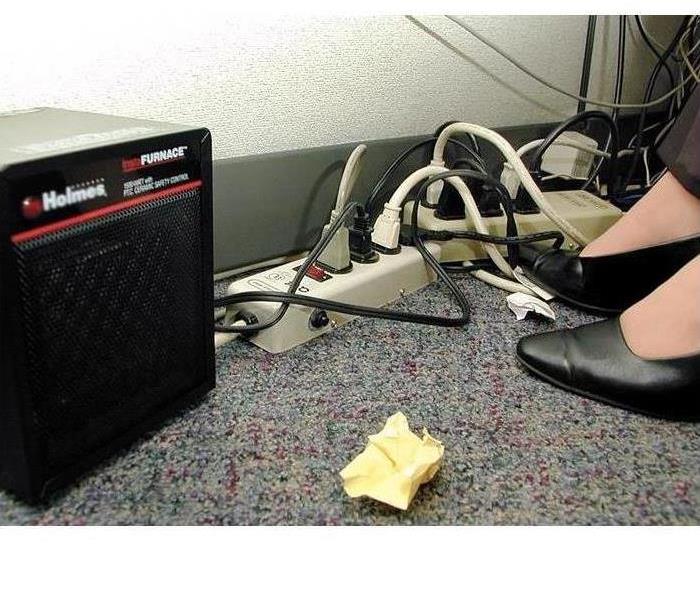 Cords Plugged into a Power Strip can Pose a Potential Fire Hazard
Cords Plugged into a Power Strip can Pose a Potential Fire Hazard
Fire is unpredictable. It can happen anytime, to any business, anywhere. 31% of office fires happen between 7pm and 7am, after hours while workers are not present. Fires occurring while employees are not present are responsible for about 67% of recorded property damage. This is because the fire went undetected for a longer period of time. Fortunately, there are a few preventative measures that anyone can take to minimize the chances of a fire happening in your business or commercial building.
According to OSHA, employers are required to perform a full maintenance check on their workplace’s fire extinguishers annually. “Maintenance” means a thorough examination, repair, or replacement as needed for all of your facility’s portable fire extinguishers, as covered in NFPA (98), Sec. 4-4.
Along with ensuring that your fire extinguishers are regularly inspected and maintained according to local fire code; a visual inspection should be conducted monthly on your fire extinguisher(s). When performing a visual inspection use the following guidelines:
- Look for obvious signs of damage including dents, corrosion, and leakage.
- Check the pressure gauge to make sure that the indicator is in the operating range.
- Make sure that the pull-pin is not missing and that the pull-pin seal is intact.
- Verify the date of the last professional maintenance inspection.
- Date and initial the tag to log the visual inspection.
Create a fire prevention plan that is in writing, posted in a highly visible area in the workplace, and available to all employees for review. If there are 10 or fewer employees, the plan may be communicated verbally. It is still highly recommended that you have a hard copy in writing. This plan should include:
- Relevant information about the building’s layout
- The building’s fire protection systems and equipment
- Emergency evacuation procedures
Ban risky appliances such as space heaters, and keep others like coffee makers and toasters away from paper and other flammables. Reduce the amount of clutter in your building or office space. Items such as boxes, piles of paper, and other flammable materials can provide fuel for a fire, especially if left near a heat source. Before plugging something in, check the cord for any damage or frayed wires. If you notice any damage to the cord or wires, replace the cord immediately or discontinue use of the item until the cord is replaced. Wires should not run under rugs or between furniture and walls; they tend to heat up, so you want them clear of any flammable items.
We understand how devastating and confusing a fire to your home or business can be. Do not hesitate to contact the experts here at SERVPRO of Media and SERVPRO of Central Delaware County to help guide you through the fire restoration process.
Choosing a Fire Extinguisher for a Home or Business
6/10/2021 (Permalink)
 Choosing a Fire Extinguisher is a Great First Step to Developing a Fire Safety Routine
Choosing a Fire Extinguisher is a Great First Step to Developing a Fire Safety Routine
Choosing a Fire Extinguisher for a Home or Business
When developing a fire safety plan for a business or home, choosing a fire extinguisher is a great place to start. It is important to learn about the different types of fire extinguishers, what they do, and how to use them.
The Classes of Fire Extinguishers
There are four classes of fire extinguishers. Each class or type is specialized to put out a specific type of fire.
- Class A: Used to extinguish fires caused by ordinary combustibles such as trash, wood, paper, and textiles.
- Class B: Used to extinguish fires caused by flammable liquids such as grease, gasoline, oil, and even paint.
- Class C: Used to extinguish fires caused by live electrical equipment. When a fire sparks from a short circuit or a kitchen appliance, the constant source of electricity continues to fuel the fire. Class C fire extinguishers contain elements that lack conductive properties, effectively preventing the fire from spreading.
- Class D: Used to extinguish fires involving combustible metals, such as magnesium, titanium, and sodium. Class D extinguishers contain an extinguishing medium that does not react with the burning metal.
Today’s most widely used and popular fire extinguisher is the multi-purpose dry chemical extinguisher, also known as ABC dry chemical. It is effective at putting out class A, B, and C fires. It is recommended to select a multi-purpose extinguisher in a size that is capable of putting out small fires, but that is not too heavy to properly handle for your residence. It is also strongly advised to have at least one fire extinguisher available on each floor of the home.
Operating a Fire Extinguisher
In addition to knowing which type of fire extinguisher would best suit your needs, it is crucial to know how to operate your fire extinguisher properly, safely, and effectively. Most fire extinguishers operate using the P.A.S.S. technique.
- Pull the pin. Hold the extinguisher nozzle away from you as you do this.
- Aim low. Always point the extinguisher nozzle (horn, or hose) at the base of the fire.
- Squeeze the lever slowly and evenly to release the extinguishing agent.
- Sweep the nozzle from side to side until the fire appears to be out, then watch the area to ensure that the fire does not reignite. If it does, repeat steps 2, 3, and 4.
Call SERVPRO of Media and SERVPRO of Central Delaware County if you are ever faced with fire damage to your home or business. We will guide you through the process and work to restore your property to make it “Like it never even happened.”
Choosing between Fire Sprinkler and Fire Suppression Systems
6/9/2021 (Permalink)
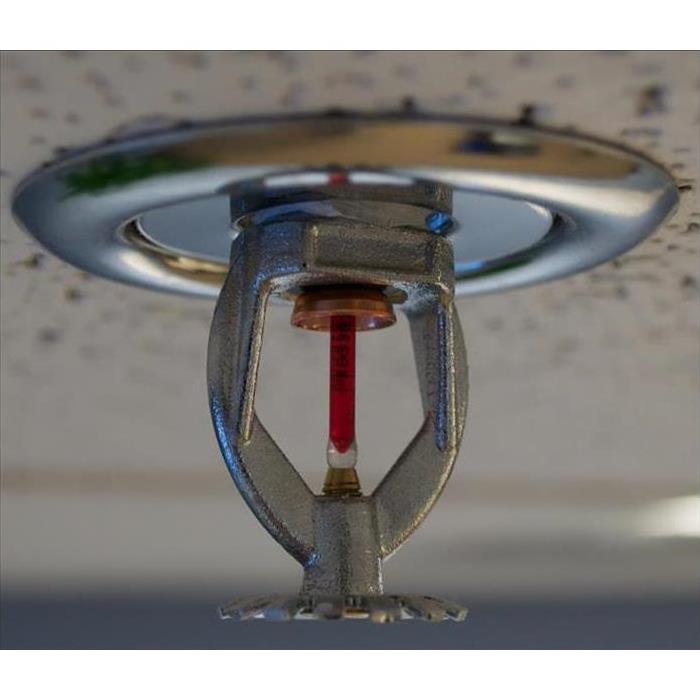 Having a Fire Sprinkler System or Fire Suppression System is Important for a Business
Having a Fire Sprinkler System or Fire Suppression System is Important for a Business
When pondering a fire taking place, most only think of the obvious; fire damage. There are many other damages that occur during, and after a fire. Smoke, soot, water, and mold damage are a few of these additional damages. Deciding between a Fire Sprinkler and a Fire Suppression System is an important decision for any business owner.
Most business facilities and commercial spaces are only protected by a pre-action fire sprinkler system. Businesses have many options, each having strengths and weaknesses. If you are considering sprinkler or suppression systems for your business or commercial space, it is important to know the difference between the two, and the different types.
Fire Sprinkler Systems
While sprinkler systems are great at containing a fire, these systems must be exposed to enough heat to warrant the release of water. The short time span between the fire starting and the sprinklers releasing water, a fire can grow substantially, resulting in increased fire damages.
Sprinkler systems have additional issues as well. When the sprinkler system releases water, it may cause substantial water damage to items such as furniture and electronics. If the water is not sufficiently dried in a timely manner, this potentially paves the way for mold growth. It is important to keep this in mind when deciding the best method of fire protection for your business.
Suppression Systems
Fire suppression systems use a combination of dry chemicals, gaseous, foam, and wet agents to suppress and prevent the spread of fire in a building. Some common types of suppression systems and agents include:
- Wet chemical fire suppression: Most commonly used in kitchens. The suppressant used is a liquid substance that when sprayed onto the affected area, and is brought in contact with cooking oils and fats, will react to produce a foam that immediately cools the flames.
- Dry chemical fire suppression: Used to quickly extinguish fires caused by flammable liquids. Most commonly used in industrial settings or areas where flammable liquids are being stored.
- FM 200 fire suppression: Requires no cleanup, leaves no residue, and is safe to use in occupied spaces. Ideal for spaces such as computer rooms, museums, libraries, and areas where other sprinkler or suppression systems may cause large amounts of damage.
If you, your business, or commercial space is dealing with damage and loss resulting from a fire, SERVPRO of Media and SERVPRO of Central Delaware County are able to respond immediately. Regardless of size or scope, we have the tools to get your business back up and running, “Like it never even happened.”
How to Avoid Expensive Water Damage Restoration Expenses
6/3/2021 (Permalink)
Blog Summary: SERVPRO of Media, PA, offers tips on how to avoid an expensive water damage restoration project.
The Media, PA, water damage restoration professionals at SERVPRO specialize in providing a fast response to water damage at any time of the day or night. Water damage disasters need immediate attention to minimize the scope of the disaster and prevent advanced secondary damage. SERVPRO of Media is highlighting tips to help homeowners prevent water damage disasters in the home.
Five Tips for Avoiding Expensive Residential Water Damage
Every ten seconds, a water damage disaster disrupts a household, causing inconvenience, stress, and worry. Listed below are five tips to prevent water damage in the home.
- Make a habit of inspecting appliances regularly
Visually inspect the base of the dishwasher for leaks every time the latch is released to open the door to the appliance. Make the same inspection of the washing machine, which is the most commonly reported source of water intrusions in the home. Include the refrigerator in the inspection process. When the door opens, look for water at the base of the appliance.
Plumbing tip: Upgrade washing machine hoses from the standard rubber hoses to reinforced stainless steel braided hoses. These heavy duty hoses can last up to ten years before needing replacement. To be proactive in keeping the laundry room dry, replace the hoses every five years.
- Perform drain maintenance
Proper drain maintenance can prevent one of the messiest water damage disasters a homeowner can experience.
- Do not put grease down the drain. Eventually, the grease will solidify and choke off the water flow, and flushing the drain with warm or hot water will not prevent a drain clog. Harsh chemicals designed to resolve slow flowing drains can damage pipes. The safest and the least expensive solution overall is to purchase and use a drain snake.
- Do not put a strain on the strainer. Clean out the strainer and put food and other debris in the garbage can or on the compost pile, not in the drain or toilet.
- Test the tub’s overflow drain to ensure it is in proper working order. Discovering the overflow drain is inoperative or leaking when the tub is overflowing can be disastrous.
- Give the sink cabinets an inspection
- Look for standing water and wet items under the cabinet.
- Listen for drips.
- Feel for moisture on items under the cabinet and around the drain and water supply lines. Feel for wetness and moisture in inaccessible areas of the cabinet.
- Perform a smell test for a musty, earthy odor in the cabinet.
- Watch the water heater
The water heater is a common source of water damage and deserves the homeowner’s attention at least once a year. Annually inspect the water heater for leaks, odd noises, rust or corrosion, and any unexplained moisture or condensation. Hard water can cause corrosion, which shortens the life of the appliance. Drain and flush the tank each year or have a qualified plumber service the unit. Replace the anode rod every three to five years, depending on the quality of water and frequency of use. The heating elements usually last about six to ten years. Replacing the heating elements at the eight-year mark means that the proactive homeowner may never miss a drop of hot water or experience an unexpected cold shower on a frosty morning. To reduce the electric bill, consider upgrading to a water heater without a tank or an on-demand water heater.
- Know where to go to stop the flow
Knowing where the shutoff valves are and keeping them in prime working condition can prevent hundreds of gallons of water from flowing into a home while the homeowner waits for a plumber or frantically searches for the valve wrench or the main shutoff valve out by the street. Knowing where the whole house shutoff valve between the meter and the house is advised as well. Usually, this valve does not require a special tool.
Proper maintenance, early detection of a water intrusion, and immediate repair can prevent most water damage disasters and minimize the damage when a water intrusion does occur. The experienced, highly trained, and certified water damage restoration professionals at SERVPRO of Media are available 24/7 and can arrive on-site in about an hour to inspect and assess the damage, provide a detailed estimate, and move forward with solutions that get life back to normal as soon as possible. The professionals at SERVPRO of Media handle the time-consuming and complicated process of dealing with the insurance company. When a property damage disaster of any size strikes, call SERVPRO of Media.
For more information about water damage restoration in Broomall, PA, contact the office by phone at (610) 566-5720 or by email at office@SERVPROmedia.com.
How SERVPRO’s Commercial Cleaning Services Keep Business Owners, Employees, and Customers Safe
6/3/2021 (Permalink)
Blog Summary: By providing viral pathogen cleaning services that meet the stringent guidelines established by the CDC, SERVPRO of Media enables local businesses and commercial facilities to stay safe and clean.
SERVPRO of Media, PA, urges businesses to continue to be proactive with commercial cleaning. Efforts to vaccinate large sectors of the U.S. population have been successfully implemented. According to NPR, “Since COVID-19 vaccine distribution began in the United States on Dec. 14, more than 225 million doses have been administered, fully vaccinating over 92.9 million people or 28% of the total U.S. population.”
Yet, businesses should not let their guard down when it comes to cleaning their commercial facility. Widespread vaccination efforts should not cause business owners to allow themselves to be lulled into a false sense of security. Instead, they should take proactive measures to ensure the health and safety of their customers and employees.
The Positive Impact of a Clean Business Environment
Employees and customers are more comfortable in a commercial facility that is clean and presents a low risk to population health. Employees are more willing to maintain consistent attendance patterns amid the ongoing pandemic if they are confident that they are less likely to contract the disease. Masking, sneeze guards, social distancing, and screening protocols also help employees overcome any anxieties. Likewise, customers and clients have a greater sense of confidence and personal security when they see employees proactively protecting the health of visitors. Safety protocols include:
- employee masking and gloving
- social distancing
- standing behind sneeze guards
- frequently disinfecting counters, shopping carts, and other high contact touchpoints
- screening procedures that require temperature checks and the completion of a brief questionnaire
Though compliance is somewhat inconvenient and time-consuming, it is necessary to help employees and patrons overcome any concerns they may have about the safety of the commercial environment.
As the economy re-opens and life incrementally returns to some degree of normalcy, employees and customers will still have questions and concerns about the ongoing safety of a commercial facility that is open to public traffic.
Achieving and Maintaining the New Standard of Clean
SERVPRO of Media understands the concerns people have about returning to brick-and-mortar locations and has ushered in a new standard of clean with its Certified: SERVPRO Cleaned program.
The team of commercial cleaning professionals at SERVPRO of Media is earnestly dedicated to increasing employee and consumer confidence in Media and the surrounding communities in pursuit of the new normal. Certified: SERVPRO Cleaned is an important tool to achieve, maintain, and validate the new standard of cleanliness everyone is expecting.
What Is Certified: SERVPRO Cleaned?
Certified: SERVPRO Cleaned is SERVPRO’s new defensive pathogen cleaning program. The innovative program is a proactive, viral pathogen cleaning approach. The state-of-the-art strategy far exceeds the cleaning practices offered by standard janitorial companies. SERVPRO has over fifty years of experience in biochemical spill remediation and decontamination. Businesses and their patrons can trust the SERVPRO of Media professionals to apply a higher standard of cleanliness.
How the Process Works: Consultation, Cleaning, Certification
The innovative, highly effective, and safe viral pathogen cleaning protocol is based on a three-step process.
Step 1: Consult
Schedule a consultation with a SERVPRO cleaning and restoration specialist. Since no two businesses are identical, SERVPRO customizes a cleaning program to the unique needs of each facility.
Step 2: Clean
Next, an expert deep clean is scheduled. The viral pathogen cleaning strategy is based on the individually tailored plan derived from the consultation. The SERVPRO technicians use only proprietary EPA-approved, hospital-grade cleaning solutions. The cleaning specialists always adhere to the highest level of cleaning and decontamination standards set by the CDC.
Step 3: Certify
Customers, clients, and employees will recognize a business that is Certified: SERVPRO Cleaned by a shield symbol that is displayed in a prominent, highly visible location on the front window of the commercial premises. This badge signifies the business’ strong commitment to the security and comfort of employees, customers, and the larger community. The Certified: SERVPRO Cleaned shield means that everyone can enter the building with confidence that the facility is clean and safe because the experts in commercial cleaning in Newtown Square, PA, have done their job.
For more information about SERVPRO of Media’s commercial cleaning services, contact the Media, PA, damage restoration and cleaning company by phone at (610) 566-5720. The team can also be reached by email at office@SERVPROmedia.com.
Why Prequalify a Property Damage Restoration Company in Media, PA?
6/3/2021 (Permalink)
Blog Summary: SERVPRO of Media explains the value of prequalifying a damage restoration company before a water, fire, smoke, or storm damage disaster disrupts life.
SERVPRO of Media, PA, recommends that homeowners prequalify a damage restoration company before disaster strikes. The following questions will help homeowners, property owners, property management companies, facility managers, business owners, municipalities, institutions, and corporations prequalify the property damage restoration company that can best meet the needs and challenges each situation presents.
A property damage disaster is disruptive and very stressful, often impeding the homeowner’s ability to think and act quickly and accurately. Identifying, calling, and prequalifying property damage restoration companies at 2:00 am in the morning when the home or business is on fire or being flooded during severe weather is not an ideal situation. When disaster strikes, knowing the one call to make and making it may be the only step the traumatized homeowner is able to take. With just one call, a team of damage restoration experts is on the scene within an hour to inspect and assess the damage and begin the cleanup and restoration process. The homeowner saves time and money and avoids unnecessary stress. The solution is in process and on the way before the customer ends the call.
What to Look For in a Property Damage Restoration Company
- Company Profile
- Is the company locally owned and operated?
- How long has the company been in business?
- Are employees hired locally?
- Is the company invested in the community?
- What is the stated mission of the company?
- What are the company’s core values?
- Is the corporate identity friendly, family-oriented, and sympathetic to the client’s felt needs at the time of the disaster?
- Is the company licensed, bonded, and insured?
- Customer Service
- Does the company offer consulting services, including helping homeowners and businesses formulate a disaster readiness response plan?
- Is the company available 24/7, anytime night or day?
- Does a real person answer the phone?
- Is the company’s web presence professional, user-friendly, informative, and engaging?
- What is the estimated response time once the initial contact is made?
- Can the company handle the insurance claim and work with the insurance company from beginning to end?
- What working relationships does the local company have with area insurance companies and their agents?
- Will the staff utilize Xactimate or other residential estimating solutions?
- Will the homeowner or business owner receive a detailed estimate before any work begins?
- Social Proof
- What is the company's Better Business Bureau (BBB) rating?
- What are customers saying about the company on social media?
- Is there a “satisfaction guaranteed” policy?
- Comprehensive Service Menu
- Does the company handle water, fire, smoke, storm, and flood damage disasters?
- Will the company handle disasters of any size?
- Is the company qualified to handle all facets of mold mitigation and remediation?
- What cleaning services does the company offer?
- What commercial services are offered?
- Are commercial cleaning services available for businesses, daycares, schools, office complexes, factories, and other facilities?
- Are cleaning services for COVID-19 available?
- Is the company able to scale for a large-loss disaster such as a hurricane, tornado, flood, or fire?
- Emergency Building Construction and Temporary Protective Services
Is the company able to provide emergency building and temporary protective services? Examples include:
- Emergency roof tarping after wind and storm damage
- Board up of windows and doors after damage from severe weather
- Temporary security fencing
- Move-out and pack-out services
- Temporary warehouse space for homes and businesses
- Repairs and Minor Building Services
Continuity of services from the initial cleanup to the completion of the restoration project is vital for cost savings, efficiency, and consistency of quality. Disruption of services unnecessarily extends the project’s length, increases overall costs, and frustrates clients and businesses who are eager to return home or get back to work creating products, providing services, and generating revenue. Disruptions in the revenue cycle hurt the business owner, employees, vendors, and customers.
Inquire about the following repairs and minor building services:
- Drywall removal and installation
- Hardwood floor repair
- Tile floor repair
- Painting
- Carpet repair and installation
- Other miscellaneous building services and reconstruction
Before prequalifying any damage restoration company, understand the capabilities of the restoration company. Can the damage restoration company handle the entire restoration process from initial damage mitigation to rebuilding the affected areas? If the fulfillment of the entire scope of work from start to finish is the expectation, then make sure the damage restoration company can meet the challenge.
- Quality of Services
- Does the company have the latest equipment?
- Is the company using the most advanced technologies for moisture detection and air quality treatment?
- Are the cleaning and restoration techniques up to date with industry standards?
- Are the cleaning solutions EPA-approved and safe for humans, pets, and the environment?
- Are technicians trained and certified by the IICRC?
- Safety on the Job
- Do technicians receive ongoing training for the proper use of the latest safety equipment?
- Does the company encourage and enforce the highest safety standards, including the use of PPE and other measures to protect service providers, occupants, pets, and visitors?
- Is safety an obvious core value of the company?
- Other Important Questions to Ask in the Pre-Qualification Process
- Does the company have a commercial disaster response division, and how many years has it been operational?
- Can the restoration company mobilize a large-loss disaster response in hours rather than days?
- Is the disaster response team able and willing to pre-stage for an anticipated natural disaster such as a hurricane, tropical storm, or wildfire? This information is critical for a large corporate client with factories, distribution centers, and suppliers huddled around a major metropolitan area that is vulnerable to hurricanes, tornadoes, flooding, heavy snowstorms, or other disruptive events.
Prequalifying a damage restoration company that can seamlessly scale from one office complex to ten office complexes is crucial if the property management company is to meet its contractual obligations to serve its customers in a timely and efficient manner. Only a handful of companies can muster such a response. SERVPRO is equipped to meet this challenge for any property management company in any large or medium-sized city in the United States.
For more information about the Media, PA, damage restoration company, contact the office by phone at (610) 566-5720 or by email at office@SERVPROmedia.com.
The Importance of Choosing a Cleaning and Restoration Company That Uses EPA-Approved Cleaning Products
5/11/2021 (Permalink)
Blog Summary: SERVPRO of Media explains why doing business with a restoration company that uses EPA-approved cleaning products is the safest option for homeowners and business owners.
As a locally owned and operated cleaning and property damage restoration company in Media, PA, SERVPRO of Media is known for putting customers first. SERVPRO is also recognized for going to great lengths to protect and preserve the environment. One of the primary ways the company promotes sustainability is by using EPA-approved cleaning solutions. Choosing a restoration company that uses EPA-approved cleaning products is the safest option for a home or business that needs cleaning services. It is also the best choice for the environment.
What is the EPA?
The Environmental Protection Agency or the EPA is an agency of the federal government and was created in 1970 by President Richard Nixon. The mission of this federal agency is to protect the health of both the population and the environment. Headquartered in Washington, D.C., the EPA has a budget of over nine billion dollars, and more than half of its 14,000 employees are scientists, engineers, and environmental protection specialists. The EPA formulates standards and enacts laws and regulations that promote the health of individuals and the environment.
What does the EPA do?
According to Investopedia, the Environmental Protection Agency has “sought to protect and conserve the natural environment and improve the health of humans by researching the effects of and mandating limits on the use of pollutants. The EPA regulates the manufacturing, processing, distribution, and use of chemicals and other pollutants. In addition, the EPA is charged with determining safe tolerance levels for chemicals and other pollutants in food, animal feed, and water.”
What does EPA-approved mean?
According to an EPA resource entitled “Identifying Greener Cleaning Products,” an EPA-approved product has been subjected to rigorous testing and evaluation. The product meets or exceeds standards set by EPA engineers and scientists and has been deemed safe for humans, pets, and the environment.
Examples of specific sustainability considerations? for EPA-approved products include:
- Contains minimal amounts of potentially harmful corrosive or strongly irritating substances
- Contains no human carcinogens or reproductive toxicants
- Contains no regulated hazardous materials or hazardous waste
- Contains no chemicals designated as HAPs (hazardous air pollutants)
- Maybe a renewable resource such as bio-based solvents from citrus, seed, vegetable, and pine oils
- Has a low VOC (Volatile Organic Compound) content
- Is biodegradable by standard methods and definitions
- Has low toxicity in aquatic species such as fish or aquatic invertebrates
- Has low flammability or flashpoint (under 200 degrees Fahrenheit)
- Has a pH closer to neutral (between 4 and 9.5)
- Is fragrance-free or meets EPA’s Safer Choice Criteria for Fragrances
How does using EPA-approved cleaners benefit SERVPRO’s customers?
The customer can be confident that when SERVPRO of Media has completed the cleaning project, the home or business is clean, safe, and healthy for humans and pets. The environment has been afforded the same protection. The air is clean. Sources of drinking water are healthy. Ecosystems are safe from toxic chemicals. SERVPRO is both a great corporate neighbor and a friend to the environment.
Why would a restoration company not use EPA- approved cleaning products?
There are no good reasons for using toxic, harsh cleaning chemicals that can leave harmful residue on surfaces that have been cleaned. Using cleaning chemicals that can harm the environment, pollute the air, and contaminate water systems is unacceptable when so many environmentally safe options are available. SERVPRO is committed to using green products that are safe and healthy for individuals and for the environment. Choosing SERVPRO of Media to provide cleaning, disinfecting, and sanitizing services is a choice for a brighter, safer, cleaner, and more sustainable future.
What are some other reasons to choose SERVPRO of Media when property damage restoration services are needed?
- 24-hour emergency service
- Faster to any size disaster
- Initial inspection with a written estimate and images
- Highly trained restoration technicians
- Continuing education classes
- Multiple restoration and cleaning certifications
- A trusted leader in the restoration industry
- Locally owned and operated
- Advanced restoration and cleaning equipment
- Handles insurance claims and payments
- Able to meet the challenges of large loss events
- Emphasis on customer service
When a property damage disaster occurs in a residential or commercial setting, SERVPRO of Media is available 24-hours a day, 365 days a year to help regain control of the situation quickly and begin the restoration process. For more information about the Newtown Square, PA, damage restoration and cleaning company, contact the SERVPRO of Media office by phone at (610) 566-5720 or email office@SERVPROmedia.com.
Why Storm Damage Preparedness Is Important for Media, PA, Residents
5/11/2021 (Permalink)
Blog Summary: SERVPRO of Media explains how homeowners can be prepared for severe weather and tornadoes in Media, PA, and Delaware County.
SERVPRO of Media, PA, urges homeowners in Media and the surrounding Delaware County area of Pennsylvania to be prepared for the heavy rains, hail, strong winds, lightning, flooding, and tornadic activity that cause serious storm damage, property loss, personal injury, and loss of life. The certified storm damage restoration professionals understand the devastating damage a tornado or severe thunderstorm can do to a home, and they provide a rapid response in order to promptly begin the storm damage restoration process.
What Makes Media, PA, So Special?
Residents know Media is a special place to live, work, go to school, worship, and enjoy family and friends. The cozy town seat of Delaware County is often described in glowing terms. In a guide to moving to and living in Media, Suburban Solutions writes, “Media, PA, a popular suburb of Philadelphia, is a town like no other. The Media nickname is Everybody’s Hometown thanks to its welcoming, close-knit community. For many, living in Media, Pennsylvania is a dream come true! The town has been named one of the best places to live in Pennsylvania thanks to its fun nightlife, great public schools, low crime, diversity, and family amenities. It’s also been ranked as one of America’s coolest suburbs. Residents love its famously walkable and charming town center with green space, bars, art galleries, movie theaters, boutiques, and more.”
Severe Weather in Media, PA
As tranquil as the region may seem, Delaware County, of which Media is the county seat, is only one county away from Pennsylvania’s most high-risk area for tornadoes, which includes York County, Lancaster County, and Dauphin County.
SERVPRO of Media emphasizes storm damage preparedness for residents of Media as tornado season approaches. Thankfully, Delaware County is a low-risk area for tornadoes. According to records, the largest tornado in the Delaware County area was an F3 tornado in 1994 that caused 11 injuries and no deaths. Though tornado risk is low, Media’s proximity to areas of higher risk makes it vulnerable to severe weather often associated with tornadic activity. Natural changes in weather patterns may also impact the frequency and severity of tornadoes in Media and the surrounding areas.
Types of Storm Damage from Severe Weather
High winds can cause property damage that mimics the effects of a tornado. Portions of the roof, including shingles and plywood sheeting, can be ripped up, exposing the attic and underlying rooms to serious water damage. Even more concerning, high winds can topple large trees onto a home, causing severe structural damage. Pennsylvania saw twenty-two confirmed tornadoes in 2019 and averages about sixteen tornadoes per year. July is usually the most active month for tornadoes.
Storm Damage Preparedness in Media, PA
Tip #1: Prepare the home for a tornado or severe weather.
Peak times for severe weather and that rare tornado are spring and early summer. July is the worst month for tornadoes. If Lancaster and York Counties are under a tornado warning, turbulent weather may visit Media and Delaware County as well. Make preparations in early spring before the bad weather hits. Some preparations may require the assistance of professionals with special equipment, training, certifications, and insurance.
- Trim diseased trees and broken limbs.
- Consider installing permanent protective shutters on windows that can be closed quickly.
- Strengthen the garage door or doors.
- Sign up to receive cell phone notifications from the local warning system or the Emergency Alert System.
- Move lawn furniture, the grill, garbage cans, and other loose debris that can blow around the yard and cause property damage.
Tip #2: Conduct a tornado/severe weather drill.
- Go to the basement or have a designated “safe room” and a set escape route.
- Stay away from windows.
- Get under a heavy table and cover with thick pillows if there is time.
- Use a mattress as a shield if there is no time to get under a table.
Tip #3: Stay safe on the road.
- If conditions warrant, park the vehicle and seek shelter in a sturdy building.
- If escape is impossible, stay in the car with the seat belt buckled. Use the hands to protect the head.
- Avoid seeking shelter under a bridge or underpass. Flying debris can cause severe bodily injury.
Tip #4: Know the difference between a tornado watch and a warning.
- A tornado watch indicates that tornadoes are possible in the area.
- A tornado warning means a tornado has been sighted, and it is time to take action by seeking appropriate shelter.
Tip #5: Prepare an emergency survival kit and keep it in an accessible location.
Be aware that a large severe weather cell can do more damage than a localized tornado. An all-purpose emergency survival kit should have the following items.
- One gallon of water per person in the household per day for at least three days
- Enough food for each person for three days
- A battery-powered or hand-crank radio, as well as a NOAA weather radio, to stay informed about weather updates
- A flashlight, batteries, first aid supplies, and local maps
Tip #6: Know what should not be done during a tornado or severe weather.
If severe weather or a tornado is in the area, do not go outside to check the weather or look for a potential tornado. Opening windows to equalize air pressure is a myth. Seek shelter in an interior room on the lowest level of the home. Use a flashlight instead of candles if the power goes out.
Tip #7: Inspect the home for damage after the tornado or severe weather has passed.
Wait until the weather authorities give the “all clear” to venture outside the structure. Inspect the home’s exterior, the roof, trees, powerlines, vehicles, and other property. Downed power lines pose a real danger of electrocution.
By following these simple tips on what to do before, during, and after severe weather or a tornado, homeowners, as well as their family, friends, and neighbors, can be better prepared when inclement weather or a rare tornado is in the Media and Delaware County area.
When storm damage strikes, be prepared to call the industry leader in water, storm, and flood damage restoration, SERVPRO of Media. They are available 24/7 and can arrive at the damaged property in about an hour to start the storm damage restoration process, beginning with emergency tarping if needed.
For more information about storm damage restoration in Media, PA, contact SERVPRO of Media by phone at (610) 566-5720 or by email at office@SERVPROmedia.com.
A Guide to Spring Fire Hazards and Fire Safety Tips for the Spring Cleaning Checklist
5/11/2021 (Permalink)
Blog Summary: SERVPRO of Media warns homeowners about spring fire safety hazards and shares fire safety tips for springtime.
Nearly three decades ago, SERVPRO of Media, PA, embraced the challenge of helping homeowners and business owners reconstruct their lives and businesses after fire damage in Media, PA. Homeowners experience a heightened awareness of the importance of fire safety during the cold months of winter. A roaring fire in the fireplace, space heaters in practically every room, seasonal and decorative candles throughout the home, and the annual tangle of Christmas lights and extension cords are constant reminders of the need to exercise fire safety measures.
The warmer months and longer days of spring require no less vigilance. The transition from cozy indoor holiday festivities to backyard barbecues does not mean that less attention needs to be paid to fire safety. Rather, the focus shifts to other important areas.
Festive and Decorative Candles
Decorative and aromatic candles are a festive favorite. Whether the event is a candlelit Easter celebration, Sunday lunch, or a cheery spring gathering with friends, the fireplace mantle, end tables, side tables, and wall sconces are often filled with gently flickering candles.
When decorating with candles, remember to abide by proper fire safety. Lit candles should never be left unattended under any circumstance. Broken candleholders and damaged candles are dangerous and should be discarded. Any greenery remaining from Christmas decorations is dry and will be quick to ignite if exposed to a spark or flame. Remove dead, dried decorations before they become kindling for a house fire.
Memorial Day Celebrations
Memorial Day signals a shift from spring to summer and brings with it campfires, backyard bonfires, marshmallows, and, in some municipalities, fireworks. However, a single spark can ignite an entire forest resulting in massive fire damage and property loss. Penalties for violation of local fire ordinances can result in fines and jail time. Persons who cause a fire resulting in property damage are liable for damages and may also be responsible for the expense of extinguishing the blaze. In any case, be careful and know the local ordinances.
Grill Safety
Outdoor grilling has skyrocketed in popularity due to the pandemic, and this popularity will likely continue even with the lockdown restrictions being lifted. In fact, now that more states and counties are allowing larger gatherings, the grill may become an even greater hub of activity and community.
However, grills and fire are inseparable. The risk is unavoidable. According to the National Fire Protection Association, an average of nearly 9,000 home fires are caused by grilling activities each year. Gas grills cause more fires than charcoal grills. To keep the home and family safe, homeowners should follow the grill safety tips listed below.
- Inspect the grill thoroughly before each cooking session. Only a few minutes are required to check the propane tank, the hose, and all connections.
- Only use charcoal lighter fluid to start a charcoal fire. Other accelerants can cause a flash explosion that can quickly spread to anything flammable nearby.
- Clean grills are safe grills. Twenty percent of all grill structure fires are linked to greasy, grimy grills.
- Position the grill at least ten feet away from anything flammable, including plants, mulch, paper products, vehicles, wood, or lawn and deck furniture.
Outdoor Fire Pits
Safety precautions for an outdoor fire pit are similar to the regulations for a grill. Flames in a fire pit should be kept low. Once the fire has become established, keep the spark screen in place. Depending on local ordinances, the pit should be kept ten to fifteen feet away from any structure. Watch out for overhanging branches. Inspect the fire pit for spots that have rusted out and can drop embers under the unit, damaging the deck or causing a fire. Other basic fire safety tips include:
- Young children should be supervised by adults at all times when the fire pit is a part of family activities.
- Place a bucket of water near the fire pit before igniting the fire.
- Many borough fire ordinances prohibit burning leaves, sticks, pinecones, pine needles, and paper in the fire pit because of sparks and large flames. Generally, flames are limited to two feet in height.
- Toast marshmallows over the embers rather than the flames. A fiery marshmallow can ignite clothing, hair, and dry brush and leaves. The fiery projectile can cause serious burns to the skin, eyes, and mouth.
Some counties and boroughs are requiring a permit for a backyard bonfire or fire pit. Know the local fire ordinances. Contact the fire department for specific information about relevant ordinances, or visit the county’s website for more information.
Spring Cleaning Fire Safety Tips
While spring is in the air and spring cleaning is on the mind, homeowners can improve fire safety in the home by adding fire safety precautions to their spring cleaning checklist.
Tip #1: Clean the chimney during the spring so that the fireplace will be ready for the cold fall weather and any early snows.
Tip #2: Test smoke alarms and replace the batteries.
Tip #3: Clean out the dryer vent pipe. The United States Fire Association reports that clothes dryers are responsible for nearly 3,000 house fires annually and cause 35 million dollars in damages. Remember to clean the lint trap after every load and keep the lint trap clean to reduce buildup in the dryer.
Tip #4: Identify a fire damage restoration specialist to call in the event of fire damage. A house fire is a traumatic situation, and smoke inhalation, adrenalin, and the chaos of the situation often override the senses. Knowing exactly which company to call means that a fire damage restoration company in Broomall, PA, such as SERVPRO of Media, can be on the scene in about an hour or less to inspect the situation and begin the restoration process.
For more information, contact the office by phone at (610) 566-5720 or by email at office@SERVPROmedia.com.
The Seven Steps of a Typical Fire Damage Restoration for Homeowners
4/29/2021 (Permalink)
Blog Summary: Fire damage restoration services are often necessary to bring the house back to its original condition after a fire. SERVPRO of Media, PA, explains what the process entails for professional fire damage restoration.
The aftermath of a house fire can be overwhelming, but homeowners can relax under the care of professional fire damage restoration companies, like SERVPRO of Media, PA. What is fire damage restoration, and how can the process alleviate the stress and inconvenience after a fire at home? The SERVPRO professionals discuss more details below.
What Is Fire Damage Restoration?
In Pennsylvania, the leading cause of housefires is distracted cooking. Within 24 to 48 hours after firefighters extinguish the flames, it will become obvious why fire damage restoration is vital. The homeowner will notice aspects like the water damage from the firefighting efforts, extensive smoke damage, acidic soot, and many other unhealthy elements that appear after a fire.
Contacting a professional fire damage restoration service early is the best decision. Companies like SERVPRO will take care of the property and bring it back to its pre-fire condition as quickly as possible.
Seven Steps For a Professional Fire Damage Restoration Process
Every home receiving fire damage restoration services will have unique solutions, but most situations will include these seven steps:
1. Emergency Call-Out
Within a day or two of the fire, the homeowner should contact a reputable fire damage restoration company like SERVPRO of Media, PA. They will respond to the scene immediately, inquiring about the event to gain better insight and planning the details for the team, equipment, and resources to restore the property. SERVPRO of Media, Pennsylvania, offers unmatched fire damage restoration services from highly-trained technicians.
2. Fire Assessment
When the technicians arrive, they will evaluate the property and make sure it’s safe to enter the premises. The trained personnel look for signs of structural damage outside before proceeding indoors, and it would be risky for anybody else to enter the site without their approval, including the homeowner. The restoration professionals will also note the extent of the damage from soot, fire, smoke, and water, using the information to create a cleanup plan.
3. Board-Up and Roof-Tarp Services
If the fire damage compromises the roof, walls, or windows, the technician will use boards and tarps in response. Roof tarps protect damaged roofs from additional water damage if it rains. The boards will improve the home’s security if windows are broken or missing.
4. Water Removal Services
When firefighters use water to extinguish flames, water damage restoration is a necessity. Standing water is unhealthy and might lead to excessive mold growth. The technicians will remove the moisture and use professional-grade air movers and dehumidifiers to dry flooring, drywalls, and furniture.
5. Smoke and Soot Removal
After the water dries, fire damage restoration professionals will use high-quality equipment and time-tested techniques to eliminate smoke and soot traces from all the home’s surfaces. Soot discolors grout, carpets, wood, textiles, and metals, so removal is crucial.
6. House Cleaning and Sanitizing
The restoration team will then move to clean and disinfect salvageable items and structures within the home. These professionals also use industrial fogging equipment and air scrubbers to eliminate smoky odors as they go.
7. Fire Damage Restoration Results
The last step is the complete restoration of the home to its original condition. The extensive process may include minor repairs, painting, flooring installation, and more. SERVPRO of Media, PA, is one source of reliable water and fire damage restoration in Broomall and the surrounding area, and their highly trained team uses specialized equipment to respond to disasters of any scope.
The SERVPRO team offers 24-hour emergency service and guides clients through each step of the process. Request service at (610) 566-5720 or follow them on Facebook to receive up-to-date company news. They operate from their office at 119 Springfield Avenue, Folsom, PA 19033.
A Leading Commercial Damage Restoration Company Offers Tips for Preventing Water Damage
4/29/2021 (Permalink)
Blog Summary: SERVPRO specializes in cleaning and commercial damage restoration. Their experts in the field discuss common causes of water damage, providing practical tips for prevention and professional assistance.
Commercial damage restoration is often a necessity after nightmare flooding or other water damage stops normal business operations in Broomall, PA. Disasters destroy inventory and equipment and leave unsightly stains that could tarnish the brand image. The effects of water damage also remain long after the incident, and businesses need to be proactive in using services like SERVPRO.
Top Causes of Commercial Water Damage, Restoration Advice, and Prevention Tips
There are five common reasons a business might need to seek commercial damage restoration for water damage disasters in Broomall, PA:
#1 Check Burst or Leaking Pipes
Deteriorating pipes cause catastrophic damage in a surprisingly short time. Pipes are usually hidden, so a commercial property owner may not notice the damage until the issues are widespread. Proactive measures may prevent burst pipes, including:
- avoiding corrosive drain cleaners,
- keeping corrosive materials out of drains, and
- maintaining the pipes above freezing point during the winter months.
Professionals like SERVPRO of Media, PA, are well-equipped to handle the most pervasive water damage, whether from burst or leaking pipes, mold damage, or rot.
#2 Anticipate Hurricanes, Cyclones, and Storms
Hurricanes and other storms contribute hundreds of billions of dollars to commercial water damage in the United States each year. The loss of power and sewage utilities during severe storms further complicates restoration efforts. SERVPRO of Media, PA, provides decades of experience with hurricane recovery efforts, including extensive restoration services in the aftermath of Hurricanes Katrina and Ike.
Some hurricane damage is inevitable, but there are a few measures that might help. For example, boarding up windows and surrounding the property with a sandbag wall are great ideas in advance of a storm. It could protect the business from windborne water damage and flooding that could save thousands in repairs.
#3 Act Quickly for Flooding
Floods cause devastating damage in addition to the issues that the hurricane storm surge brings. The flooding exposes newly underwater areas to sewage, toxic chemicals, and other forms of waste and diseases that breed in standing water. Waterlogged wood and drywall rot while damp conditions also facilitate mold that can cause health effects to employees and customers.
Sandbags and basement waterproofing offer some protection against flooding, but it depends on the extent of the water surge. If in doubt, it’s best to contact certified SERVPRO technicians to remove this hazardous waste and dispose of it safely as part of responsible commercial damage restoration services.
#4 Assess Fire Damage Accurately
Imagining a fire striking a business isn’t pleasant, and business owners often miss the indirect damages in their calculations of how to respond. For example, the water damage from efforts to extinguish the fire can be just as extensive as what the blaze destroys. The best way to prevent fire damage is to eliminate fire risks whenever possible and install an early warning system.
#5 Look for Roof Leakage
A leaky roof can be a silent and insidious source of water damage causing rot and mold in attics and infiltrating spaces between walls. It is important to inspect the roof with periodic maintenance and fix signs of damage immediately. If collapse seems imminent, call commercial restoration services like SERVPRO for more information and advice.
#6 Call the Professionals
SERVPRO of Media is a leading commercial damage restoration company with over 1,700 franchises nationwide. Their experienced technicians have seen disasters on the scale of hurricanes Katrina and Ike, and they are happy to bring the same standards of quality and professionalism to Broomall, PA, and the surrounding communities.
Learn more about SERVPRO of Media, PA, by visiting Facebook or calling 610-566-5720 today. They operate from their offices at 119 Springfield Avenue, Folsom, PA 19033.
Why Water Damage Restoration Is Not a DIY Job
4/29/2021 (Permalink)
Blog Summary: The SERVPRO professionals provide Central Delaware County residents with six reasons why they are better off letting a professional handle their water damage restoration projects.
Indoor flooding occurs for many reasons, including faulty plumbing and extreme weather. Regardless of what caused it, the property needs quick attention, effective drying, and thorough cleaning to prevent lasting structural damage. The best solution is professional water damage restoration from companies like SERVPRO.
Six Great Reasons to Leave The Water Damage Restoration Project to Insured Professionals
Attempting to DIY the cleanup of a flooded property may seem like a more cost-effective solution, but there are several risks. The SERVPRO experts offer these six compelling reasons why homeowners and businesses should only let certified experts handle their water damage restoration in Newtown Square, PA.
Professionals Know How to Avoid Filthy Wastewater
Indoor pooling caused by a toilet malfunction or drainpipe comes with several biohazards. Trying to clean the mess without proper protective gear puts a homeowner at great risk of sickness and contamination. For instance, wastewater contains bacteria, viruses, and protozoa that cause gastroenteritis, Hepatitis A, and other ailments.
SERVPRO adheres to the strictest OSHA and EPA standards when performing water damage restoration tasks. The company’s safety protocols keep clients and staff out of harm’s way.
Professionals Have Skills To Speed Up The Restoration
Licensed water damage specialists like SERVPRO know the best solutions for all types of water damage. For instance, they can identify if the water-damaged drywall or ceiling is repairable or requires a replacement. An expert like SERVPRO also knows how to dry a flooded property quickly, reducing the risk of mold growth.
A company also has special training and the right equipment. Homeowners will see immediate results as professionals like SERVPRO clean and restore waterlogged carpets, furniture, and other items.
Professionals Use Proper Equipment Daily
Professional water damage repair companies also have equipment for detecting excess moisture. It ensures the eradication of all damp spots on the property that may otherwise trigger a mold or pest problem.
Most non-professionals don’t have these pieces of equipment, and undetected moisture remains trapped within walls and flooring. It causes extensive property damage and invites infestation. Besides moisture meters, SERVPRO uses industrial-grade dryers and advanced cleanup equipment to ensure a completely restored interior.
Professionals Spot Issues Quickly
Standing water rots floors, walls, ceilings, and other parts of a building’s structure. Without proper drying, the structure will continue to weaken, making it unsafe. It may also require expensive renovations as its components degrade.
Drying and proper disinfection ensure that toxic mold cannot survive. If mold or mildew growth from the water damage is already widespread, professionals like SERVPRO offer comprehensive mold remediation services. The company’s technicians know all the hidden places to search for potential mold growth and ensure that the property is safe.
Professionals Help to Validate Insurance Prospects
Most insurance companies won’t accept a claim for water damage restoration unless the property owner shows proof of a professional cleanup. SERVPRO provides all its customers with the necessary documentation and can manage the insurance paperwork and process where necessary.
Professionals Know the Risks
Electrical outlets and systems exposed to flood water can lead to electrocution and indoor fires. Trying to restore a water-damaged property without considering this danger is unwise. Careless movement or connection with electrical elements in contact with water may even be fatal.
SERVPRO technicians know how to navigate such risks and ensure the safety of everyone within the flooded building.
SERVPRO provides 24/7 emergency water damage restoration to homes and businesses all over Newtown Square, PA, and other parts of Central Delaware County. The company relies on scientific drying principles to satisfy its customers’ needs and guarantee effective water damage restoration. Contact SERVPRO today at (610) 566-5720 to schedule services.
Commercial Viral Disinfection Services
4/5/2021 (Permalink)
 We are Here to Help you with your Pandemic Viral Disinfection Needs
We are Here to Help you with your Pandemic Viral Disinfection Needs
SERVPRO of Media utilizes EPA-registered antimicrobial disinfectants to proactively clean for viruses such as SARS Co-V-2 on the EPA “List N”. These antimicrobial disinfectants can be applied using a spray or wipe application. SERVPRO’s full line of virucides have been created using CDC and EPA approved processes and guidelines to keep you, your family, your business and the community safe.
The CDC recommends using EPA-registered disinfectants when an area has been exposed to emerging viral pathogens, according to label directions. Each EPA-registered disinfectant has a length of contact time where the surface must remain wet with the disinfectant, also known as dwell time, prior to wiping, rinsing or drying.
As the number of pandemic viral cases increase, many commercial clients are faced with having a customer or employee at their facility with a confirmed case of SARS Co—V 2. It is important that CDC approved disinfection processes, with EPA registered disinfectants, are used to reduce the risks associated with the spreading pandemic.
SERVPRO has the proper protocols in place to deal with the pandemic virus’ effect on your business. Call the professionals. Locally owned and operated, SERVPRO of Media and Central Delaware County is here to help you through the pandemic. We look forward to assisting local businesses stay open and stay safe.
PROPER DISPOSAL OF BIOHAZARDOUS MATERIALS
4/5/2021 (Permalink)
 Technician disinfecting surfaces affected by bloodborne pathogens.
Technician disinfecting surfaces affected by bloodborne pathogens.
Most people do not realize how much biohazardous waste we encounter every day. Your hospital, doctor and dentist office has it, but did you know that biohazardous waste can exist anywhere? Whether biohazardous waste is found in a medical office or at a crime scene, a suicide, or an accident, or other trauma, there are protocols that need to be followed when disposing of biohazardous waste and bloodborne pathogens.
What is defined as biohazardous materials?
Biohazardous waste is any material that contains or has been contaminated by a biohazardous agent. Biological waste may include animal waste, cultures and stocks, human blood, blood products, tissues, cell lines and body fluids, human pathological waste, recombinant DNA, infectious agents, isolation waste and sharps and all other items affected with bloodborne pathogens.
Biohazard disposal guidelines are regulated within each state, but can include:
- Disposal of syringes and other sharps in a biohazard sharps container.
- Disposal of culture dishes and pipets in biohazard bags and hard-sided leak proof containers that are labeled with the biohazard symbol.
- The use of PPE such as gowns, gloves, and goggles while disposing of biohazardous waste.
- Job-specific OSHA training.
Contact SERVPRO of Media for all of your biohazardous remediation needs. We are Here to Help, 24/7/365. We are here getting things back to normal for clients in Media and Newtown Square and the surrounding areas. Call us at 610-566-5720.
Do I have Mold?
4/5/2021 (Permalink)
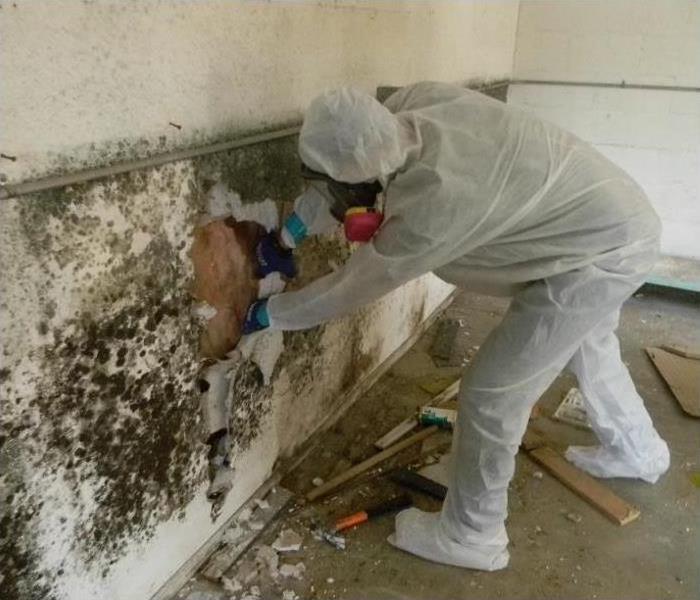 Call your trusted Mold Remediation professionals in Media, PA and Newtown Square, PA. We are here to help you make it "Like it never even happened."
Call your trusted Mold Remediation professionals in Media, PA and Newtown Square, PA. We are here to help you make it "Like it never even happened."
When water penetrates into your home or business, mold growth can start in as soon as 48 hours. Consider the following mold facts:
- Mold is EVERYWHERE! Indoors and outdoors. But how much is indoors and outdoors are the two most important thing to know when determining what you have to do about it.
- Mold spores are microscopic and cannot be seen with the human eye. They float in the air and can enter your home through open windows and doors, or AC/heating systems or attach to your clothing or a pet to get inside your home.
- Mold spores LOVE moisture. Mold spores quickly grow into colonies when exposed to moisture. These colonies may produce allergens and irritants and have the potential to cause other health effects.
- Before we can begin mold remediation, all sources of moisture penetrating the structure must be addressed, or the mold may reoccur post remediation.
- Mold often produces a strong, mildew odor, and that smell can create problems for your indoor air quality and can limit you from enjoying your home.
- Higher-than-normal indoor humidity can perpetuate consistent mold growth. Keep indoor humidity below 45 percent through using consistent dehumidification.
- Change air filters in your HVAC units to prevent transference of mold spores through your home through the ducts of your HVAC system.
Should you need SERVPRO of Media for your mold remediation needs. We are here to help. We've been making it "Like it never even happened," for 28 years and counting in Delaware County, PA.
Call the professionals. We are available through 365 days a year 24/7.
SERVPRO of Media - 610-566-5720.
Water Damage? We have your back!
4/5/2021 (Permalink)
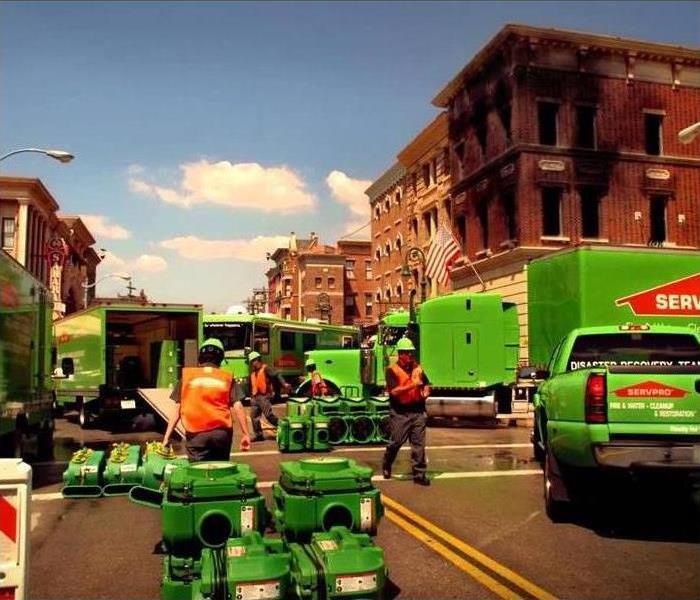 We have your water damages covered!
We have your water damages covered!
Water damage is stressful, but it doesn't have to be. When you have your home and business insured properly, and SERVPRO of Media in your back pocket ready when disaster strikes, you're going to be back together in no time.
We handle all types of water damages. Frozen and broken pipe leaks, sewer line cracks and leaks, sump pump failures, sewer backups, toilet overflows, water supply line breaks. Any water damage that will affect the interior of your home or business SERVPRO of Media can handle.
We have all the necessary equipment to handle any job, large or small. Trust our highly trained technicians to use our state-of-the-art tools to find the water that's lurking behind your walls and ceilings and below your floors. We have thermal imaging cameras, moisture scopes, an probes that can get behind with minimal damage and see if water has penetrated the structure.
Our franchise has been servicing clients in Delaware County, in particular Media, Wallingford and Newtown Square for almost three decades.
We know that there are others who provides similar services to us, but no one does it with this much skill and training as a SERVPRO Franchise. We provide excellent customer service, support and workmanship to get your home back to normal. Call us today , SERVPRO of Media is here to help you – 610-566-5720.
7 Tips for Homeowners Who Need to Hire a Storm Damage Restoration Contractor
3/17/2021 (Permalink)
Blog Summary: The professionals at SERVPRO offer seven tips to help homeowners understand how to hire the best storm damage restoration contractor.
Dealing with damage in the aftermath of a storm can be stressful, and the help of the right storm damage restoration company can be invaluable. However, the process of hiring a contractor can be just as overwhelming as the restoration process. The experts at SERVPRO of Media are here to help with seven tips for hiring a storm damage restoration contractor.
SERVPRO of Media has almost three decades of experience in storm damage restoration and cleanup. They serve all of Media and Broomall, PA, as well as the surrounding communities. With the resources of a nationwide franchise on hand and highly trained and experienced specialists, they offer superior service and results.
7 Tips for Hiring a Storm Damage Restoration Contractor
#1: Look for a Contractor With an Emergency Response Team
Storms don’t happen during business hours, so when one hits, homeowners need a storm damage restoration contractor who is on call 24 hours a day, 7 days a week.
#2: Verify the Restoration Will Start Very Quickly
Coming out on emergency calls is a good start, but storm damage restoration needs to begin as quickly as possible. Verify the contractor will be completing the entire restoration process now, not next week. Delaying restoration efforts can lead to secondary damage, such as mold.
#3: Choose a Contractor With the Right Tools for the Job
Storm restoration damage can involve several different elements. The best contractors can deal with all of them, from roof repairs to pumping out the basement. The contractor should also be able to coordinate all these services effectively and quickly.
#4: Research the Contractor's Reputation
Satisfied customers are the greatest indication that a storm damage restoration contractor will do a good job. Check out testimonials from former customers before choosing a company.
#5: Make Sure the Contractor is Licensed and Good Accreditations
Many of the tasks involved in storm damage restoration require licenses. It is important to make sure the company has the right credentials. Details should be on the company’s website. Their site should also include information about accreditations, which are also an important indicator of the company’s abilities.
#6: Ask If the Contractor Helps With Insurance Claims
Storm damage restoration can be very expensive, and the insurance claims process is daunting for many homeowners. An expert storm damage restoration contractor understands how to file claims and should be willing to help ensure nothing is missed that could result in a claim denial.
#7: Opt for a Contractor That Uses High-Quality Equipment and Materials
Many storm damage restoration contractors have favorite brands they use in restoration projects. Before hiring a contractor, find out what equipment and materials they work with and make sure they are high quality.
About SERVPRO
SERVPRO has helped homeowners in Broomall, PA, and the surrounding neighborhoods for 27 years and has an excellent reputation for quality work and friendly service. Their highly-trained specialists are up to date on the latest storm damage restoration techniques and available 24-7.
For more information about storm damage restoration, contact SERVPRO at (610) 566-5720 or follow them on Facebook for more helpful tips.
Contact Information:
SERVPRO of Media
SERVPRO of Central Delaware County
119 Springfield Avenue
Folsom, PA 19033
www.SERVPROmedia.com/
Why It Is Important to Hire an Expert Water Damage Restoration Company
3/17/2021 (Permalink)
Blog Summary: The experts at SERVPRO of Media, PA, offer five points that highlight the importance of hiring an expert water damage restoration company.
Many home and business owners explore the idea of attempting to deal with water damage on their own, especially if their insurance won't cover the damage. However, DIY water restoration is never a good idea. The experts at SERVPRO of Media are here to explain why.
SERVPRO of Media, PA, has 27 years of experience in water damage restoration and cleanup. With highly-trained specialists and the resources of a national franchise, their team understands what it takes to fully restore a home or business after water damage.
5 Reasons to Choose an Expert to Restore a Home or Business After Water Damage
#1: Speed
Water can do an impressive amount of damage very quickly, but it also will continue to do damage until the space is fully dry. Water damage restoration specialists respond to emergencies quickly and get started with the crucial work of pumping, drying, and cleaning immediately. Their tools are specifically designed to remove water and reduce humidity levels fast.
This greatly reduces the risk of secondary damage like rot and mold. Water cleanup and restoration professionals also arrive as an emergency as a team. The advantage of many experienced hands and the right equipment offer a speed advantage that DIY methods can’t match.
#2: Safety
Just because the damage isn't visible doesn’t mean it is not there. After a water emergency, mold can grow. Mold can grow anywhere, including out of sight. Experts in water damage restoration know what to look for, spotting signs of mold that probably go unnoticed by the average home or business owner.
Likewise, a professional should always remove mold as it causes health effects. Professionals use special equipment to remove mold and mold spores, leaving the property safe and preventing future growth.
#3: Cost
Water damage is not just destructive—it can also be expensive. The longer the water sits, the greater and more expensive the damage becomes. Hiring a water damage restoration expert can be the difference between minor restorations, such as repainting, and major rebuilding. In almost every case, it will save money in the long-run.
#4: Advice
Understanding the extent of water damage and the necessary steps for restoration is very difficult without extensive training. It takes years of experience to understand what is worth salvaging and how best to restore things that aren’t. A professional can offer that expertise.
#5: Insurance Claims
An experienced water restoration specialist not only understands how best to mitigate water damage to a property, but they also know how to lessen the cost of that process. By helping clients deal with insurance companies, experts in water damage restoration can help maximize claim payouts and minimize expenses.
About SERVPRO of Media
With almost three decades of experience helping home and business owners in Media, PA, and the surrounding areas, SERVPRO of Media has built a reputation for quality work and friendly service. Their specialists are up to date on the latest water restoration techniques and use only the highest quality materials in the restoration process.
For more information about water restoration in Media, PA, call SERVPRO at (610) 566-5720 or contact them on Facebook.
Contact Information:
SERVPRO of Media
SERVPRO of Central Delaware County
119 Springfield Avenue
Folsom, PA 19033
www.SERVPROmedia.com/
Top 6 Facts and Tips for Business Owners Who Need Commercial Water Damage Restoration
3/17/2021 (Permalink)
Blog Summary: SERVPRO’s specialists share tips and facts to help Newton Square business owners better understand the commercial water damage restoration process.
From small mom-and-pop shops to major corporations, for businesses, downtime is lost revenue—and water damage can lead to significant downtime if handled incorrectly. The experts at SERVPRO of Media are here to share some facts and tips about commercial water damage restoration to ensure business owners know what to expect during the process.
SERVPRO of Media has over 27 years of experience in the commercial water damage restoration industry. Their experts offer business owners in Media, Newtown Square, and the surrounding area cost-effective water damage removal, mold remediation, and more.
Top 6 Commercial Water Damage Restoration Facts and Tips for Business Owners
#1: Watch Out For Mold
After water enters a commercial building, the risk of mold grows exponentially as time passes. It can establish a foothold in as little as 24 hours. To avoid this and other costly damage it would involve, it’s vital to hire a restoration company as soon as possible.
#2: Beware of Contamination
After water damage, there are different categories of contamination. Depending on whether the property was flooded with white water from sinks and other pipes carrying potable water, grey water that could carry chemicals or solvents, or black water from sewers, the clean-up process will be different. The “darker” the water source, the quicker the clean-up must be done for health reasons.
#3: Drying the Property Isn’t the End of the Problem
Some business owners assume if the area dries out, the problem is over. Unfortunately, that’s far from the truth. Moisture is persistent and can linger on surfaces, leading to mold growth and decay. The dehumidification and water damage mitigation process is just as vital as water removal.
#4: Drying and Restoring a Building is Not One Size Fits All
Different surfaces and construction materials require different drying and restoration techniques. Some more durable materials can often be saved while others deep cleaning and some, such as some insulation and flooring, will need to be removed from the property and replaced after the drying process is complete.
#5: Filing an Insurance Claim Quickly is Essential
To make sure the insurance claim is handled properly and full compensation is received, be sure to file an insurance claim as soon as possible following water damage. A good commercial property water damage contractor should be able to help with this.
#6: Good Maintenance of a Commercial Property is Money Well Spent
Regular inspections and repairs are essential for commercial properties and can often stop water damage before it starts. The roof, gutters, and interior plumbing should be kept in excellent condition. Doing so almost always saves money in the long-run.
About SERVPRO
SERVPRO of Media has served all of Newtown Square, PA, and the surrounding areas for nearly three decades. Their attention to detail and friendly service have earned them an excellent reputation in the community. The SERVPRO team provides business owners with the support they need through every step of the commercial property water damage restoration process.
In an emergency, call (610) 566-5720, 24 hours a day, 7 days a week, or visit SERVPRO on Facebook for more information about their services.
Contact Information:
SERVPRO of Media
SERVPRO of Central Delaware County
119 Springfield Avenue
Folsom, PA 19033
www.SERVPROmedia.com/
It's puffback season!
11/23/2020 (Permalink)
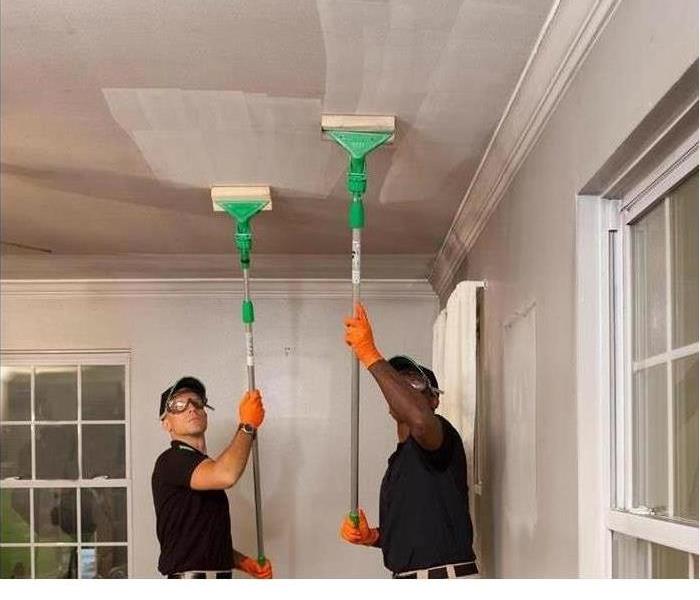 SERVPRO technicians have the right equipment and training to clean your home in the event of a puffback.
SERVPRO technicians have the right equipment and training to clean your home in the event of a puffback.
It's that time of the year again! The smell of pumpkin spice and apple pie is everywhere! Families are planning for Thanksgiving dinner. As the days get shorter and the nights get colder, people are lighting fires in their fireplaces and turning on their heaters. It's also the time of year for puffbacks.
Puffbacks occur in an oil or gas heater when a boiler or furnace misfires, causing an explosion of unburned fuel in the combustion chamber. They can send an oily, smelly film throughout the home, covering walls, ceilings, carpets, furniture, and curtains. The soot can get into closets, and even drawers! Because the soot is petroleum based, the odor can be horrible and can be very difficult to clean. Cleanup is best left to the professionals. Attempting to clean it on your own can make the situation worse.
To prevent a puffback, have your heater cleaned and serviced at least once a year by a qualified technician and replace the filters regularly. Make note of any unusual sounds or odors. If you have experienced a puffback, call your HVAC professional immediately to have your heater cleaned and repaired, then contact SERVPRO of Media to begin the cleaning process. We can make it “Like it never even happened.”
Preventing Cooking Fires
10/23/2020 (Permalink)
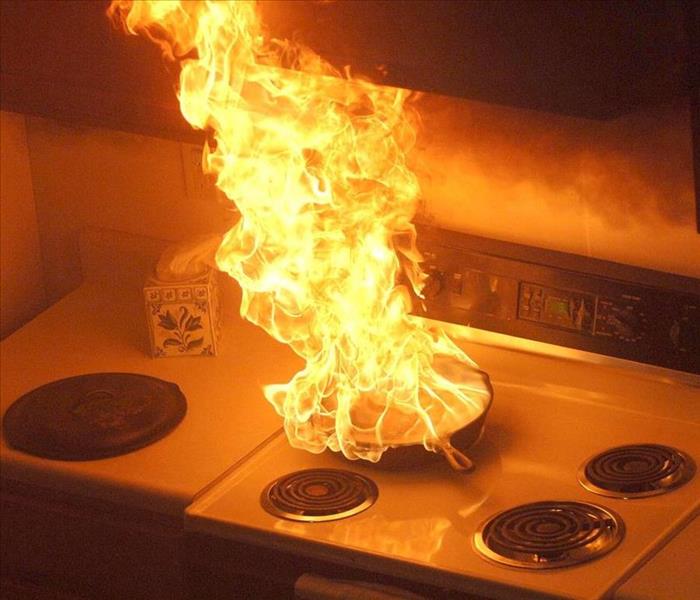 Kitchen fires can get out of control quickly.
Kitchen fires can get out of control quickly.
According to the National Fire Protection Association (NFPA) in a July 2020 report, fire departments in the United States responded to an average of 172,900 home structure fires per year caused by cooking from 2014 to 2018. According to this report, these fires resulted in an average of 550 deaths, 4820 injuries and over $1 billion in property damage per year!
As we approach the holiday season, it is important to take proper safety precautions to prevent these fires from happening in the first place.
Never leave cooking unattended.
Supervise young children and pets in the kitchen, especially around the stove.
Be extra cautious when placing anything on the stove, especially combustible items such as towels, as stove tops can remain hot enough, or they can be ignited by a gas pilot and cause a fire well after the burners are turned off.
Check the oven prior to turning it on.
Be careful of loose fitting clothing and long sleeves that can catch fire.
Have a fire extinguisher readily available in case of an emergency.
Keep stovetops and ovens clean.
To learn more about kitchen fires and fire prevention, check out nfpa.org for more information.
Will you be ruined or will you be ready?
10/23/2020 (Permalink)
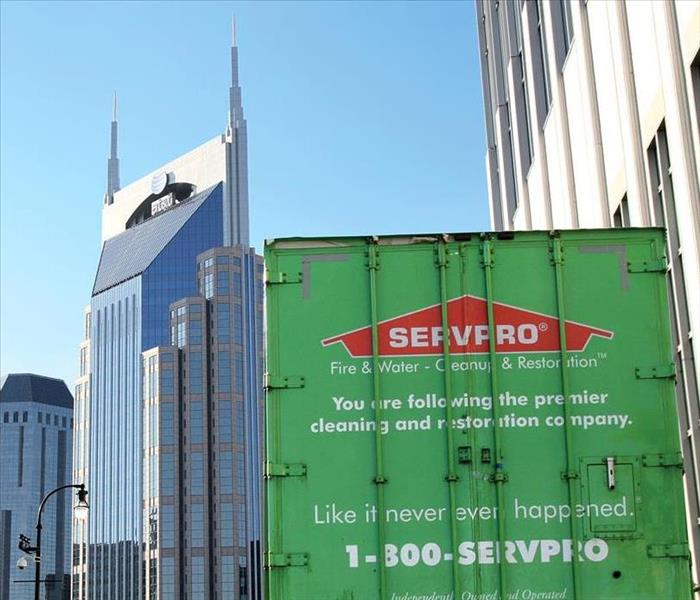 With over 1800 local franchises throughout the country, SERVPRO is ready to handle any size commercial loss.
With over 1800 local franchises throughout the country, SERVPRO is ready to handle any size commercial loss.
Is your business prepared if a disaster happens? Fire, flood, smoke, and vandalism are just of the few catastrophic events that can interrupt your business. As many as 50% of businesses close down, and never reopen, following a disaster. You can be ruined, or you can be ready. It is important to have a preparedness plan in place to minimize down time.
Call SERVPRO of Media to schedule an appointment to set up an Emergency Ready Profile (ERP). This document contains critical information to help identify the line of command for authorizing work, and get your business open as quickly as possible. Did you know that we don’t charge our customers for this service? And with the free SERVPRO ready app, getting help is in the palm of your hand, 24/7/365! We have over 45 years of experience in disaster mitigation, and can handle any size loss, no matter how large or how small.
Call us today to get started!
We are Cleaning Experts
3/18/2020 (Permalink)
SERVPRO is Here to Help During This Time of Need
During this unprecedented time caused by the global pandemic of coronavirus, this is a reminder to our customers that we are specialists in cleaning services, and we adhere to the highest cleaning and sanitation standards.
Specialized Training
We are prepared to clean and disinfect your home or business, according to protocols set forth by the Centers for Disease Control and Prevention. We have years of experience in dealing with biological contaminants, and we will go beyond the scope of work that regular janitorial staff perform on a daily basis.
The CDC encourages cleaning of high-touch surfaces such as counters, tabletops, doorknobs, light switches, bathroom fixtures, toilets, phones, keyboards, tablets and tables. Other spaces mentioned in the CDC’s guidance for commercial spaces include:
- Kitchen/Food Areas
- Bathrooms
- Schools/Classrooms
- Offices
- Retail Spaces
- Water Fountains
- Shelving/Racks
- Sales Counters
- Carpets and Rugs
- Stair Handrails
- Elevator Cars
- Playground Equipment
- Fitness Equipment
Specialized Products
The CDC recommends usage of a labeled hospital-grade disinfectant with claims against similar pathogens to the coronavirus. Multiple products in the SERVPRO product line carry the EPA-approved emerging pathogens claims. While there is currently no product tested against this particular strain of the coronavirus, we are following all guidelines as provided by the CDC and local authorities.
Call Today for a Proactive Cleaning
If your home or business needs deep cleaning services, call the experts today – [SERVPRO of Media/Central Delaware County, 610-237-8912]
Sources:
https://www.cdc.gov/coronavirus/2019-ncov/hcp/guidance-prevent-spread.html?CDC_AA_refVal=https%3A%2F%2Fwww.cdc.gov%2Fcoronavirus%2F2019-ncov%2Fguidance-prevent-spread.html
https://www.cdc.gov/coronavirus/2019-ncov/specific-groups/guidance-business-response.html
Water Damage 101
3/13/2020 (Permalink)
Did you know that according to the Insurance Information Institute, one out of every 50 insured homes in the United States files a water damage claim each year? Water damage is one of the largest contributing causes of homeowner’s insurance claims, and includes losses caused by weather events such as storms or hurricanes, pipe leaks, etc. Damage caused by water continues to increase, causing thousands of dollars in claims each year.
If you’re a homeowner who has never experienced a water damage loss before, you may be wondering what exactly the restoration process entails, and how much it costs. Depending on the extent of the damage and the type of water, the price will vary. For example, a “clean” water pipe burst that doesn’t cause standing water will be much less expensive to take care of than a toilet overflow that causes damage to a finished basement. There are three categories of water that you should be aware of:
- Clean water damage (Category 1): Caused by water that is “clean” from a pipe burst or rain. The cost averages about $3.75 per square foot.
- Gray water damage (Category 2): Caused by water coming from an appliance. This type of water may include soaps or chemicals that need to be treated as part of the cleanup. The restoration cost for this category of water averages about $4.50 per square foot.
- Black water damage (Category 3): Caused by water coming from a contaminated source such as a toilet overflow or sewer pipe. These types of water damages are health hazards, and need to be cleaned immediately. Cleanup of black water damage averages about $7.00 per square foot, being significantly more expensive than the previous categories.
If you experience a water damage loss in your home, there are a few steps you should take to get your home restored as quickly as possible:
Fix the source! The very first thing you should if you notice water damage in your home is to contact a professional to help repair the cause. Whether that means contacting a plumber to fix a pipe burst or toilet overflow, or a roofer to repair a damaged, leaky roof. This first step is arguably the most important, as drying and cleaning up the water is redundant if it will just continue to come back. Save yourself the time and money, and fix the cause first.
After the cause of the loss has been repaired, you can then begin the restoration process. Call SERVPRO of Media/Central Delaware County. We will take a look at the affected area, develop a detailed estimate of the work that needs to be done, and begin drying your home and its contents. SERVPRO is also able to provide full-service restoration. This means that not only are we able to remove the moisture, but we can repair and replace any wet drywall, ceilings, or floors that were removed during the water mitigation process.
Coronavirus Disease (COVID-2019) Prevention
3/11/2020 (Permalink)
Get the most current information on how to prevent the spread of the Coronavirus direct from the Centers for Disease Control and Prevention (CDC).
Be vigilant with hand washing. Clean AND disinfect frequently touched surfaces daily with a hospital grade disinfectant. This includes tables, doorknobs, light switches, countertops, handles, desks, phones, keyboards, toilets, faucets, and sinks.
Below is an excellent link to the current CDC recommendations. Be smart, get the facts.
SERVPRO of Media is here to perform preventative cleaning and disinfection of commercial properties, such as offices, schools, and retail areas. Contact us for more information on how SERVPRO of Media can help your clients, employees and students stay safe through this time of concern. We can be reached at 610-566-5720.
Prevention of Coronavirus Disease 2019 (COVID-19) | CDC
SERVPRO of Media/Central Delaware County Can Completely Restore Your Commercial Property
3/6/2020 (Permalink)
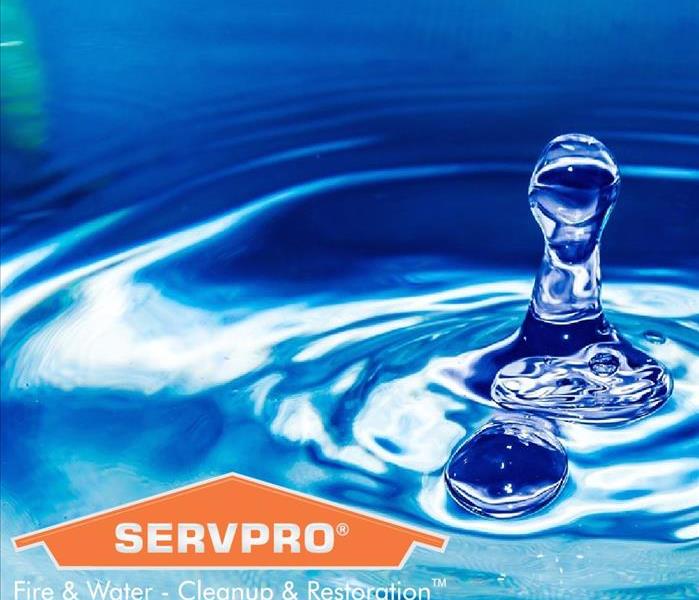 If you are ever faced with a fire or water emergency, we can provide complete end to end service!
If you are ever faced with a fire or water emergency, we can provide complete end to end service!
When water damages a commercial building, the consequences can be greater than you’d initially think. Not only will there be damage to the building’s structure and contents, but because it is a commercial building there are other consequences as well. While business operations are at a standstill revenue will be lost, customers may migrate to other companies, and employees may have to be laid off. It is crucial that the time between the initial loss and the completion of repairs is brief, so businesses can get back to their regular operations.
SERVPRO provides full water damage restoration services in Media and Central Delaware County. It can be frustrating for businesses to have to wait for subcontractors. Fortunately, we are able to provide end to end service. Not only will we remove the water and eliminate the moisture, but we will also complete the repairs as well. If the outside structure is damaged, we are able to provide emergency services such as boarding up windows or tarping.
Our teams are trained following industry standards, enabling us to quickly and efficiently get your business back up and running. Our main goal is to provide outstanding service, and we do just that by guiding you through every step of the process.
Call SERVPRO of Media/Central Delaware County at (610) 237-8912. We’re available 24/7/365 to make any fire or water loss “Like it never even happened.”
Water Stains on Your Ceiling? Here's The Fix
2/28/2020 (Permalink)
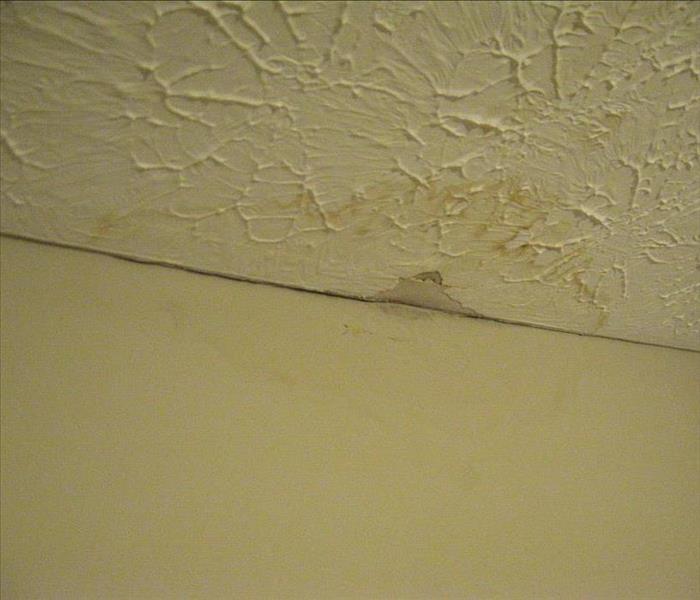 Although the stain may have dried, the underlying cause of the stain could still potentially be a threat to your home.
Although the stain may have dried, the underlying cause of the stain could still potentially be a threat to your home.
If you notice a small water stain on your ceiling, chances are it was most likely caused by a plumbing issue or roof leak. Either one of these events would cause water to seep through the ceiling and evaporate, leaving you with a discolored, unsightly mark.
Where did it come from?
If you find a water stain on your ceiling you should immediately look for what caused the leak, address it, and then begin working to repair the affected areas. Many homeowners who notice water stains will ignore them. Either because they think it’s not a potential issue, or they simply just forget about it. It is vital that the issue is addressed immediately, as it could potentially get worse. Many people will also go straight to covering up the stain without addressing the initial cause. This potentially will leave you with a larger, more expensive problem on your hands in the future.
Open up the affected area or hire a professional to remove the affected ceiling or walls. Then make the necessary repairs to the source of the damage yourself, or enlist the help of a roofer, plumber, or HVAC professional.
The leak is fixed, what now?
Inspect the areas for mold, water and odor. Should you have any of those three items, it always best to have a professional make an inspection. SERVPRO of Media offers free inspections to all of our water damage clients.
Once the area has been properly remediated, you can begin completing the repairs, by replacing drywall and then painting. Start off by moving the furniture out of the way, and covering and protecting your contents. Then tape off the areas you don’t want to get paint on with blue tape, as you normally would before beginning to paint.
Apply an oil-based, stain blocking, mold-resistant primer. If you have a smooth ceiling, you can roll it on with a paint roller. Alternatively, if you have a popcorn ceiling it would probably be easiest to spray it on. After applying the primer, you can paint the ceiling with the paint of your choice. Wait the recommended amount of time before applying a second coat. After the paint dries, your ceiling should look like there was never a stain to begin with!
If you experience a pipe burst or water leak in your home that is too large to handle on your own, call SERVPRO of Media/Central Delaware County. We have the knowledge and training to handle any loss, regardless of size!
Restoring Your Commercial Property After A Water Damage Event
2/21/2020 (Permalink)
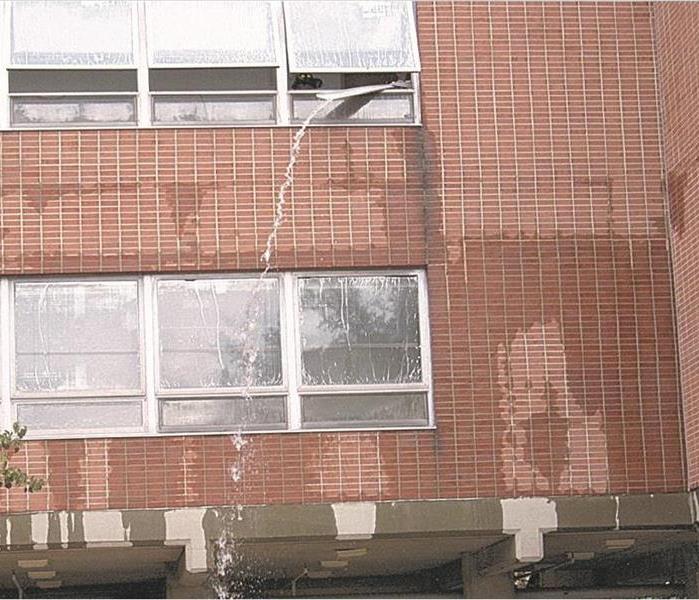 Commercial water damage events can present unique challenges
Commercial water damage events can present unique challenges
Flooding and water damage events at Media commercial properties are often complex with numerous issues that require a knowledgeable and flexible response. Whether we’re dealing with a relatively small water cleanup scenario or a large-scale event, we work quickly to assess each unique situation and isolate the damaged area. In many instances, normal operations can continue in a temporary space while we restore your facility.
Restoring Commercial Properties Presents Unique Challenges
Our professionals are trained to be mindful of legal and environmental concerns and strive to fully restore the damaged area while working within your budgetary constraints. We understand that every hour spent cleaning up is an hour of lost revenue and productivity. So, when an emergency situation arises in your business, give us a call and we’ll be there fast with the help you need.
About SERVPRO of Media and SERVPRO of Central Delaware County
SERVPRO of Media and SERVPRO of Central Delaware County specialize in the cleanup and restoration of commercial and residential property after a water damage event. Our staff is highly trained in property damage restoration. From initial and ongoing training at SERVPRO’s corporate training facility to regular IICRC-industry certification, rest assured our staff is equipped with the knowledge to restore your property.
Meet our crew!
Fire Extinguishers
2/14/2020 (Permalink)
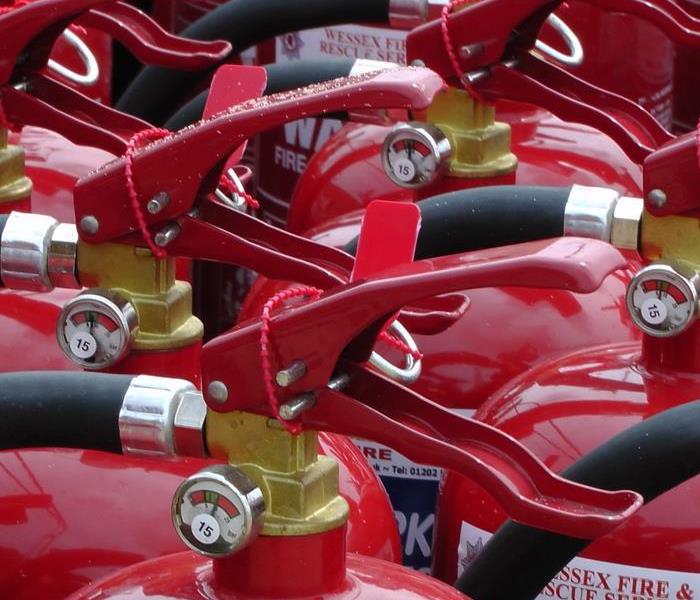 Having fire extinguishers readily available enable you to be prepared in case of an emergency.
Having fire extinguishers readily available enable you to be prepared in case of an emergency.
If you are planning a fire safety plan for your business or household, a great place to start is with choosing a fire extinguisher. It is important to make sure that you learn about the different types of fire extinguishers, what they do, and how to use them.
The Types of Fire Extinguishers
There are four types, or ‘classes’ of fire extinguishers. Each class is specialized to put out a specific type of fire.
- Class A: Used to extinguish fires caused by ordinary combustibles such as trash, wood, paper, and textiles.
- Class B: Used to extinguish fires caused by flammable liquids such as grease, gasoline, oil, and even paint.
- Class C: Used to extinguish fires caused by live electrical equipment. When a fire sparks from a short circuit or a kitchen appliance, the constant source of electricity continues to fuel the fire. Class C fire extinguishers contain elements that lack conductive properties, effectively preventing the fire from spreading.
- Class D: Used to extinguish fires involving combustible metals, such as magnesium, titanium, and sodium. Class D extinguishers contain an extinguishing medium that does not react with the burning metal.
Today’s most widely used and popular fire extinguisher is the multi-purpose dry chemical extinguisher, also known as ABC dry chemical. It is effective at putting out class A, B, and C fires. For your home it is recommended to select a multi-purpose extinguisher in a size that is capable of putting out small fires, but that is not too heavy to properly handle. It is also strongly recommended to have at least one available on each floor of your home.
Operating Your Fire Extinguisher
Aside from knowing which type of fire extinguisher would best suit your needs, it is absolutely crucial to know how to operate your fire extinguisher properly, safely, and effectively. Most fire extinguishers operate using the P.A.S.S. technique.
- Pull the pin. Hold the extinguisher nozzle away from you as you do this.
- Aim low. Always point the extinguisher nozzle (horn, or hose) at the base of the fire.
- Squeeze the lever slowly and evenly to release the extinguishing agent.
- Sweep the nozzle from side to side until the fire appears to be out, then watch the area to ensure that the fire does not reignite. If it does, repeat steps 2, 3, and 4.
Call SERVPRO of Media and SERVPRO of Central Delaware County if you are ever faced with a fire to your home or business. We will guide you through the process and work to restore your property to make it “Like it never even happened.”
Fire Prevention in Your Business
1/31/2020 (Permalink)
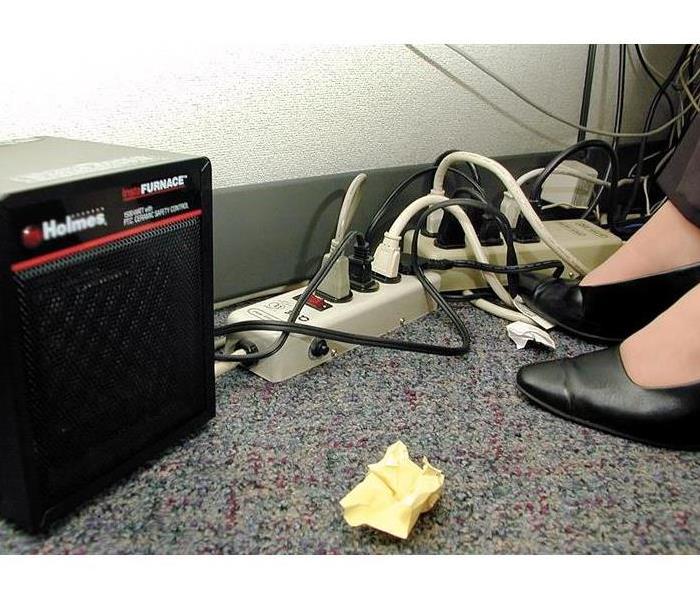 Space heaters, excessive wires, and loose papers are all potential fire hazards in your office space.
Space heaters, excessive wires, and loose papers are all potential fire hazards in your office space.
Fire is unpredictable. It can happen anytime, to any business, anywhere. 31% of office fires happen between 7pm and 7am, after hours while workers are not present. Fires that occur while workers are not in the office cause about 67% of recorded property damage. This is because they went undetected for a longer period of time. Luckily, there are a few preventative measures that anyone can take to minimize the chances of a fire happening in your business or commercial building.
Once a year, according to OSHA, employers are required to perform a full maintenance check on their workplace’s fire extinguishers. “Maintenance” means a thorough examination and repair, as needed, of all of your facility’s portable fire extinguishers, as covered in NFPA (98), Sec. 4-4.
- Along with ensuring that your fire extinguishers are regularly inspected and maintained according to local fire code; each month you should perform a visual inspection on your fire extinguisher(s).
- Look for obvious signs of damage. These include dents, corrosion, and leakage.
- Check the pressure gauge to make sure that the indicator is in the operating range.
- Make sure that the pull-pin is not missing and that the pull-pin seal is intact.
- Verify the date of the last professional maintenance inspection.
- Date and initial the tag to log the visual inspection.
There should be a fire prevention plan that is in writing, kept in the workplace, and is available to all employees for review. If you have 10 or fewer employees you can communicate the plan verbally, though it is still recommended that you have a hard copy in writing. This plan should include:
- Relevant information about the building’s layout
- The building’s fire protection systems and equipment
- Emergency evacuation procedures
Ban risky appliances such as space heaters, and keep others like coffeemakers and toasters away from paper and other flammables. You should also reduce the amount of clutter in your building or office space. Items such as boxes, piles of paper, and other flammable materials can provide fuel for a fire, especially if left near a heat source. Before you plug something in ensure that the wire has not been damaged or frayed. If you notice any damaged wires, replace them immediately. Wires should not run under rugs or between furniture and walls; they tend to heat up, so you want them clear of any flammable items.
We understand how devastating and confusing a fire to your home or business can be. Do not hesitate to contact the experts here at SERVPRO of Media, and SERVPRO of Central Delaware County to help guide you through the restoration process.
What is a Puffback?
1/16/2020 (Permalink)
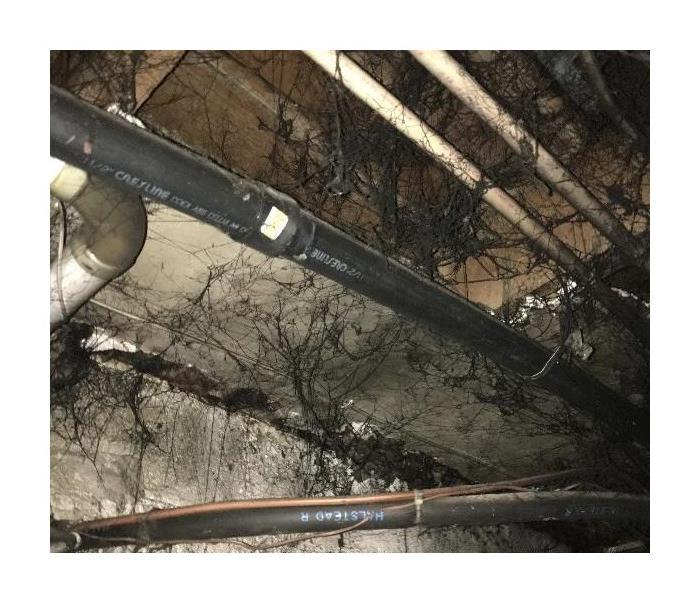 A puffback can result in everything in your home being covered in sticky, black soot.
A puffback can result in everything in your home being covered in sticky, black soot.
As the weather gets colder, more and more homeowners are turning on their heating systems for the first time in months. Unfortunately for many, this means the possibility of puffbacks.
What are puffbacks, and what causes them?
Puffbacks usually take place due to lack of maintenance or age-related issues. A puffback occurs when a boiler or furnace misfires, causing an explosion of unburned fuel in the combustion chamber. This causes a release of smoke and soot that can be both incredibly messy and dangerous. Luckily, there are a few simple ways to prevent a puffback from occurring in your home.
First and foremost, ensure that your heater is inspected annually by a qualified technician. This is crucial, as this annual inspection will ensure that all parts of the heater are functioning properly. Regular inspections are also very important as manufacturers have the ability to ask for records of these should you ever have a warranty claim.
Warning Signs
Listen for strange sounds and pay attention to any strange odors. Most heating systems will usually give plenty of warning prior to a puffback occurring through soot and gas odors throughout the building. If you hear any unusual noises when your heater starts up, unburned oil is probably being ignited. Keep an eye out for any oil leaks and soot on and around your heater and keep the area around the heater clean and free of any dust, debris, or content (storage items, paper, boxes etc.). If you notice any of these warning signs, call a qualified service technician immediately to diagnose the issues and make repairs.
After a puffback, the soot can cover everything in your home. This means walls, furniture, curtains, and even inside drawers! Soot is not just powdery; it is black, sticky, and includes a mixture of oil. This makes it especially difficult to clean. If you experience a puffback in your home, call a trained HVAC technician to repair your heating system. Then, call us here at SERVPRO of Media to help clean the chemicals and soot left behind to make it “Like it never even happened.”
How to Prevent Frozen Pipes
1/3/2020 (Permalink)
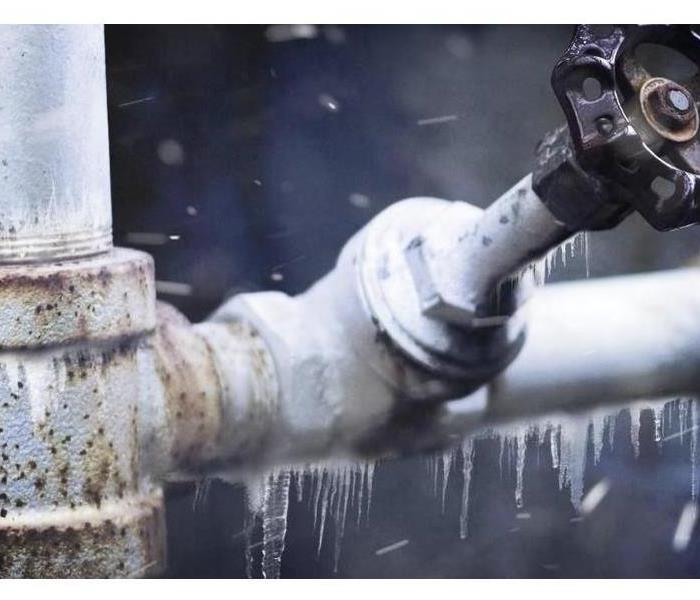 Did you know that damage caused from frozen pipes affects around a quarter-million American families each year?
Did you know that damage caused from frozen pipes affects around a quarter-million American families each year?
With temperatures gradually decreasing and colder weather approaching, the threat of frozen pipes becomes more of a reality for many homeowners. If unfavorable weather conditions cause the heat to go out just when you need it most, there are a few things that you can do to prevent costly repairs from being needed.
The "Trickle Method"
If the heat goes out in your home, a simple yet highly effective way to prevent frozen pipes is the “trickle method”. Turn on the faucets in your home and allow a small amount of water to trickle through. The reason this works to prevent pipes from freezing is not because of the movement of water throughout the pipes, but because of the heat that the water picks up from underneath the frost line. It may not be incredibly warm, but the temperature underneath the ground is above freezing.
Winterization
If the heat in your home is going to be out for longer than a day and the temperatures will remain below freezing, then “winterization” of your home’s plumbing system is strongly recommended. (See https://www.thebalancesmb.com/how-to-winterize-plumbing-pipes-844862 for a step-by-step on how to winterize your home’s plumbing system.)
Winterizing your home’s plumbing system is not always necessary though, and can be problematic since it is very difficult to empty the pipes of all water without an air compressor and notice before the outage. This is why at a minimum it is recommended to allow water to trickle through the faucets as a preventative measure.
Pipe Insulation
Winterizing your home’s plumbing system and allowing water to trickle through the faucets are great as last minute preventative measures, but the simplest way to prevent frozen pipes is to insulate them! Insulating your pipes will keep them warm in frigid temperatures, preventing them from freezing and bursting. Both cold and hot water pipes should be insulated, and be sure to pay attention to pipes that are already in unheated areas of your home. Insulating your pipes will require a small investment, but it is ultimately cheaper in the long run. No one wants to deal with the emotional and financial stress that a burst pipe leak brings.
If a pipe bursts in your home, contact the experts here at SERVPRO of Media and SERVPRO of Central Delaware County to help with the water mitigation process.
Ice Damage
12/16/2019 (Permalink)
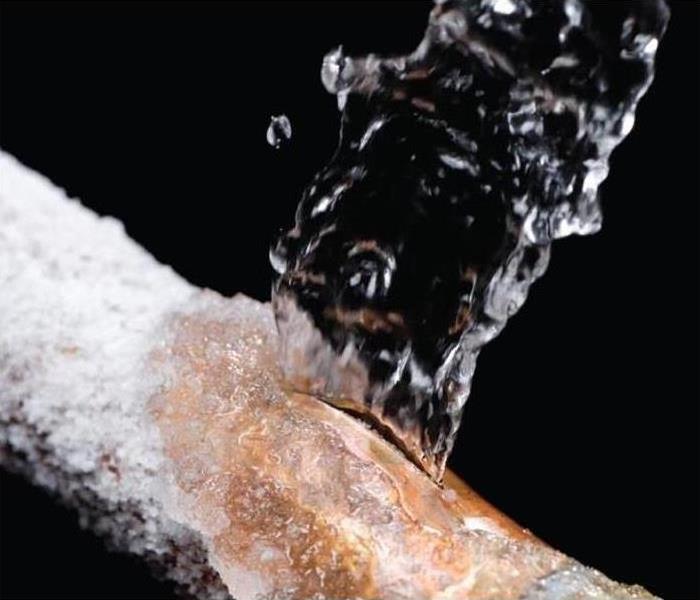 Freezing temperatures can cause water to freeze inside of pipes, causing water pressure to build and eventually causing the pipe to burst.
Freezing temperatures can cause water to freeze inside of pipes, causing water pressure to build and eventually causing the pipe to burst.
- Ice storms are caused by freezing rain. The raindrops move into a thin layer of below-freezing air right near the surface of the earth, allowing them to freeze on contact to the ground, trees, cars and other objects.
- Ice accumulates when super-cold rain freezes on contact with surfaces that are below freezing point. That can be dangerous, especially for older adults. You can walk a senior’s dog to keep them injury free! Sign up for Dog Days of Winter.
- Throughout the US, ice storms occur most often during the months of December and January.
- Ice storms have the bizarre effect of entombing everything in the landscape with a glaze of ice so heavy that it can split trees in half and turn roads and pavements into lethal sheets of smooth, thick ice.
- Ice can increase the weight of branches by 30 times.
- Urban areas tend to suffer more economic and physical damage than rural areas because of the concentration of utilities and transportation systems (aircraft, trains, vehicles) — all of which may be affected to a great degree by the ice storm.
- The Midwest and Northeast are prime areas for freezing rain. In the high frequency band in the Midwest, an average of 12 to 15 hours of freezing rain occurs annually.
- Driving during an ice storm is extremely hazardous, because ice can cause vehicles to skid out of control, leading to devastating car crashes.
- The National Weather Service refers to winter storms as the “deceptive killers” because most deaths are indirectly related to the storm. In addition to car crashes, people die from hypothermia which is prolonged exposure to cold.
- In 1998, an ice storm in northern New York and northern New England damaged millions of trees and caused $1.4 billion in damage. Accumulations were as much as three inches thick!
- The ice storm that struck the northeastern US in December 2008 left 1.25 million homes and businesses without power. Described as the worst storm of the decade, a state of emergency was declared in Massachusetts, New Hampshire, and parts of Maine.
Mold Remediation
11/5/2019 (Permalink)
SERVPRO of Media understands the stress you experience when water damage devastates your business or home. That is why we are available 24/7 to help. Our team of experts are quick to any job of any size.
Our certified technicians will mitigate the damage to prevent mold, mildew or bacteria. Using EPA disinfectants, we will make your business or home safe to reenter and occupy. We ensure our team is trained and up to date with all of their credentials.
SERVPRO has been trusted by local businesses and insurance companies to assist with their water damage projects. We are there when your family needs help the most. Any type of damage in your home can be a devastating time and can cause a lot of stress in the household. Working with true professionals can definitely help the process and get your home back to normal as quickly as possible.
Fire Damage in Your Home
10/31/2019 (Permalink)
Fire can cause large amounts of damage on your property. However, there are other damages that can seriously affect the building as well. Smoke odor invades building materials and personal belongings of every kind. Smoke soot damages walls that have not been burned by flames. Experiencing a fire can be devastating, and SERVPRO understands that your cherished possessions and memories are at stake. As fire restoration experts, we specialize in soot and smoke damage as well.
If your home is damaged by fire, it is critical to contact a company that specializes in the fire and smoke restoration process as soon as possible to prevent additional damage. Your local SERVPRO is available 24/7 to help minimize the cost of fire and smoke damage to your home.
Our fire restoration process includes:
- 24/7 emergency services – onsite and assisting you within hours
- Prompt damage assessment, pretesting and estimates
- Emergency board-up and structural stabilization
- Environmentally friendly methods for cleaning soot and other residue from fire damage
- Smoke odor removal, sanitation and air purification
- Careful removal and securing of damaged household goods, personal possessions and other contents for cleaning and restoration
- Industrial grade water extractors, dehumidifiers, air movers and other equipment used to efficiently remove water resulting from fire extinguishing efforts
- Reconstruction of the affected areas
- Disinfectants and antimicrobials used to prevent mold and mildew
Ice Dams
10/30/2019 (Permalink)
Ice Dams: Several quick fixes but only one cure.
An ice dam is a hump of ice that forms at the edge of a roof under certain wintertime conditions. An ice dam can damage both your roof and the inside of your home. It will put gutters and downspouts at risk too.
Ice dams are a common sight in Northern New England winters, and Home Partners has dealt with quite a few. There are several things you can do to avoid getting an ice dam or to reduce the risk of damage after one has formed, but there’s really only one cure: a combination of better sealing, insulation, and venting in the attic and eaves.
How do ice dams form?
An ice dam forms when the roof over the attic gets warm enough to melt the underside of the layer of snow on the roof. The water trickles down between the layer of snow and the shingles until it reaches the eave of the roof, which stays cold because it extends beyond the side of the house. There, the water freezes, gradually growing into a mound of ice.
The flatter the pitch of the roof, the easier it is for an ice dam to get a grip. Gutters at the eaves can also trap snow and ice. If snow and ice build up high enough in the gutter, it can provide a foundation for an ice dam.
What damage do ice dams cause?
When an ice dam gets big enough, melted water backs up behind it and seeps underneath the shingles. Eventually, the water will drip into the insulation and down into the ceilings and exterior walls beneath the eave, ruining sheet rock and paint. If the ice dam breaks free, it can pull shingles and gutters off with it, and it will damage anything it falls on: shrubs, windowsills, cars, pets, and people. If the roof sheathing stays wet, it can form mildew and start to rot
How to deal with existing ice dams
- Remove the ice dam by breaking it free in small chucks. Do NOT use an ax or other sharp tool! You’ll cut through the shingles. Instead, tap lightly with a blunt mallet. This is slow, dangerous work, so hire someone experienced at roofing. Even if you do it safely, the chunks of ice can take pieces of shingle with them.
- Clear out gutters and downspouts. Again, this is ladder work and an easy way to damage either plastic or metal gutters and spouts.
- Melt troughs through the ice dam with calcium chloride ice melter. Do NOT use rock salt! It will damage paint, metals, and plants beneath the eave and wherever the salty water drains.
A good trough-maker is a tube of cloth (a leg from an old pair of pantyhose works well). Fill it with calcium chloride, tie off the top, and lay it vertically across the ice dam. It will slowly melt its way down through the dam, clearing a path for the underlying water to flow free.
The Importance of Fire Sprinkler and Suppression Systems For Your Business
10/3/2019 (Permalink)
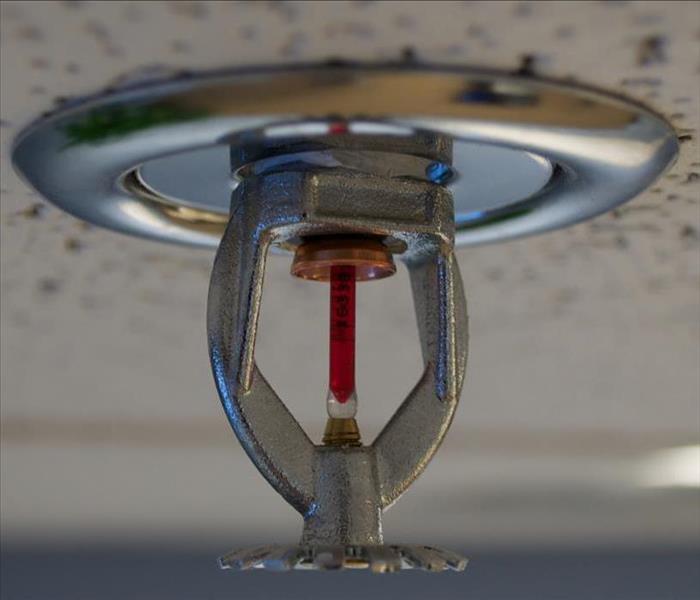 In the event of a fire, sprinkler and suppression systems are crucial to preventing flames from spreading.
In the event of a fire, sprinkler and suppression systems are crucial to preventing flames from spreading.
When you think of a fire taking place, you probably only think of the obvious; fire damage. But there are many other damages that can occur during, and after a fire. Smoke, soot, water, and mold damage are a few of these additional damages.
Most business facilities and commercial spaces are only protected by a pre-action fire sprinkler system. Businesses have many options, each having their own strengths and weaknesses. While sprinkler systems are great at containing a fire, these systems must be exposed to enough heat to warrant the release of water. This short period of time between the fire starting and the sprinklers releasing water can allow the fire to grow substantially, directly resulting in increased damages.
Sprinkler systems have a few more issues as well. Once the sprinkler system releases water, it can cause substantial water damage to items such as furniture and electronics. If the water is not sufficiently dried in time after it is released, this could potentially pave the way for mold growth. It is important to keep this in mind when deciding the best method of fire protection for your business.
Difference between Fire Sprinkler and Suppression Systems
If you are considering sprinkler or suppression systems for your business or commercial space, it is important to know the difference between the two, and the different types.
Suppression Systems
Fire suppression systems use a combination of dry chemicals, gaseous, foam, and wet agents to suppress and prevent the spread of fire in a building. Some common types of suppression systems and agents include:
- Wet chemical fire suppression: Most commonly used in kitchens. The suppressant used is a liquid substance that when sprayed onto the affected area, and is brought in contact with cooking oils and fats, will react to produce a foam that immediately cools the flames.
- Dry chemical fire suppression: Used to quickly extinguish fires caused by flammable liquids. Most commonly used in industrial settings or areas where flammable liquids are being stored.
- FM 200 fire suppression: Requires no cleanup, leaves no residue, and is safe to use in occupied spaces. Ideal for spaces such as computer rooms, museums, libraries, and areas where other sprinkler or suppression systems may cause large amounts of damage.
If you, your business, or commercial space is dealing with damage and loss resulting from a fire, SERVPRO of Media and SERVPRO of Central Delaware County are able to respond immediately. Regardless of size or scope, we have the tools to get your business back up and running, “Like it never even happened.”
Build an Emergency Plan in Case of a Severe Weather Event
10/3/2019 (Permalink)
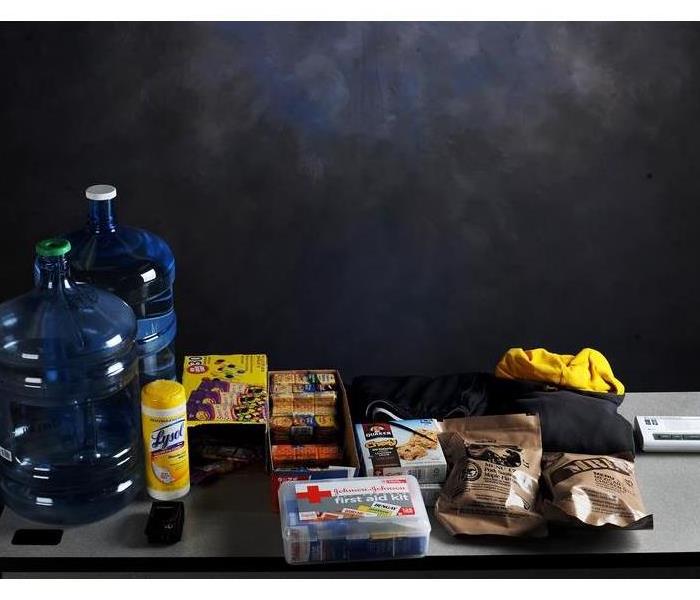 Being prepared in a weather emergency means having adequate food, water, and other supplies readily available.
Being prepared in a weather emergency means having adequate food, water, and other supplies readily available.
In a weather emergency, it is very important that you, and your family or household are prepared. This means taking the necessary steps to ensure sufficient food, water, and emergency supply storage. You should also take into consideration important documents, specific needs, and a plan for your family to communicate during and after a disaster.
Consider Specific Needs
Specific needs are needs that are exclusive to certain family members. These include dietary needs, medications, medical equipment, and needs specific to age and pets as well. For example, if you have any pets, contact hotels outside of your area and find out what their policies on pets are. If they have a “no pet” policy, ask if this would be waived during an emergency.
Ensure Sufficient Food and Water Storage
It is crucial that if a storm or weather emergency takes place, you and your family have sufficient food and fresh water storage. Have at least one gallon of fresh water per person, per day. This allows for fresh drinking water, and water for hygiene purposes. Stock up on non-perishable, easy to store food that is simple to prepare and does not require heat or water. Good examples include dried fruit, peanut butter, energy bars, and canned goods. Ensure that you also have a manual can opener to open any cans that you have.
Important Documentation
It is important to store all vital personal documentation in a fire and water proof safe. It might also be a good idea to store important personal documentation in a safety deposit box. Some important documents to consider are:
- Your photo ID, birth certificate, and social security card
- Housing payments, insurance policies, and sources of income
- Health insurance information and immunization records
Emergency Supplies
Some emergency supplies that would be beneficial include:
- First aid kit, fire extinguisher, flashlights and extra batteries, and a wrench or pliers to turn off utilities
- Change of clothes for at least three days, toothbrush, toothpaste, and soap
Plan for Communication
Communication during an emergency is crucial. Create a paper copy of important contact information for your family, friends, and facilities such as doctor’s offices and schools. Ensure that everyone has a copy on them at all times. It may also be helpful to post it in a central area of your home. You will also want to ensure that you have someone outside of your community or state who can act as a “contact person” to help your family reconnect. This is important, as it may be easier to make a long distance phone call rather than a local call where the phone lines may be jammed.
If a weather emergency strikes in your area, contact the experts here at SERVPRO of Media and SERVPRO of Central Delaware County to help with the water mitigation process.
Signs That You May Have Mold
9/26/2019 (Permalink)
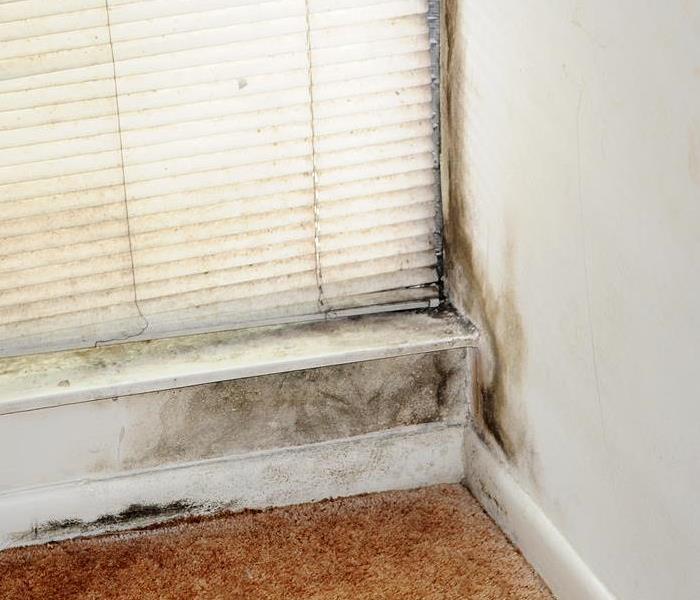 Mold growth is very common around windows, where warm indoor air comes into contact with the cooler glass window panes causing condensation.
Mold growth is very common around windows, where warm indoor air comes into contact with the cooler glass window panes causing condensation.
You may have heard of the complications that mold can cause in your home, but what exactly is mold? Mold is not a plant, but a fungus. We are exposed to small amounts of mold every single day through the air, but as soon as mold spores come into contact with a damp, moist surface and begin to reproduce, that is when they have the potential to become harmful.
Past Flooding, Water Leaks, and Condensation
High humidity and condensation create the perfect conditions for mold to grow. The microorganisms that turn into mold are always in the air around us. Once they are exposed to water, mold growth can start within 24-48 hours. If you have had past flooding, or have persistent high humidity in your home, it is at higher risk of developing mold growth.
Deterioration, Rust, and Warping
Condensation and moisture can manifest themselves physically in the form of deterioration and rusting. Some examples include pipes rusting, drywall and wood warping, paint chipping, wallpaper peeling, and other materials deteriorating. If you notice any of these, this could be a sign that your house has high moisture levels indicating a higher chance of there being mold growth.
Seeing and Smelling
If you see mold, immediate action is required. Even very small patches of mold have the potential to spread, and the fact that there is mold at all shows that your home has the correct conditions for mold growth. This is important to note, as mold can grow in places you cannot see, such as the inside of wallpaper, walls, ventilation ducts, and under carpets and floorboards. It is possible to smell mold without actually seeing it. Mold has a persistent smell that, over time, you can eventually get used to. This is dangerous as it can give homeowners the false impression of the mold having gone away.
If you detect any signs of mold in your home or business, do not hesitate to contact SERVPRO of Media. Following the industry standards for mold remediation, we will work to remove the mold and reduce the likelihood of future mold growth.
Ways to Protect your Home and Family during a Storm
9/25/2019 (Permalink)
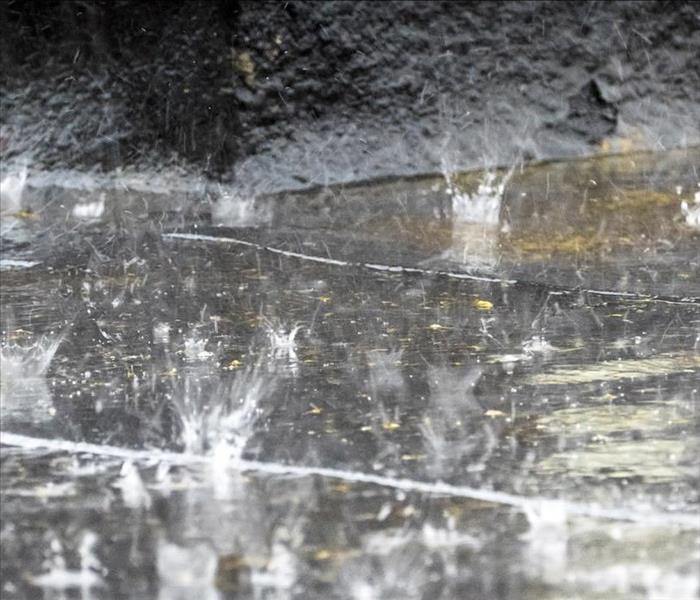 SERVPRO of Media is available 24/7 in case of storm and flood damage.
SERVPRO of Media is available 24/7 in case of storm and flood damage.
Did you know that experiencing flood and water damage is one of the quickest ways to devalue your home? Not only that, but storms can devastate your home and life in a matter of a few hours. Luckily, there are a few precautions you can take to reduce, or prevent damages caused by storms.
- Replace missing or damaged shingles. Damaged shingles are more likely to break free than secure shingles, and missing shingles are essentially a gap for wind to enter to cause more damage.
- Ensure that your home's siding is secure and undamaged. The siding, along with the roof, is a home’s first defense against the elements.
- Keep the gutters clear and free flowing. Making sure that your gutters are clear is the first step in ensuring that water is able to flow away from your home. Draining water away from your home will prevent a number of problems, such as foundation erosion and basement flooding.
- Check that your sump pump is in working order. The sump pump is usually located at the lowest spot in the basement where water is most likely to flow. It is responsible for keeping those areas dry, and also for protecting your home from extensive water and moisture damage.
- If there are any trees on your property, hire a professional tree pruning service. Having your trees regularly pruned will strengthen them and make it less likely for branches to break off during a storm. This is very important, as fallen branches can not only damage and harm your property, but the property of those around you.
Lastly, your home and belongings are replaceable, but you and your family are not. Make sure to stay away from windows, and if possible, during particularly bad storms, relocate your family to a basement or shelter.
SERVPRO of Media has the experience, equipment, and tools necessary to handle any type of water and flood damage caused by storms.
Fire Planning and Prevention in the Home
9/24/2019 (Permalink)
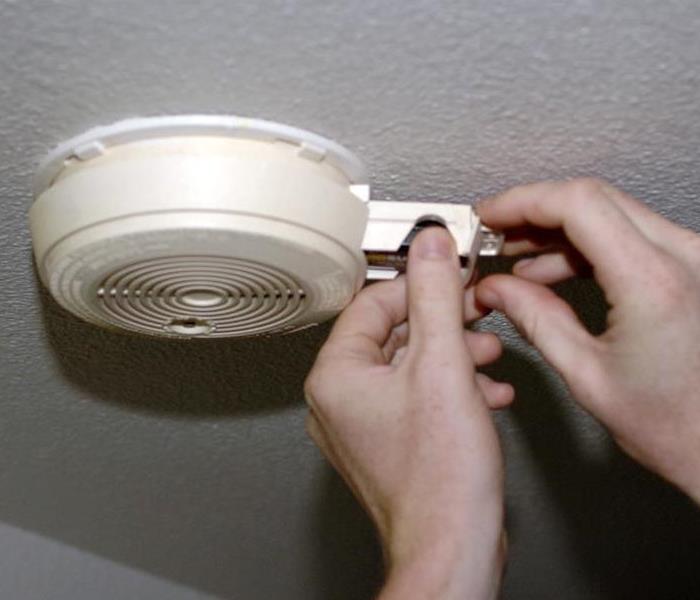 Always ensure that the batteries are functioning properly in your smoke alarms.
Always ensure that the batteries are functioning properly in your smoke alarms.
Did you know that if a fire starts in your home, you could be left with as little as two, or even just one minute to escape? While deaths caused as a result of home fires have decreased in recent years, just one death caused by a preventable fire is one too many. This is why taking the necessary steps to prevent home fires is crucial.
Causes and Prevention
First things first, smoke alarms! Oftentimes, people overlook proper smoke alarm maintenance, though it is one of the simplest and easiest ways to start protecting your home and family. Set a reminder in your smartphone or mark it on the calendar each month to test the batteries. If they are no longer working, replace them immediately.
- If using a form of alternate heating such as a wood or pellet stove, follow the manufacturer’s instructions while installing, or hire a professional. If using a space heater, avoid using an older one, and refrain from placing it near furniture or any other object that could easily catch fire.
- Home cooking is the leading cause of home fires and fire related injuries. Never use the oven or stovetop while tired or under the influence of alcohol. Make sure all appliances are clean, and do not leave food that is cooking unattended, especially if you are using grease.
- According to the U.S. Consumer Product Safety Commission, it is estimated that there are an annual 15,500 fires caused by dryers. Ensure that the dryer duct is in good condition, and always clean the lint trap after each use. Use a lint brush or vacuum to remove lint that has accumulated under the lint trap, and never leave the house while the dryer is running.
- A clean chimney is a lot less likely to catch fire. The easiest way to prevent a chimney fire in your home is to use the services of a certified chimney sweep on an annual basis. A yearly chimney sweep will result in better passage of smoke and exhaust gasses, and will also remove any creosote, a highly flammable substance that accumulates in the chimney flue due to lack of open ventilation.
- According to the U.S. Fire Administration, over 25,000 electrical fires are reported in the United States each year. Have your electrical wires inspected regularly by a highly rated electrician, and ensure that any wiring that is tattered, frayed, or worn out is replaced. Refrain from plugging too many appliances into the same outlet, extension cord, or power strip.
Although prevention is crucial, sometimes things happen that are out of your control. We understand the devastation felt when you or your business is dealing with the aftermath of a fire. During this difficult time, you can trust in the experts at SERVPRO of Media. Contact us to help you deal with the aftermath of smoke and fire damages, and to walk you through the process.
Are you ready for a disaster?
8/12/2019 (Permalink)
 Our free app puts help in the palm of your hand!
Our free app puts help in the palm of your hand!
Is your business prepared if a disaster happens? Fire, flood, smoke, and vandalism are just of the few catastrophic events that can interrupt your business. As many as 50% of businesses close down, and never reopen, following a disaster. It is important to have a preparedness plan in place to minimize down time.
Call SERVPRO of Media to schedule an appointment for an Emergency Ready Profile (ERP). Did you know that this service is free? And with the free SERVPRO ready app, getting help is in the palm of your hand! We have over 45 years of experience in disaster mitigation, and can handle any size loss, no matter how large or how small.
Call us today to get started!
Are you ready for a disaster?
8/12/2019 (Permalink)
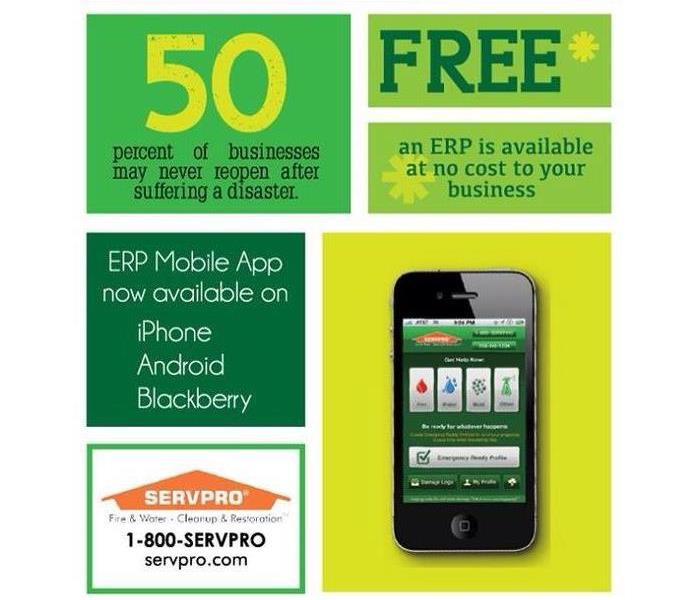 Our free app puts help in the palm of your hand!
Our free app puts help in the palm of your hand!
Is your business prepared if a disaster happens? Fire, flood, smoke, and vandalism are just of the few catastrophic events that can interrupt your business. As many as 50% of businesses close down, and never reopen, following a disaster. It is important to have a preparedness plan in place to minimize down time.
Call your SERVPRO of Media to schedule an appointment for an Emergency Ready Profile (ERP). Did you know that this service is free? And with the free SERVPRO ready app, getting help is in the palm of your hand! We have over 45 years of experience in disaster mitigation, and can handle any size loss, no matter how large or how small.
Call us today to get started!
Back to School tips
8/12/2019 (Permalink)
 It's that time of the year again!
It's that time of the year again!
It's back to school time! Here are some tips to make a smoother transition for you and your kids:
1) Get a planner &/or calendar and add important appointments and events
2) Get back into a sleep routine prior to the beginning of school
3) Review safety rules with your children for the bus, car, walking, or biking to/from school
4) Shop for school supplies early to get the best deals and to avoid things selling out
5) Organize closets, donate clothes that no longer fit
6) Have a family meeting to discuss rules regarding homework and electronic device usage
Having a plan early on can really help to avoid problems later on.
How to prevent mold growth in your home
6/28/2019 (Permalink)
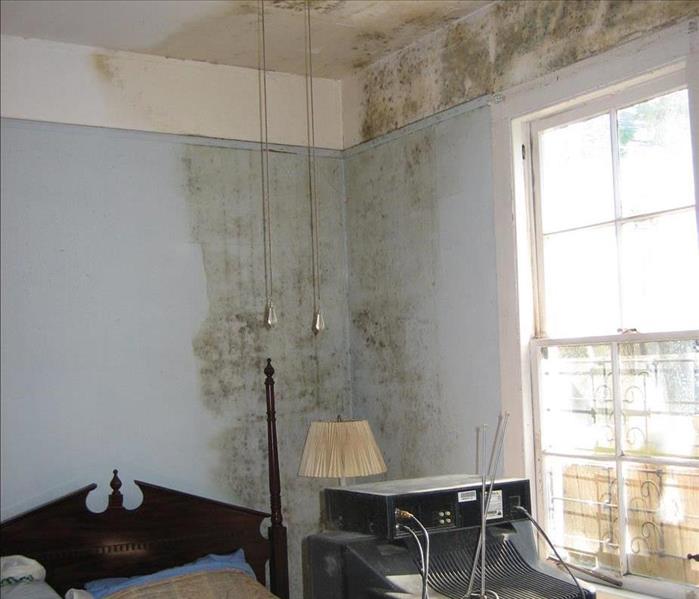 Mold from a leak growing on walls and ceiling
Mold from a leak growing on walls and ceiling
Mold is everywhere inside and outside of our homes. Given the right conditions (food, moisture, heat, humidity), mold can grown out of control and become unsightly, cause property damage, and even cause health issues.
The number one way to prevent the growth of mold in your home is to fix leaks and dry the area as quickly as possible. Proper insulation around pipes and in homes can prevent condensation. Proper ventilation and air movement can aid in keeping things dry. Dehumidifiers are helpful in reducing humidity levels in your home to safer levels.
In the event there is mold in your home, trust the professionals at SERVPRO® of Media. We will give a free assessment to remediate the mold!
The Legend of Groundhog Day
1/22/2019 (Permalink)
 Punxsutawney Phil
Punxsutawney Phil
The tradition of Groundhog Day began in Germany during the celebration of Candlemas on February 2nd. It began in the United States as a tradition of the Pennsylvania Dutch, who emigrated from Germany, and was used to predict the planting season.
The original, and most famous groundhog, is Punxsutawney Phil. The tradition became widespread after an article in the Punxsutawney Spirit newspaper published the even in 1887.
Up to 40,000 spectators visit Gobbler's Knob in Punxsutawney Pennsylvania every February 2nd. If Phil sees his shadow and retreats back to his den, there will be six more weeks of Winter!
Puffbacks
11/15/2018 (Permalink)
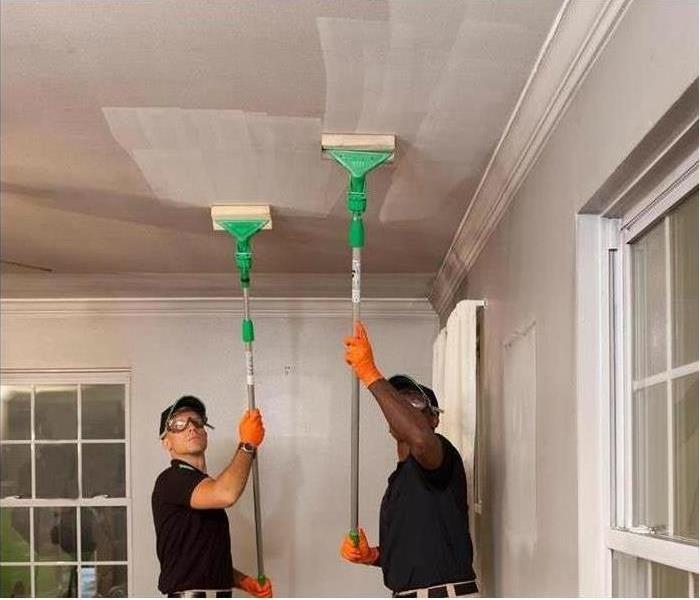 SERVPRO technicians cleaning soot on ceilings and walls.
SERVPRO technicians cleaning soot on ceilings and walls.
It's that time of the year again! The smell of pumpkin is everywhere! As the days get shorter and the nights get colder, people are lighting fires in their fireplaces and turning on their heaters. It's also the time of year for puffbacks.
Puffbacks occur in an oil or gas heater as a misfiring or explosion, and usually caused by lack of regular cleaning and maintenance. They can send an oily, smell film throughout the home, covering walls, ceilings, carpets, furniture, and curtains. The soot can get into closets, and even drawers! Because the soot is petroleum based, it can be very difficult to clean, and is best left to the professionals. Attempting to clean it on your own can make the situation worse.
To prevent a puffback, have your heater cleaned and serviced at least once a year and replace the filters regularly. Make note of any unusual sounds or odors. If you have experienced a puffback, call your HVAC professional immediately to have your heater cleaned and repaired, then contact SERVPRO of Media to begin the cleaning process.
Fire Damages
1/31/2017 (Permalink)
In 2015, there were 1,345,500 fires reported in the United States. These fires caused 3,280 civilian deaths, 15,700 civilian injuries, and $14.3 billion in property damage.
- 501,500 were structure fires, causing 2,685 civilian deaths, 13,000 civilian injuries, and $10.3 billion in property damage.
- 204,500 were vehicle fires, causing 500 civilian fire deaths, 1,875 civilian fire injuries, and $1.8 billion in property damage.
- 639,500 were outside and other fires, causing 95 civilian fire deaths, 825 civilian fire injuries, and $252 million in property damage.
The 2015 U.S. fire loss clock a fire department responded to a fire every 23 seconds. One structure fire was reported every 63 seconds.
- One home structure fire was reported every 86 seconds.
- One civilian fire injury was reported every 34 minutes.
- One civilian fire death occurred every 2 hours and 40 minutes.
- One outside and other fire was reported every 52 seconds.
- One highway vehicle fire was reported every 3 minutes 1 seconds.






 24/7 Emergency Service
24/7 Emergency Service



